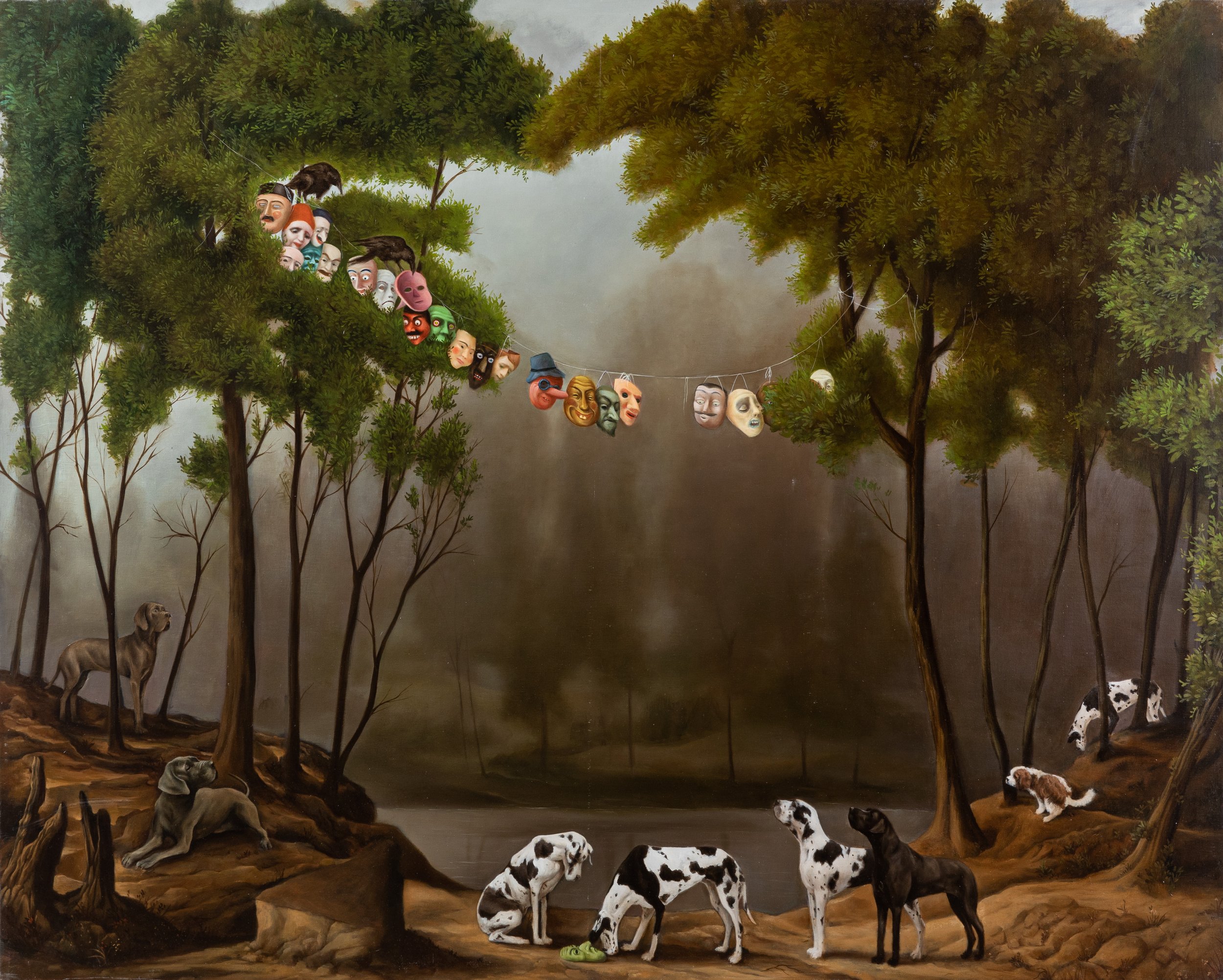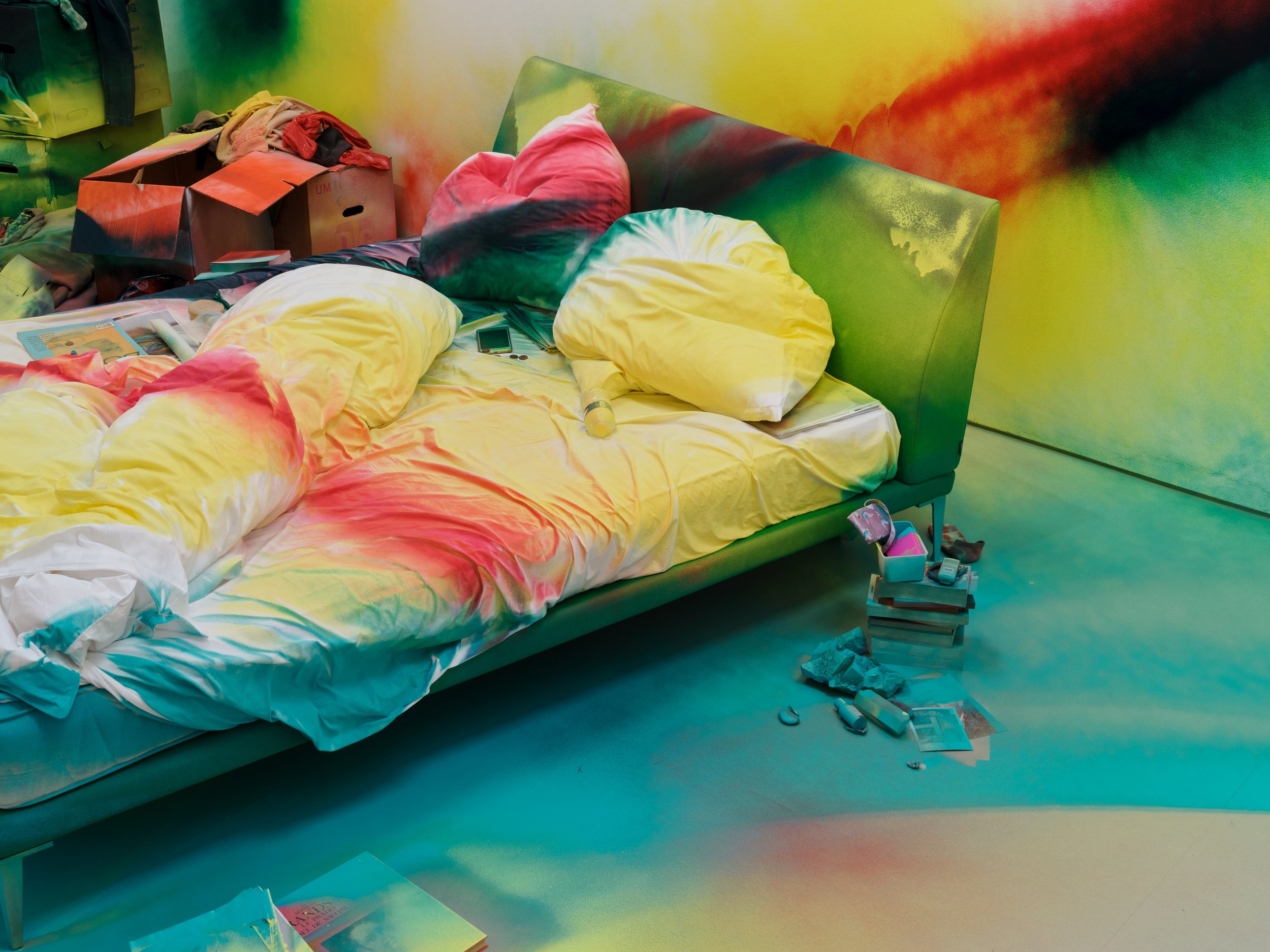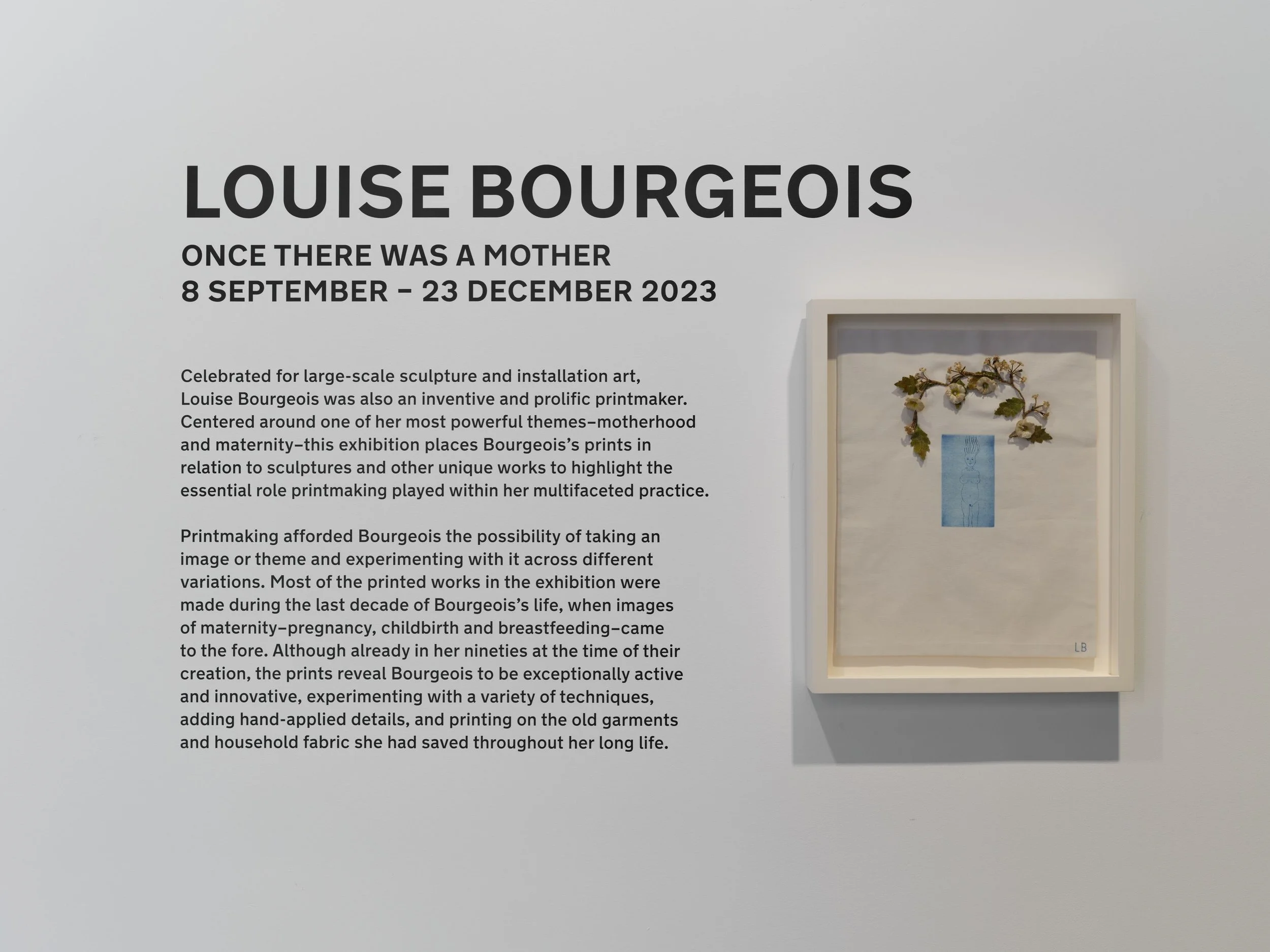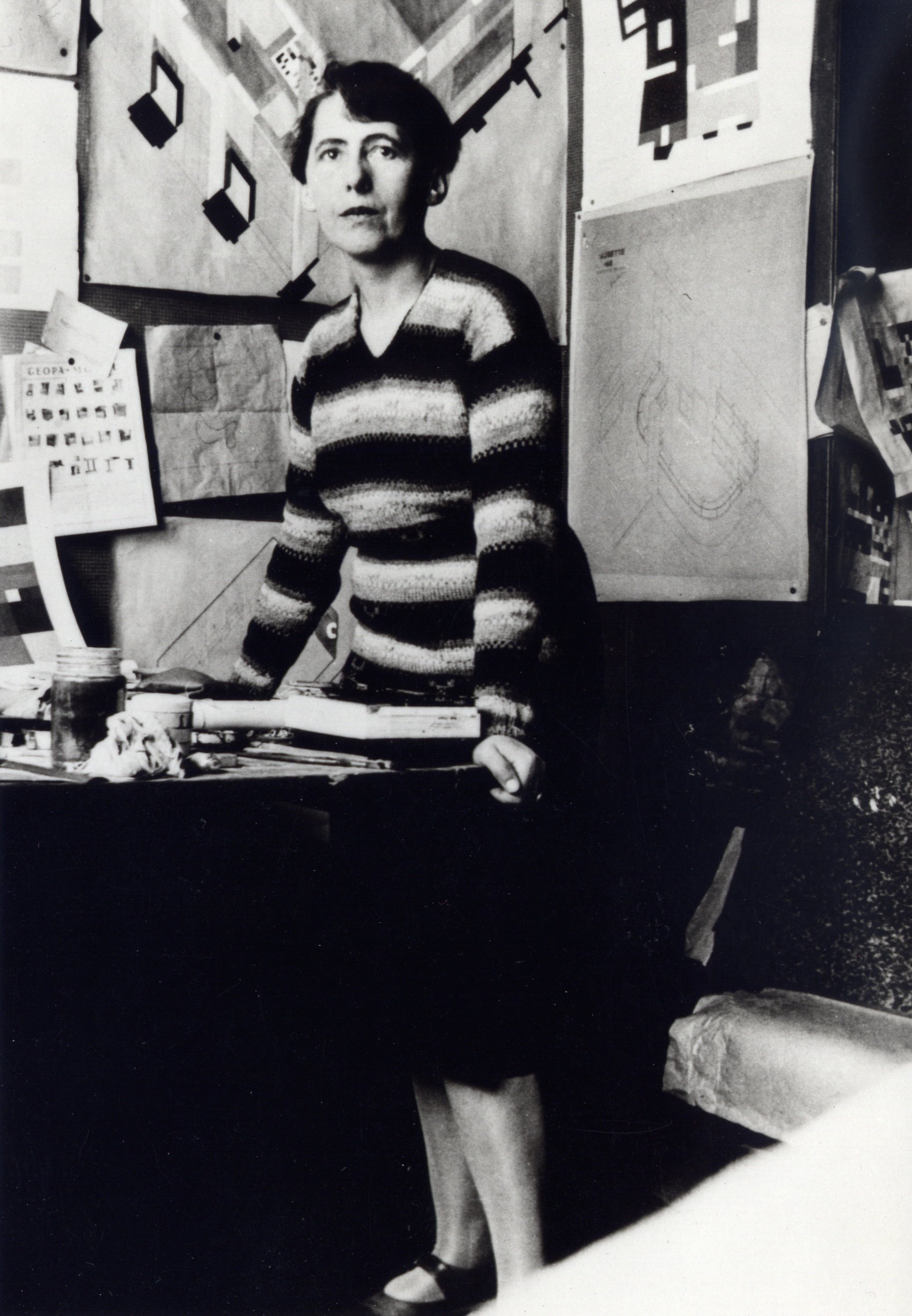Spike Lee: Creative Sources
Spike Lee, 2023. (Photo:©JamelShabazz)
The Brooklyn Museum Presents a Major Exhibition Exploring the Creative Sources of Celebrated Filmmaker Spike Lee.
Spike Lee: Creative Sources is an immersive installation that takes visitors into Lee’s world, revealing the people, places, and ideas that have inspired his incisive storytelling
The Brooklyn Museum is proud to present Spike Lee: Creative Sources, a rare glimpseinto the world of Spike Lee (born Atlanta, Georgia, 1957; raised in Brooklyn, New York), one of the most influential and prolific American directors, who has transformed the landscape of contemporary cinema and the art of filmmaking. Through an immersive installation of objects that have been touchpoints in his creative process, visitors will discover the sources of inspiration that have fueled Lee’s work. Organized around themes of Black American history and culture, Brooklyn, sports, music, cinema history, and family, the exhibition draws connections between the people, places, and ideas behind his creative endeavors. It also marks Brooklyn’s first major exhibition on Lee, an artist whose persona is synonymous with the borough.
Spike Lee as Mookie in Do the Right Thing (Spike Lee, 1989, 120 min.). (Photo: © David C. Lee)
Lee is best known for his work in film, having directed, written, and produced numerous movies, commercials, music videos, and recorded plays over the past forty years. His personal collection, also formed over decades and previously on view in the Academy Museum of Motion Pictures’ exhibition Director’s Inspiration: Spike Lee (2021–22), mirrors the themes that recur in his filmmaking. The Brooklyn Museum’s exhibition offers visitors a new lens through which to understand how Lee’s lifelong interests have intersected and impacted his productions. It is organized by Kimberli Gant, Curator, Modern and Contemporary Art, with Indira A. Abiskaroon, Curatorial Assistant, Modern and Contemporary Art, Brooklyn Museum.
“Spike Lee: Creative Sources offers a fresh perspective on a cultural icon, focusing on the individuals and influences that have shaped Spike Lee’s body of work, which is so well known today,” says Gant. “By making Lee’s collection accessible to the public, this showcase celebrates his legacy while honoring his deep connection to Brooklyn, a place that has been an integral part of his storytelling.”
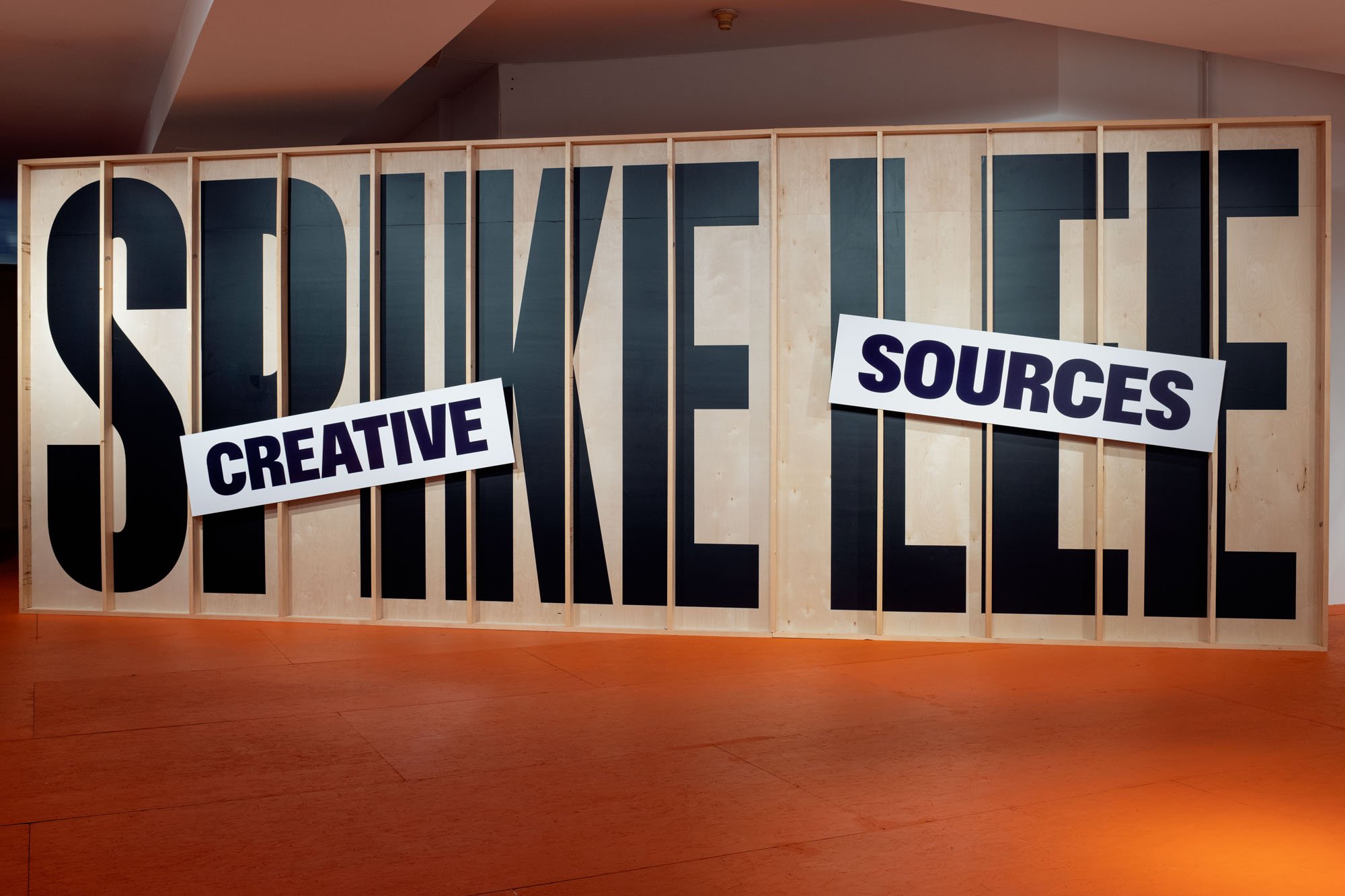


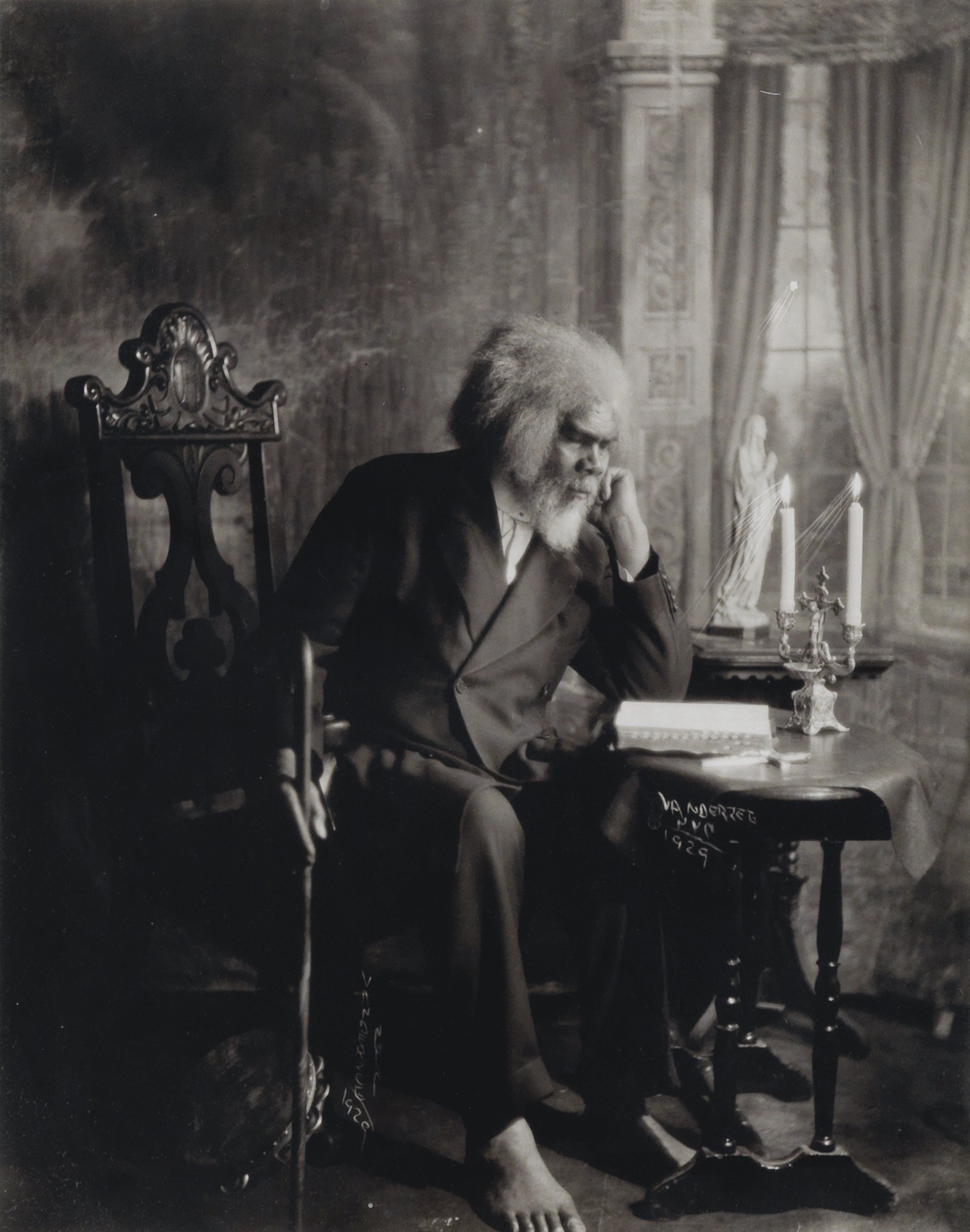





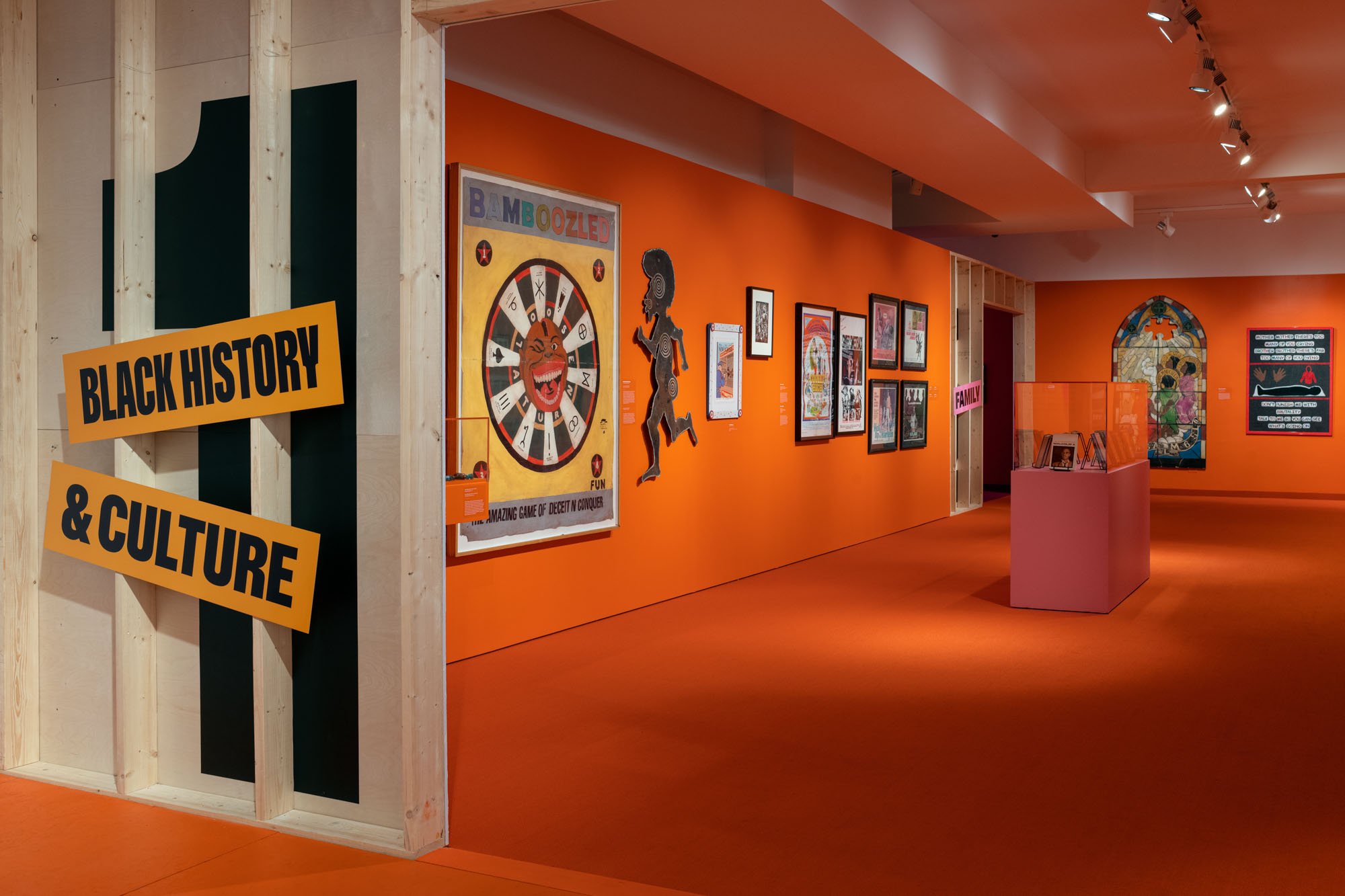

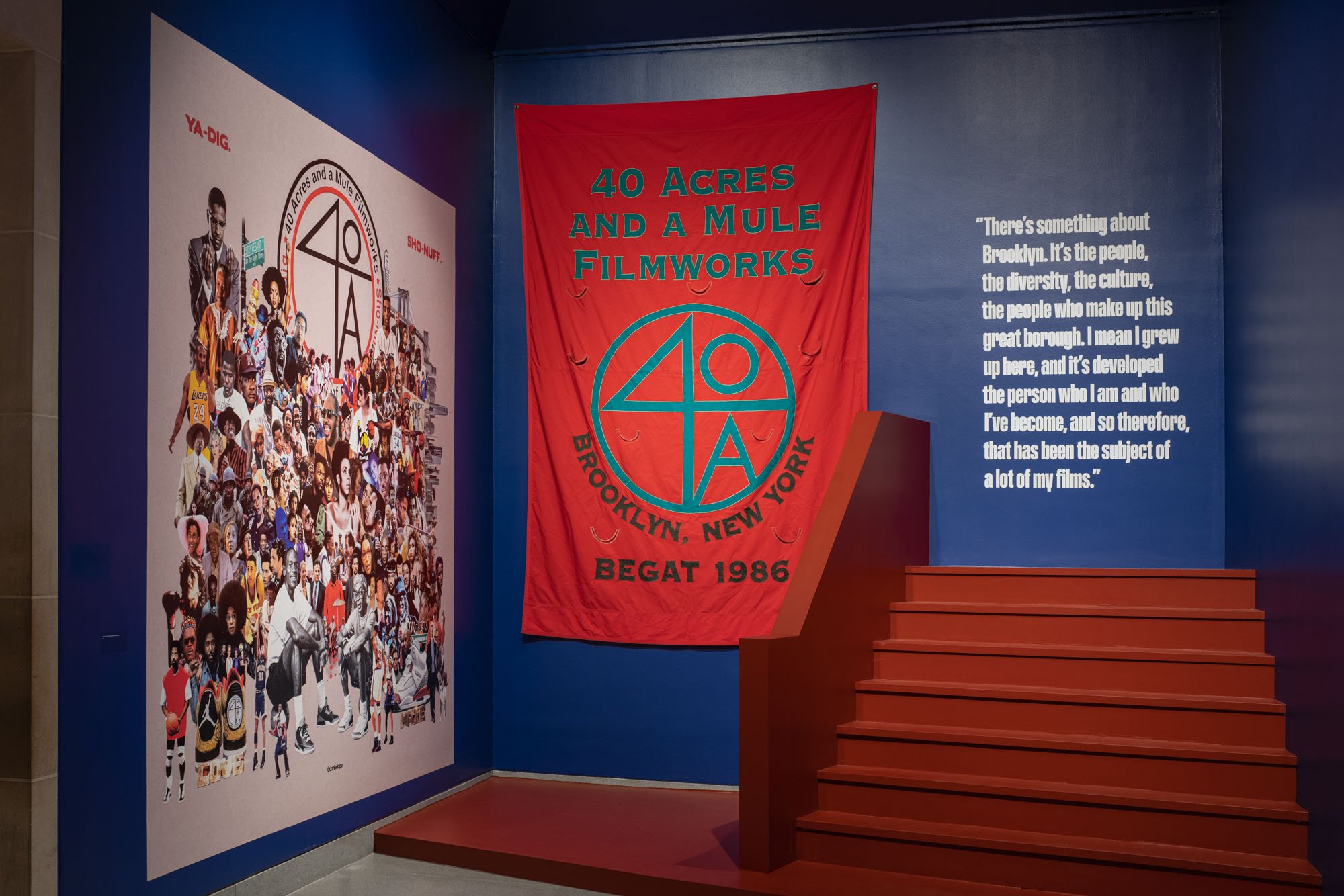
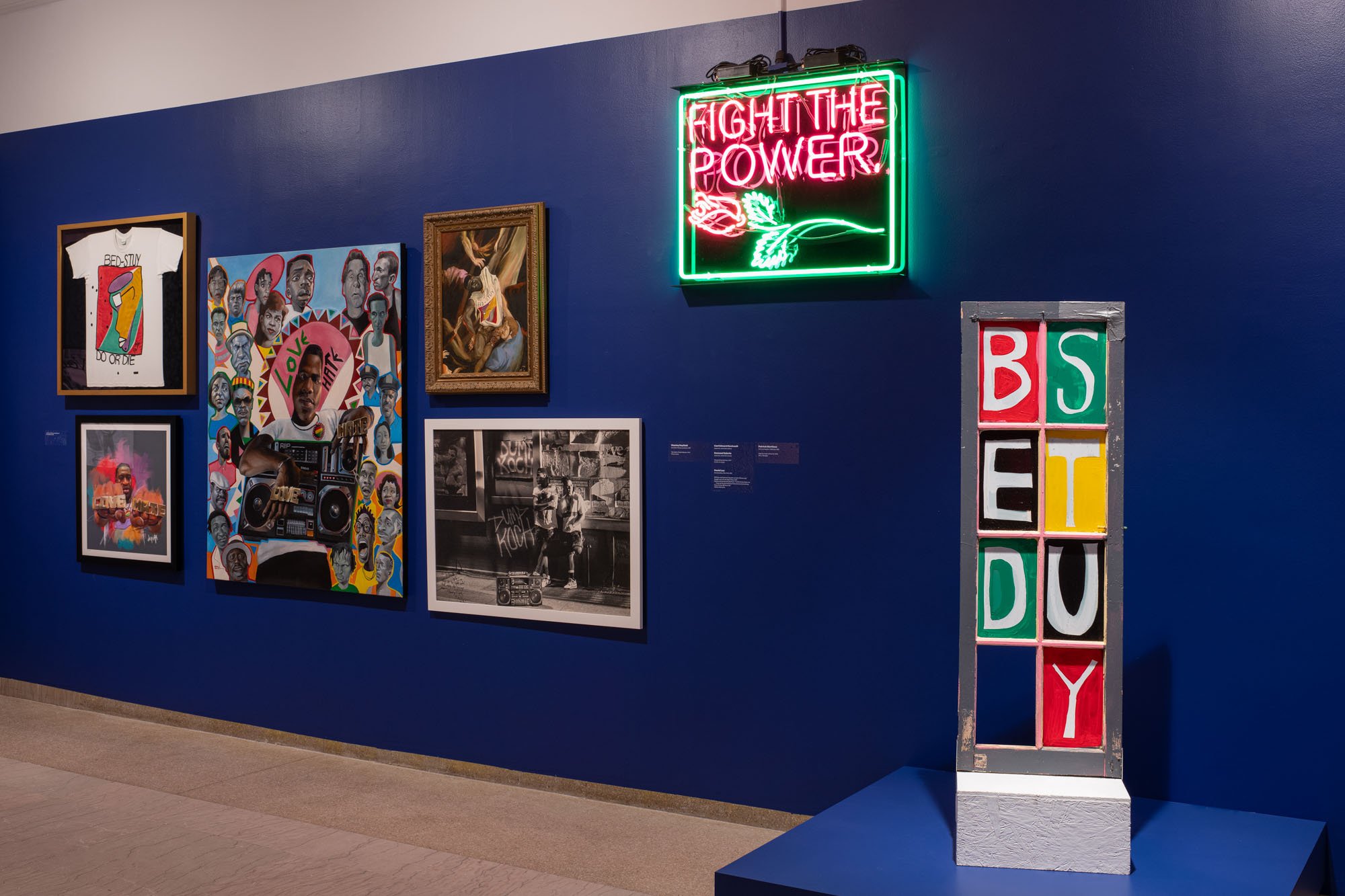


Installation view, Spike Lee: Creative Sources: Brooklyn Museum, October 7, 2023-February4, 2024. (Photo: Paula Abreu Pita, Danny Perez))
More than 350 objects represent the wide range of mediums that have inspired Lee, such as historical photographs, paintings, album covers, movie posters, letters, first-edition books, costumes, and film memorabilia (many of which are autographed and signed to the director). They are organized thematically in seven sections, each of which features a clip from one of his groundbreaking films. Shown throughout the exhibition are works by prominent Black American artists, including Kehinde Wiley, Deborah Roberts, Elizabeth Catlett, Michael Ray Charles, Gordon Parks, and James Van Der Zee. Also on view are depictions of Black American and African figures across a spectrum of disciplines, such as Nelson Mandela, Barack Obama, Shirley Chisholm, Angela Davis, Toni Morrison, Ella Fitzgerald, Billie Holiday, Malcolm X, Jacob Lawrence, Gwendolyn Knight, Joe Louis, Jack Johnson, Michael Jordan, and Prince—all of whom have made an impact on Lee.
Known for creating complicated and often controversial depictions of Black Americans, Lee is strongly influenced by Black American history and culture, which is highlighted in a primary section of the exhibition. Michael Ray Charles’s satirical artwork Bamboozled (1997) depicts a dartboard with the face of a Black American winking and smiling widely, despite the deep wound cleaved into the figure’s head. Representing the racist stereotyping of Black Americans, the painting helped inspire Lee’s provocative film Bamboozled (2000), a critique of minstrelsy and blackface. Other objects in the section, such as images of Harlem and of public figures Lena Horne, Jacob Lawrence, and James Baldwin, weave a narrative about self-expression, community, and activists who condemned segregation and sought to build a better world.
A Brooklyn icon, Lee has centered the borough and other New York City locales in many of his films, and he has collected and preserved artifacts from Brooklyn’s rich history. In turn, the exhibition examines the ways that Brooklyn has shaped Lee creatively. The section about Brooklyn presents photographs by David Lee (Spike Lee’s younger brother) and Tseng Kwong Chi; movie posters; and set dressings and props from Lee’s Brooklyn- based films, such as Do the Right Thing (1989) and She’s Gotta Have It (1986). These works are displayed alongside banners and posters for Lee’s Brooklyn-based film company 40 Acres and a Mule, named after the broken promise that the U.S. government made to formerly enslaved people at the end of the Civil War.
Spike Lee as Mars Blackmon from She’s Gotta Have It (Spike Lee, 1986, 84 min.). (Photo: © David C. Lee)
Lee’s collection also contains numerous works that celebrate the historical feats of Black athletes. On view in the sports section is a commissioned painting by Kehinde Wiley that honors the legacy of Brooklyn Dodgers player Jackie Robinson, the first Black American to play in Major League Baseball in the modern era. Also exhibited are tennis rackets that belonged to Arthur Ashe, the first Black American to win three Grand Slam singles titles, and Serena Williams, one of the greatest tennis players in history. In addition, the section features David Levinthal’s photographs of notable moments in sports history, starring toy figures of such heroes as Michael Jordan and Willie Mays.
Known for collaborating with renowned jazz musicians and hip-hop artists, Lee centers music as a distinctive component of his films. His love for music and musicals was passed down from his mother, Jacquelyn Shelton Lee, who frequently took him to musicals and plays, and his late father, Bill Lee, a jazz musician who wrote the score for several of his films. The section about music includes portraits of early to mid-twentieth-century musical luminaries, such as Gordon Parks’s photograph of composer Aaron Copland and James J. Kriegsmann’s photograph of Frank Sinatra. These works are displayed alongside instruments once owned by legendary musicians, such as Prince’s “Love Symbol” guitar and a saxophone signed by Branford Marsalis, who collaborated on the soundtrack for Mo’ Better Blues (1990).
Though he developed a distinct visual language and technique, Lee would not have become the creative powerhouse that he is today without the profound influence of other important filmmakers. The cinema history section presents photographs and vintage posters of films by his predecessors and contemporaries, such as Japanese director Akira Kurosawa and Italian director Federico Fellini, showcasing the range of work that inspires Lee.
Patrick Martinez (born 1980). Fight the Power (Chuck D) , 2018. Neon, Plexiglas. © Patrick Martinez. Collection of Spike Lee and Tonya Lewis Lee. (Photo: Michael Underwood. Courtesy of the artist and Charlie James Gallery, Los Angeles)
As seen since his earliest works, Lee makes films that are inherently political, often examining the everyday lives of Black Americans and the systemic inequities they contend with.
In the section on politics, World War II and Vietnam War propaganda posters featuring stereotypical imagery of Black American soldiers are displayed alongside posters of Lee’s Miracle at St. Anna (2008) and Da 5 Bloods (2020). Both films spotlight the treatment of Black American soldiers and emphasize the hypocrisy of making them fight alongside white counterparts and for the United States.
Behind the scenes of Crooklyn (Spike Lee, 1994, 115 min.). (Photo: © David C. Lee)
The notion of family, which has been important for Lee both on- and off-screen, forms a final section of the exhibition. Here, visitors will see photographic portraits of Lee and his siblings, parents, and grandparents, as well as artistic depictions of family by Elizabeth Catlett and William H. Johnson. Additional works on view include portraits of the actors, designers, writers, musicians, and other colleagues who have become part of Lee’s professional family and helped him realize his artistic vision through the decades. Spike Lee: Creative Sources is organized by Kimberli Gant, Curator, Modern and Contemporary Art, with Indira A. Abiskaroon, Curatorial Assistant, Modern and Contemporary Art, Brooklyn Museum.
Leadership support for this exhibition is provided by the Ford Foundation.
Major support is provided by Rolex.
The Brooklyn Museum gives special thanks to the Academy Museum of Motion Pictures, especially Dara Jaffe, Associate Curator.
The exhibit opened on the 7th of October with an artist reception. The exhibit will close—next year in February on the 4th. Please visit the Brooklyn Museum’s site for more information about the exhibit. The Museum can also be found on Instagram, TikTok, YouTube, and Facebook.
Magritte + Warhol By Duane Michals
Credit for image: © Duane Michals. Courtesy of DC Moore Gallery, New York.
Photographer Duane Michals turns his eye on the legendary artists René Magritte and Andy Warhol in this exhibition of early portraits. Known for his surreal sequences and witty storytelling across media, Michals’s portraits of other artists turn the tables upon his subjects by adopting elements of their characteristic visual styles. Among the many artists photographed by Michals over his six-decade long career, Michals particularly sought out Magritte and Warhol as subjects. The exhibition will feature nearly forty portraits of Warhol and twenty portraits of Magritte, alongside over twenty portraits of other major 20th century artists. These two series reimagine these mythological artists on Michals’s own terms, capturing at once the illusory image of the artist and the person beneath.
Duane Michals first took portraits of Andy Warhol in 1958, and continued to photograph him throughout the artists’ friendship. They met while Warhol was working as a commercial artist and connected over their shared experiences growing up in Pittsburgh. The 1958 portraits capture this moment of transition from working in advertising to establishing himself as Andy Warhol, the artist and personality. The subsequent portraits taken over the years illuminate Warhol’s constant self-reinvention. Michals comments, “he’s transcended being a mere artist, he’s a phenomenon. Andy was phenomenal. And he still is, and he will get stronger as time goes on.”
Andy Warhol (Laying on Papers), c. 1958 Signed lower middle; editioned lower right Gelatin silver print 14 7/8 x 22 1/4 inches (image); 20 x 24 inches (paper size) Edition 1/5
In August, 1965, Duane Michals arrived at René Magritte’s home in Brussels to take the famous surrealist’s portrait. Michals made the connection through a friend of a friend and had no idea what to expect from the painter who was a large influence on his own photographs. Michals’s photographs refract Magritte and his space through his own engagement with Magritte’s art. He writes, “what so engaged me in Magritte’s work was its ability to perplex. In his world, I could not be sure of anything.” The portraits convey the surrealist sense of humor shared by the two artists, using double exposures and other techniques to perplex the eye. Magritte is dressed in a dark suit and bowler hat, “the familiar Magritte man” of his paintings.
Magritte with Easel, 1965 Signed lower middle; editioned lower right Gelatin silver print 15 1/8 x 22 1/2 inches (image); 20 x 24 inches (paper size) Edition 1/5
Michals’ portraits of other artists, including Marcel Duchamp, David Hockney, Alice Neel, Louise Nevelson, and Robert Rauschenberg, will be shown alongside these two series. Each image speaks to the particularities of the sitter, channeling the aura of their work while maintaining his own idiosyncratic vision.
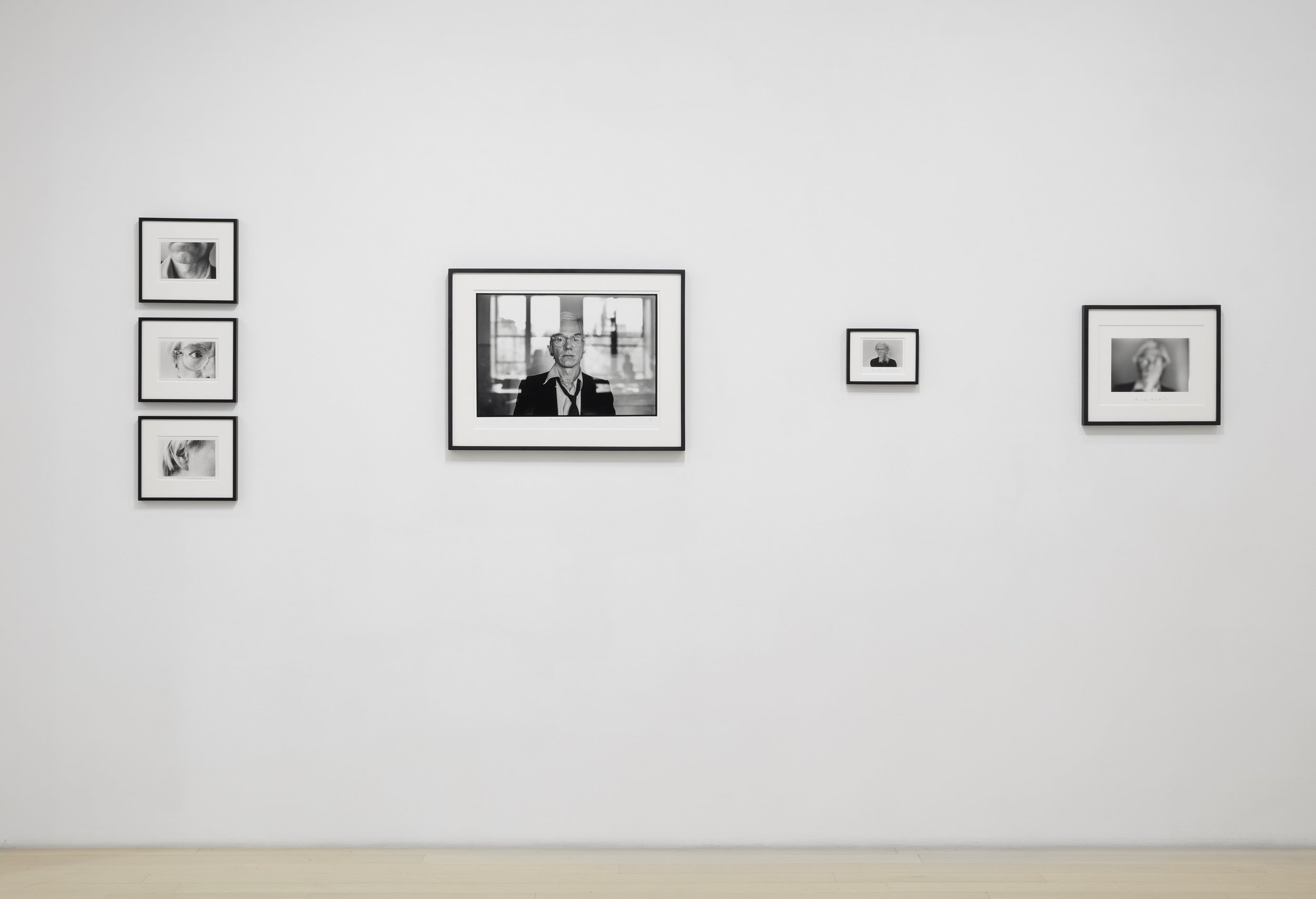

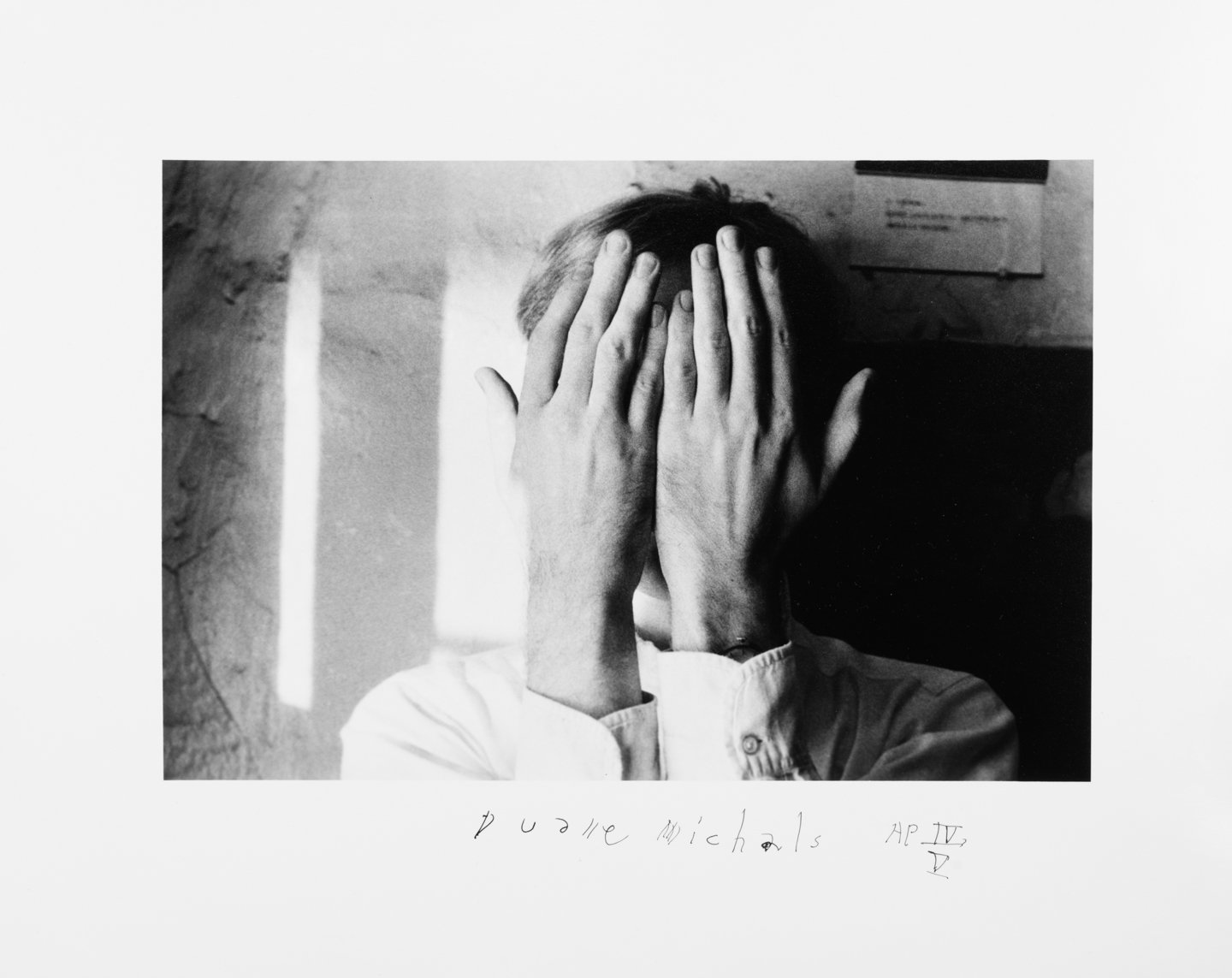
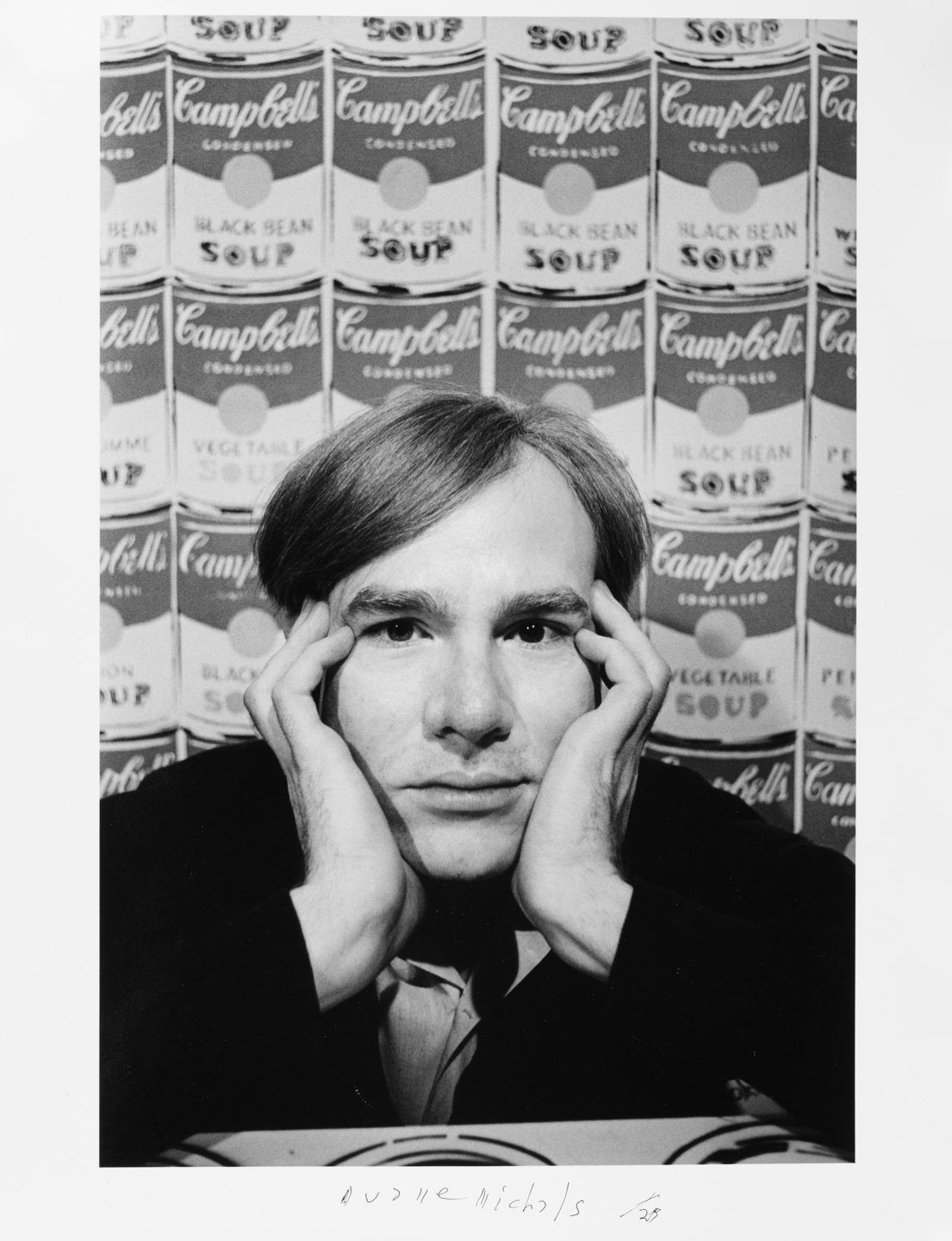

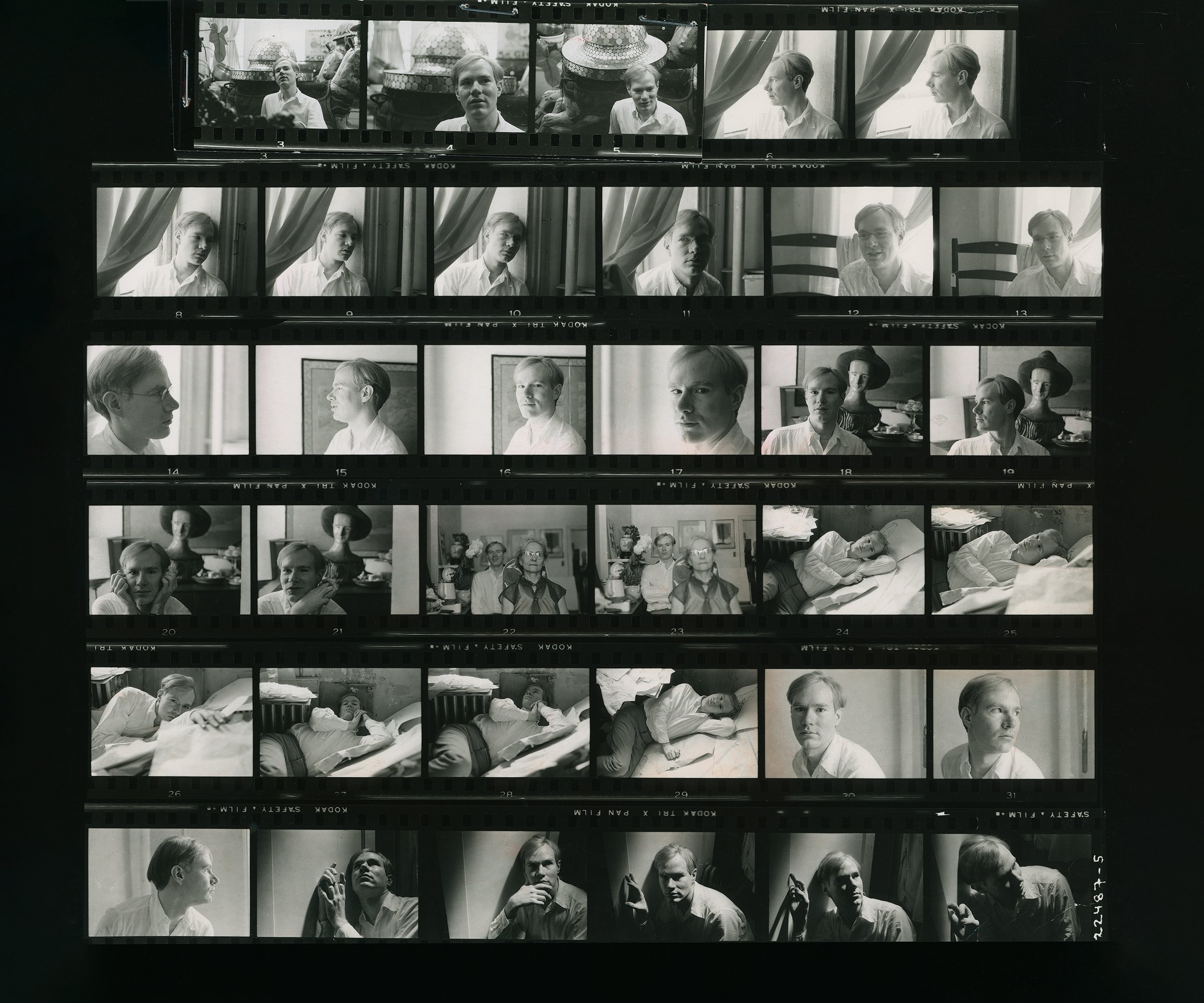

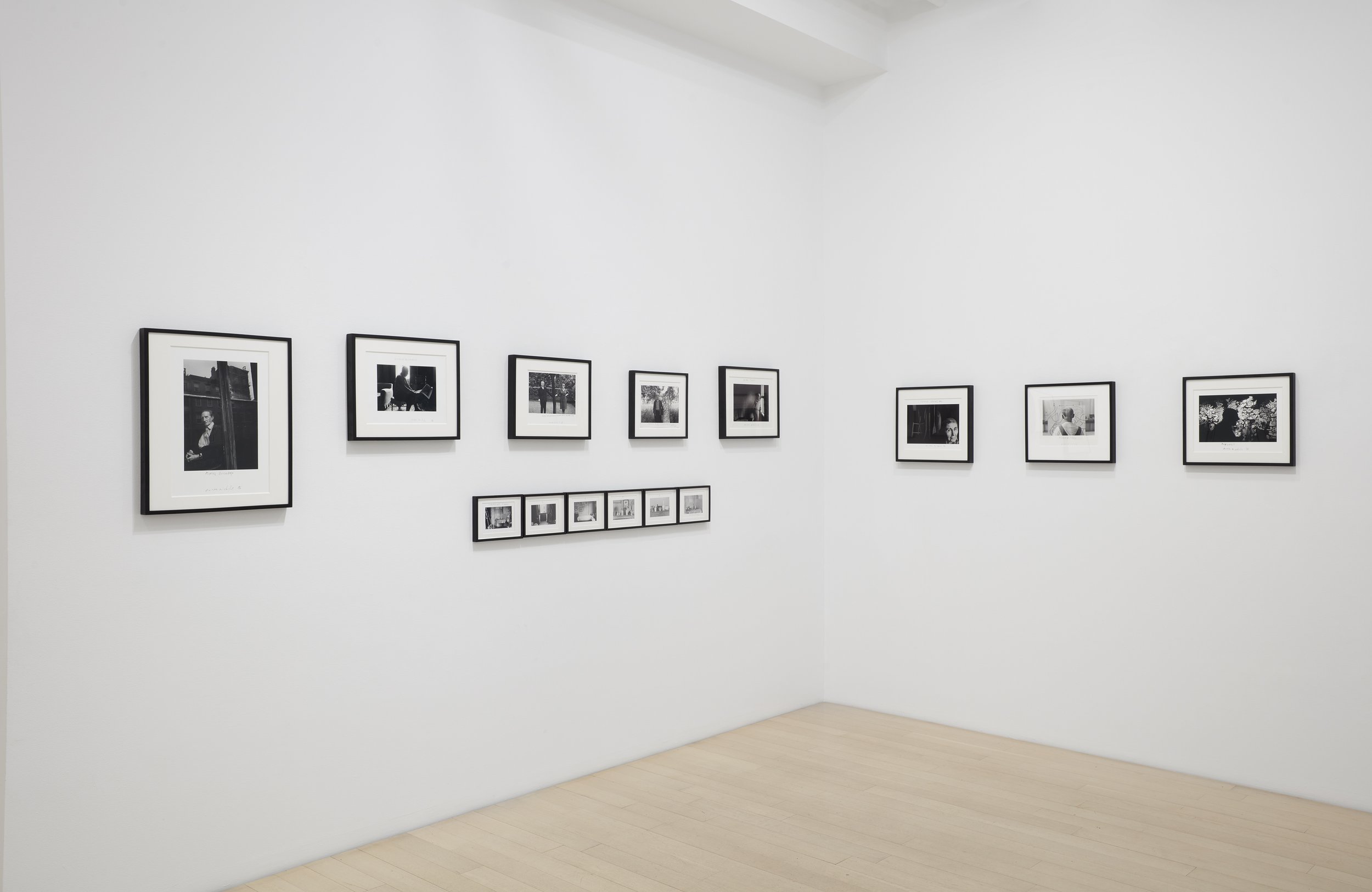
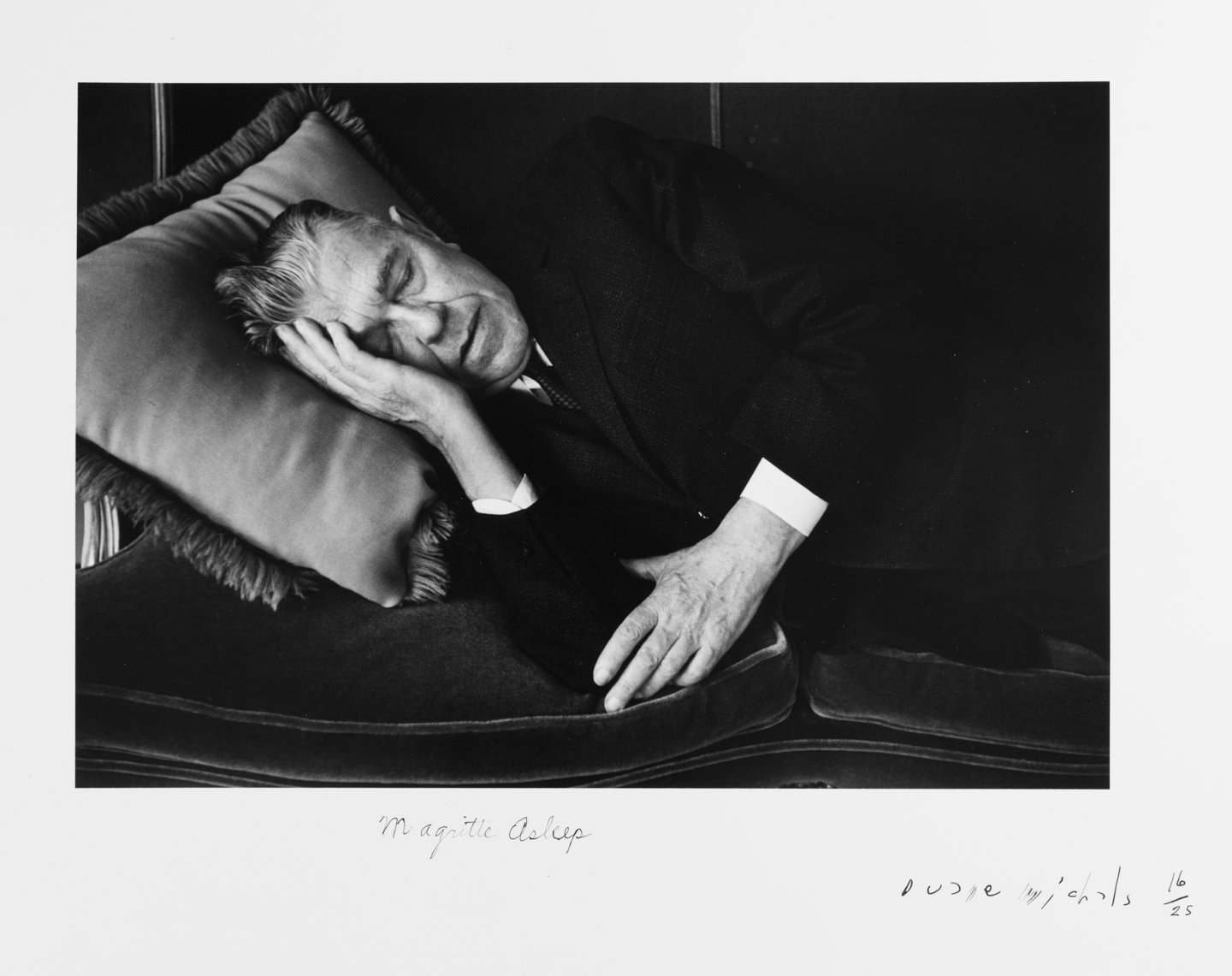
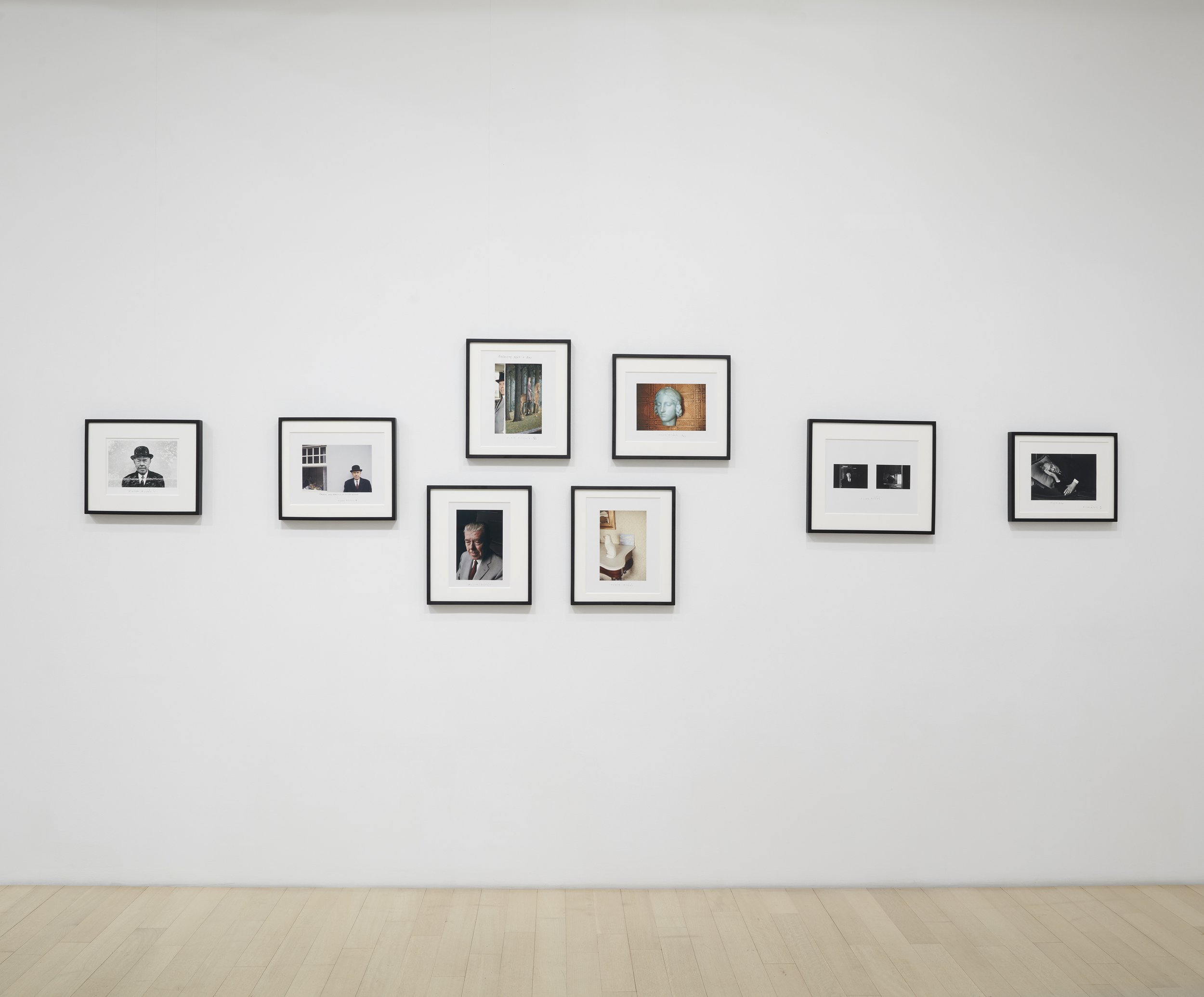
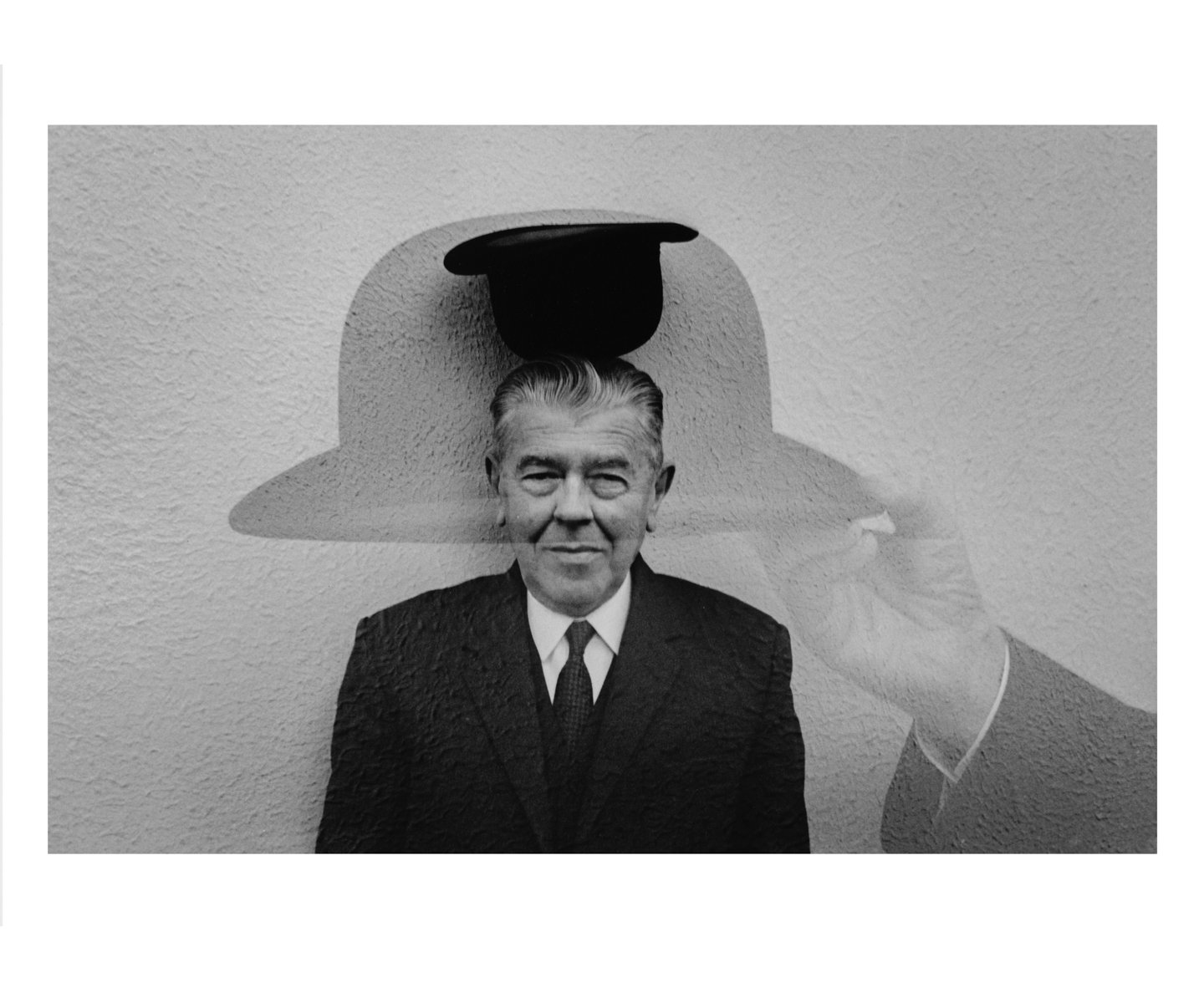
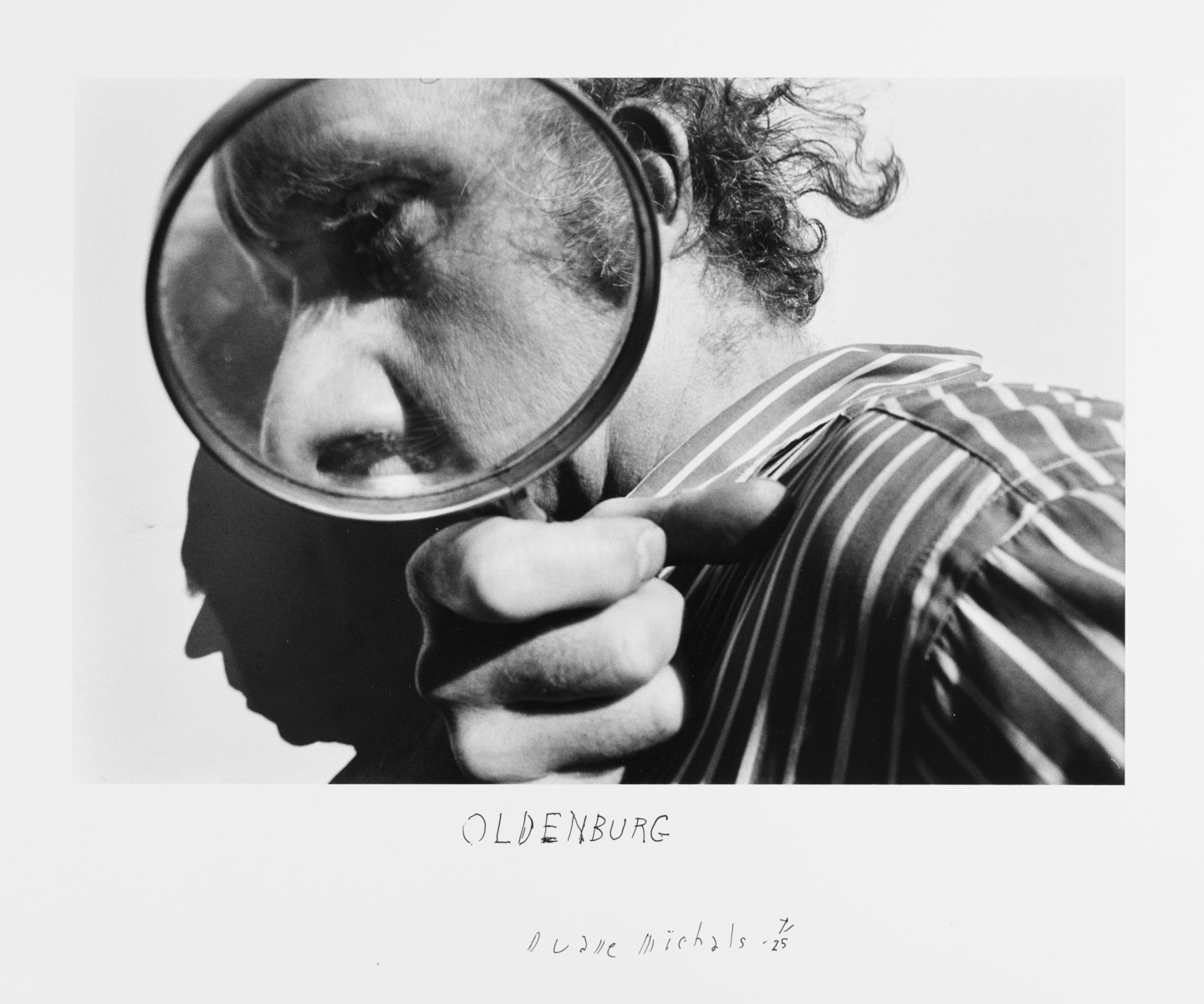
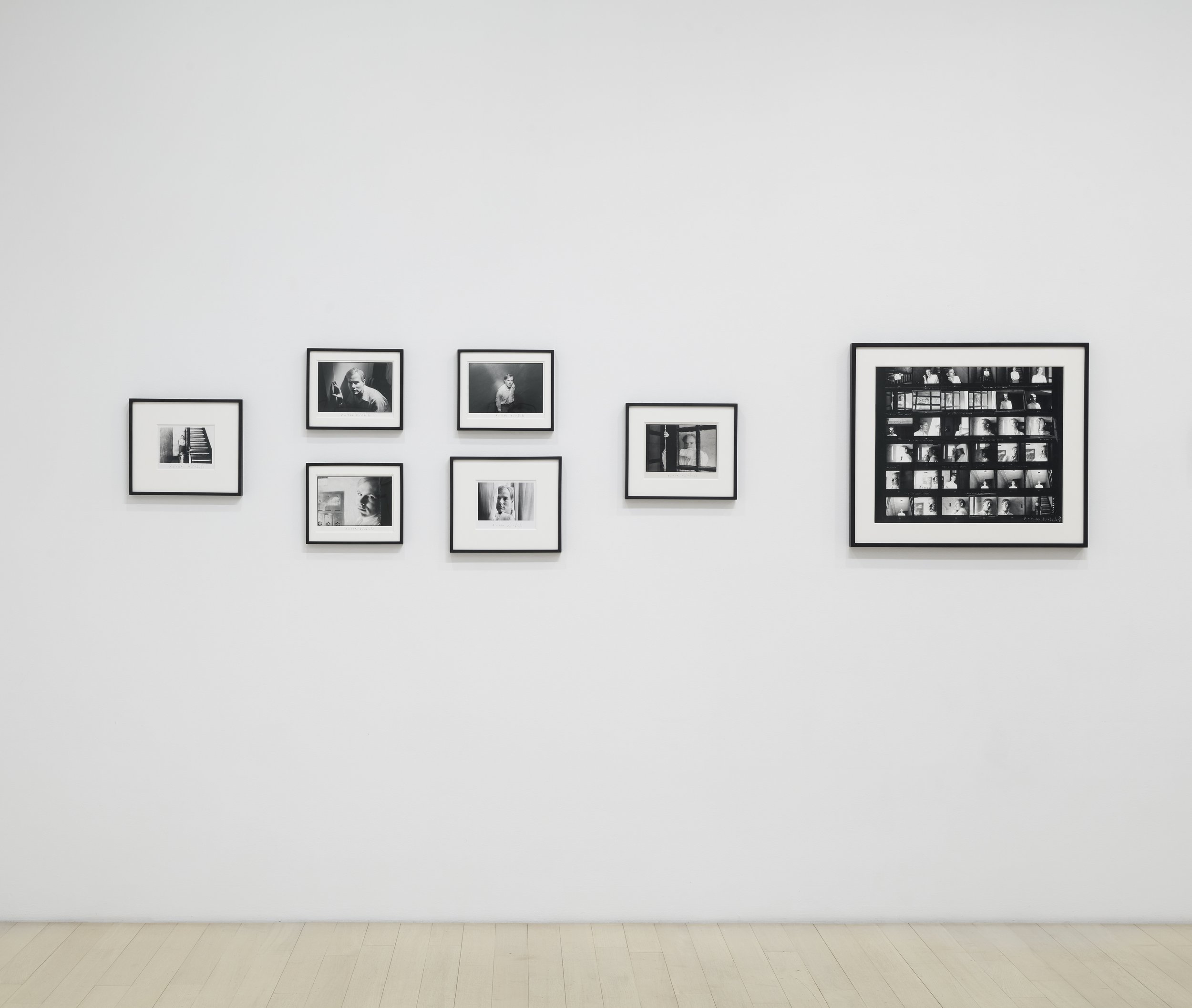


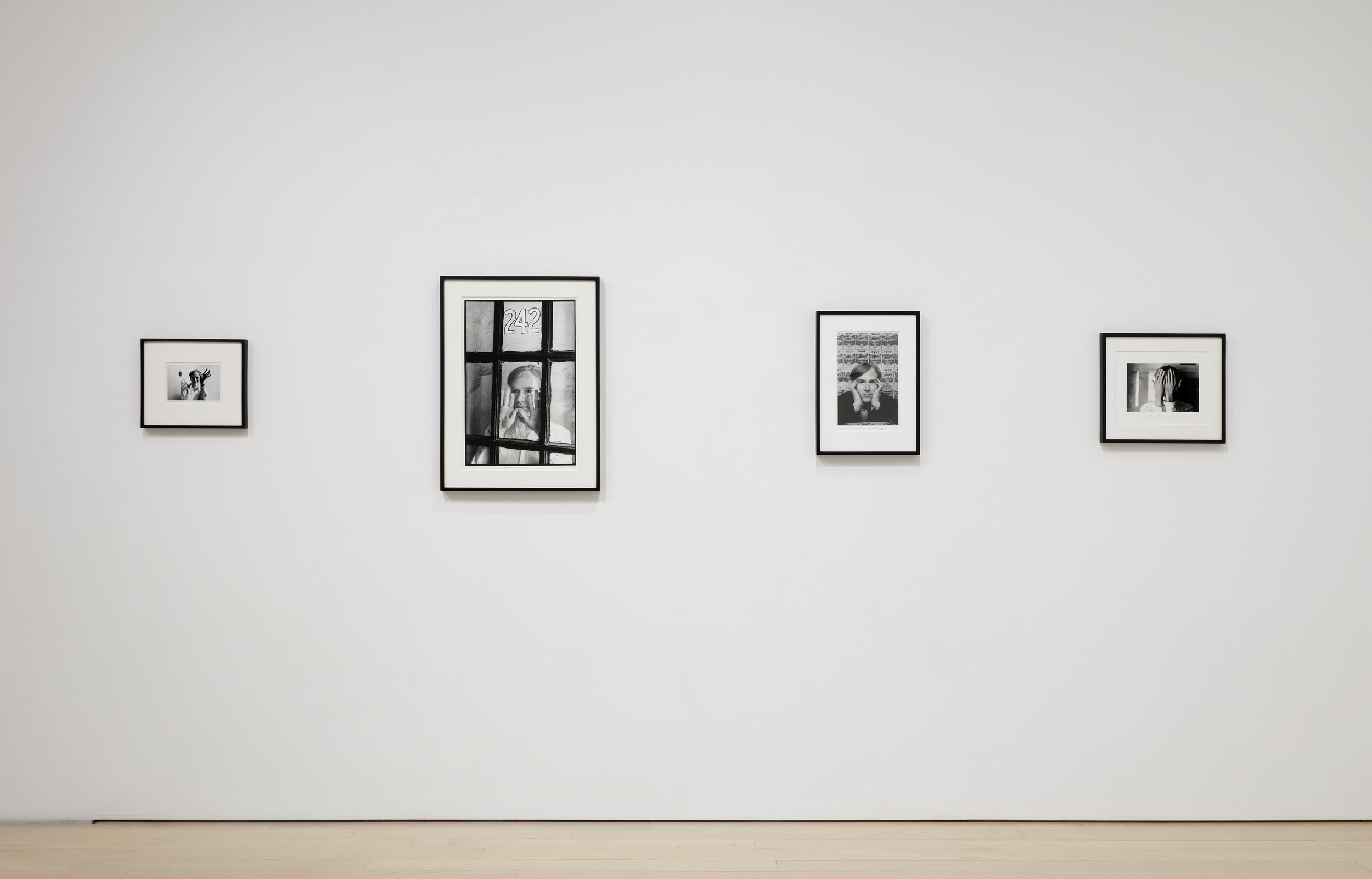
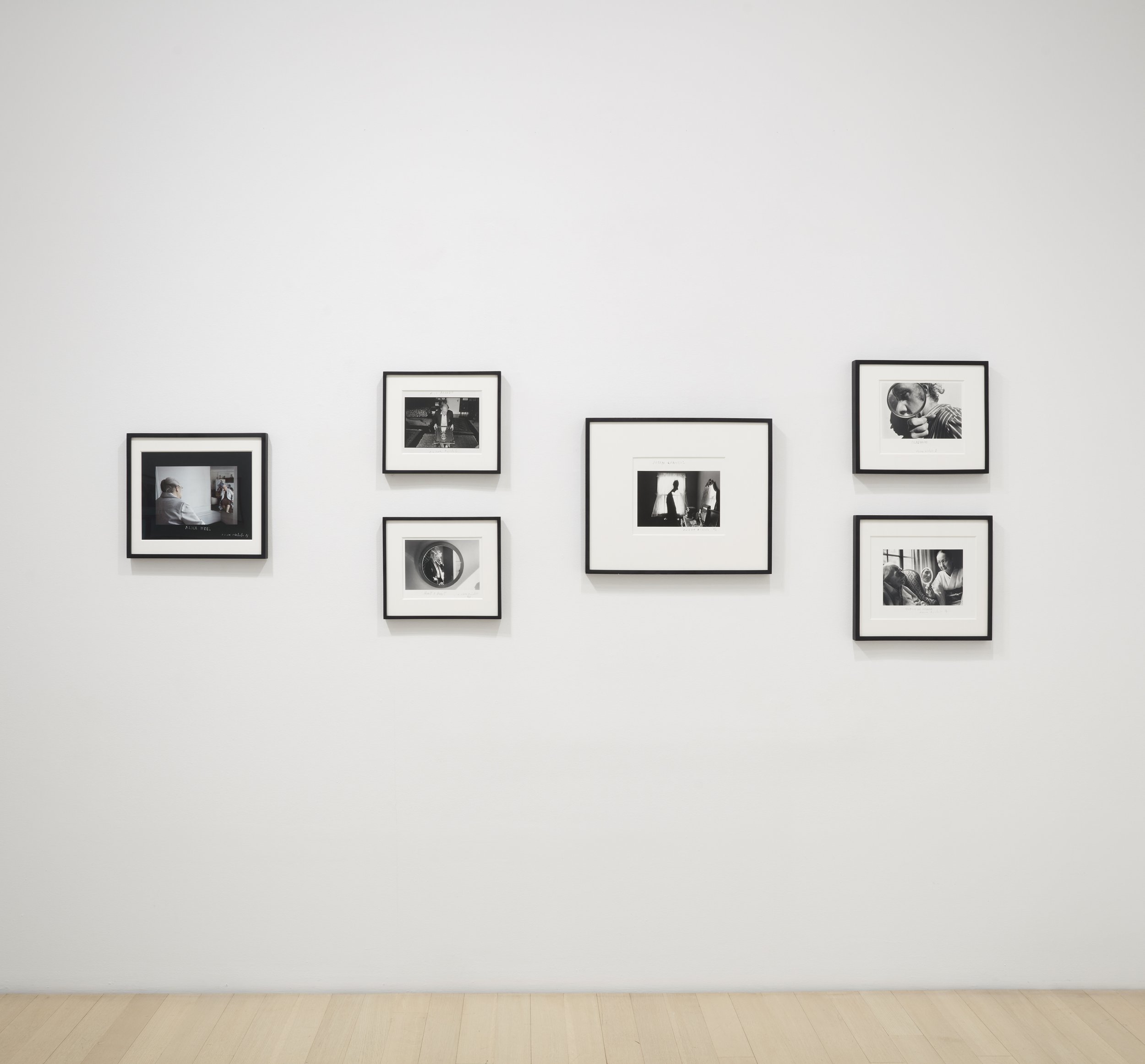
Credit for all images: © Duane Michals. Courtesy of DC Moore Gallery, New York.
Duane Michals (b. 1932, McKeesport, PA) first made significant, creative innovations in the field of photography during the 1960s. In an era heavily influenced by photojournalism, Michals manipulated the medium to communicate narratives. Over the past five decades, Michals’ work has been exhibited extensively in the United States and abroad. The Museum of Modern Art, New York, hosted Michals’ first solo exhibition in 1970. In 2008, Michals celebrated his 50th anniversary as a photographer with a retrospective exhibition at the Thessaloniki Museum of Photography, Greece, and the Scavi Scaligeri in Verona, Italy. In 2019, The Morgan Library and Museum in New York exhibited a career retrospective of Michals' work, The Illusions of the Photographer: Duane Michals at the Morgan. The recent touring exhibition, Duane Michals: The Portraitist, originated at DC Moore Gallery in 2015 and traveled to The Crocker Museum of Art, Sacramento, CA (2018-2019), The Fenimore Art Museum, Cooperstown, NY (2019), The Lowe Art Museum, Miami, FL (2021), Hasselblad Center, Gothenburg, Sweden (2022), University of Richmond Museums, Richmond, VA (2022), and The Finnish Museum of Photography, Helsinki, Finland (2023). Over forty monographs of Michals’ work have been published, including Storyteller: Duane Michals (2014), Duane Michals: Empty New York (2018), and, most recently, Texas (2022).
Over forty monographs of Michals’ work have been published, including Storyteller: Duane Michals (2014), Duane Michals: Empty New York (2018), and, most recently, Texas (2022).
An opening reception with the Artist was held on November 16 from 6 to 8 pm. The exhibit will close on December 21, 2023
For more information about this exhibit, please contact the DC Moore Gallery.
Oluseye Black Exodus: Summer Departure
courtesy of Hayden Phipps/Southern Guild
Southern Guild presents Black Exodus: Summer Departure, a solo exhibition of new works by Nigerian-Canadian artist Oluseye, opening on 23 November (until 25 January). Spanning sculpture, installation, and photography created over the past five years, the exhibition weaves the artist’s personal narrative, trans-Atlantic journeys, and artistic evolution into a broader exploration of historical and contemporary Black life.
Oluseye re-animates found objects and detritus collected from his travels – which he terms “diasporic debris” – to trace Blackness through its multifaceted migrations and manifestations. Black Exodus: Summer Departure is a journey to finding self and forging an artistic identity rooted in play, honesty, travel, and research. “I am coming into self within this broader examination of Black ancestry, migration, spirituality, aesthetics, and visual culture. What's my journey within these larger, universal themes of Blackness? What is my contribution?”
Over the past year, Oluseye’s artistic practice has seen him moving between New York, Toronto, Lagos and Cape Town, where he spent a two-month stay at the GUILD Residency earlier this year. In the months prior to his exhibition, he returned to the city, setting up a makeshift studio on the second floor of a warehouse in the heart of Cape Town’s bustling harbour. Amidst the grit and industrial atmosphere, the arrival of goods and people mirrors his peripatetic practice of collecting and working with objects sourced from across the African diaspora, many of which have arrived in Cape Town via this port.
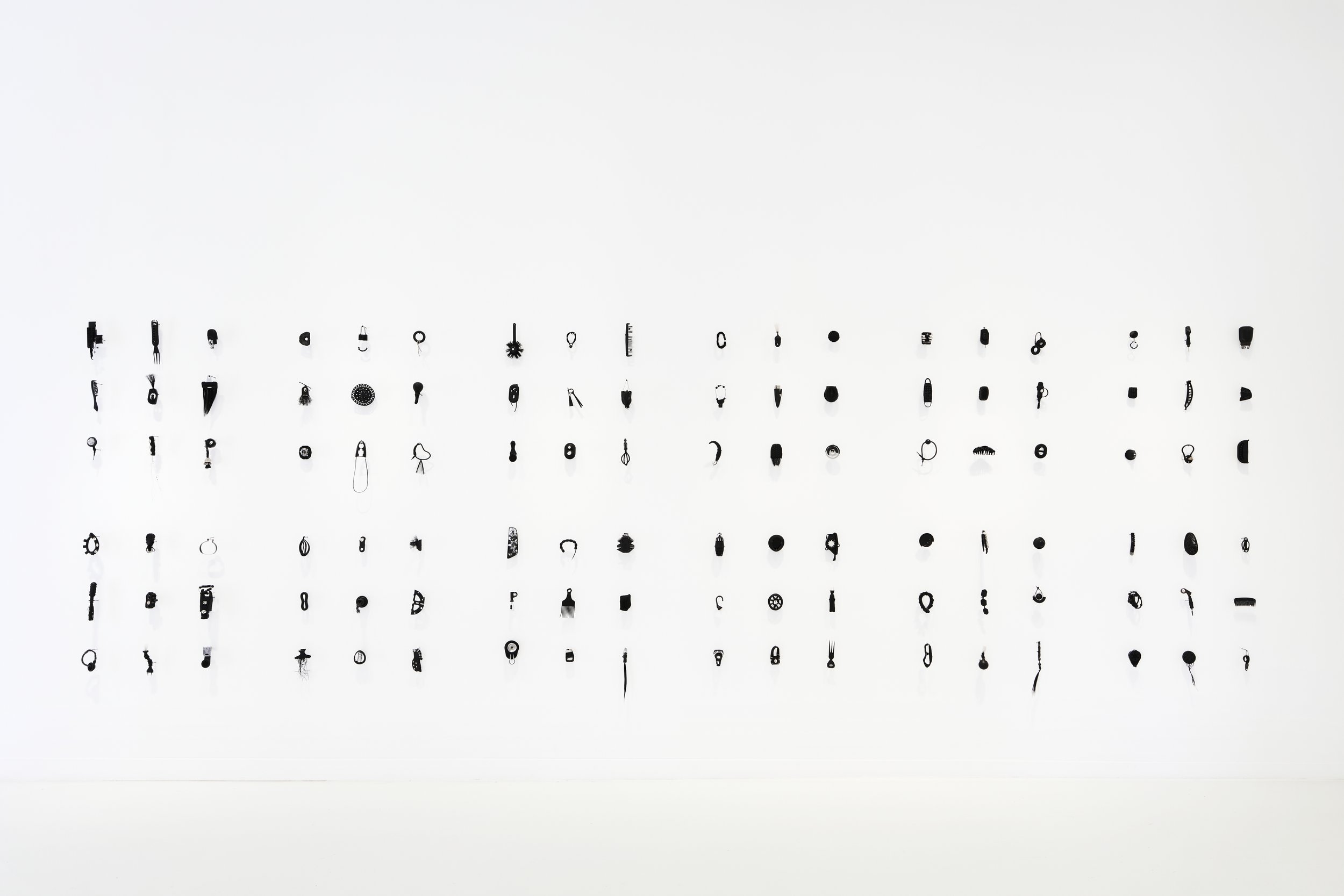
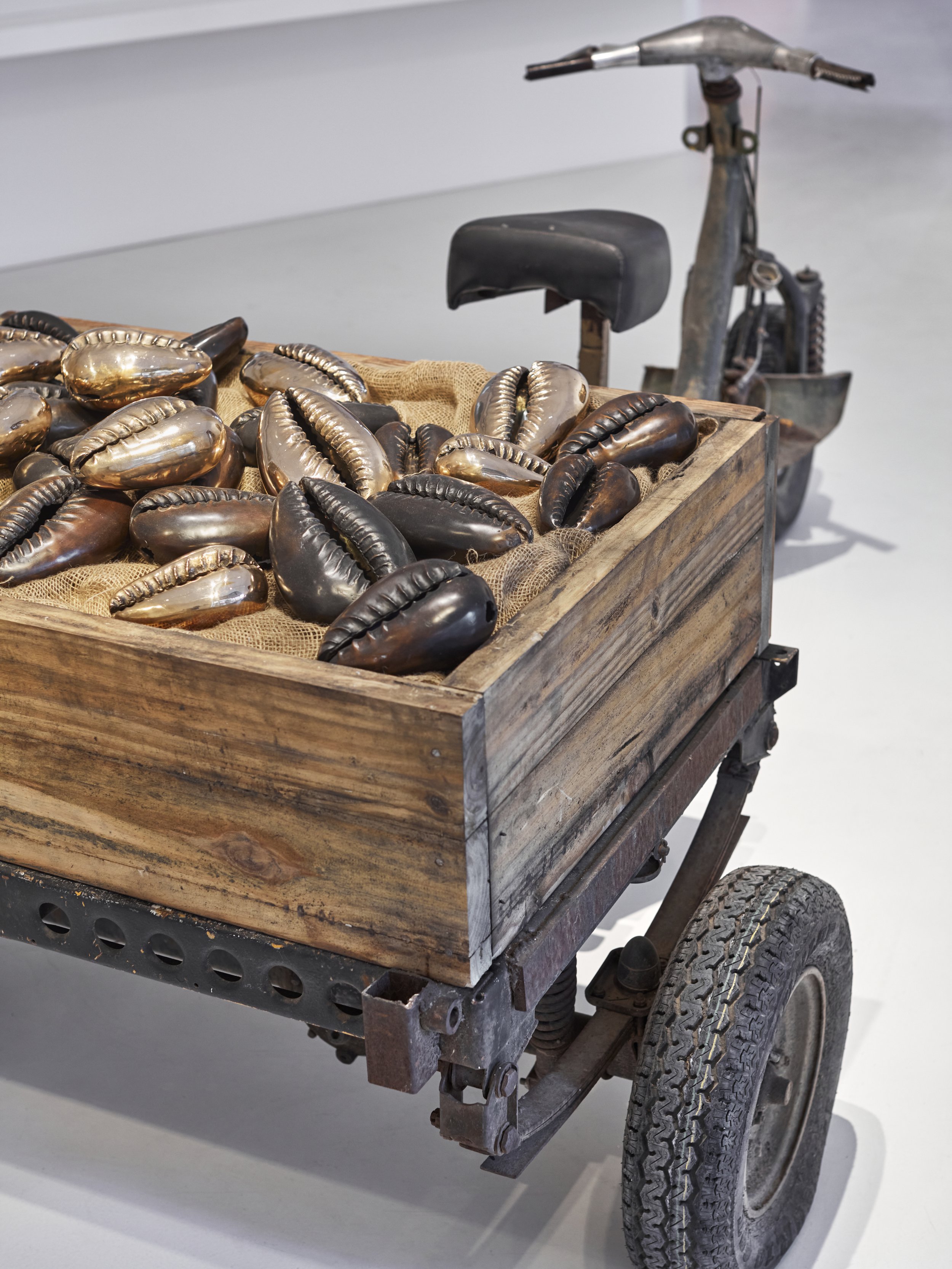



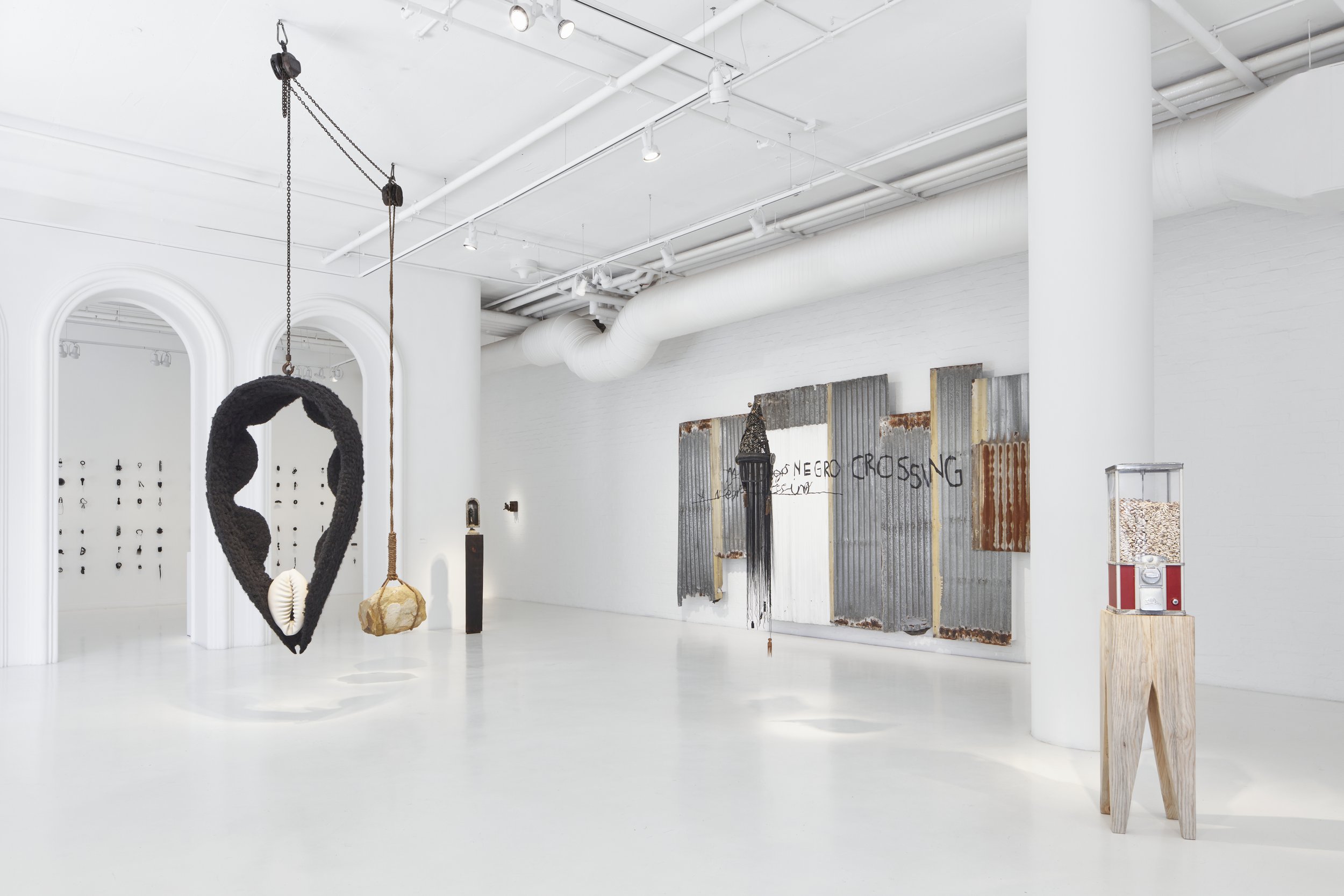
Installation views: “An Order of Being,” Southern Guild, Cape Town, 2023, courtesy of Hayden Phipps/Southern Guild
Working at a long white trestle table, strewn with an array of objects in varying shades of black – car parts, rubber debris, electrical scrap, domestic items, synthetic hair – the artist invokes the role of the “nganga” (spiritual worker in traditional Kongo religion), imbuing his everyday relics with the mystical, transforming his finds into “eminado” (the Yoruba word for good luck charm).
“Eminado are objects of pleasure and protection, they are re-imaginations of the talismans that Africans – past and present – carried for protection as they embarked on both forced and voluntary journeys across the Atlantic,” he says.
One of two expansive works in the show, the Eminado Series will comprise an installation of over 100 palm-sized talismans, their dark shapes and subtle textures contrasting sharply against the white wall. Amongst these are a baby’s pacifier with a nail driven through its base and a switchblade comb with plastic teeth on one end and a sharp metal épée on the other. Oluseye’s talismans embody both solace and danger, carrying an intriguing aura of sensuality. The tension and interplay of seemingly dichotomous ideas is prevalent throughout his practice – Christianity and indigenous African beliefs, vulnerability and strength, spirituality and sexuality.
At the heart of this exhibition is the installation Patra (Mothership) – a womb, the hull of a ship, or a carriage. Oluseye draws inspiration from the Jamaican Dancehall star Patra, one of his earliest memories of Black female empowerment, as he contemplates the symbolism of a ship as a woman. The installation consists of a large sensuous body of hair nestling a porcelain cowrie shell, and anchored by a large rock. This work attempts to highlight the contributions of Black women in the artist’s life and across intellectual and physical realms throughout history.
Through the creation of Black Exodus, the artist sought to explore and honour everyday African ingenuity. He turned to the streets and villages he visited in Nigeria, Ivory Coast, Senegal, South Africa, Kenya and elsewhere to learn from and work alongside the artisans he met – hair braiders and barbers, cobblers, basket weavers, vulcanizers and rubber recyclers, horticulturists and welders.
His chosen materials – hair, rubber, cotton, cowrie shells and mirrors – are often a medium through which to reimagine the diasporic debris. “These are loaded materials that carry with them brutal histories of enslavement and colonial conquest, oppression and pillaging but are reclaimed anew as symbols of power, resilience and good omen. I like the tension of working with them, repositioning them to give new meaning and significance,” Oluseye notes.
Black Exodus: Summer Departure centres on the transforming and repurposing of discarded items, crafting these fragments into sources of joy, play and protection. As he assembles these disparate pieces into meaningful objects, Oluseye simultaneously rebuilds his own sense of wholeness in a new form. /END

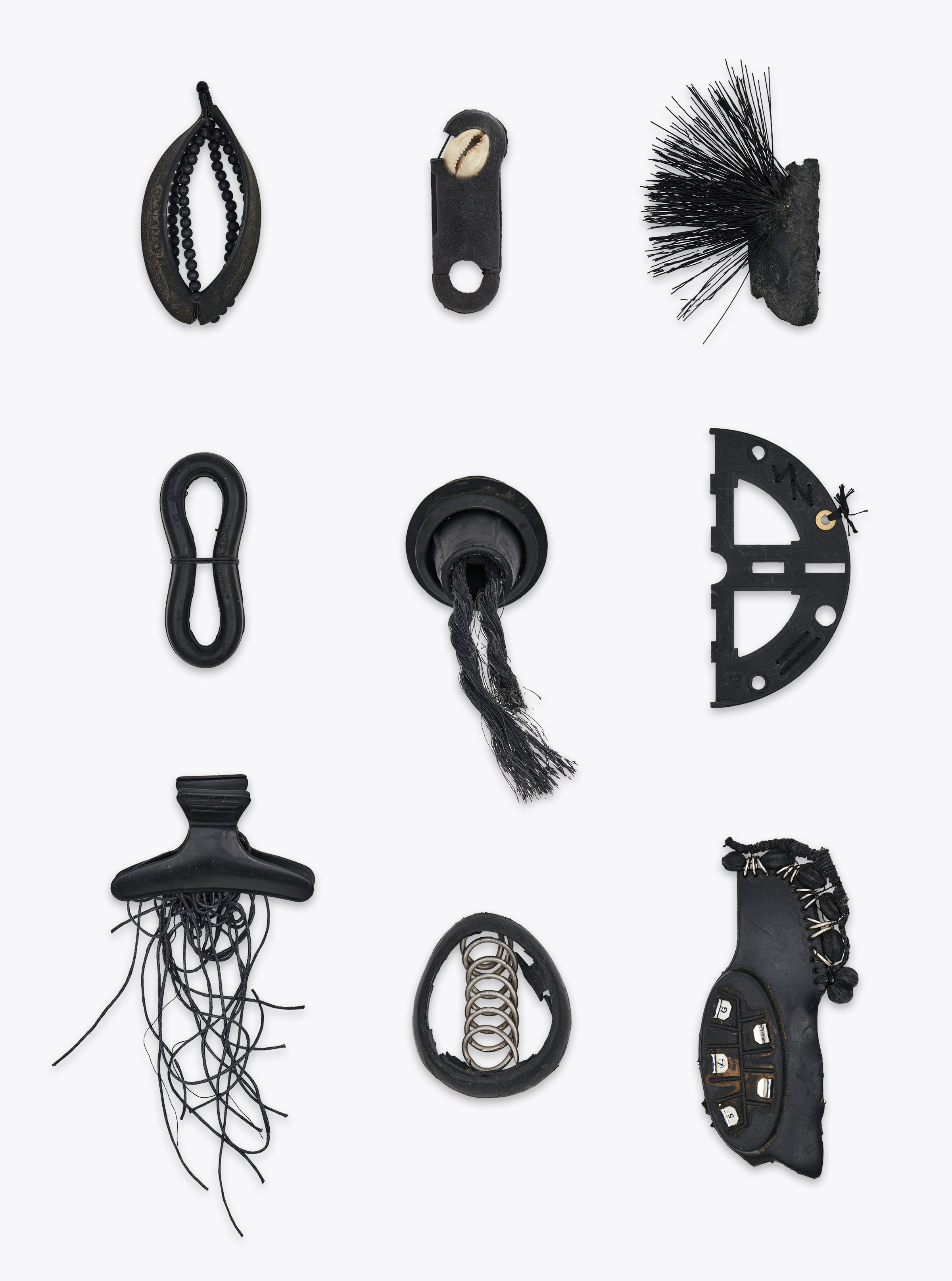
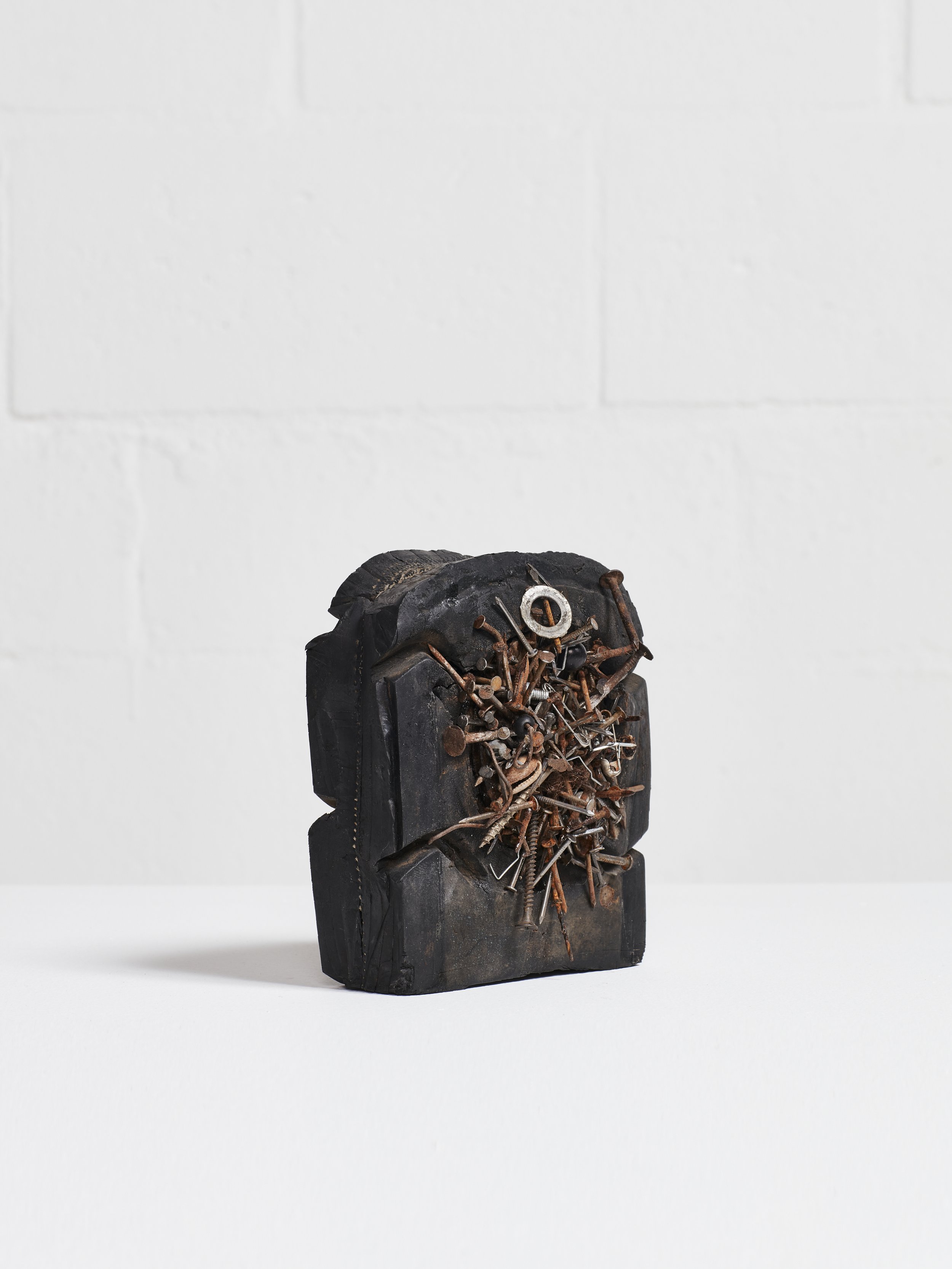
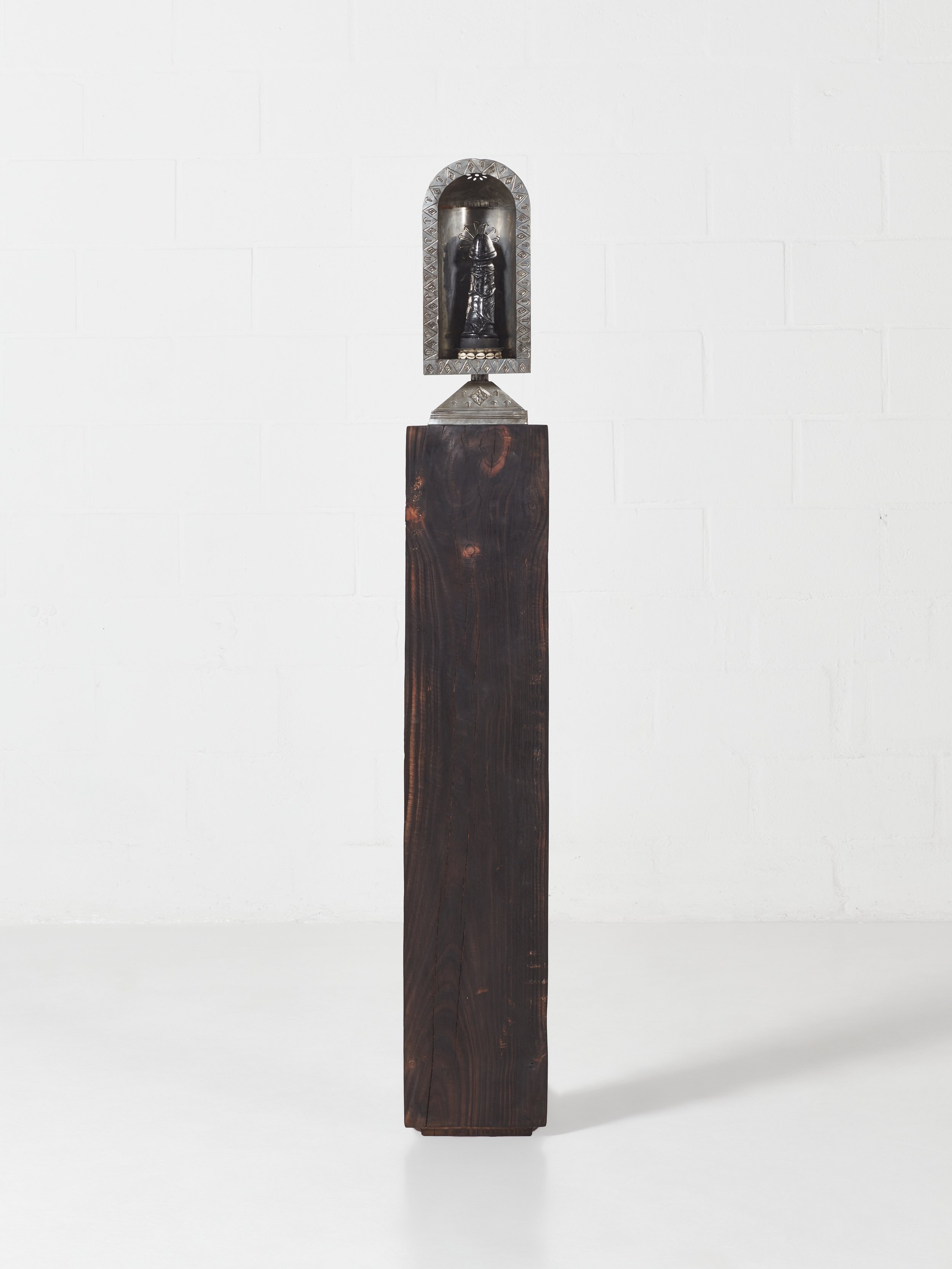
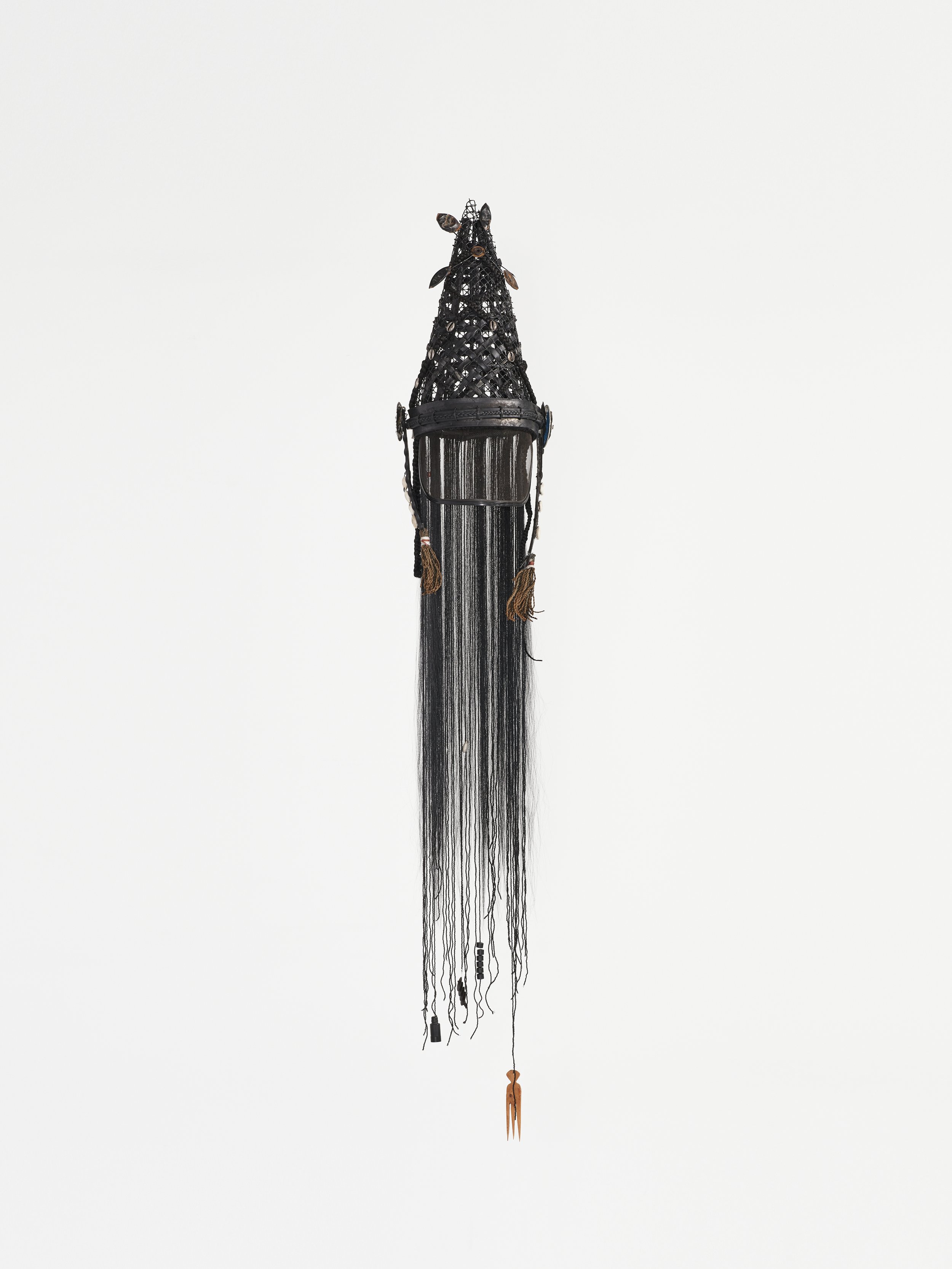

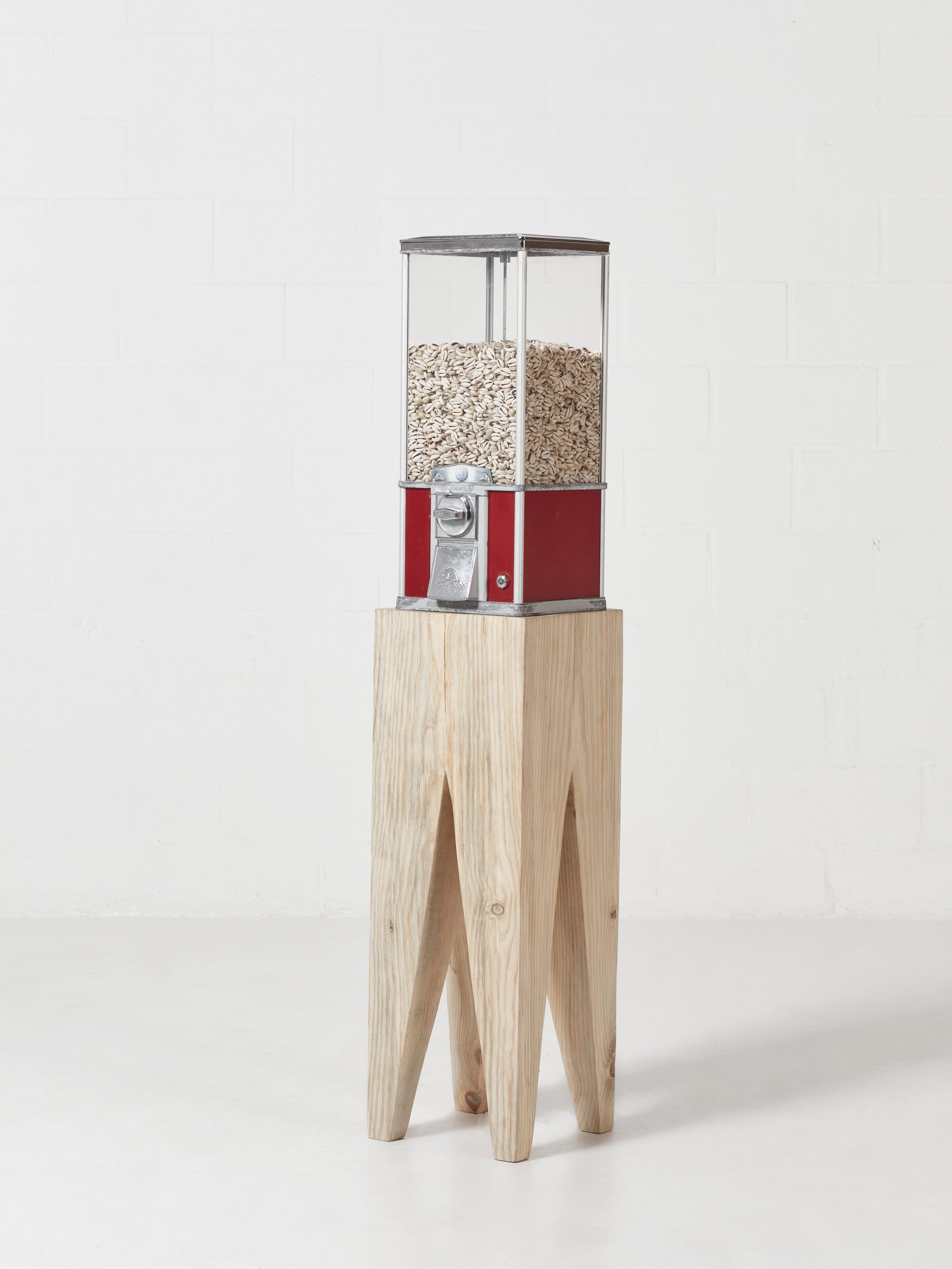
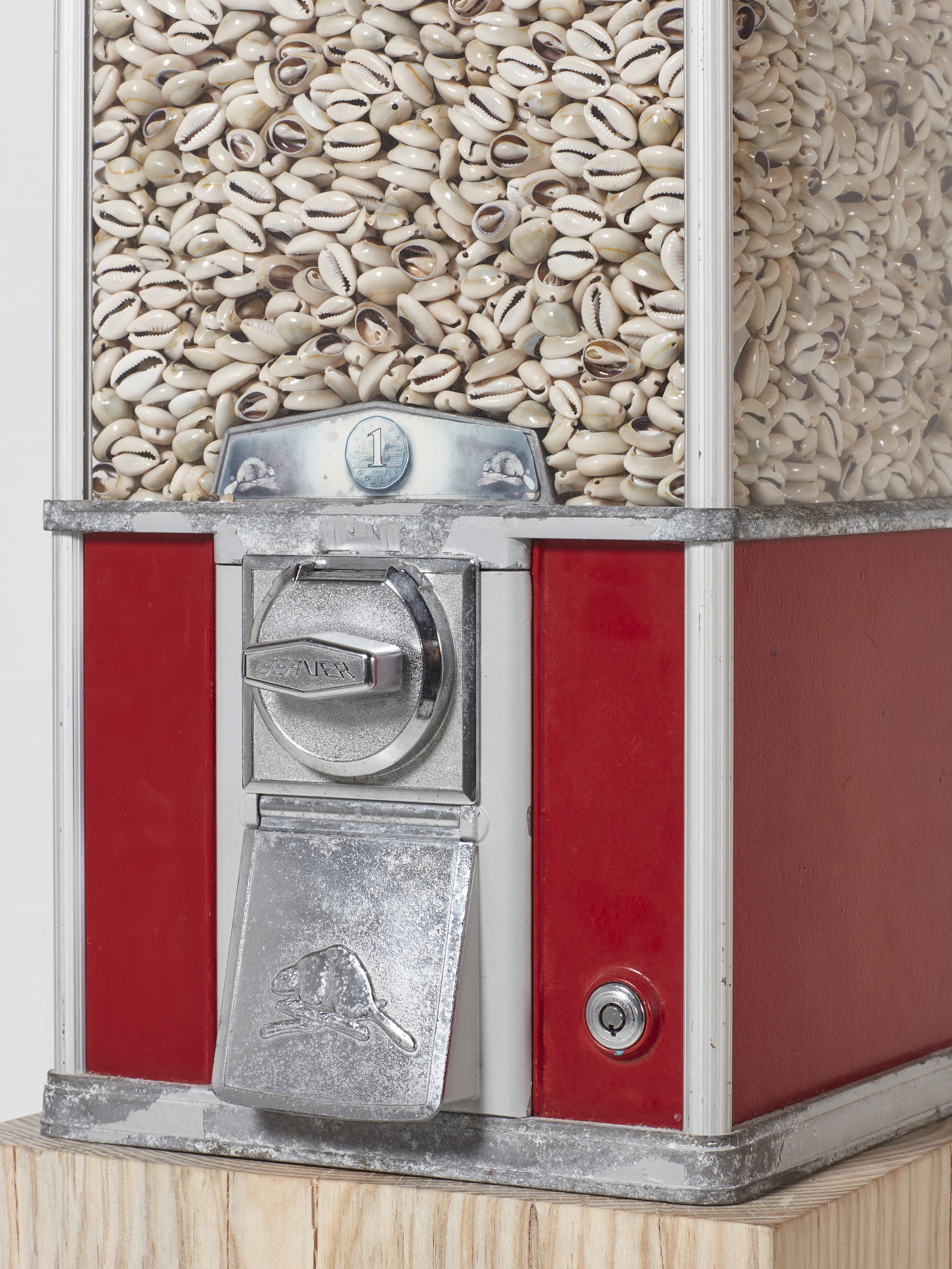
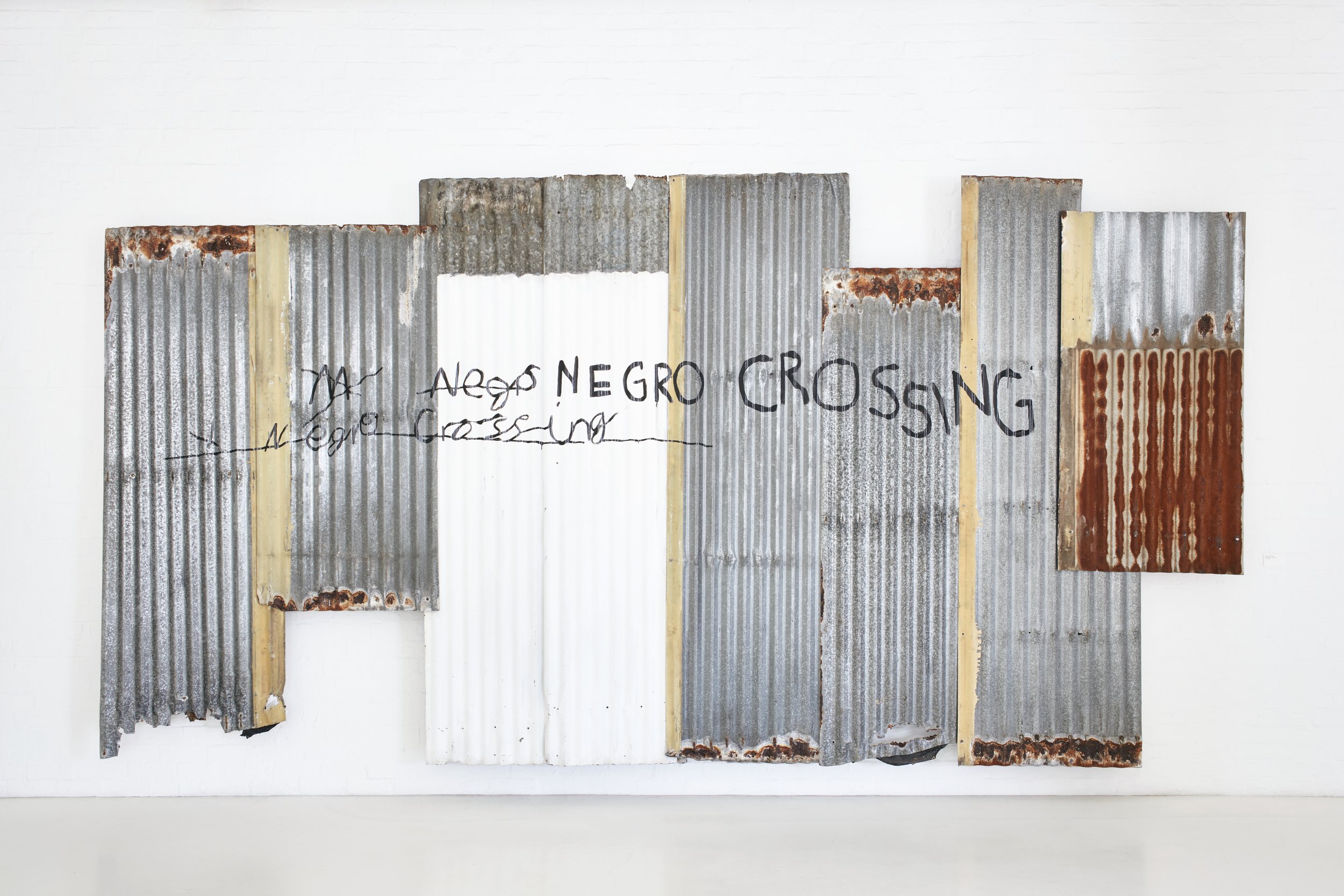
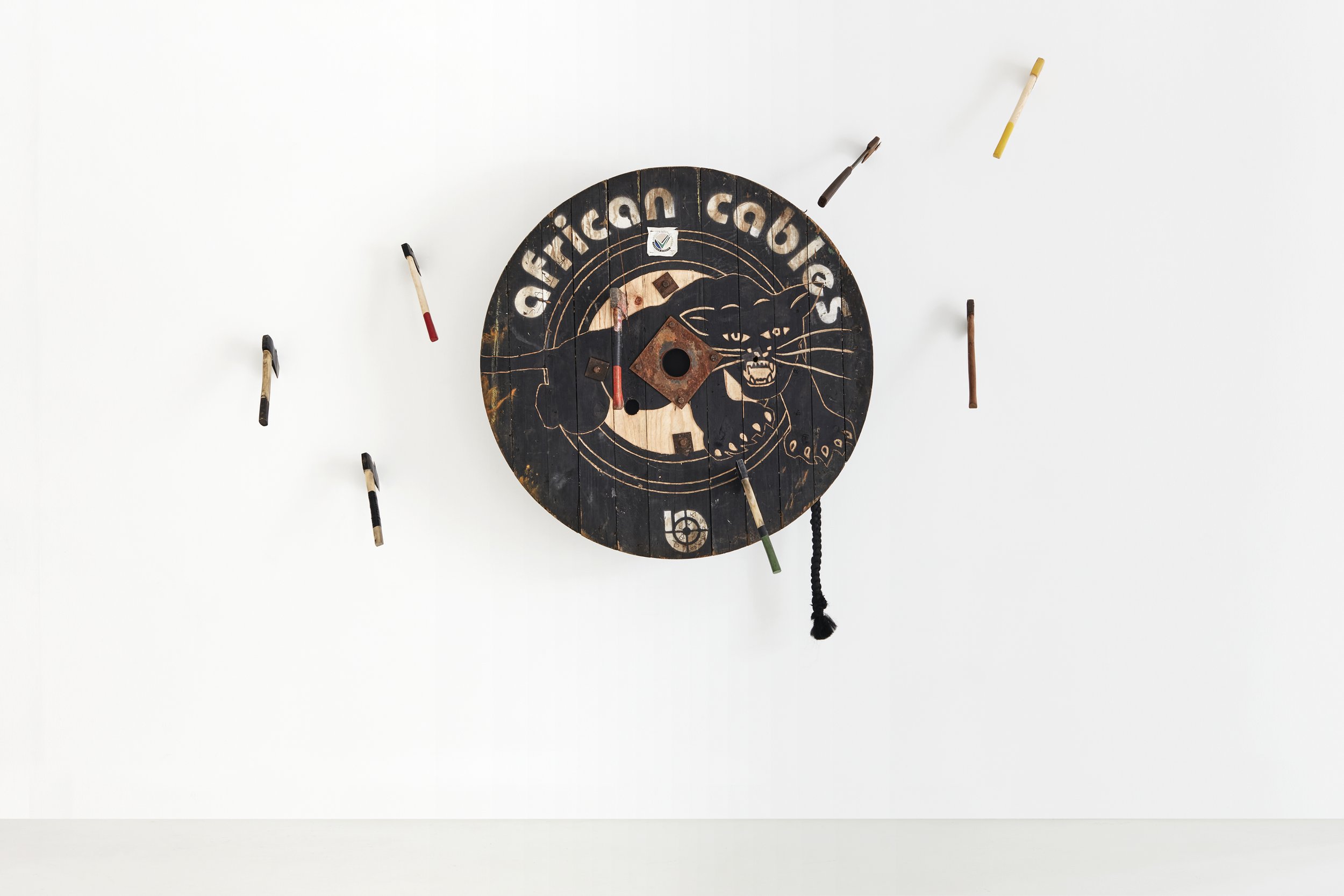
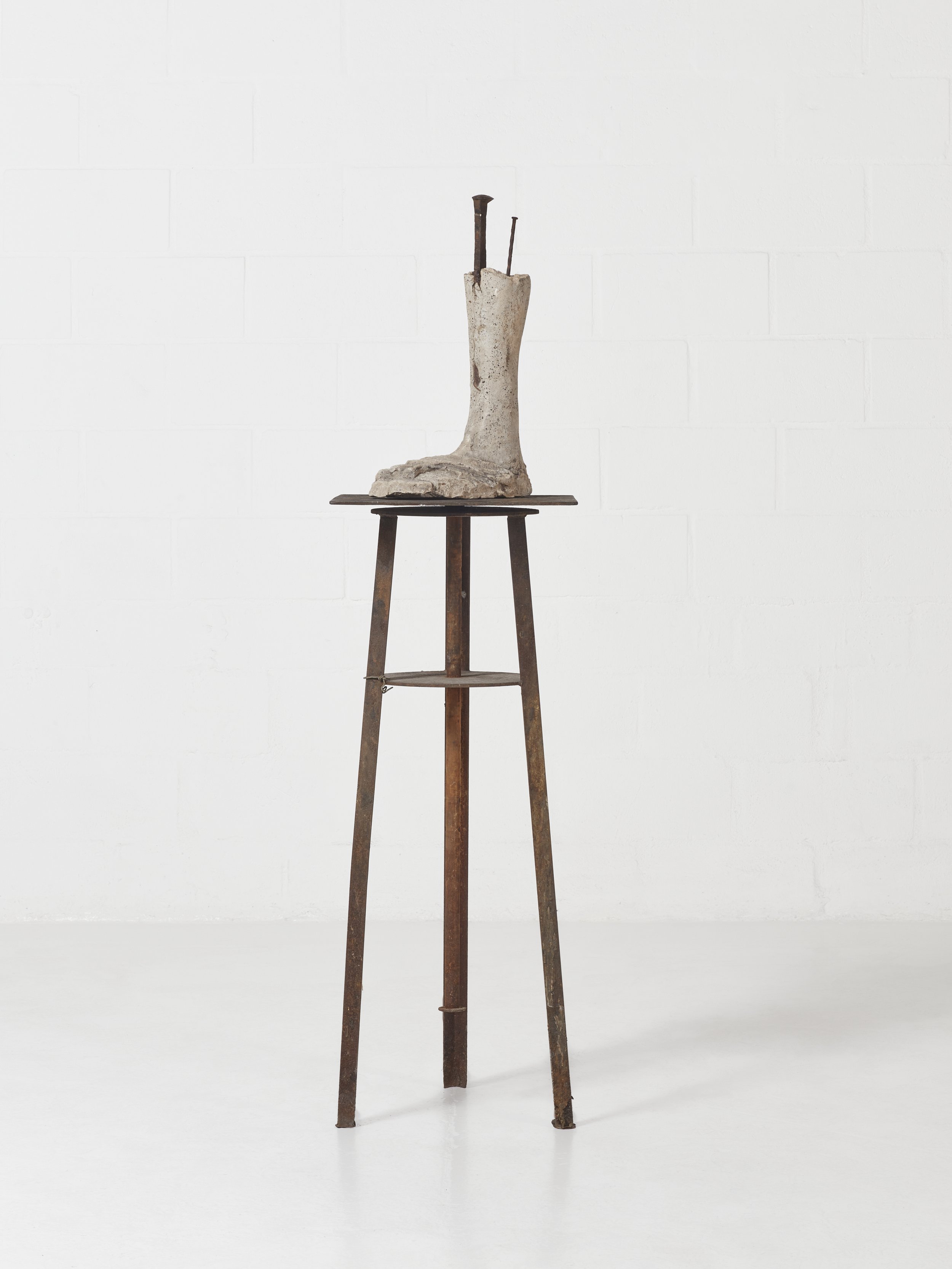
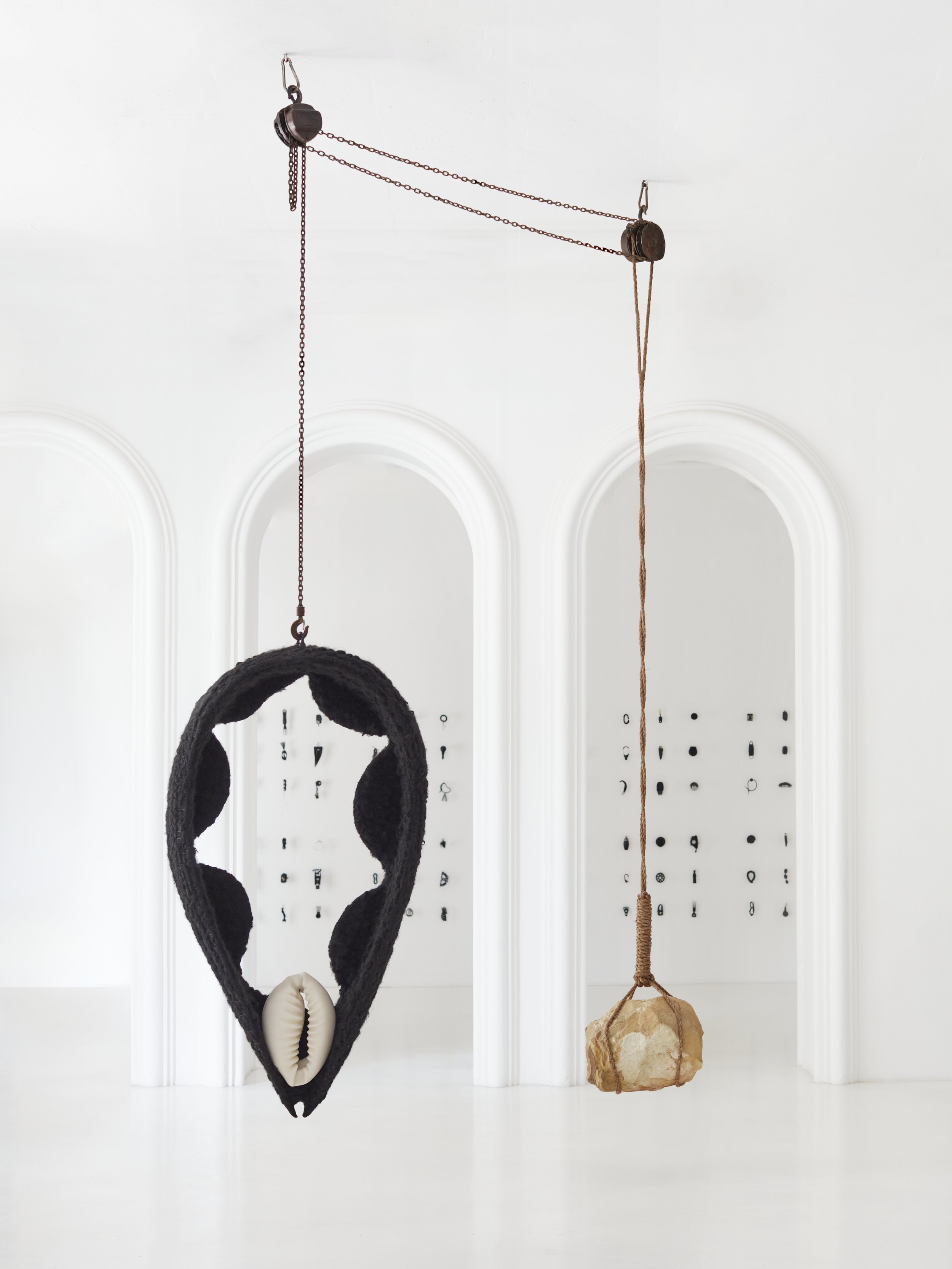
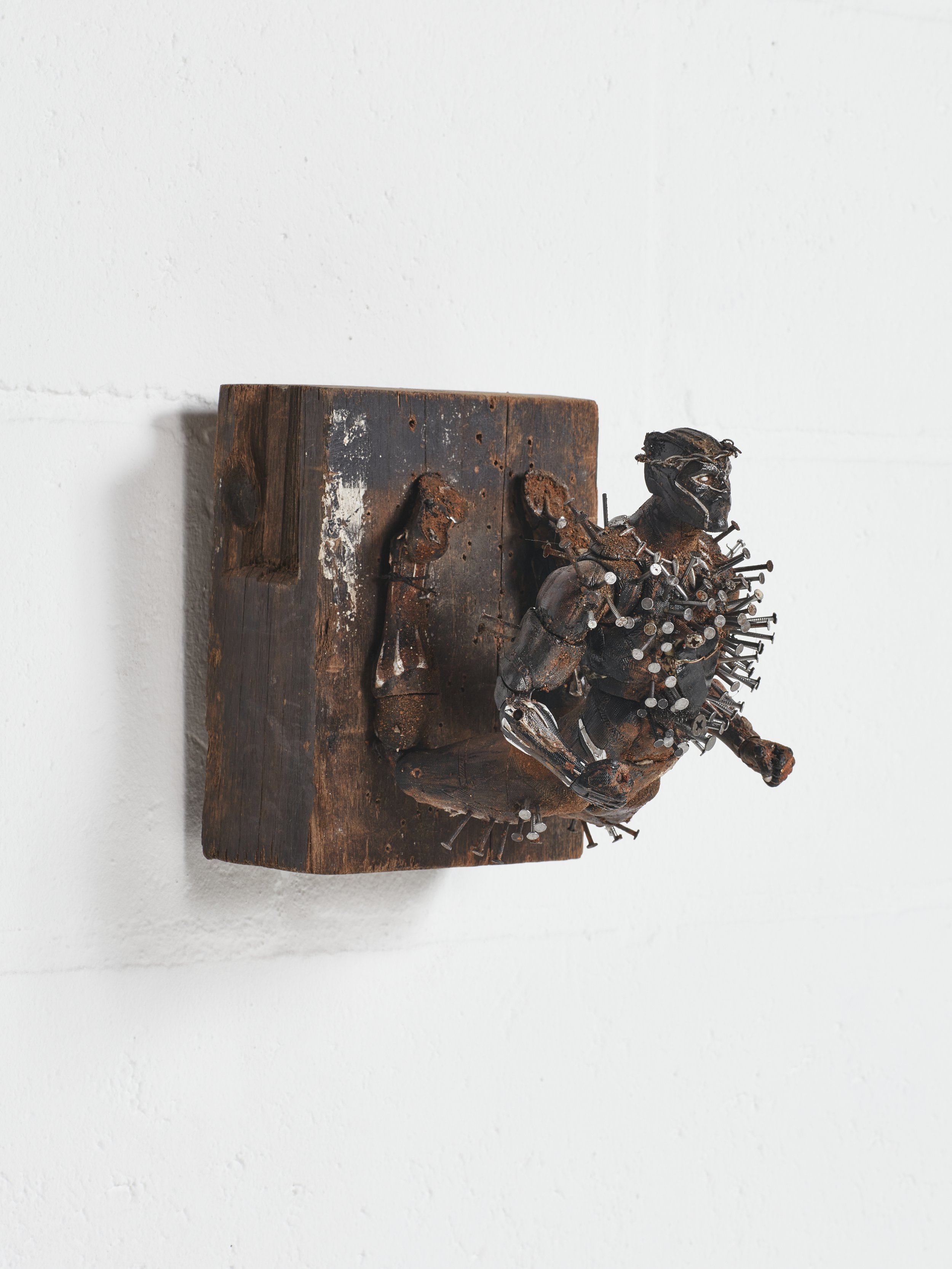
Installation views: “An Order of Being,” Southern Guild, Cape Town, 2023, courtesy of Hayden Phipps/Southern Guild
ABOUT THE ARTIST
Oluseye is a Nigerian-Canadian artist. Born in London in 1986, the artist spent his childhood years in Lagos, Nigeria before moving to Canada.
Using “diasporic debris” — a term he coined to describe the artifacts, discarded materials and found objects he collects from his trans-Atlantic travels — Oluseye explores Black being across themes. These transformational objects are recast into sculpture, performance and photography. Their explorations invoke Oluseye’s personal narratives and travels within a broader examination of Black and Diasporic cultures, migration and spiritual traditions. The talismans in his Eminado series physically trace and embody the transgenerational movement of the Black diaspora.
Across his practice, he embraces the notion of Blackness as divine, fluid and unfixed; unbound by time, space, and geographies. As such his work blends the ancestral with the contemporary, the traditional with the modern, the physical with the spiritual, the new with the old and the past with the future.
Oluseye has a Bachelor of Commerce from McGill University, Montreal, and a Master of Science in Entrepreneurship from Bayes Business School, London, UK. He has exhibited at the Albright-Knox Museum, Buffalo (2022), Museum of Contemporary Art Toronto (2021), Agnes Etherington Art Center, Queen’s University, Kingston (2021) and the Art Gallery of Ontario, Toronto (2015). His first public art commission, Black Ark, installed in Toronto’s Ashbridges Bay Park, explores Canada’s role in the Trans-Atlantic slave trade.
Oluseye was an artist-in-residence at the GUILD Residency in Cape Town in early 2023, and has presented his work with Southern Guild at the Investec Cape Town Art Fair and Expo Chicago.
ABOUT SOUTHERN GUILD
Established in 2008 by Trevyn and Julian McGowan, Southern Guild represents contemporary artists from Africa and its diaspora. With a focus on Africa’s rich tradition of utilitarian and ritualistic art, the gallery’s programme furthers the continent’s contribution to global art movements. Southern Guild’s artists explore the preservation of culture, spirituality, identity, ancestral knowledge, and ecology within our current landscape. Their work has been acquired by the Metropolitan Museum of Art, LACMA, Philadelphia Museum of Art, Pérez Art Museum, Mint Museum, Harn Museum, Denver Art Museum, Vitra Museum, Design Museum Gent and National Gallery of Victoria. Since 2018, the gallery has collaborated with BMW South Africa on a year-round programme of meaningful activations that promote artist development and propel their careers. Located in Cape Town, Southern Guild will expand internationally with a 5,000 sqft space opening in Melrose Hill, Los Angeles in February 2024.
For more information about this exhibit, please visit the Southern Guild website.
Manyaku Mashilo: An Order of Being
courtesy of Hayden Phipps/Southern Guild
The question in these textures is not ‘How did we get here?’ but ‘How will we survive here?’. ‘Here’ as in now, tomorrow, after, freedom – how will we be? We have all known to look to tomorrow in the pit of night before dawn breaks the sky’s surface. Abanye baye ngale, abanye ba wele - but today these textures ask: ‘So far, dear traveller, how have you found your way? How does it feel to be here, how will we know when we get there?’ - Julie Nxadi
Southern Guild is pleased to present An Order of Being, the gallery’s first solo exhibition by South African artist Manyaku Mashilo, opening 23 November 2023 (until 25 January 2024). The new body of figurative paintings navigate and construct an imaginative future realm. This abstracted plane – expansive in its capacity to heal, liberate and reinvent – is occupied by a collective of fluid, dreamlike figures.
Mashilo’s practice acts as a vehicle for sense-making; her canvases stand as liminal spaces for synthesising elements of her religious upbringing, ancestral heritage, both real and invented myth, folklore, science fiction, music and sourced archival photographic images. An Order of Being is a gentle confrontation with the multiplicity of the artist’s past, present and future facets of selfhood.
Though her work is rooted in the historically charged mode of portraiture, Mashilo regards her paintings as abstractions. Ethnographic photography from the 19th and early 20th centuries disseminated distorted representations of the depicted bodies, with each subject diminished through the colonial eye of Eurocentricism. Mashilo’s figures have been crafted anew, free of projection or historical reduction. “I invent characters,” she states, “I have had to create these subjects from scratch – make skin tones, plan similarities, consider race, exaggerate features – blank my slate while contending with the reality that I cannot unsee or un-know.”
These subjects hold a self-actualised power. Their gaze pierces through the onlooker, defiantly seeking some future horizon line. Their bodies have been transformed into genderless, undefined vessels. They are uncontained, able to expand and disintegrate. Each figure blooms forth from an abstracted liminality, their forms migrating through and beyond lines that appear to contour and cloak a celestial landscape.
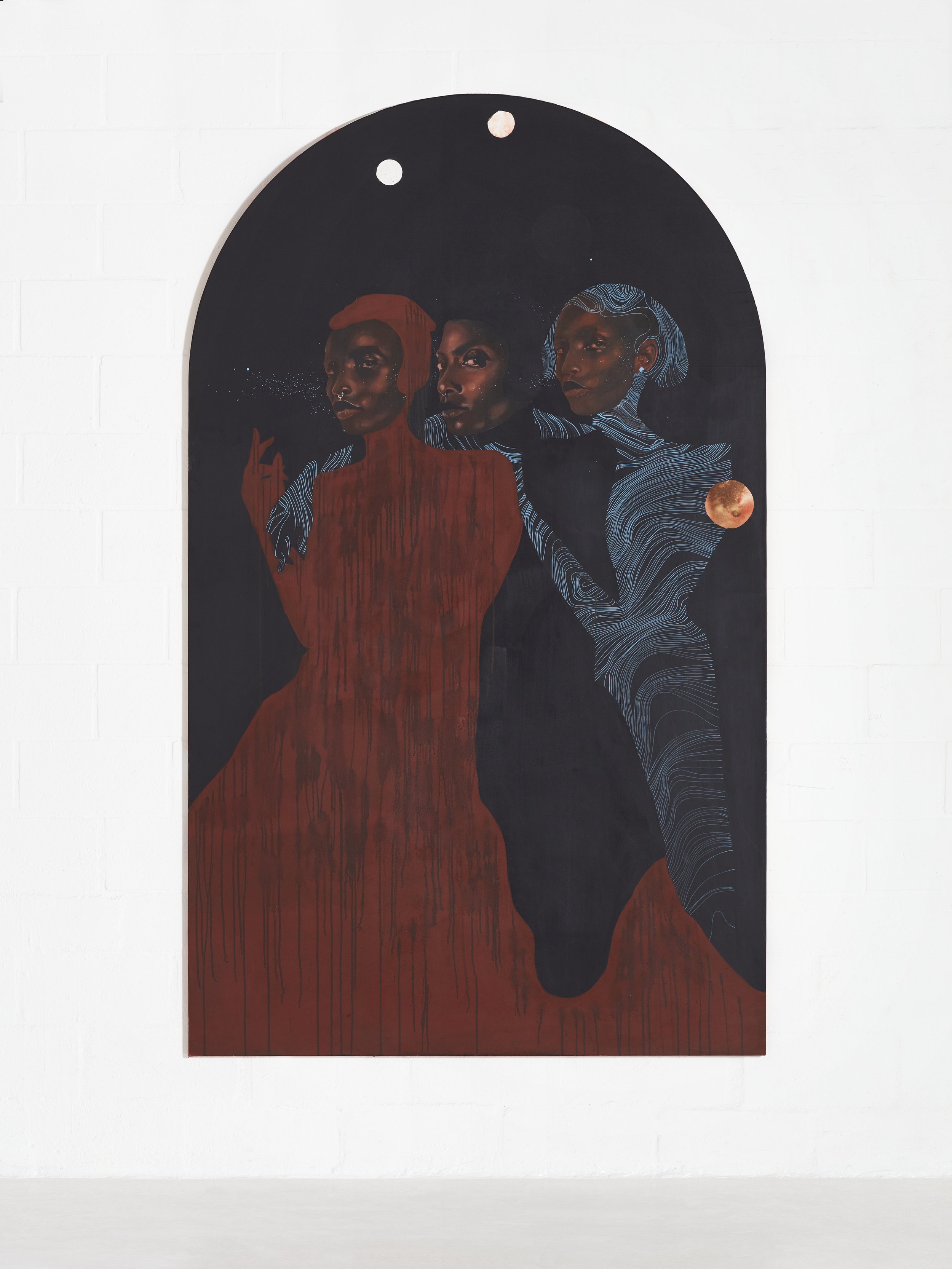
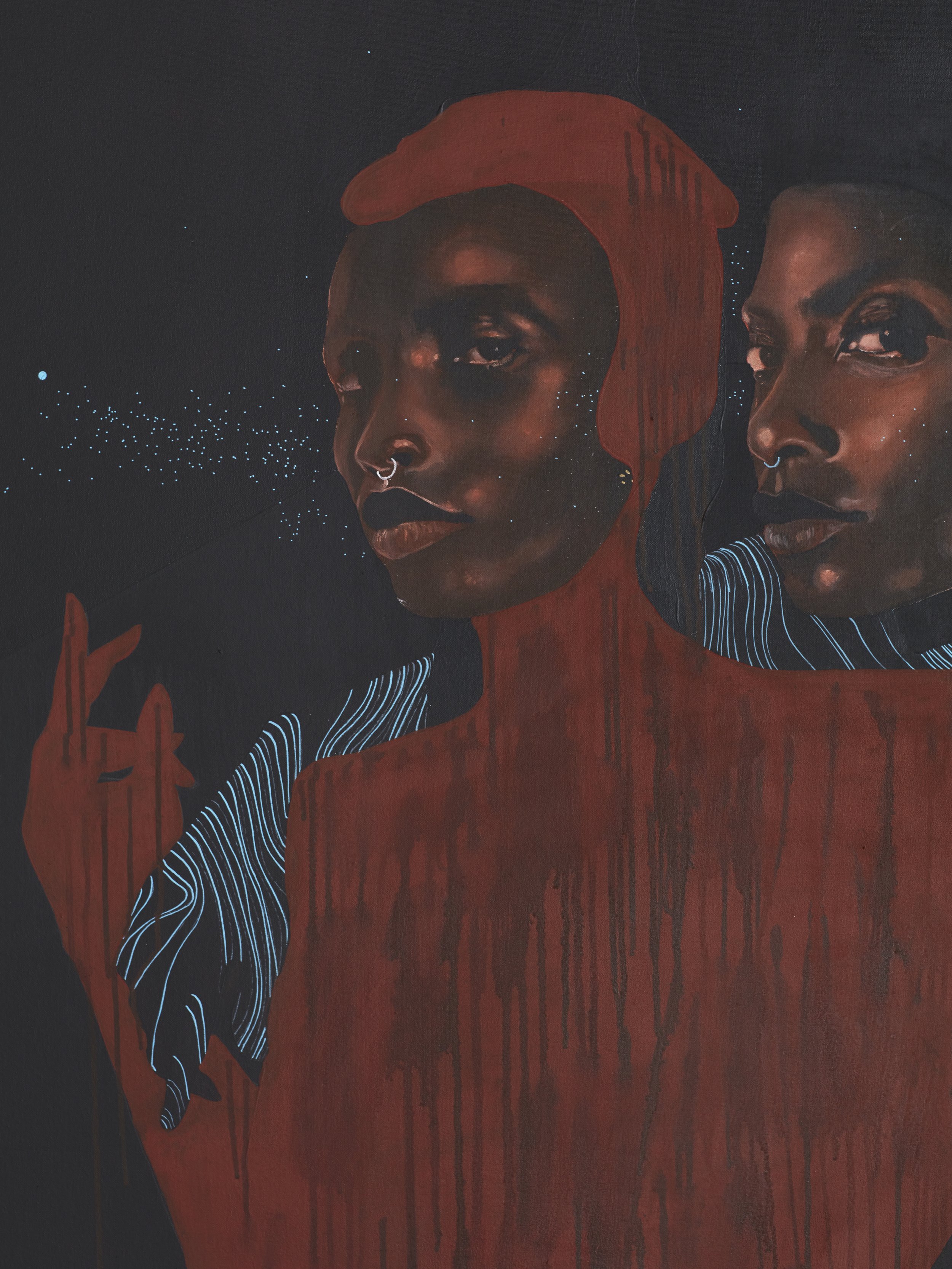

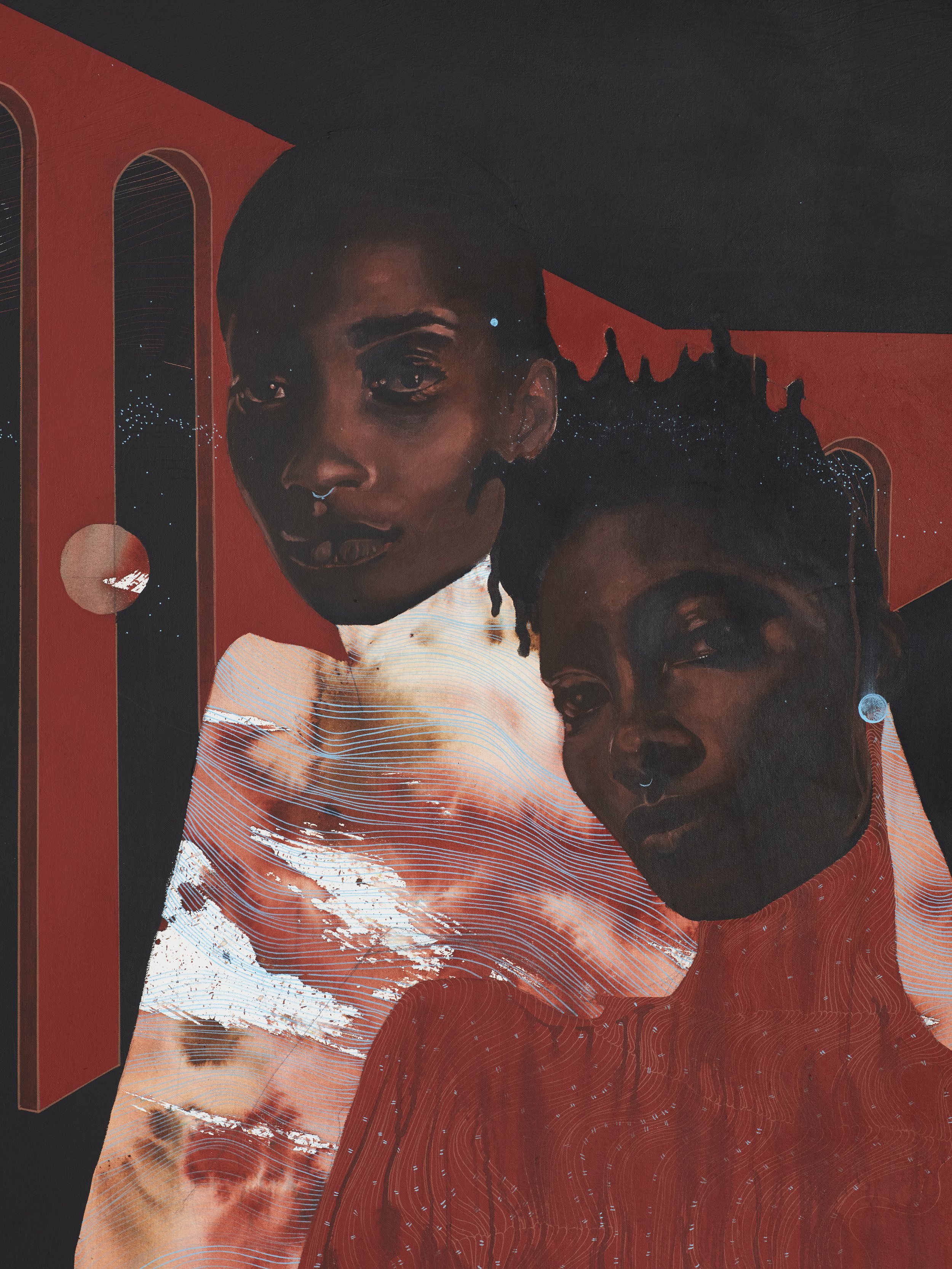

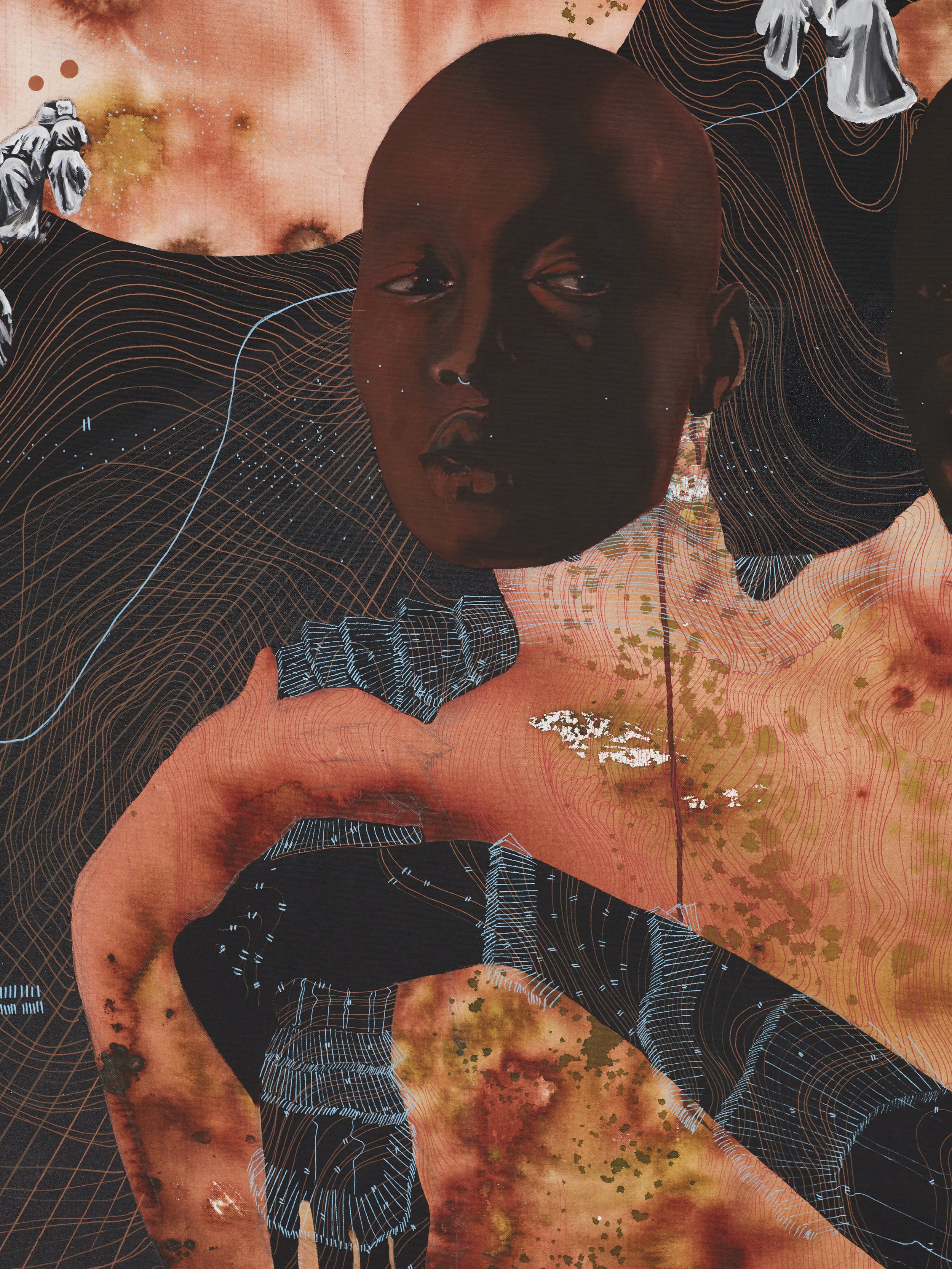

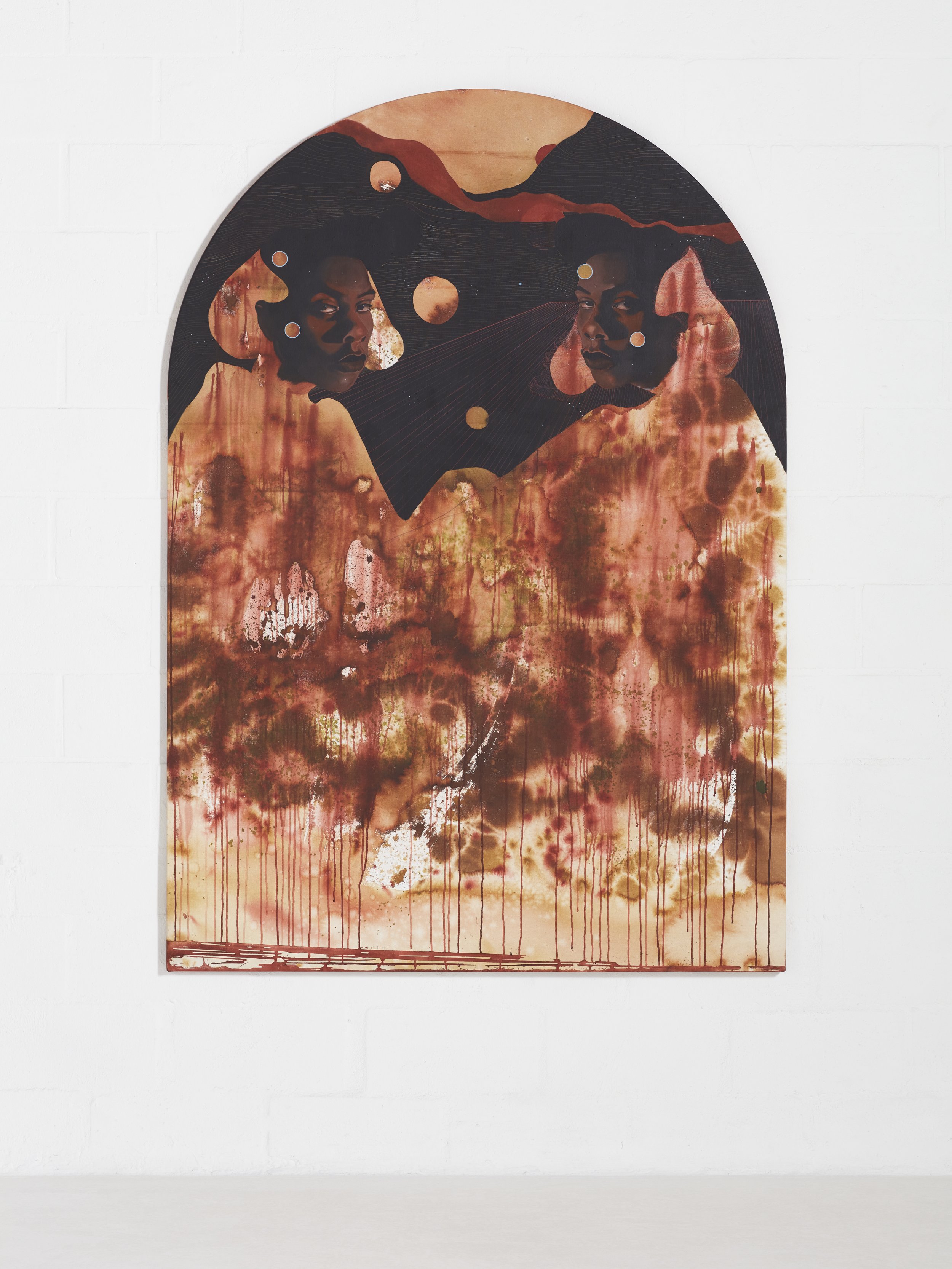
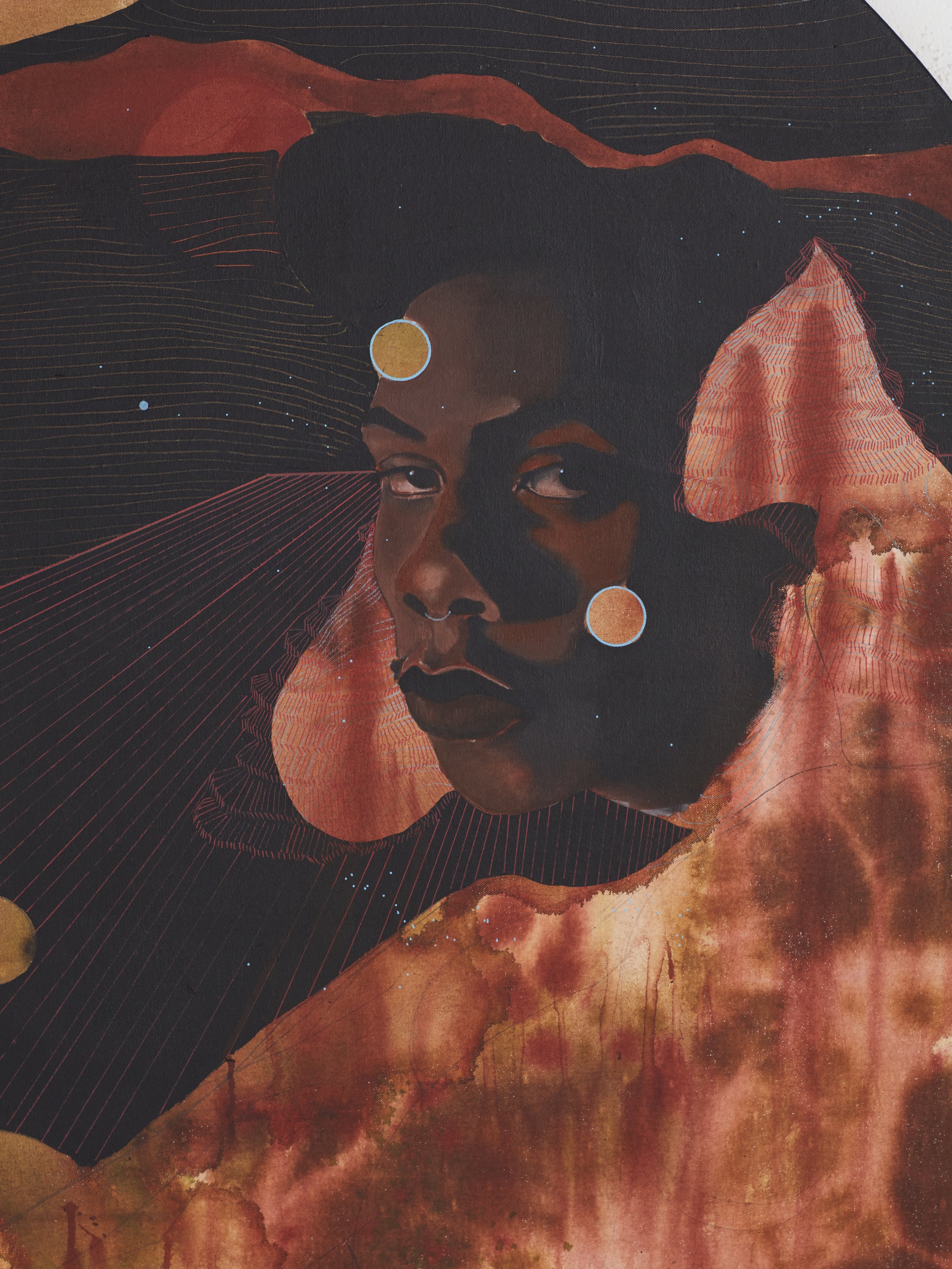
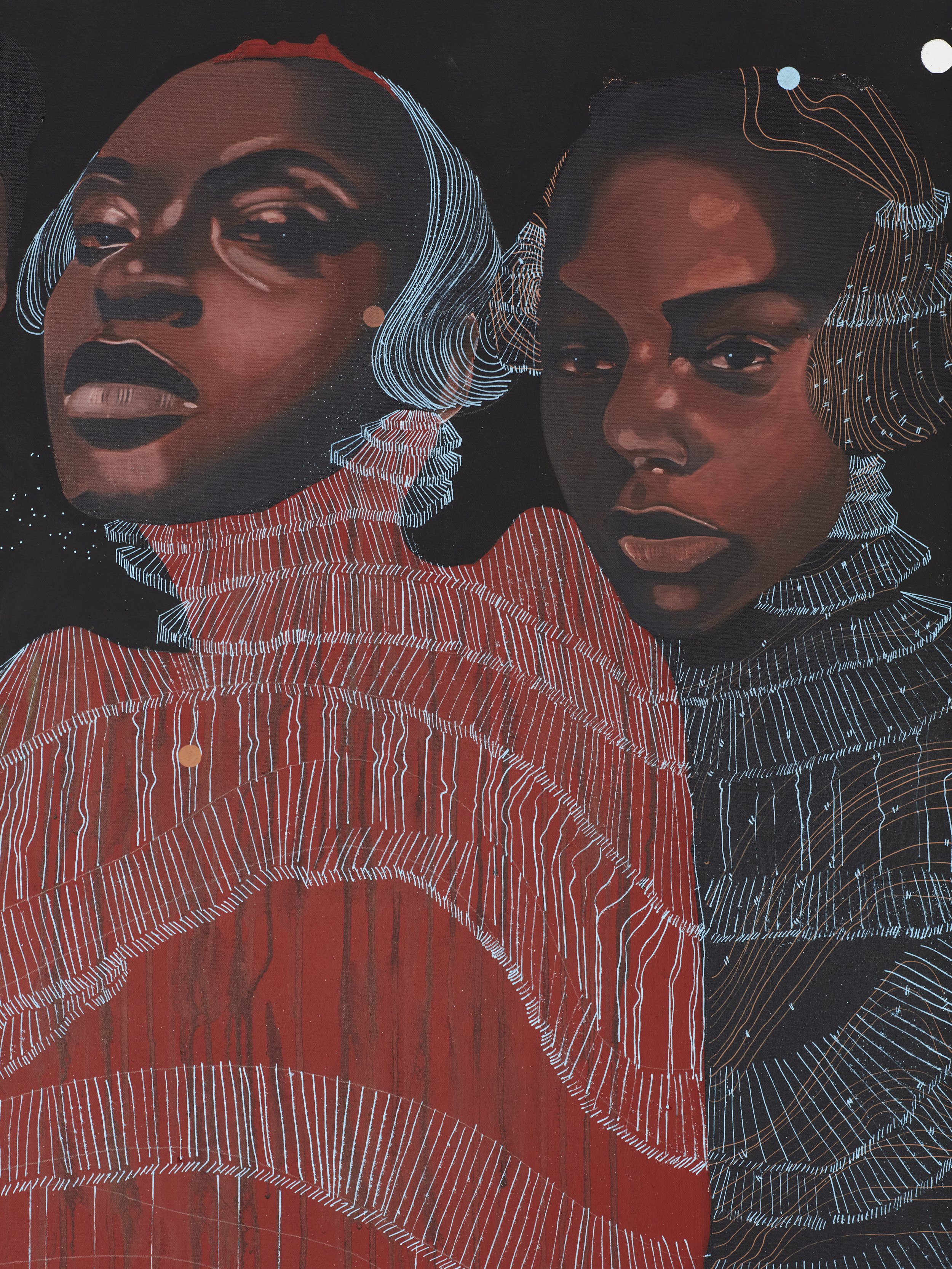


Installation views: “An Order of Being,” Southern Guild, Cape Town, 2023, courtesy of Hayden Phipps/Southern Guild
Music is a vital means to the languaging of Mashilo’s practice. The making of the exhibition’s works was deeply informed by the undulating frequencies of Blues, African gospel, spoken word and free jazz. These sounds invite ritual and a meditative space for free movement. It is this somatic experience, in its spontaneity and distinct capacity to change course, that inspires the flowing contours of Mashilo’s repeated line work. Multiple readings of these contour patterns are possible: the spiralling patterns of human fingerprints, ripples emanating from a central impact point, and the structural co-ordinates of yet-to-be-discovered clusters of stars.
“There are other worlds they have not told you of” has become a welcome mantra for the artist. The phrase was spoken by American composer, musician and poet Sun Ra (1914-1993), who recounted an epiphanic encounter with otherworldly beings following a space journey he said took place in Alabama in 1936. His resulting life-long catalogue of music – a joyful, cosmic cacophony of electronic jazz – would retrospectively be defined as a pioneering influence of Afrofuturism. Akin to the Astro-Black mythology of Sun Ra’s musical language, Mashilo’s paintings traverse a peripheral alternate space, blending the real and unreal, correcting the burdensome weight of historical injustices with the lightness and hope of what may still be yet to come.
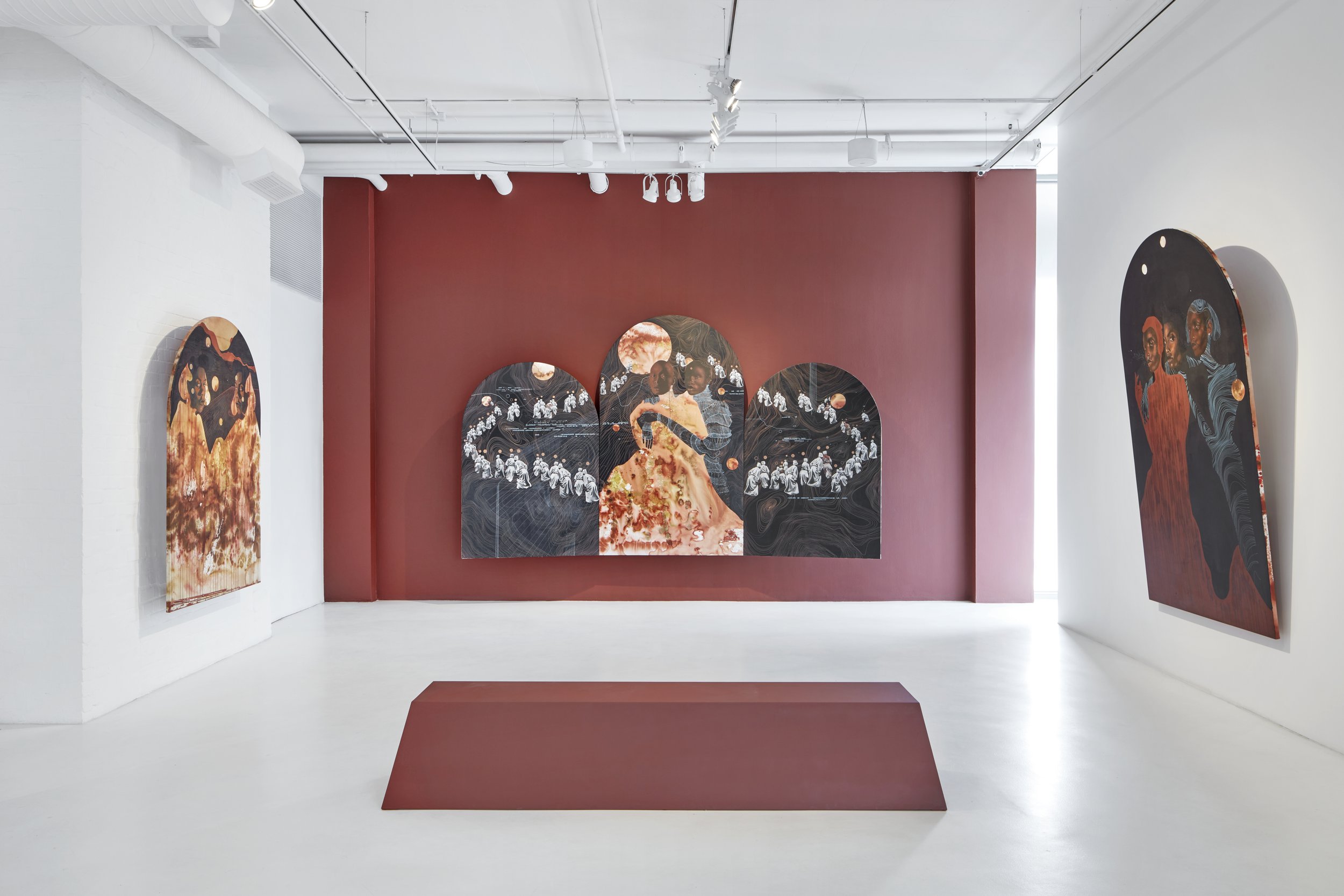
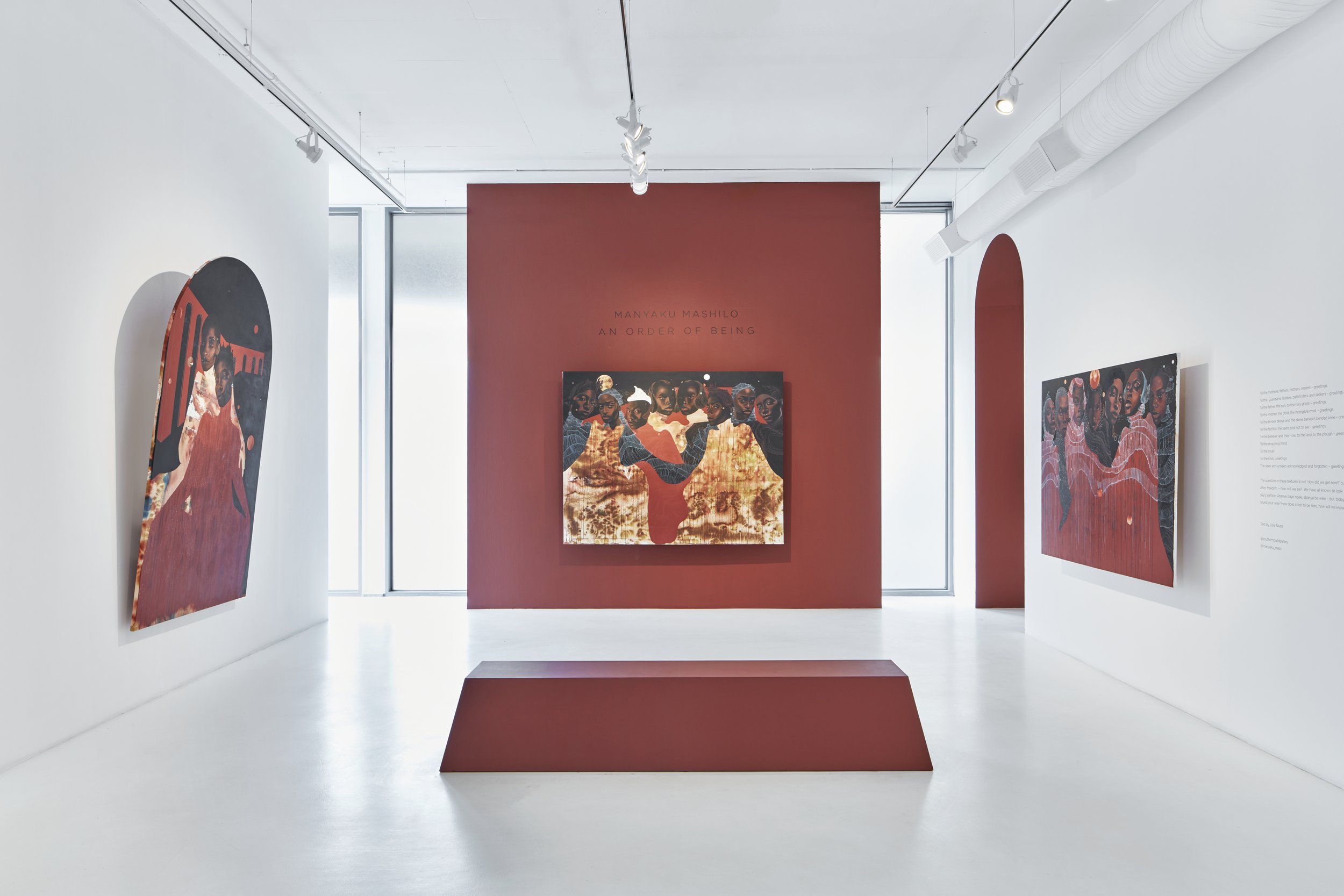

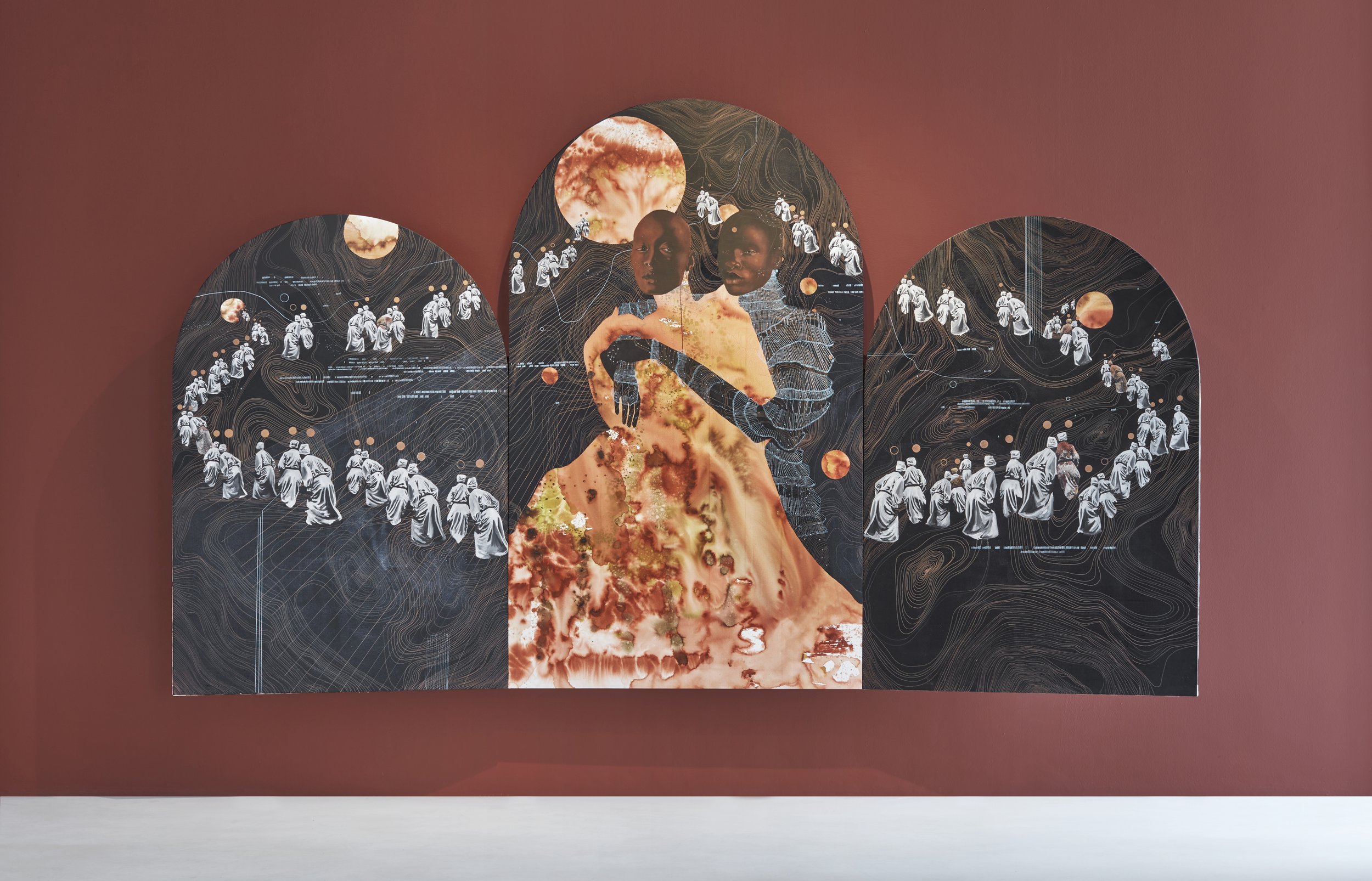
Installation views: “An Order of Being,” Southern Guild, Cape Town, 2023, courtesy of Hayden Phipps/Southern Guild
The exhibition presents a new multi-panelled triptych, comprising three large-scale arch-shaped canvases. Beyond its associations with religious architecture, the arch becomes a visual metaphor for liminal movement: a simultaneous conduit for exiting and entering. The recurring use of red ochre in this body of work connotes clay, blood and the traditional ointment of “imbola”, a thick paste of burnt earth pigment applied to the faces of Xhosa women and newly initiated youth.
An Order of Being resists singular compartmentalization of the self and the cultural practices that have come to define and inform Mashilo’s unfolding sense of the world. Her subjects shapeshift between hybridised identities to welcome an alternative understanding of how a person comes into being. This future world does not repress or shame this complexity; it welcomes and holds expansive space for an evolving and indefinable multiplicity.
ABOUT THE ARTIST
Manyaku Mashilo is a Cape Town-based artist whose multidimensional practice encompasses mixed-media painting, drawing, and collage. Born in Limpopo in 1991, she addresses themes of spiritual identity, memory, ancestry, community and belonging.
Mashilo draws on inspiration from photographic archives to build expansive scenes where imagined representatives of Blackness migrate through abstract liminal spaces. These scenes act as celestial cartographies, connecting the depicted Black figures through a felt mutuality of heritage, spirituality, shared ritual and intent. These migratory figures, forever moving between and through, are driven by an energetic pull toward a new vanguard where purpose and representation can be renegotiated.
Mashilo’s figures are drawn from family photographs, historical imagery depicting various experiences of Black lives and portraits of people from her own community. In this way, Mashilo enmeshes the contemporary and historical as a form of interdimensional mapping. Lineage and memory, both collective and personalised, conflate in this unknown world. Her vast cosmological landscapes offer a multiverse of imagined futures, weaving together place and space, charting a rich and diverse tradition of African spirituality and identity.
Mashilo’s solo exhibition at Southern Guild, An Order of Being, in 2023 follows solos at 99 Loop Gallery in Cape Town and the Klein Karoo National Arts Festival, both in 2020. Southern Guild has presented her work at The Armory Show in New York, Expo Chicago and the Investec Cape Town Art Fair.
Her work was recently included in Spectrum: On Color and Contemporary Art at the Museum of the African Diaspora in San Francisco, Africa Supernova at Kunsthal KAdE in Amersfoort, The Netherlands, and Rites of Passage at Gagosian, London. Mashilo has also participated in exhibitions at the African Artists Foundation in Lagos, the Javett Centre in Pretoria, Art X Lagos with SMO Contemporary and Unit London. Her work forms part of the Shulting Art Collection, Tiroche Deleon Collection, and The Suzie Wong Collection as well as private collections in the United Kingdom, Nigeria, Korea and United States.
ABOUT SOUTHERN GUILD
Established in 2008 by Trevyn and Julian McGowan, Southern Guild represents contemporary artists from Africa and its diaspora. With a focus on Africa’s rich tradition of utilitarian and ritualistic art, the gallery’s programme furthers the continent’s contribution to global art movements. Southern Guild’s artists explore the preservation of culture, spirituality, identity, ancestral knowledge, and ecology within our current landscape. Their work has been acquired by the Metropolitan Museum of Art, LACMA, Philadelphia Museum of Art, Pérez Art Museum, Mint Museum, Harn Museum, Denver Art Museum, Vitra Museum, Design Museum Gent and National Gallery of Victoria. Since 2018, the gallery has collaborated with BMW South Africa on a year-round programme of meaningful activations that promote artist development and propel their careers. Located in Cape Town, Southern Guild will expand internationally with a 5,000 sqft space opening in Melrose Hill, Los Angeles in February 2024.
For more information about this exhibit please visit the Southern Guild website.
Rineke Dijkstra Night Watching and Pictures from the Archive
Kolobrzeg, Poland, July 27, 1992, 2023 Archival inkjet print Image: 59 x 46 7/8 in. (150 x 119 cm) Courtesy of the artist and Marian Goodman Gallery Copyright: Rineke Dijkstra
Marian Goodman Gallery is pleased to present a new exhibition of Rineke Dijkstra. The exhibition will include the East Coast premiere of Night Watching (2019), a three-channel video installation commissioned and first shown at the Rijksmuseum in Amsterdam in 2019. Dijkstra will also present a selection of never before-seen works following a two-year period of revisiting her archive. These include new pictures from her Beach Portrait series, as well as selected portraits that span a decade created in locations all over the world. Both Night Watching and the new photographs show the diverse ways in which people connect to each other, to the camera, to art and to the viewer.
Night Watching (2019), a three-channel video installation, features 14 groups of people observing and speaking in front of Rembrandt's iconic painting The Night Watch (1642). These conversations vary from visual descriptions to conjectures on the circumstances in which the painting was created. A group of Dutch schoolgirls discuss whether Rembrandt gave the only woman in the painting the face of his wife Saskia; Japanese businessmen consider the painting’s potential for tourism; and a group of young artists discuss what it must feel like to make such an incomparable masterpiece. The scenes in the video are sequenced to explore the different ways a viewer might relate to a painting and its subject. The first groups speculate about what they are seeing: for instance, a dog painted in a vague manner, or an illuminated girl. They are followed by groups who link similar observations to their own personal lives, making comparisons between past and current society. The final groups examine the painting within an art historical context.

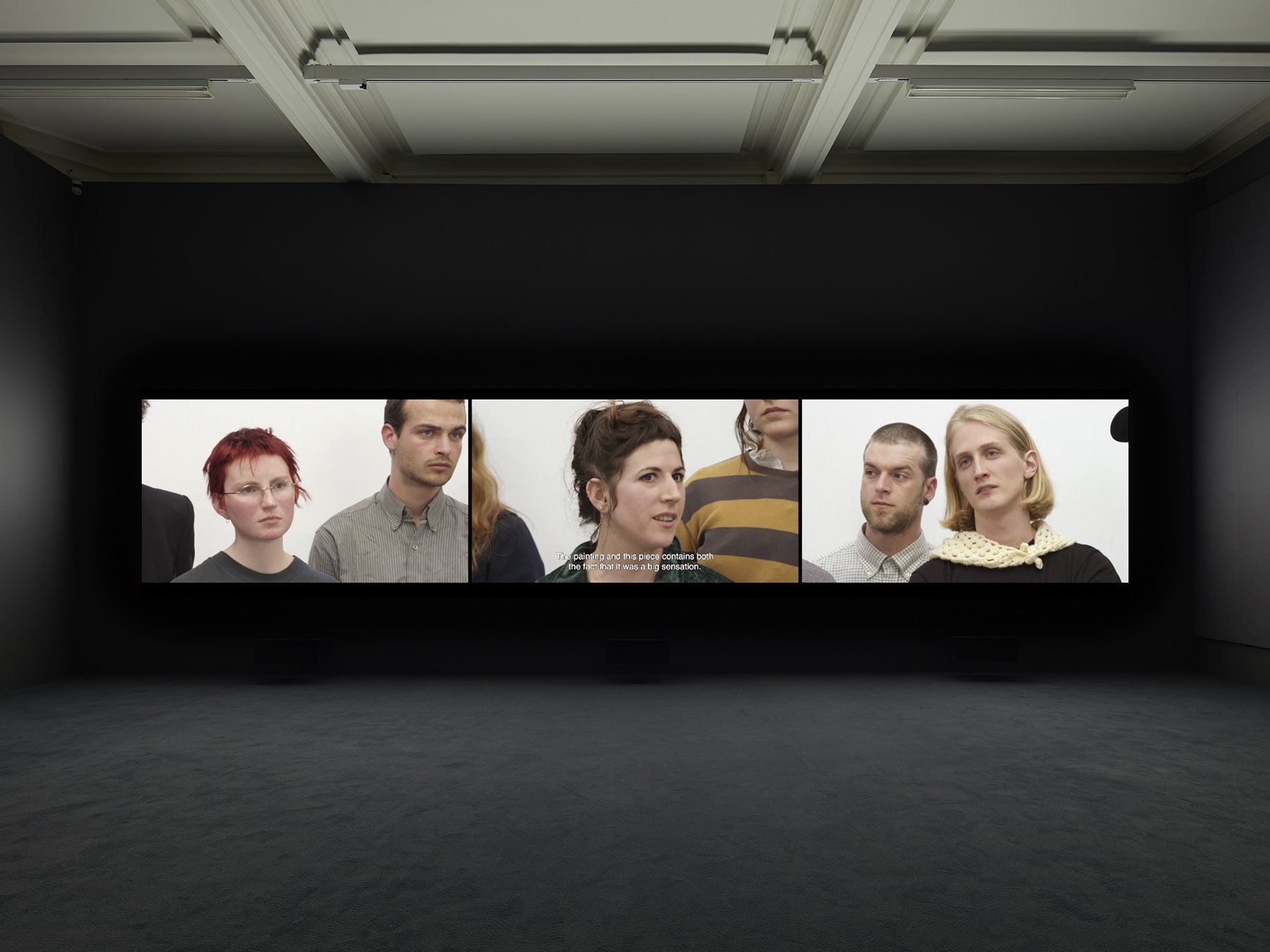

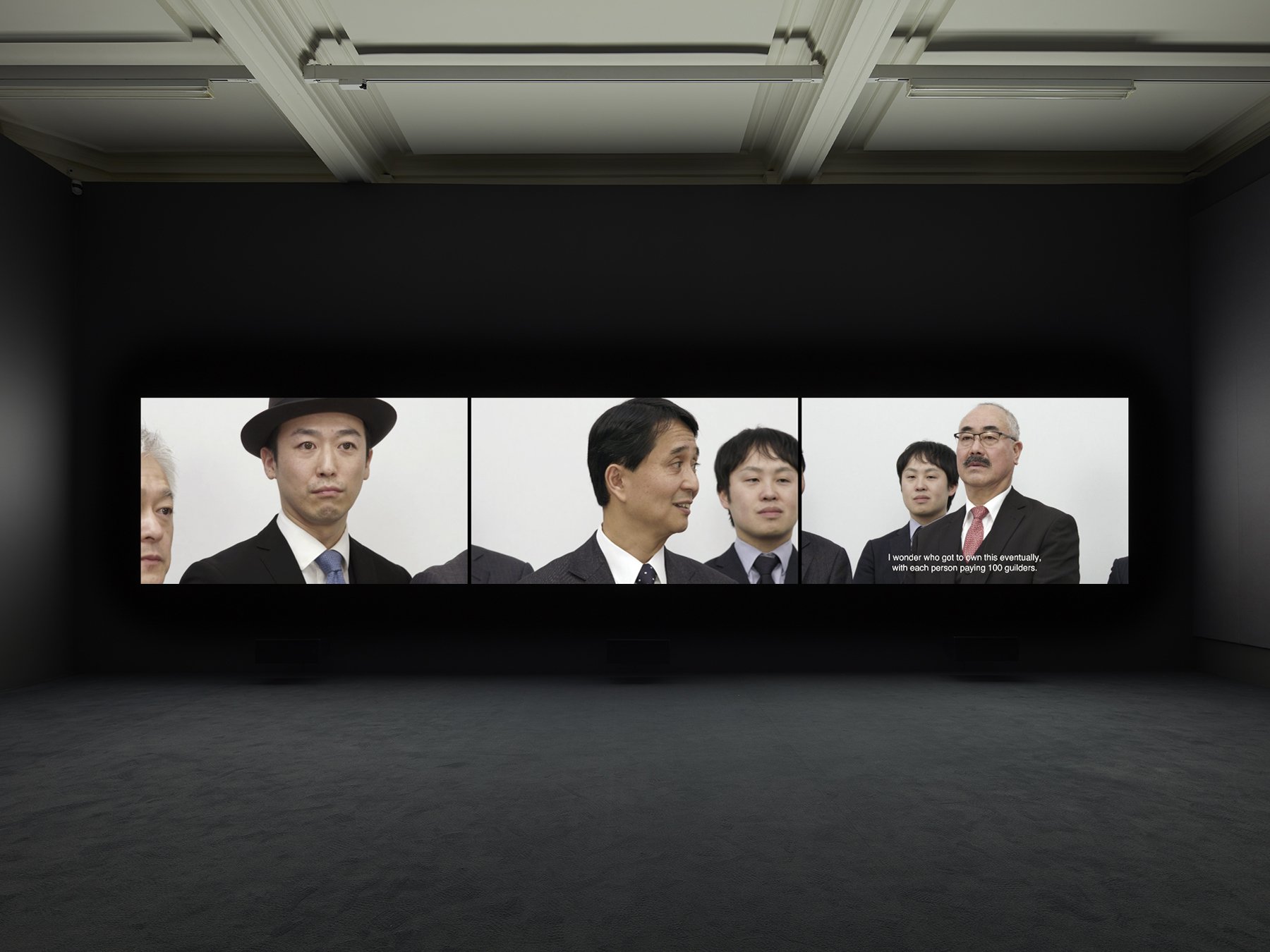
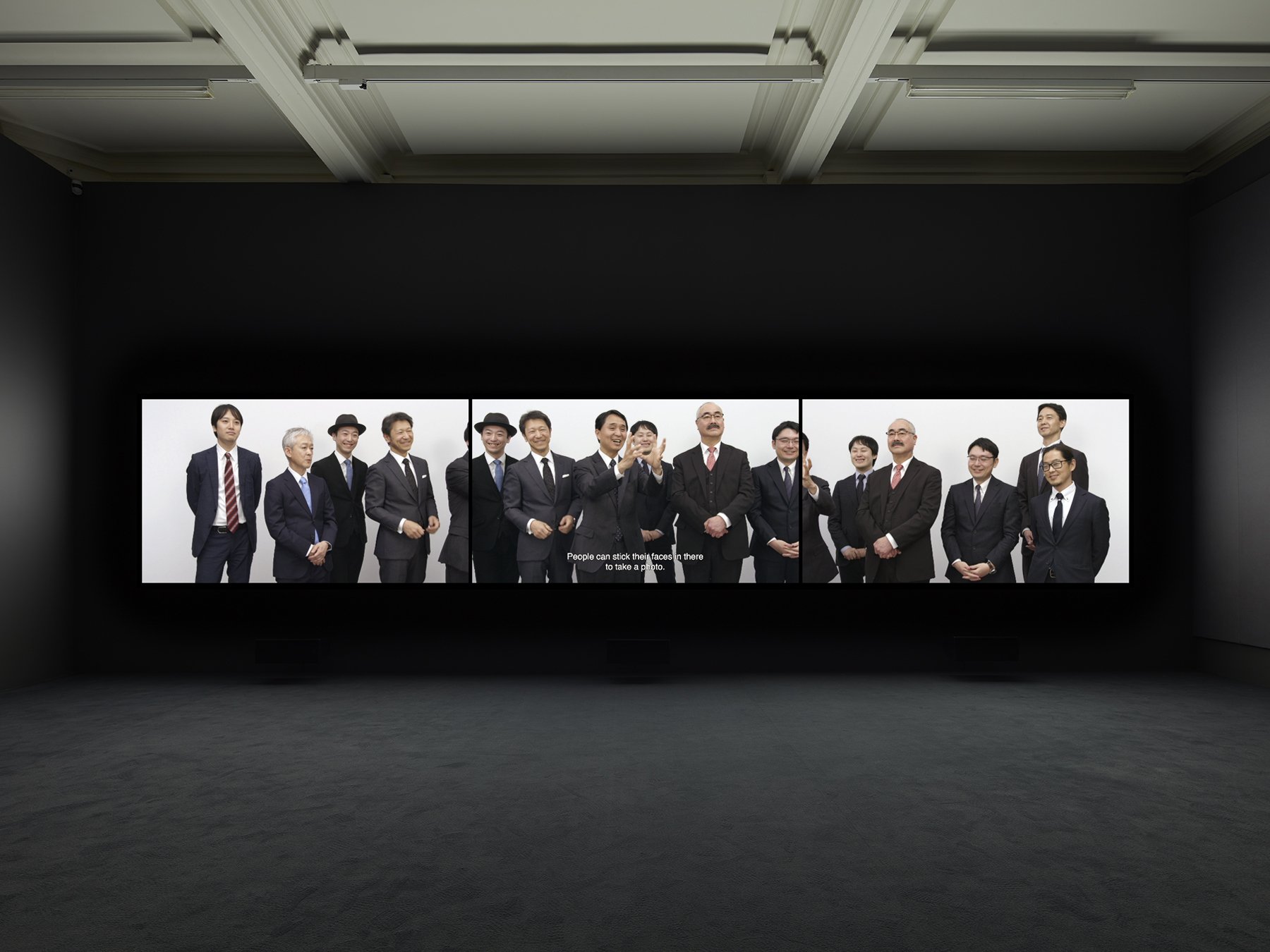
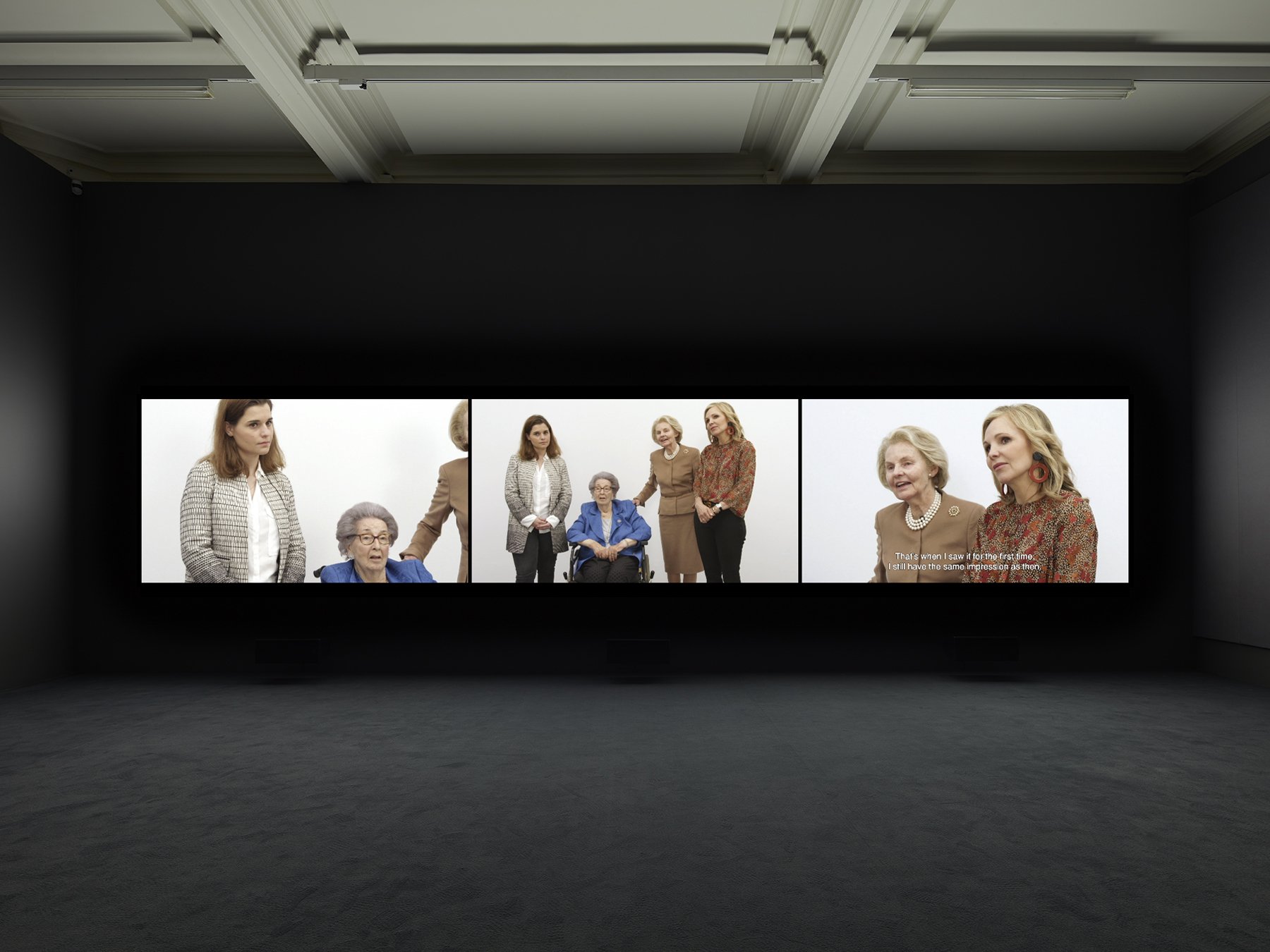
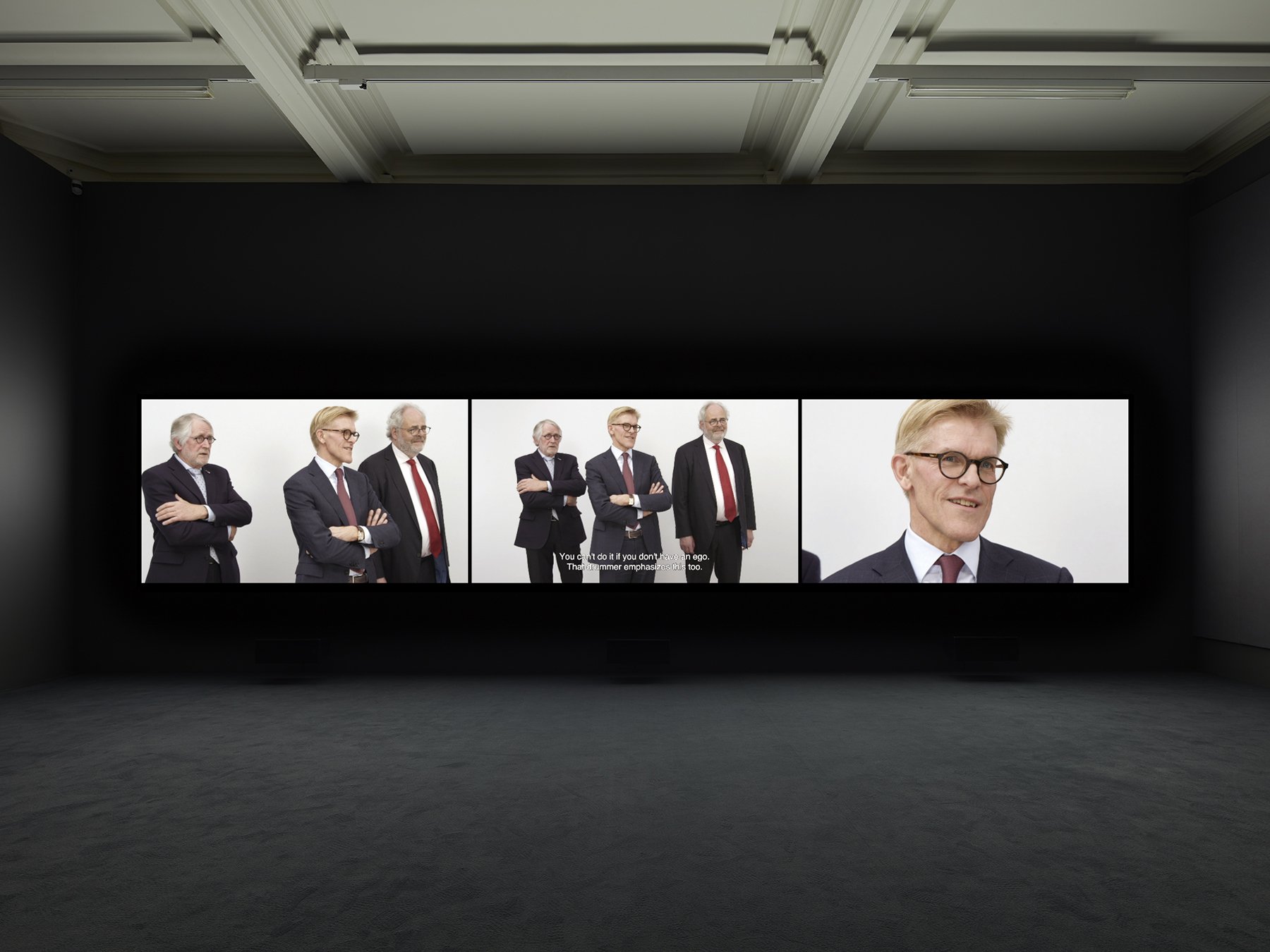
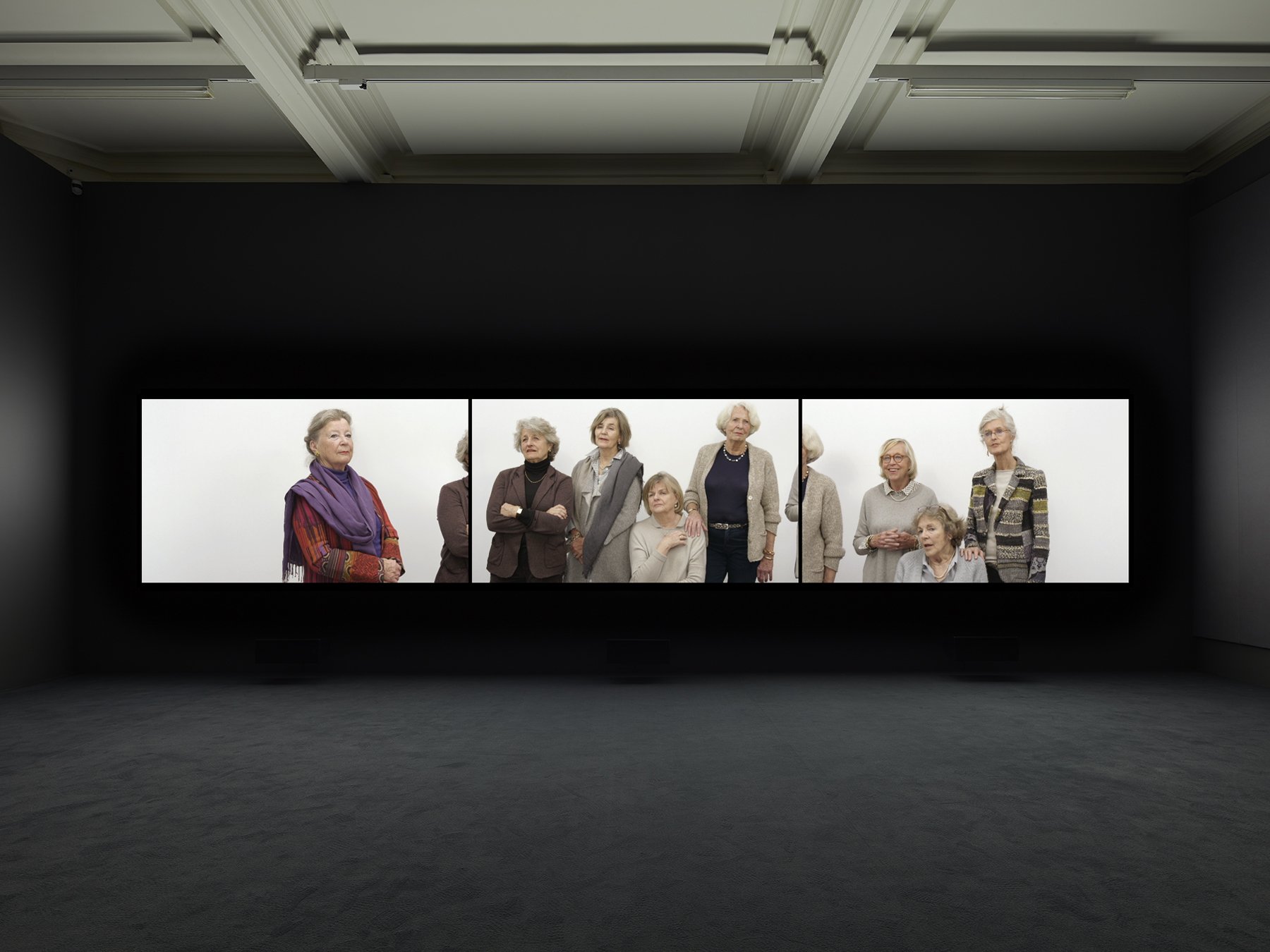
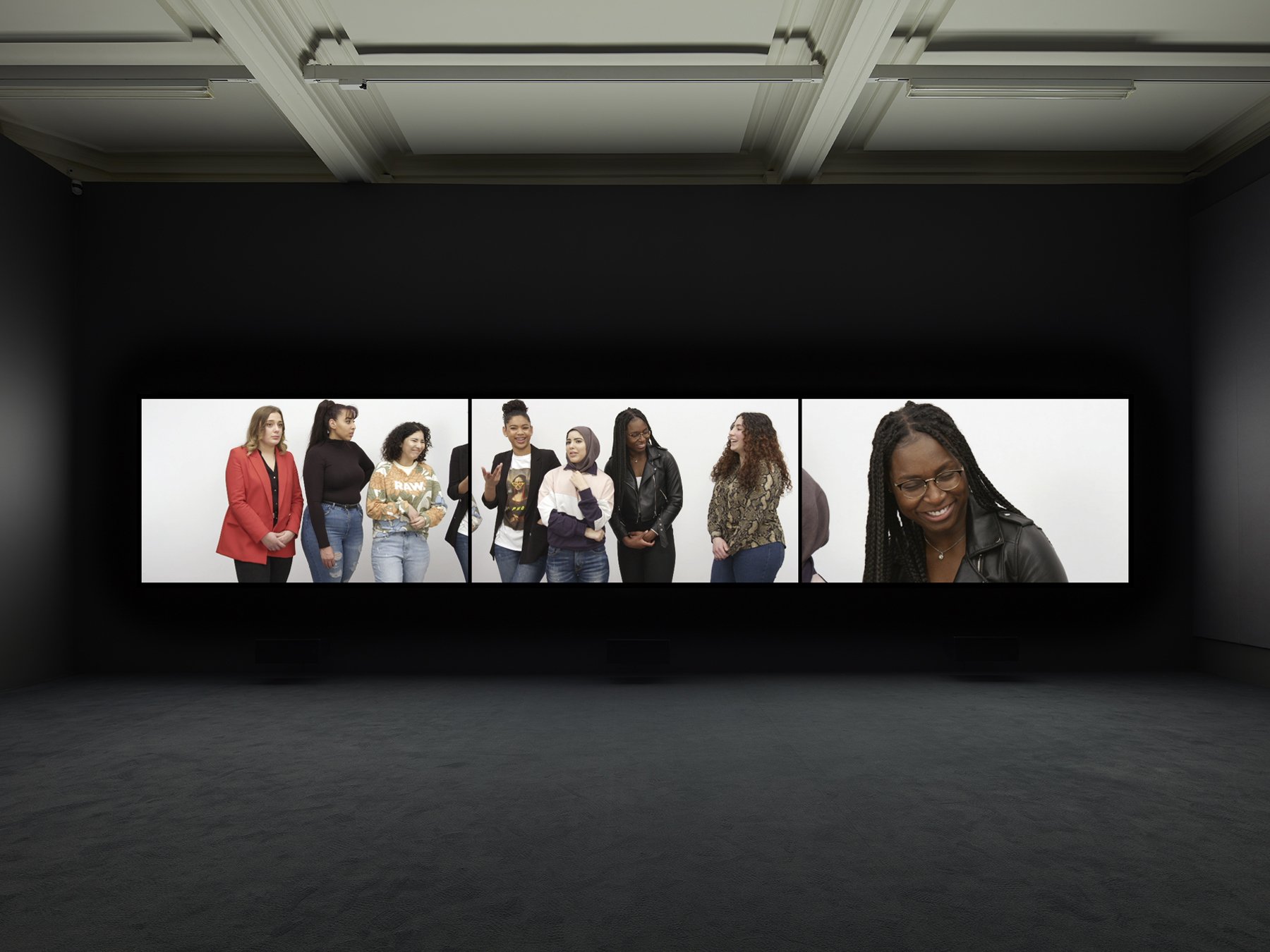
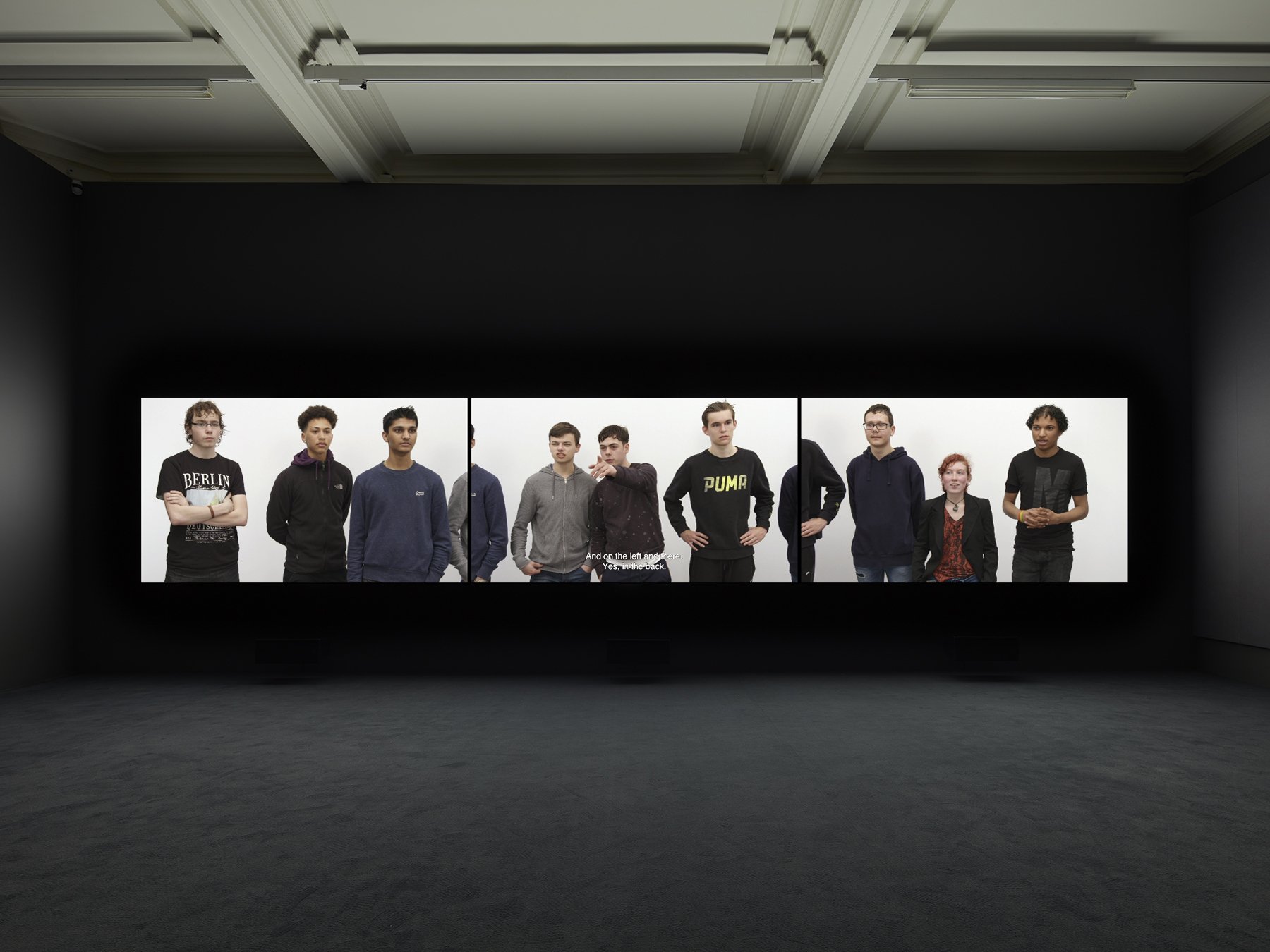
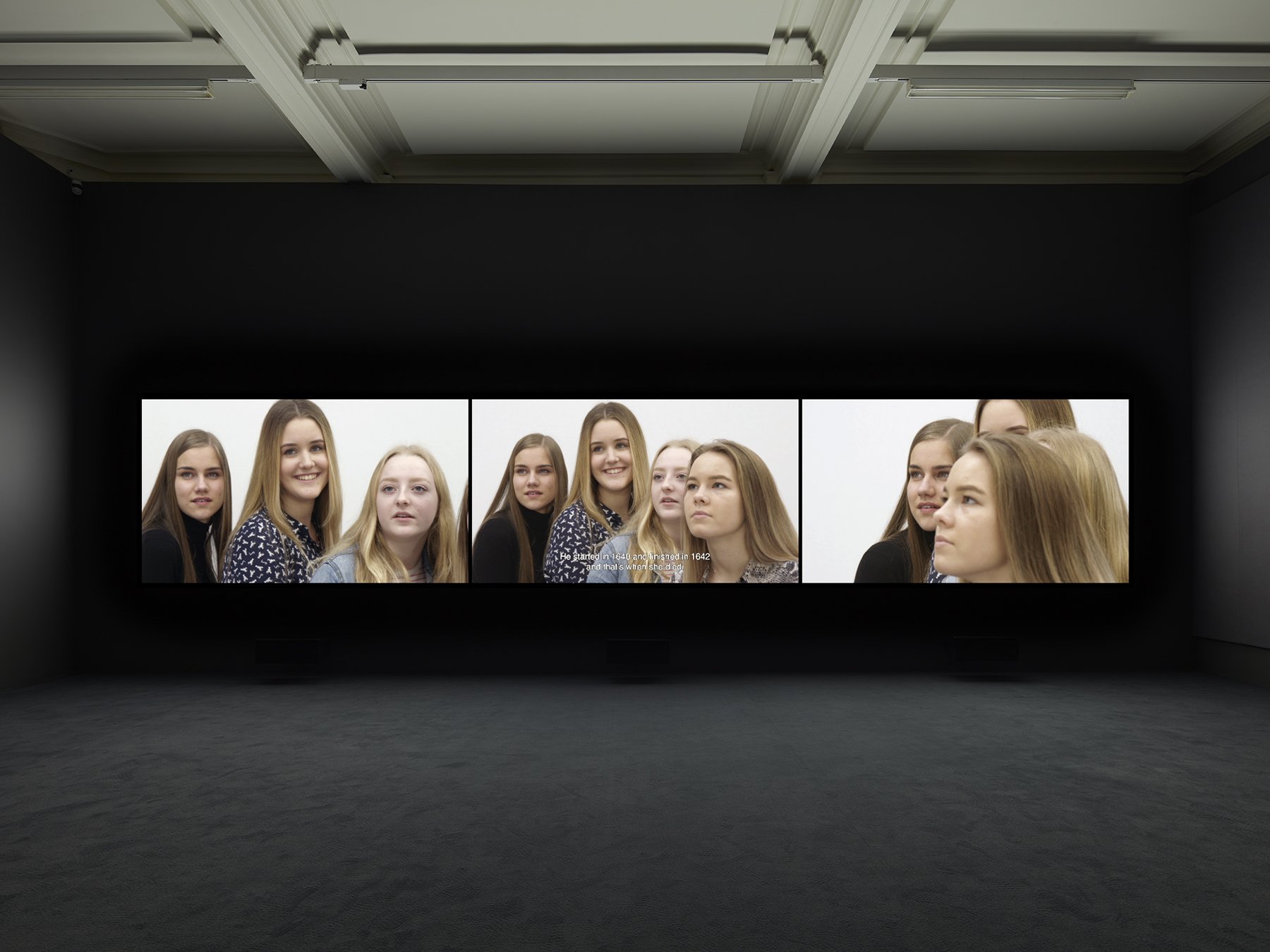
Installation views: “Night Watching and Pictures from the Archive,” Marian Goodman Gallery, New York, 2023 Courtesy of the artist and Marian Goodman Gallery Copyright: Rineke Dijkstra Photo credit: Alex Yudzon
Dijkstra was given unprecedented access to film Night Watching in the Rijksmuseum's Gallery of Honour, after closing time, over the course of six evenings. She filmed directly in front of Rembrandt’s The Night Watch, so that the participants would have a personal and close encounter with the painting. When exhibited at the Rijksmuseum, Night Watching was installed in a room adjacent to The Night Watch, offering visitors an opportunity to revisit the painting. In a broader context, Dijkstra’s Night Watching offers us the occasion to engage in and reflect on the conversational and social nature of people in a discursive relationship to art and history, and to consider the importance of storytelling in the creation of meaning, culture and history. These subjects were similarly explored in Dijkstra’s 2009 video installation I See a Woman Crying which features British schoolchildren looking at and discussing Picasso’s painting The Weeping Woman (1937) at Tate Liverpool.
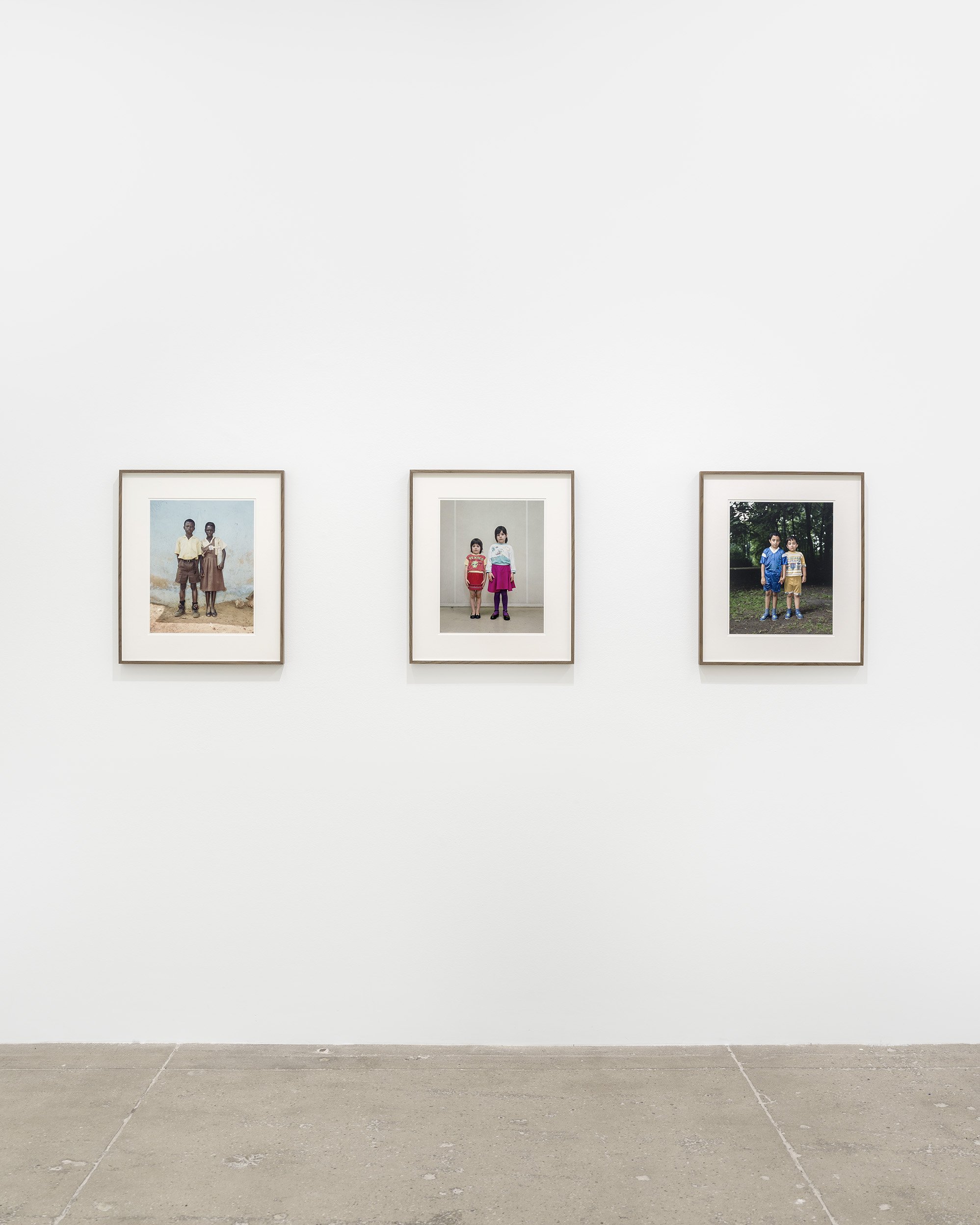

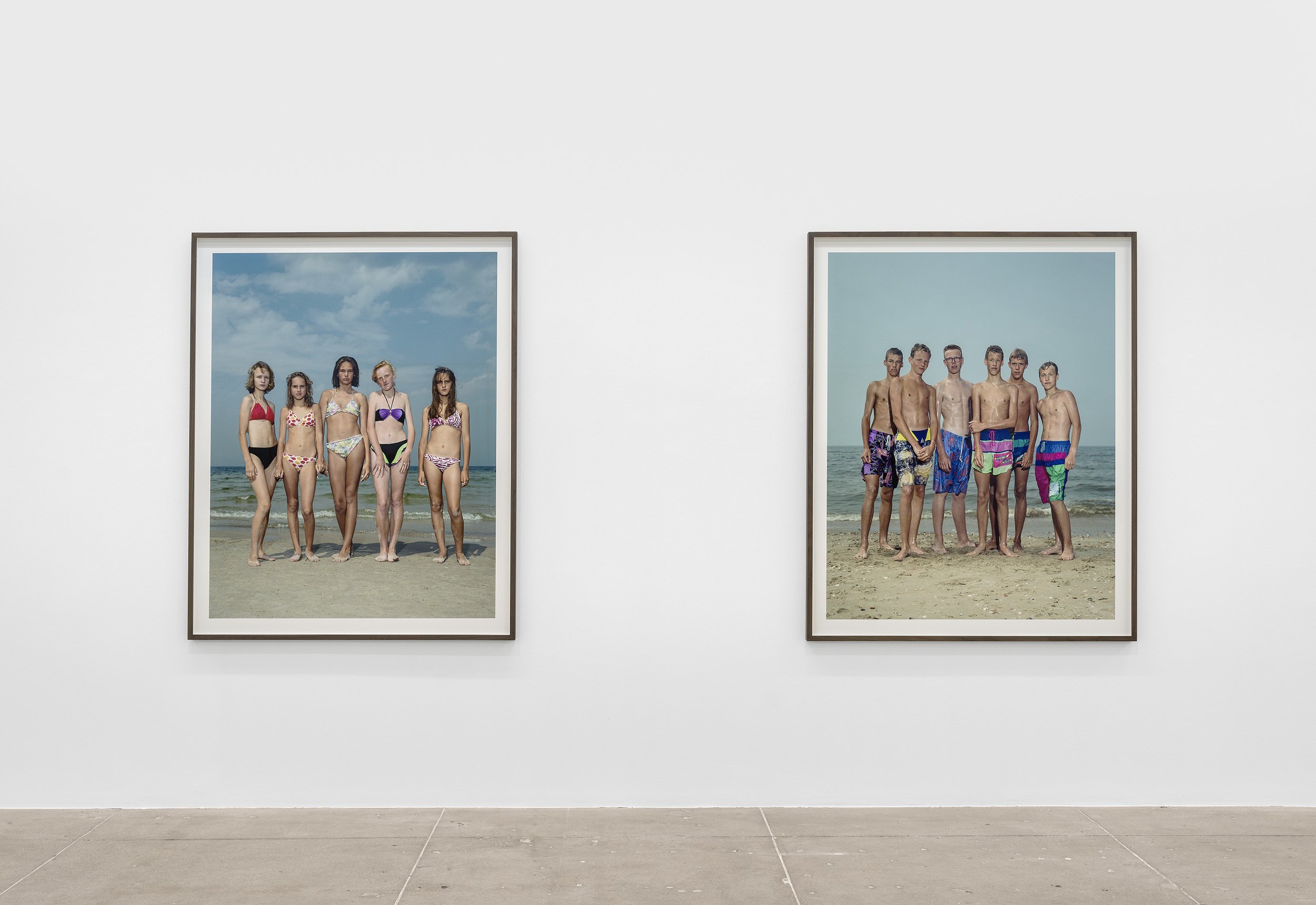
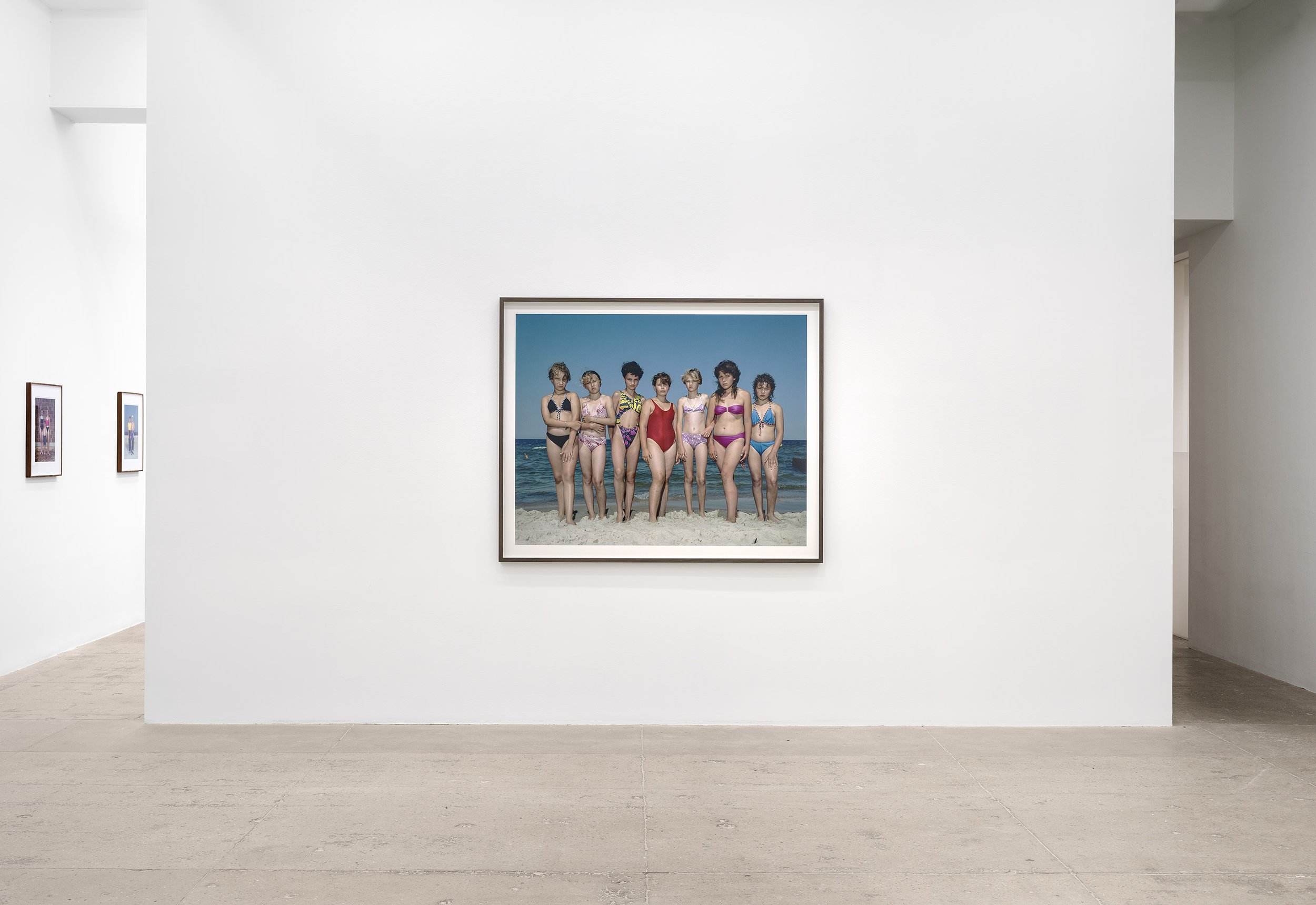
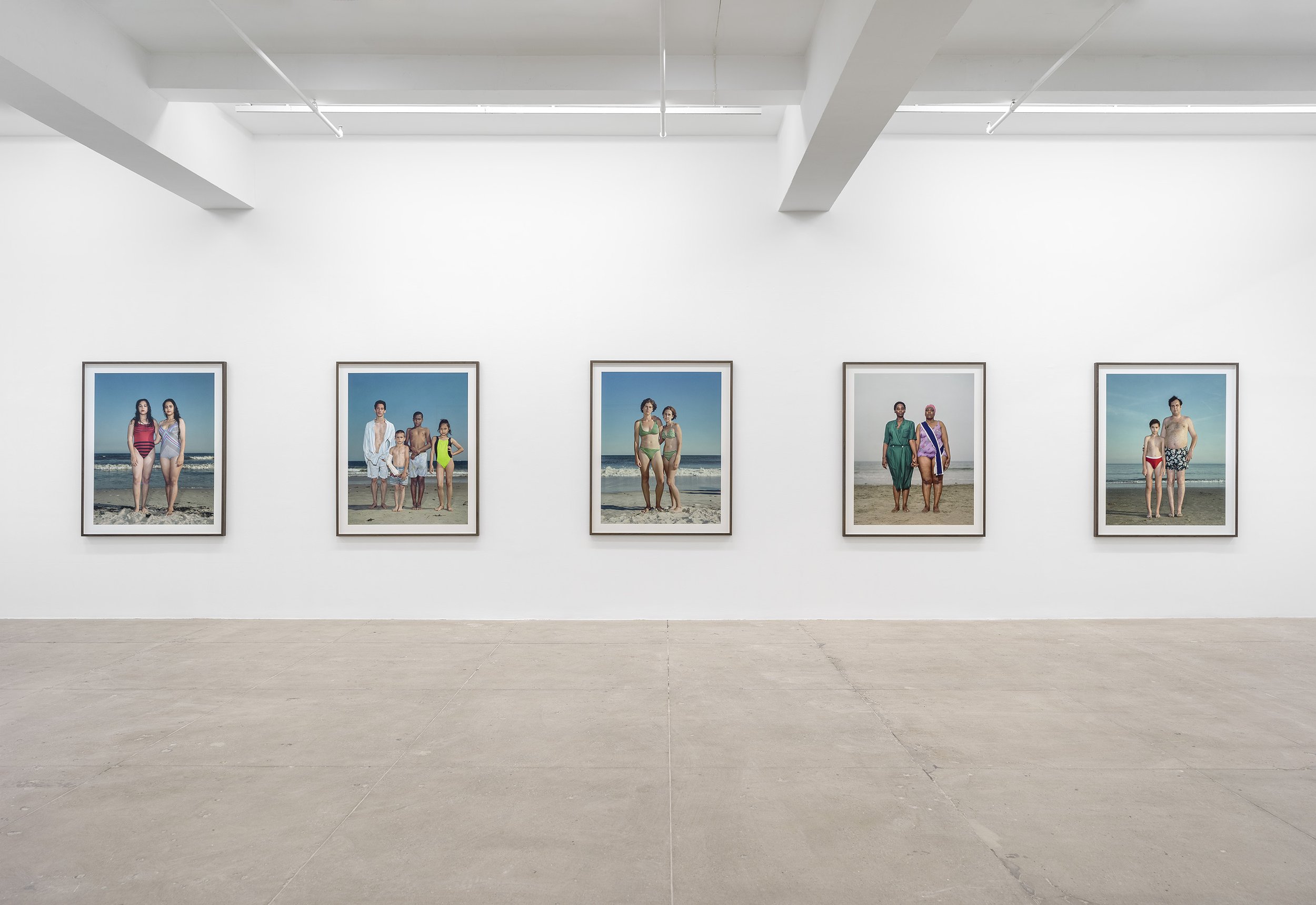
Installation views: “Night Watching and Pictures from the Archive,” Marian Goodman Gallery, New York, 2023 Courtesy of the artist and Marian Goodman Gallery Copyright: Rineke Dijkstra Photo credit: Alex Yudzon
While the Beach Portraits that Dijkstra exhibited earlier in her career often focused on young people as autonomous subjects, the works in this new exhibition focus on connection. The duos and groups in these works have been captured all over the world, from the beaches of Poland, the United States, and the 1 Citing text by Hans den Hartog Jager on the work Night Watching Netherlands, to various locations in Ghana, the UK, and Ukraine. In these pictures Dijkstra raises the question of how the bond between people becomes visible - which can be through a subtle resemblance in appearance, a similarity in bodily attitude towards the camera, the casual holding of two hands, or even through a strikingly large difference between the characters. All photos in this exhibition invite the viewer to consider the ways in which human beings can forge identity and potency through their connection to each other. Precisely because of her exceptional eye for detail and the gestures unique to each individual, and her great sense of human relationships and emotions, these portraits shine a special light on the power of Rineke Dijkstra's unique oeuvre.
Rineke Dijkstra was trained at the Gerrit Rietveld Academie, Amsterdam. Her first solo exhibition took place in 1984 at de Moor in Amsterdam. Dijkstra's photographs have appeared in numerous international exhibitions, including the 1997 and 2001 Venice Biennale, the 1998 Bienal de São Paulo, Turin's Biennale Internationale di Fotografia in 1999 and the 2003 International Center for Photography's Triennial of Photography and Video in New York; Manifesta 10, St. Petersburg (2014); ICA, Boston in 2019; Barbican Art Gallery, London (2020); The Getty Museum, Los Angeles (2022).
Solo exhibitions of her work have been shown at Maison Européenne de la Photographie (MEP), Paris (2023); Timken Museum, San Diego (2022); Lehmbruck Museum in Duisburg (2022); Rijksmuseum, Amsterdam (2019) de Pont, Tilburg, the Netherlands (2018); Sprengel Museum, Hannover (2018), Louisiana Museum of Art, Denmark (2017); Hasselblad Center, Gothenberg (2017); National Gallery of Art, Washington D.C. (2016); San Francisco Museum of Modern Art, San Francisco, and Guggenheim Museum, New York (2012); Tate Liverpool (2010), Fotomuseum Winterthur, Switzerland, Jeu de Paume, Paris and Stedelijk Museum, Amsterdam (2005-6), and the Art Institute of Chicago, Chicago (2001). She is the recipient of a number of awards, including the Spectrum Internationaler Preis für Fotografie der Stiftung Niedersachsen (2018), the Hasselblad Foundation International Award (2017), Citibank Private Bank Photography Prize – now Deutsche Börse Photography Prize – (1998), Werner Mantz Award (1994). Please join us at the opening reception on Tuesday, October 31st, from 6-8 pm.
The exhibit opened on October 31st with a reception and will close on the 20th of December of this year. For more information please visit the Marian Goodman Gallery’s website.
ANTOINE ROEGIERS «La brûlure de l’éveil»
The Masks, 2023 Oil on canvas, 130 × 162 cm
Belgian artist Antoine Roegiers is coming to Galerie Templon this autumn with the solo exhibition La Brûlure de l’Éveil/Burning Awakening. A series of seventeen oils on canvas centre on an exploration of a world in transition where nature reclaims what is hers.
Antoine Roegiers discovered the works of the masters of the Flemish School, from Peter Brueghel to Jérôme Bosch, as a student at the Paris École des Beaux-Arts. Fascinated by their highly distinctive vision of narrative, perspective, viewpoint, staging and time, Antoine Roegiers conjures up different universes, poetic, dreamlike, sometimes even humorous, resulting in tableaux that resemble the animation films he has become skilled in making.
Since 2018, Antoine Roegiers has been reflecting and working on a “visual narrative” project: a series of paintings which together tell a single story over several years. Humour, solemnity and poetry rub shoulders, offering us food for thought about today’s world as well as the chance to laugh at ourselves.
La Brûlure de l’Éveil plunges the visitor headfirst into an almost apocalyptic world. Gigantic flames, reflecting the climate emergency, set the sky ablaze above desolate landscapes criss-crossed by skeletons on their cart, tirelessly gathering the masks abandoned by reckless humans. They fight over this precious booty with a pack of determined dogs and some mischievous crows.
Antoine Roegiers subverts the codes of the traditional hunting scene: here the object of the hunt is artifice. It symbolises the world of appearances that humans have built. The masks have fallen. Thoughtlessness is a thing of the past. We can no longer close our eyes to the consequences of our actions. Tomorrow’s problems are here.
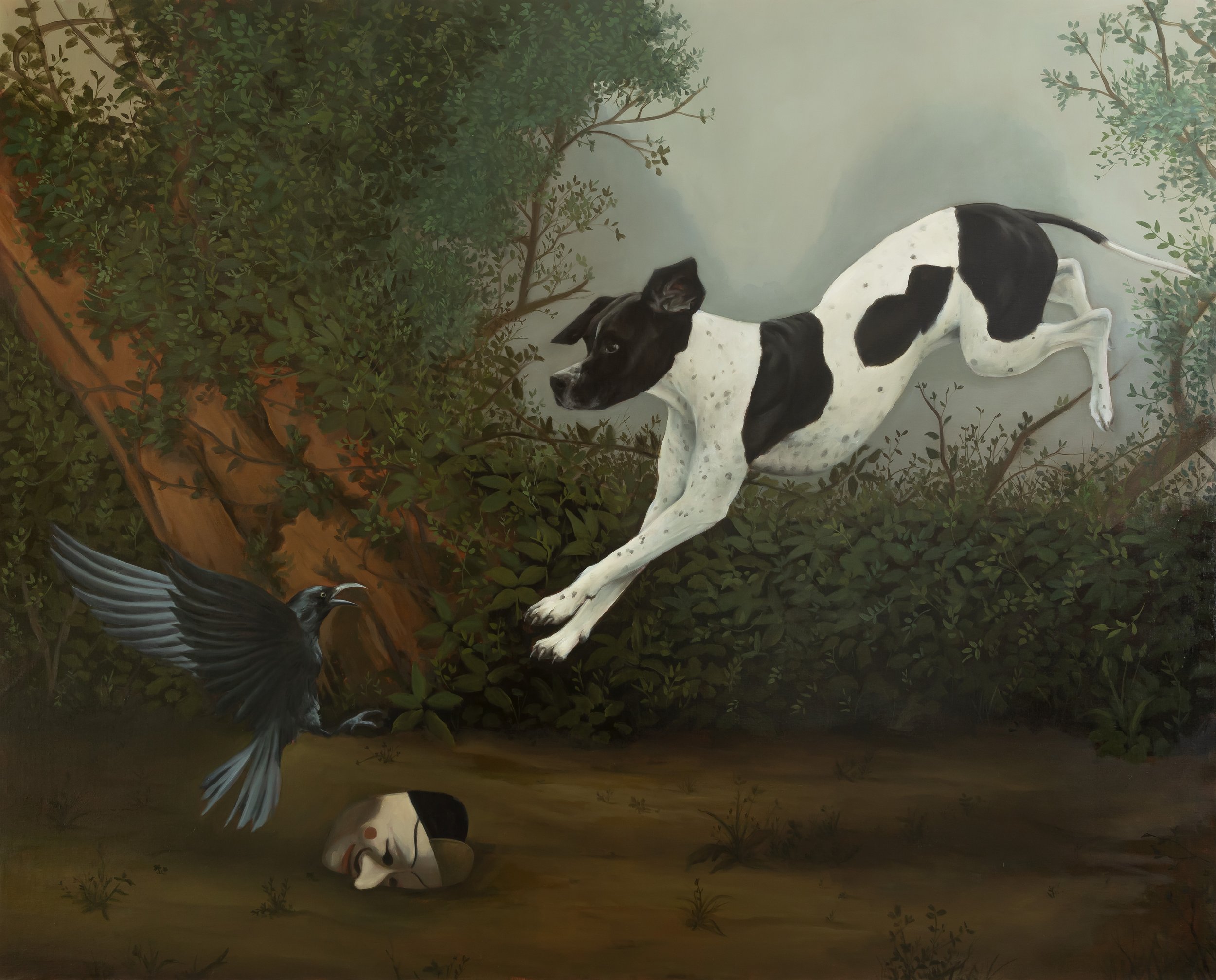


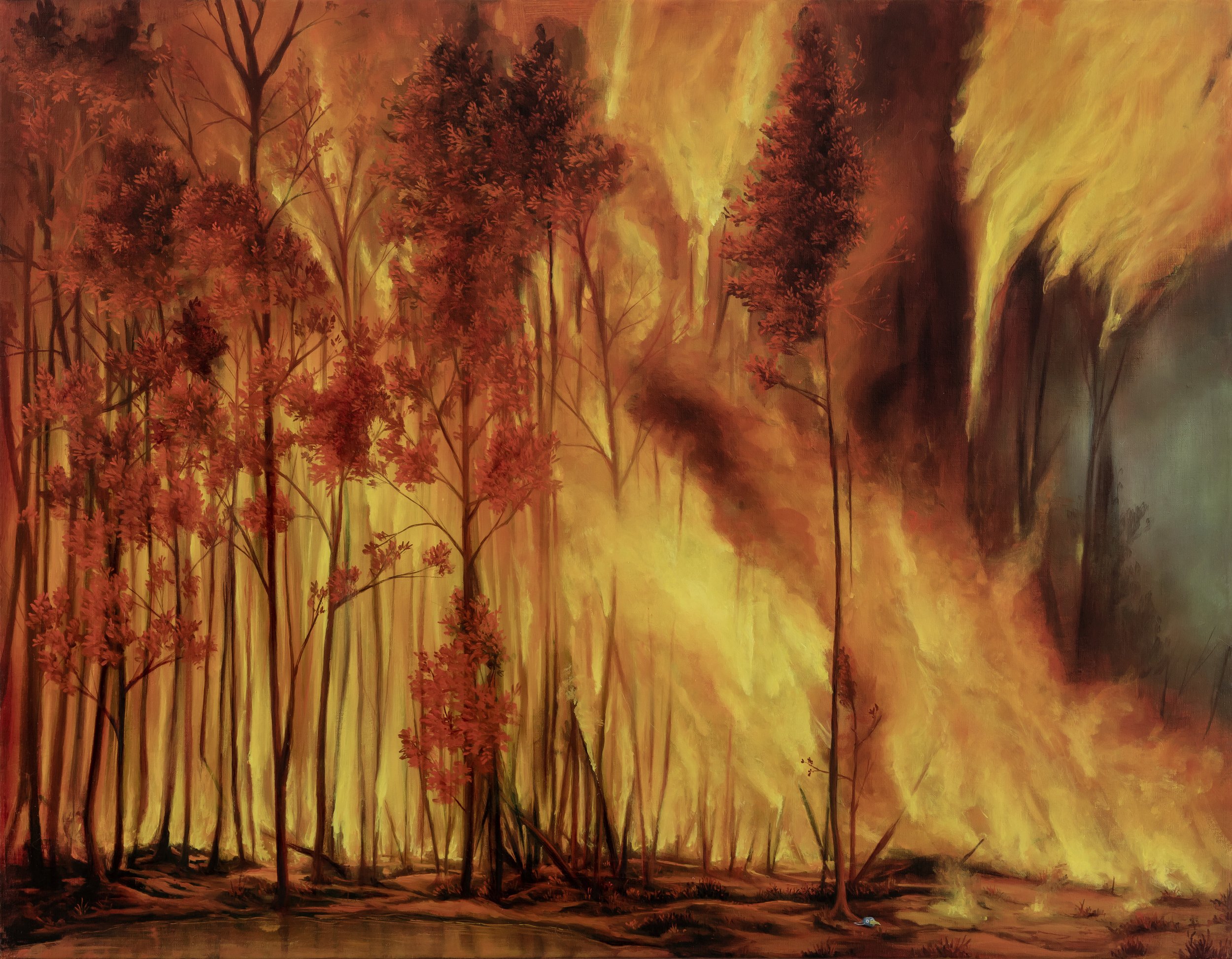
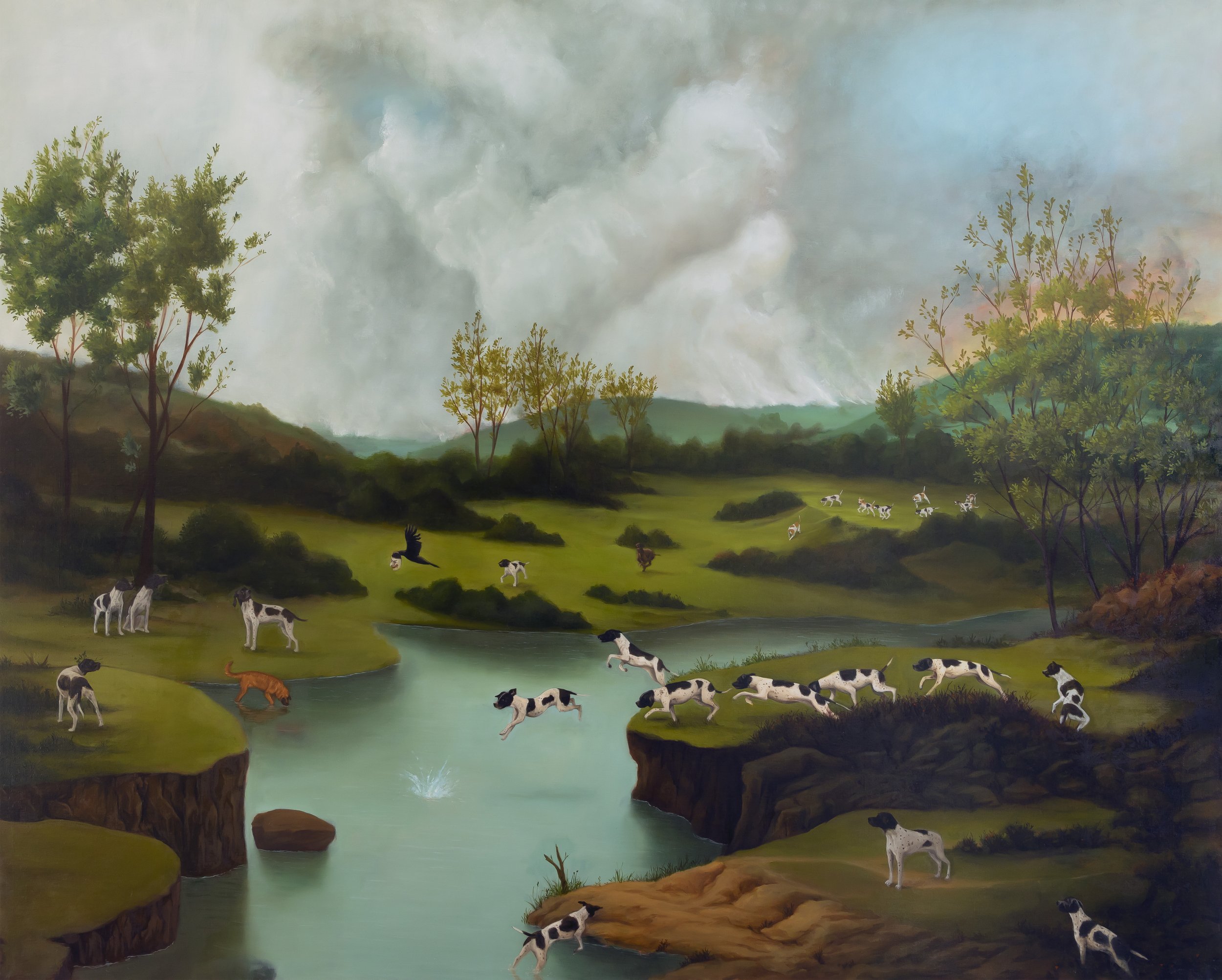

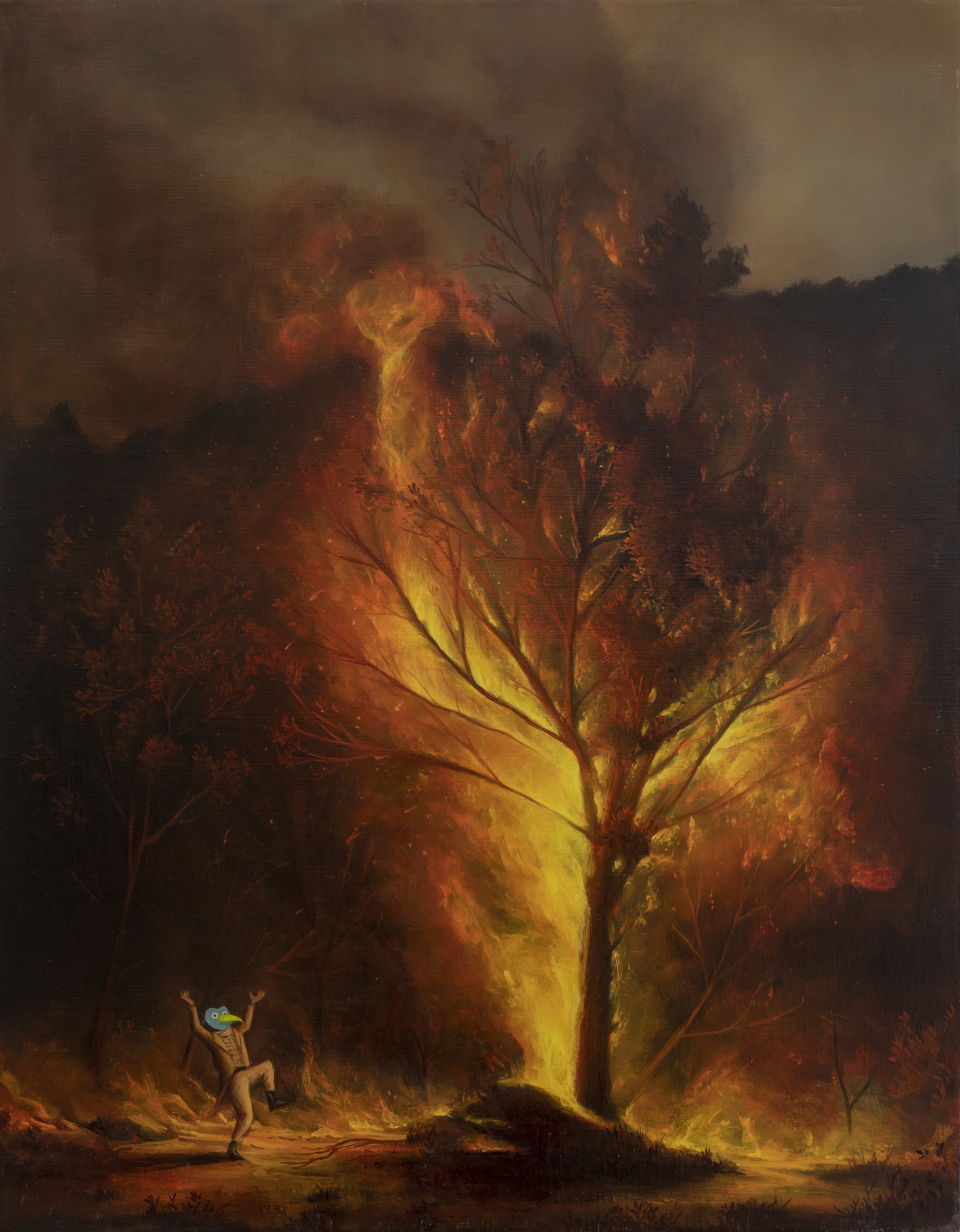

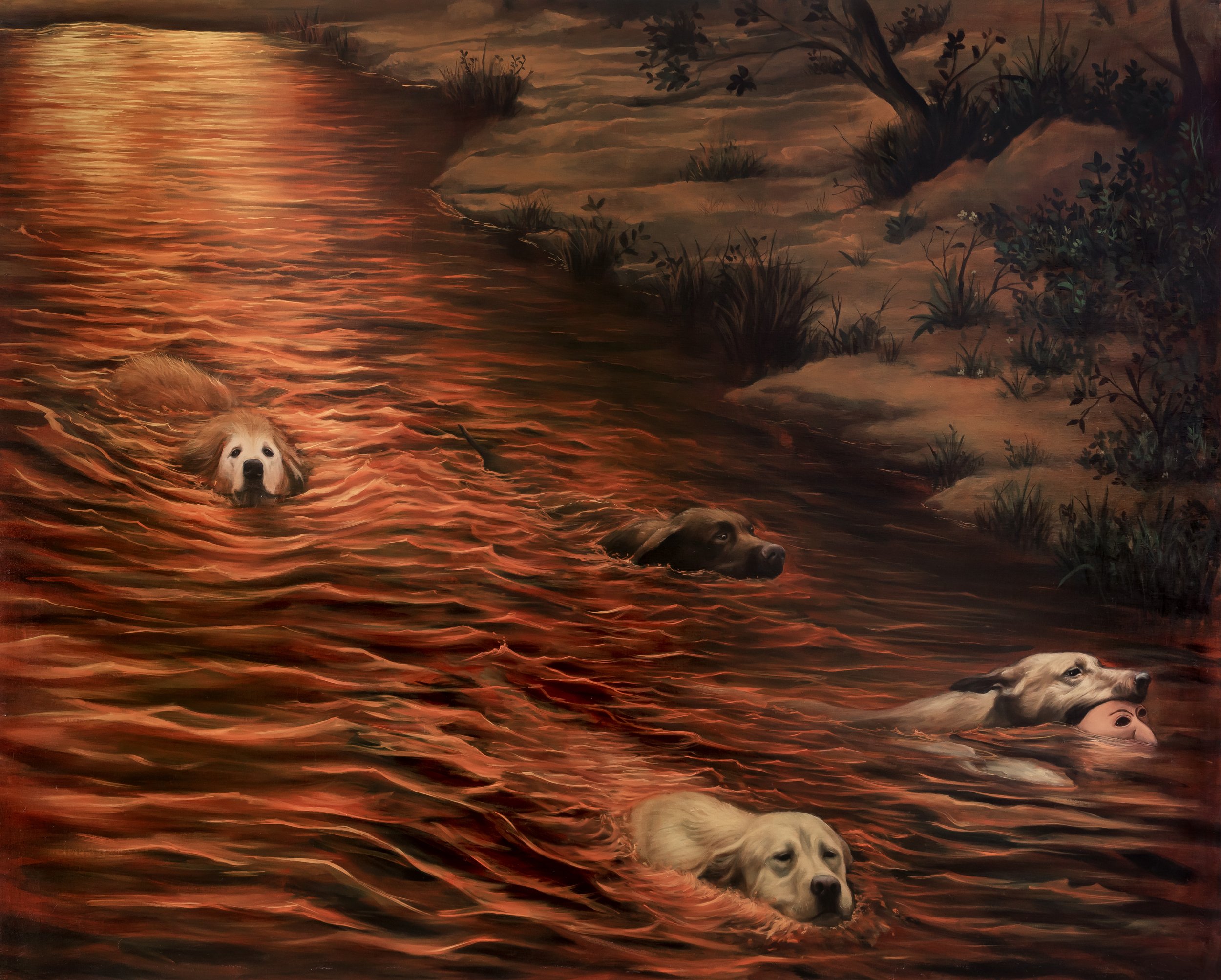

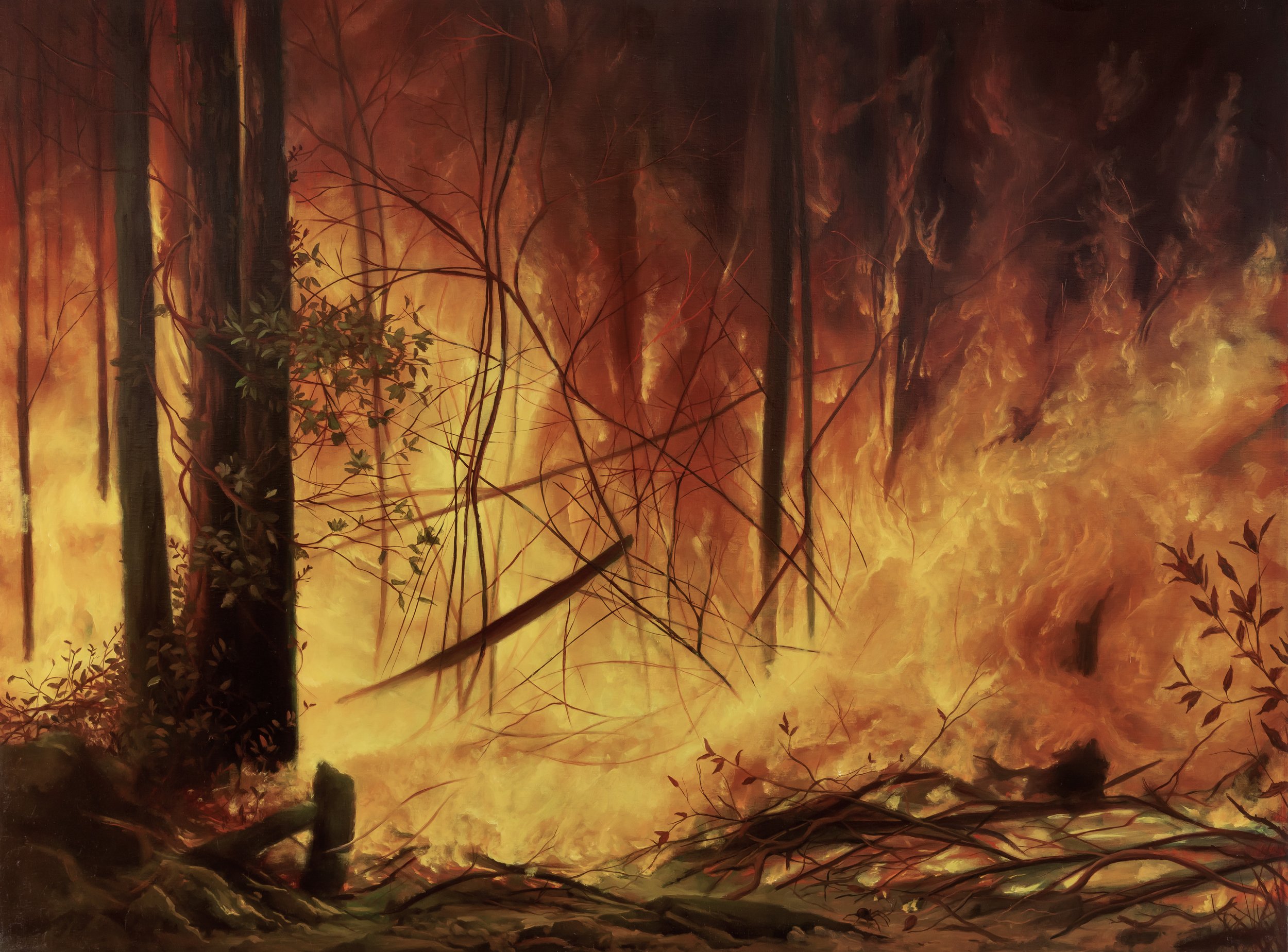


Toutes les images / All images : Courtesy the artist and TEMPLON, Paris—Brussels— New York
“My canvases are a space open to the imagination and to interpretation of all possibilities. I want to explore a world that doesn’t exist and bring it to life with my brush and my pigments dipped in oil, to make it plausible with dreamscapes that form a visual narrative. It’s an ongoing dream, the paintings are interlinked and follow on from each other to form a coherent whole, as I see it: an open narrative thread, chronologically changeable and endless.”
Born in 1980 in Belgium, Antoine Roegiers lives and works in Paris. He fuses his knowledge of classic painting with contemporary animation techniques. Putting technology and his talent for drawing to good use, he breathes life into fantastical characters typical of the Flemish masters, taking liberties with them and inventing stories that never stay still.
His work has been shown in a range of solo exhibitions, including at the Noordbrabant Museum in Hertogenbosch, Netherlands, Palais des Beaux-Arts in Lille, France, in 2012 and Botanique in Brussels in 2013. His art has also featured in numerous group exhibitions, including at the Frissiras Museum in Athens (2003), Fondation d’Entreprise Ricard in Paris (2009), Kulturhuset Museum in Stockholm (2012), Petit Palais in Paris (2013), Palais Pisztory in Slovakia (2013), Paço das Artes in Sao Paulo (2013), Albertina Museum in Vienna (2013), Fonds d’art contemporain de la ville et du canton de Genève (2013), Bruce Museum in Greenwich, USA (2015), Palacio Bellas Artes and Museo Nacional de Antropologia in Mexico City (2018), Palais des Beaux-Arts in Brussels (2019), Cité de la musique Philharmonie in Paris (2021) and MO.CO in Montpellier (2023). It is also included in the Fonds d’Art Contemporain de la Ville de Genève and Collections du Ministère de la Communauté Française de Belgique. Antoine Roegiers has won several prizes, including the Molière de la Création Visuelle (2020) and Prize Foundation Roger Bataille (2007).
The exhibition will open on November 9th and will close on December 23rd of this year. For more information about the exhibition, please visit the Templon website.
Steve McQueen’s Sunshine State
Sunshine State, 2022 HD video, front and back continuous projection; 30 min. 1 sec. Installation, Marian Goodman Gallery, Los Angeles, 2023 Courtesy of the artist and Marian Goodman Gallery © Steve McQueen Photo credit: Fredrik Nilsen Studio
Marian Goodman Gallery has inaugurated its Los Angeles gallery with a solo exhibition dedicated to artist and filmmaker Steve McQueen. The exhibition features recent works, including the U.S. premiere of the immersive video installation Sunshine State (2022). As Cora Gilroy-Ware has written in her extensive essay, “In the Dead of the Light: Steve McQueen’s ‘Sunshine State’,” in the 2022 exhibition catalogue for Pirelli HangarBicocca:
“Sunshine State is a work of oral history, an autobiographical revelation ... that explores race, identity, racial categorization and stereotypes. McQueen’s story of his West Indian father as an agricultural laborer in Florida is layered over scenes from the 1927 film, The Jazz Singer. If a father’s memory of the 1950s, relayed by his son in the twenty first century, was already an unexpected voiceover for the comparatively archaic film footage on screen, the moment of collision between these two ... adds an extra degree of dissonance. His use of negative footage in Sunshine State works to expose the artificiality of the categories ‘black’ and ‘white’ when applied to human forms.
Sunshine State, 2022 HD video, front and back continuous projection; 30 min. 1 sec. Installation, Marian Goodman Gallery, Los Angeles, 2023 Courtesy of the artist and Marian Goodman Gallery © Steve McQueen Photo credit: Fredrik Nilsen Studio
The voiceover in Sunshine State reveals that trauma can be a force that binds, a cord tying one generation to the next with an ineffable tightness. By the end, McQueen and the 1927 film character appear to have something vital in common; their reverse responses to their fathers’ pain and the trappings of their identities turn them into negative and positive images of one another.
Throughout the film, the sun serves as the connective tissue between the past and the present, and serves as a symbol of the changing landscapes of history and identity that McQueen explores in his work.”
Sunshine State was originally commissioned for the International Film Festival Rotterdam 2022 and made possible with the support of the Municipality of Rotterdam, Stichting Droom en Daad, Rotterdam Festivals, and Nederlands Filmfonds. Film footage courtesy of Warner Bros.
Moonlit, 2016 2 marble rocks and silver leaf 15 3/4 x 35 3/4 x 23 5/8 in. (40 x 90.8 x 60 cm) 17 3/4 x 35 3/4 x 31 1/2 in. (45.1 x 90.8 x 80 cm) Installation, Marian Goodman Gallery, Los Angeles, 2023 Courtesy of the artist and Marian Goodman Gallery © Steve McQueen Photo credit: Fredrik Nilsen Studio
About Steve McQueen
Steve McQueen (1969 - ) is an artist and filmmaker whose work explores universal themes, often addressing painful and challenging histories. Recognized internationally as one of the most important artists of his generation, Steve McQueen exposes the fragility of the human condition in his practice. Awarded the Turner Prize in 1999, McQueen has had his artwork presented at some of the most significant venues and museums around the world. His work has been featured in Documenta (1997 and 2002). He represented Great Britain at the 53rd Venice Biennale in 2009, and was selected several times for the Venice Biennale (2003, 2007, 2013, and 2015). Solo exhibitions of his work have been held at the Art Institute of Chicago (2012);
Schaulager, Basel (2013); Whitworth Art Gallery, Manchester (2017); The Museum of Modern Art, New York (2017); Institute of Contemporary Art, Boston (2017). In 2019 he presented YEAR 3 at Tate Britain and had a major solo exhibition at Tate Modern in 2020, which toured to Pirelli HangarBicocca, Milan, in 2022. In April/May 2023, he presented Grenfell at the Serpentine South Gallery, London, and in May 2024, McQueen will create an immersive installation exploring light and sound at Dia Beacon, accompanied by a presentation of Sunshine State at Dia Chelsea in September 2024. The new commission will subsequently travel to Schaulager, Basel Münchenstein, in June 2025.
McQueen has directed four feature films. His first, Hunger (2008), was awarded the Caméra d’Or at the Cannes Film Festival, and his third, 12 Years a Slave (2013), received the Golden Globe, Oscar, and BAFTA awards for best picture in 2014. In 2020, he made Small Axe, an anthology of five films about London’s West Indian community and, in 2021, Uprising, a 3- part documentary with James Rogan about the New Cross Fire in London in 1981. His most recent film, Occupied City, a portrait of Nazi and modern-day Amsterdam, debuted at Cannes in May 2023 and will be shown at the upcoming New York Film Festival. McQueen is currently in post-production on Blitz, a new feature about the Second World War.
McQueen was named an Officer of the Order of the British Empire (OBE) in 2002 and a Commander of the Order of the British Empire (CBE) in 2011. He was knighted in the 2020 New Year Honors list. McQueen was born in West London and is based in London and Amsterdam.
Sunshine State, 2022 HD video, front and back continuous projection; 30 min. 1 sec. Installation, Marian Goodman Gallery, Los Angeles, 2023 Courtesy of the artist and Marian Goodman Gallery © Steve McQueen Photo credit: Fredrik Nilsen Studio
About Marian Goodman Gallery Los Angeles
Located in Hollywood near the Highland Corridor, at North Hudson Avenue off Santa Monica Boulevard, Marian Goodman Gallery Los Angeles comprises a 13,000-square-foot facility, featuring 5,000 square feet of flexible, skylit galleries as well as a landscaped garden, viewing rooms, office space, and dedicated parking. The Gallery was designed by the L.A.- based architectural firm Johnston Marklee, acclaimed internationally for their cultural buildings and adaptive reuse projects.
The exhibit opened on September 23rd with an opening reception and will close on the 4th of November.
For more information about the exhibit, please visit the Marian Goodman Gallery’s site. The gallery can be found on Instagram and Artsy, too.
Andy Warhol Three Times Out
Andy Warhol, Self-Portrait, 1966. Silkscreened synthetic polymer paint and enamel, pencil and ballpoint pen on six canvas panels. Framed, each: 58.4 x 58.4 x 3.2 cm. Accession Number: B-WARH-2P98.16. 1-.6. The Eli and Edythe L. Broad Collection. ©The Andy Warhol Foundation for the Visual Arts, Inc. / ARS New York / IVARO Dublin, 2023
Hugh Lane Gallery and Dublin City Council announce Ireland's largest ever Andy Warhol exhibition - the first to open in 25 years.
Andy Warhol Three Times Out will run until January 28th, 2024 and will feature more than 250 works including the iconic Campbell's Soup Cans and Marilyn Monroe.
Dublin, IRELAND: A unique exhibition of Andy Warhol’s paintings, prints, photographs, films, and installations will open at Hugh Lane Gallery in October, showcasing the artist’s extraordinary range of artworks produced over four decades.
Andy Warhol Three Times Out has been five years in the making and includes more than 250 works on loan from museums and private collections in the US, Canada, Europe, and the Warhol Museum in Pittsburgh. The exhibition is curated by Barbara Dawson, Director of Hugh Lane Gallery and Michael Dempsey, Head of Exhibitions, and it is the most exciting show in the arts calendar this year.
Andy Warhol is, without a doubt, one of the most important and recognizable artists of the 20th century. He devised new ways of image making, experimenting with multiple images silkscreened on canvas, printing, photography, film, publishing, advertising, performance, video and television. Combining these mediums, Warhol challenged conventional canons in art, dismissing traditional distinctions between fine art and popular culture.
Andy Warhol, Campbell's Soup I: Tomato (II.46), AP edition E/Z, 1968, screenprint, 35 x 23 in. Collection of the Jordan Schnitzer Family Foundation. Image: Strode Photographic. © The Andy Warhol Foundation for the Visual Arts, Inc. / ARS New York / IVARO Dublin, 2023
A broad range of Warhol’s work has been selected for the exhibition in Dublin, from the iconic Campbell's Soup Cans, Flowers, Marilyn Monroe, Elizabeth Taylor, Jackie Kennedy and Chairman Mao, to his observations on identity and mortality in his multiple self-portraits, skulls, electric chairs and avant garde films Empire, Sleep, Kiss and Outer and Inner Space. In addition, visitors to the exhibition will experience Warhol's immersive Silver Clouds sculpture.
Unique to the exhibition will be a section focusing on the work and collaborations both Andy Warhol and Francis Bacon had with acclaimed US artist and photographer Peter Beard, provoking new thinking on the status of these two titans of the 20th century.
According to the Lord Mayor of Dublin, Daithí de Róiste:
"As the newly elected Lord Mayor of Dublin, I am delighted to announce details of Andy Warhol Three Times Out. This will no doubt be one of the best exhibitions of the year, one that residents of the city should now mark in their diaries.
“Dublin City Council and the team at Hugh Lane Gallery deserve great praise for the achievement of producing such a prestigious exhibition for our city. Today's news will generate excitement not just amongst Irish audiences but will attract international visitors to Dublin to see a Warhol exhibition on this scale".
Andy Warhol, Mao, 1972. Acrylic, oil and silkscreen on canvas, 208 × 163 cm. Suñol Soler Collection, Barcelona. ©The Andy Warhol Foundation for the Visual Arts, Inc. / ARS New York / IVARO Dublin, 2023
According to Barbara Dawson, Director of Hugh Lane Gallery:
"Hugh Lane Gallery is delighted to present Andy Warhol Three Times Out. This exhibition shows how Warhol utterly changed the way the world experiences art. His work explored the relationship between artistic expression and the flourishing consumer culture of the 1960s, new technology and celebrity status, as well as mortality, in a diverse body of works that underpins his artistic genius.
“As society navigates the age of social media and surveillance capitalism – how our data is being captured and monetized- it is impossible to overlook Warhol’s prescient vision so relevant to us today."
Installation view Hugh Lane Gallery. Photography by Denis Mortell 2023.
About Andy Warhol (1928-1986)
Andy Warhol was born in Pittsburgh in 1928 to immigrant parents from Slovakia. He moved to New York in 1949, where he became one of America’s leading commercial artists. By the early 1960s he had moved into the field of fine art and was exhibiting his Pop Art paintings in New York and Los Angeles. He set up the legendary Silver Factory in the 1960s – a melting pot of creativity - and from here he promoted the rock band, The Velvet Underground. Visitors included the likes of Lou Reed, Bob Dylan, Truman Capote, Marcel Duchamp, Salvador Dali, Edie Sedgwick, Brigid Berlin, and Jane Holzer.
Despite a near fatal shooting in 1968, Warhol continued to be enormously prolific. During the 1970s and ‘80s. Over the course of a 40-year-long career, Andy Warhol transformed contemporary art. The power of his work comes from its concentration on fundamental human themes – the beauty and glamour of youth, fame, material culture, the passing of time, and the ever presence of death.
Andy Warhol, Flowers, 1964. Silkscreen on canvas, 60 × 60 cm. AW-0004 F(a). The Sonnabend Homem Collection. ©The Andy Warhol Foundation for the Visual Arts, Inc. / ARS New York / IVARO Dublin, 2023
About Hugh Lane Gallery
Hugh Lane Gallery is one of Ireland’s leading museums of modern art located on Parnell Street in Dublin’s city centre. First opened in 1908 by Sir Hugh Lane as the Municipal Gallery of Modern Art, the gallery houses one of Ireland’s most exciting collections of modern and contemporary Irish and international art.
The gallery is also home to Harry Clarke’s celebrated stained-glass masterpieces, The Eve of Saint Agnes and Mr. Gilhooley, a panel from the Geneva Window originally commissioned by the Government of Ireland for the League of Nations building in Geneva.
In 1998, Francis Bacon’s famous studio was donated to Hugh Lane Gallery by the artist’s heir, John Edwards, and Brian Clarke, executor of Bacon’s Estate. Hugh Lane Gallery relocated the studio piece by piece from 7 Reece Mews, London to the gallery where it is now permanently on display, preserved exactly as it was.
The establishment of the gallery was one of the most important events in the birth of Modern Ireland and the gallery proudly displays famous Irish personalities in portraiture including W.B Yeats, and Augusta, Lady Gregory, who, with W.B. Yeats, was a founder of the Abbey Theatre, John Millington Synge and AE. Political figures in portraiture include Michael Collins, Eamon De Valera, Edward Carson, and John Redmond
Sir Hugh Lane (1875-1915) was a celebrated art dealer, collector, exhibitor, and gallery director, acknowledged for establishing the Hugh Lane Gallery, the first known public gallery of modern art in the world. He is best known for the impressionist pictures he collected by Renoir, Manet, Degas, Monet, Daumier, Pissarro, and Morisot. He tragically died on the ill-fated Lusitania in 1915 and his legendary support of the visual arts in Ireland continues to be celebrated today.
Andy Warhol, Marilyn Monroe (Marilyn), (II.31), AP edition C/Z, 1967, screenprint 36 x 36 in. Collection of the Jordan Schnitzer Family Foundation. Image: Aaron Wessling Photography. © The Andy Warhol Foundation for the Visual Arts, Inc. / ARS New York / IVARO Dublin, 2023
Exhibition information:
Dates: October 6th, 2023, to January 28th, 2024
Venue: Hugh Lane Gallery, Parnell Square North, Dublin 1, D01F2X9, Ireland
Admission: This is a ticketed exhibition with further details to follow.
Tickets will be on sale from Monday 14th August.
For more information and updates, please visit the official website here.
Katharina Grosse: The Bedroom
KATHARINA GROSSE The Bedroom, 2023 acrylic on different surfaces overall dimensions variable bed: 120 x 170 x 220 cm.; 47 1/4 x 66 7/8 x 86 5/8 in. canvas 1: 260 x 550 cm.; 102 3/8 x 216 1/2 in. canvas 2: 370 x 170 cm.; 145 5/8 x 66 7/8 in. canvas 3: 110 x 90 cm.; 43 1/4 x 35 3/8 in. Photo: Thomas Lannes
Galerie Max Hetzler is pleased to present The Bedroom, a solo exhibition of Katharina Grosse at 46 & 57 rue du Temple in Paris. This is the artist’s second solo exhibition with the gallery, following her solo exhibition Spectrum without Traces in Berlin in the spring of 2023. With the installation The Bedroom, Katharina Grosse returns to a key moment in her artistic practice. It was in 2004 that Grosse painted over her bedroom in Düsseldorf with spray paint, covering the bed including pillow and blanket, the furniture, the floor, the clothes lying on it, a pair of headphones, boxes, books, and walls. In an interview, the artist recounted:
'Yes, my bed was the first thing that I sprayed over; then the other elements accrued, which introduced a narrative structure and posed primal questions. The bed is indeed a totally archetypal piece – everyone knows what it is, what happens when one lies down, when one dreams. For this work, I identified a very specific elemental situation that we all know and share.’
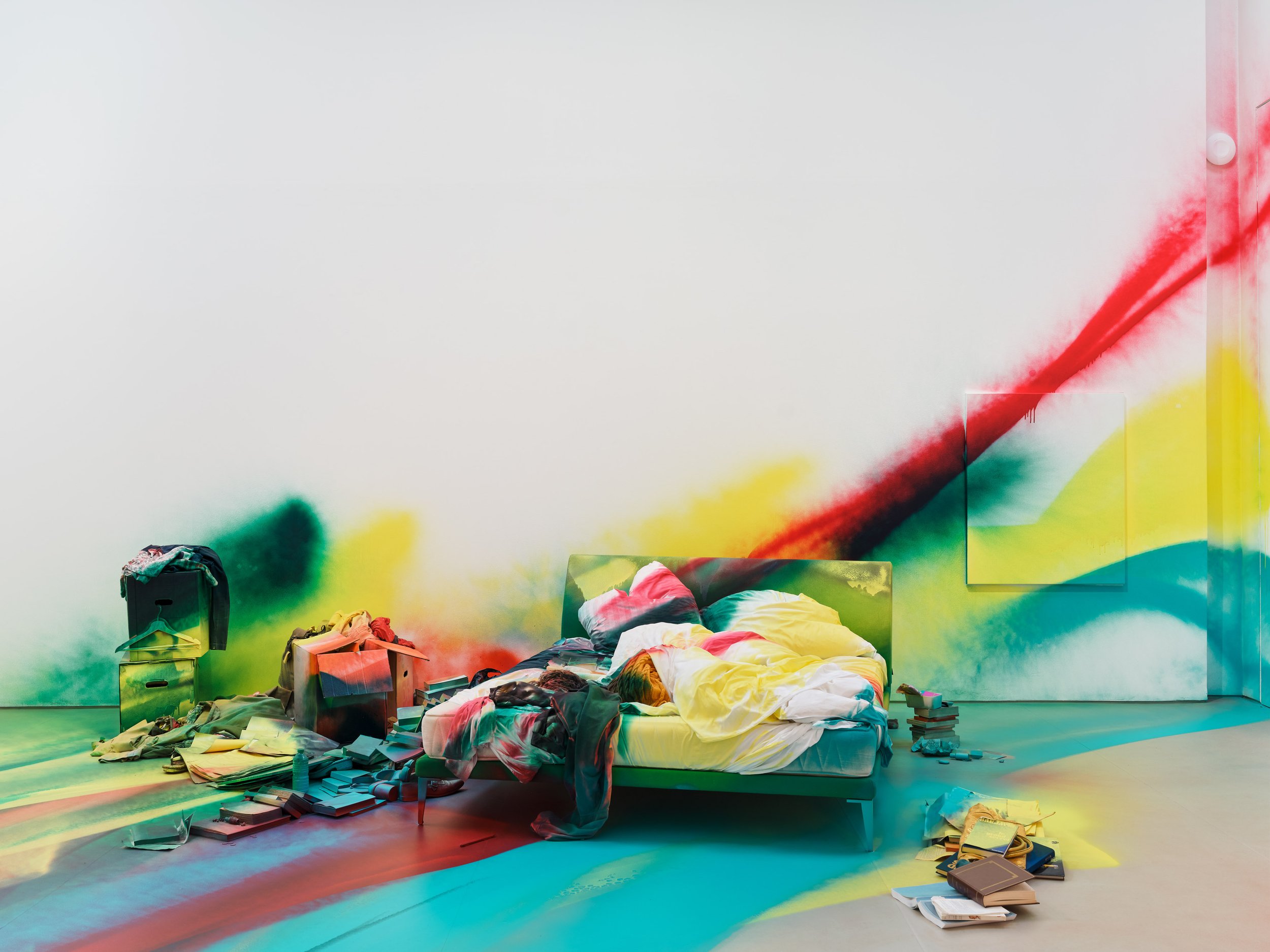

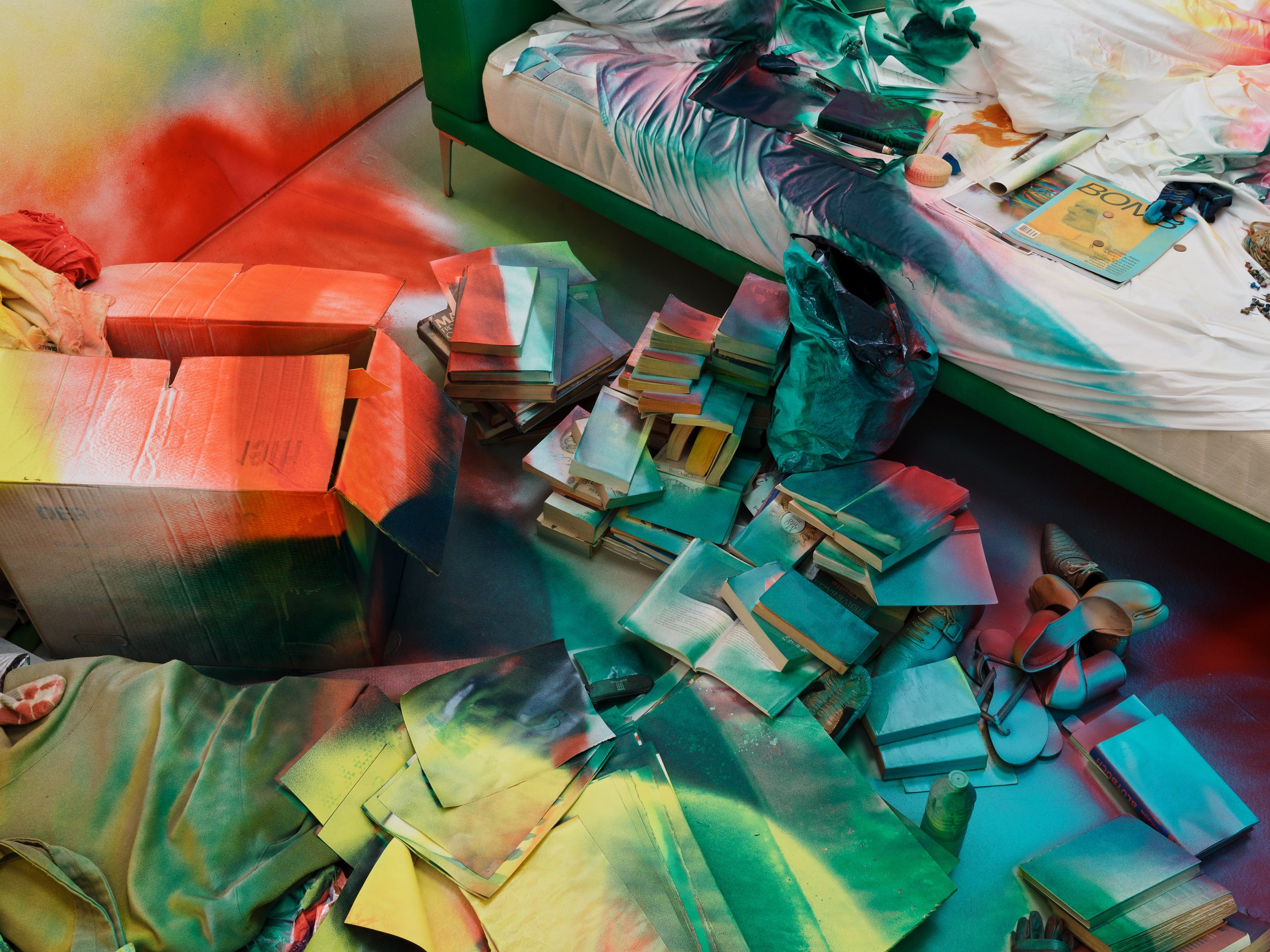
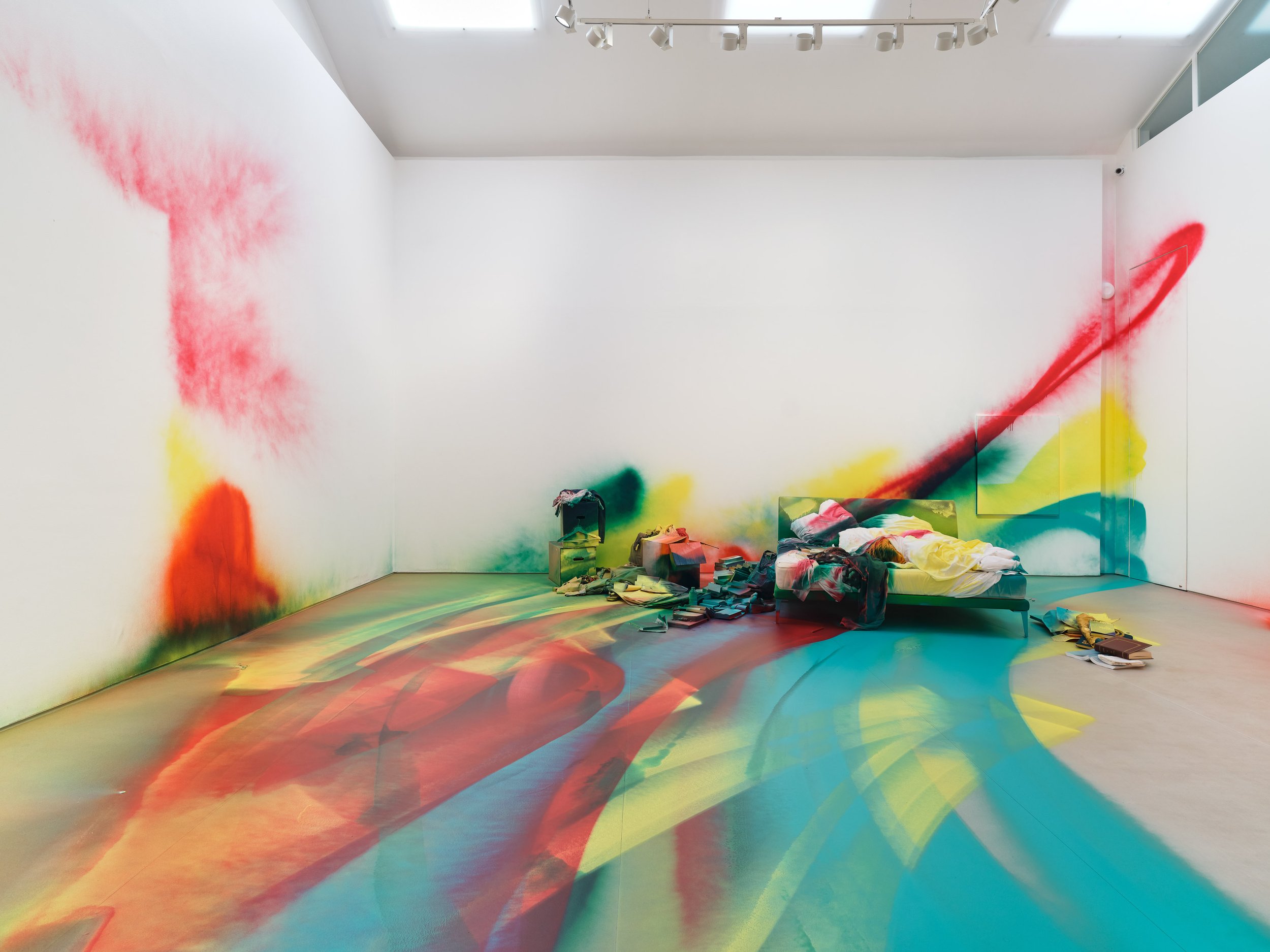
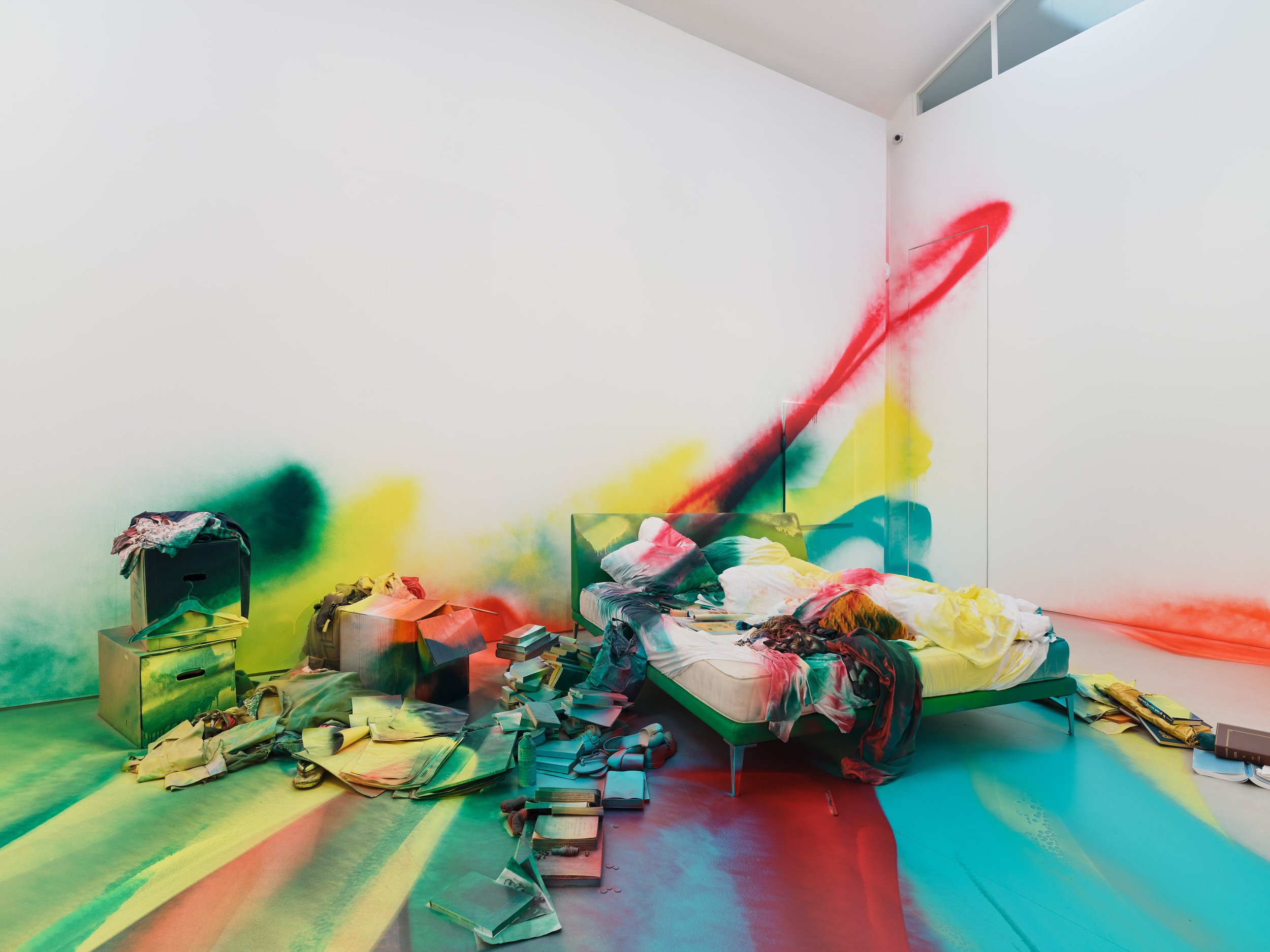
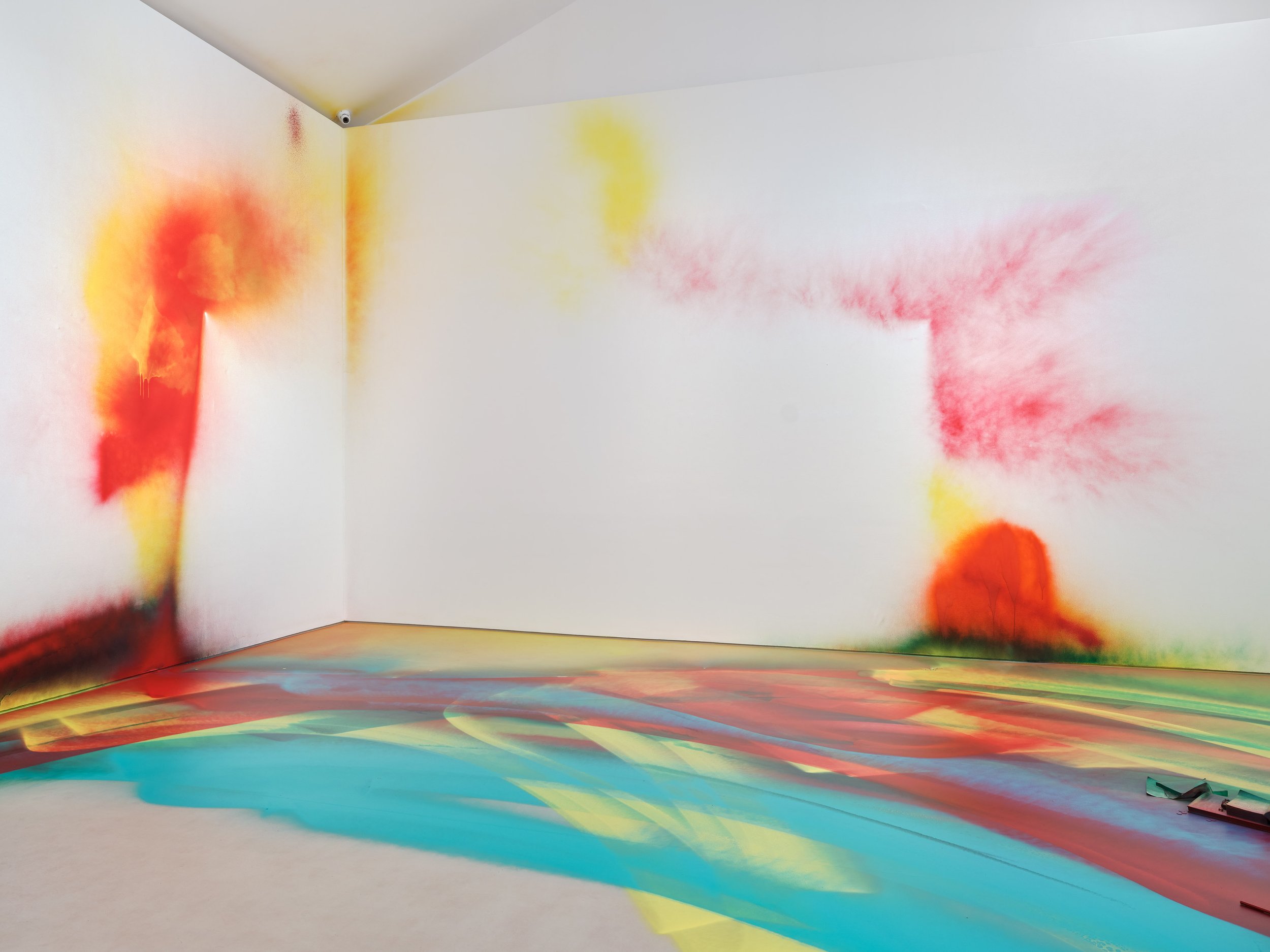
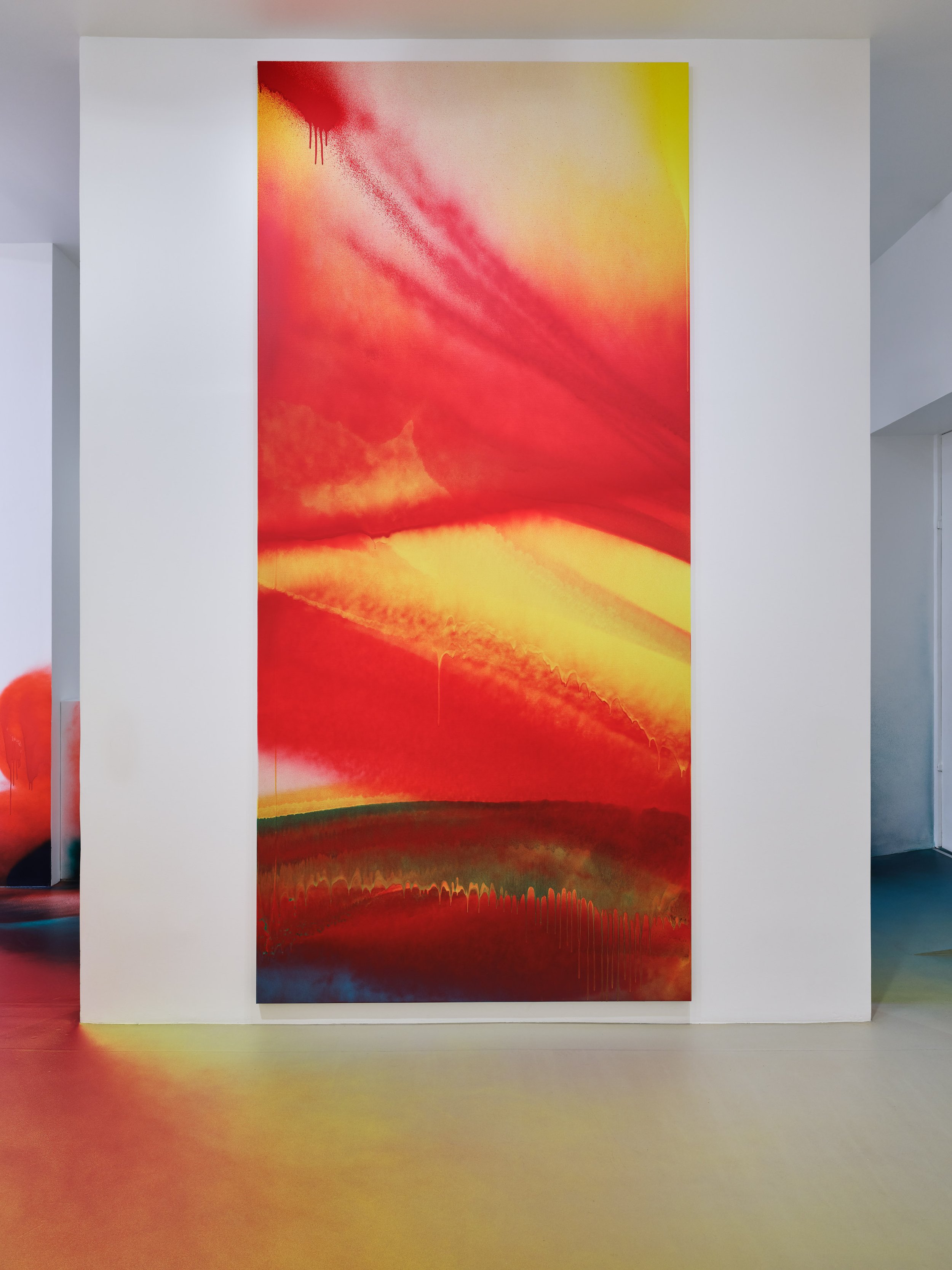
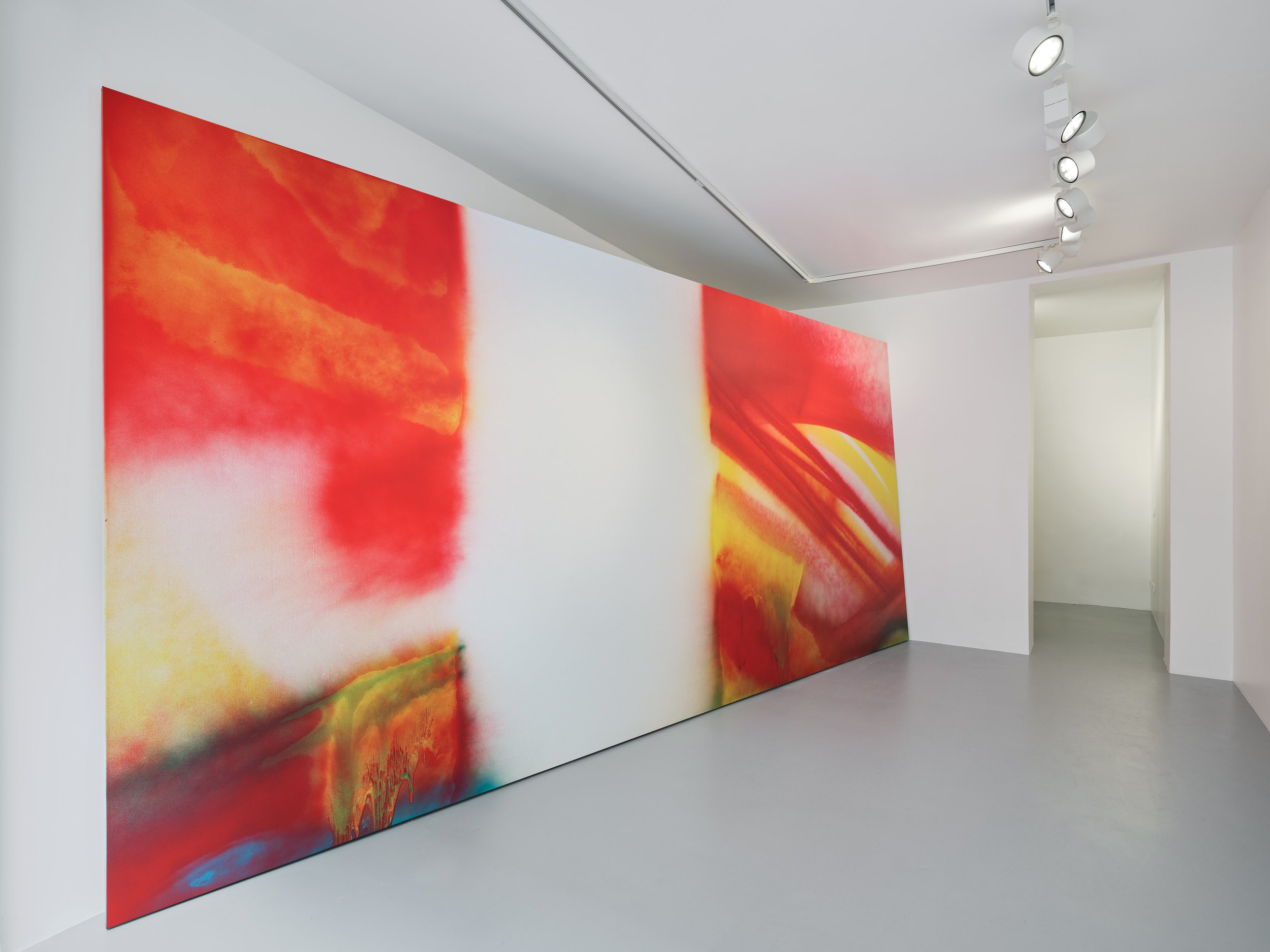
© Katharina Grosse und VG Bild-Kunst, Bonn, 2023 / Courtesy Galerie Max Hetzler Berlin | Paris | London. Photo: Thomas Lannes.
Das Bett, 2004, was a turning point, at once a destruction and a new beginning. The tailored suit, for example, which had been sprayed over, could now no longer be worn. At the same time, however, the space underwent a strange transformation. While objects have appeared in pictures since the beginnings of art, they now became the support and surface of a form of painting that was carried out on their backs. The act of painting, performed by Grosse in one sweep, left its mark as a current of energy. The spray gun replaced the brush. Both are among the painting tools regularly used by Grosse.
Katharina Grosse's painting has since continued to evolve: from the large installation at the 56th Venice Biennale in 2011 to Asphalt and Hair in Aarhus in 2017. If the history of painting were told along the metaphors of ‘window' and ‘door’, Grosse's works would be part of the latter. The difference lies in the perceptual standpoint. When we look at a window, we are faced with a different place from which we remain separate, regardless of whether we see a detail of the landscape or if its view is obscured by blinds. If, on the other hand, you face a door, you can grasp the possibility of crossing over or entering something else.
“Isn’t that the essence of the bed, too? This place where we sleep, dream or simply toss and turn dreamlessly has long written history. In the 19th century, the court painter Adolph von Menzel drew his unmade bed in chalk, and more than a hundred years later Robert Rauschenberg painted on the quilted coverlet of his bed. In Katharina Grosse's work, the paint has spread from the bed and thus forms a new surface. It is not the first time that a new idea has arisen from this place. After all, where did the American writer Edith Wharton, the first woman to be awarded the Pulitzer Prize, write? In bed.”
Julia Voss
Katharina Grosse (born 1961 in Freiburg im Breisgau) lives and works in Berlin and New Zealand.
Her recent exhibitions and on-site paintings include Katharina Grosse Studio Paintings, 1988–2022: Returns, Revisions, Inventions at Kunstmuseum Bern (2023) and at Mildred Lane Kemper Art Museum, St. Louis (2022); Canyon (permanent from 2022) and Splinter (2022) both at Fondation Louis Vuitton, Paris; Apollo, Apollo, at Espace Louis Vuitton, Venice (collateral event of 59th Venice Biennale, 2022); Chill Seeping from the Walls Gets between Us at HAM Helsinki Art Museum (2021); Shutter Splinter at Helsinki Biennial (2021); Is It You? at Baltimore Museum of Art (2020); It Wasn’t Us at Hamburger Bahnhof–Museum für Gegenwart–Berlin (2020); the two-person show
Mural: Jackson Pollock | Katharina Grosse at Museum of Fine Arts, Boston (2019); chi K11 art space, Guangzhou, China (2019); The Horse Trotted Another Couple of Meters, Then It Stopped at
Carriageworks, Sydney (2018); Wunderbild at National Gallery Prague (2018); Mumbling Mud at chi K11 art museum, Shanghai (2018); Asphalt Air and Hair at ARoS Triennial, Aarhus, Denmark (2017); This Drove My Mother Up the Wall at South London Gallery (2017); Katharina Grosse at Museum Frieder Burda, Baden-Baden, Germany (2016); Rockaway for MoMA PS1’s Rockaway! program, Fort Tilden, New York (2016); yes no why later at Garage Museum of Contemporary Art, Moscow (2015); Seven Hours, Eight Rooms, Three Tress at Museum Wiesbaden, Germany (2015); Untitled Trumpet for the 56th Venice Biennale (2015); and psychylustro for Mural Arts
Program Philadelphia (2014). Museum collections include Albertina, Vienna; Albright-Knox Art Gallery, Buffalo; ARKEN Museum for Moderne Kunst, Copenhagen; Baltimore Museum of Art; Centre Georges Pompidou, Paris; Fondation Louis Vuitton, Paris; Istanbul Modern; K21– Kunstsammlung Nordrhein-Westfalen, Düsseldorf; Kunsthaus Zürich; Kunstmuseum Bern; Kunstmuseum Bonn; Lenbachhaus, Munich; Magasin III, Stockholm; MARe–Muzeul de Artă Recentă, Bucharest; MAXXI– Museo nazionale delle arti del XXI secolo, Rome; Milwaukee Art Museum; Museum Azman, Jakarta; Museum of Modern Art, New York; Nasher Sculpture Center, Dallas; Pérez Art Museum Miami; Queensland Art Gallery & Gallery of Modern Art (QAGOMA), Brisbane; Saarland Museum – Moderne Galerie, Saarbrücken;Serralves Museum of Contemporary Art, Porto; and Staatliche Museen zu Berlin, as well as the Mildred Lane Kemper Art Museum, Washington University in St. Louis.
The opening was Friday the 8th and was held from 6 – 8 pm, the exhibit will close on October 21st of this year. For more information about Katharina Grosse’s exhibit please visit Galerie Max Hetzler's site here.
Spider Talk: Logan Sylve
courtesy of the artist
Chase Contemporary is pleased to announce Spider Talk, a solo exhibition of new paintings by New York-based artist Logan Sylve. Sylve’s work explores the push and pull between what we as people present to the outside world versus the complexity of our internal realities. The exhibition opened on Thursday, October 5th at 413 West Broadway in SoHo with a reception with the artist.
Many of these paintings were created in the gallery’s artist studio, in the lower level of the gallery. Subject matter ranges from complex figurative works to playful renditions of animals against vibrant, primary backgrounds. The presentation places scenes of human social interactions or solitary moments, with all the complexities and nuances of our makeup, in contrast to simple compositions of animals whose existence and intentions are far more straightforward and undefiled. Sylve is interested in the nature of people versus the nature of animals.
Commute, 2023 Acrylic on Canvas 85.50 x 69 in
An example of this intention is the painting Commute (2023, acrylic on canvas, 90 x 76 in), where a black haired figure represents what he believed God looks like, but he changed his mind when realizing the figure looks too much like himself (but it continues to represent a figure of good intentions - a protagonist). The white figure is unknown to the artist, “but he’s around now” says Sylve. This relationship could be representative of balance, and the figures may always exist together - a narrative to be continued in his work. Concentrating his color palette to evoke certain moods, Sylve’s style also incorporates elements of classical Western American imagery and animated cartoons while staying true to anatomical structure, his visual cues to pop culture allowing viewers to find their own points of reference. The attention to anatomy reveals Sylve’s intense study and dedication to his craft, also exposing the fetishization of certain body parts in Western culture while imploring the viewer to question their own relationship with their body and environment.
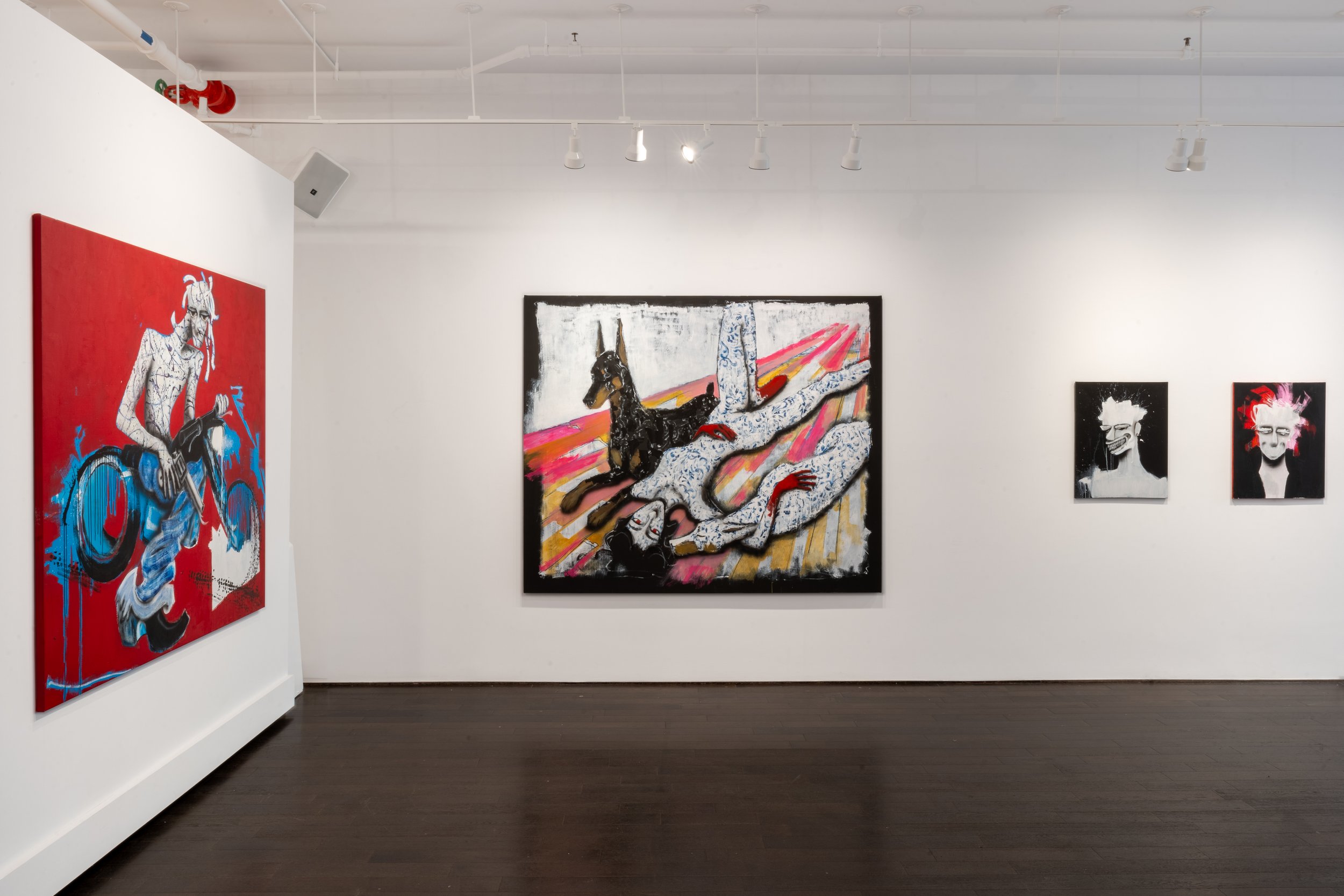
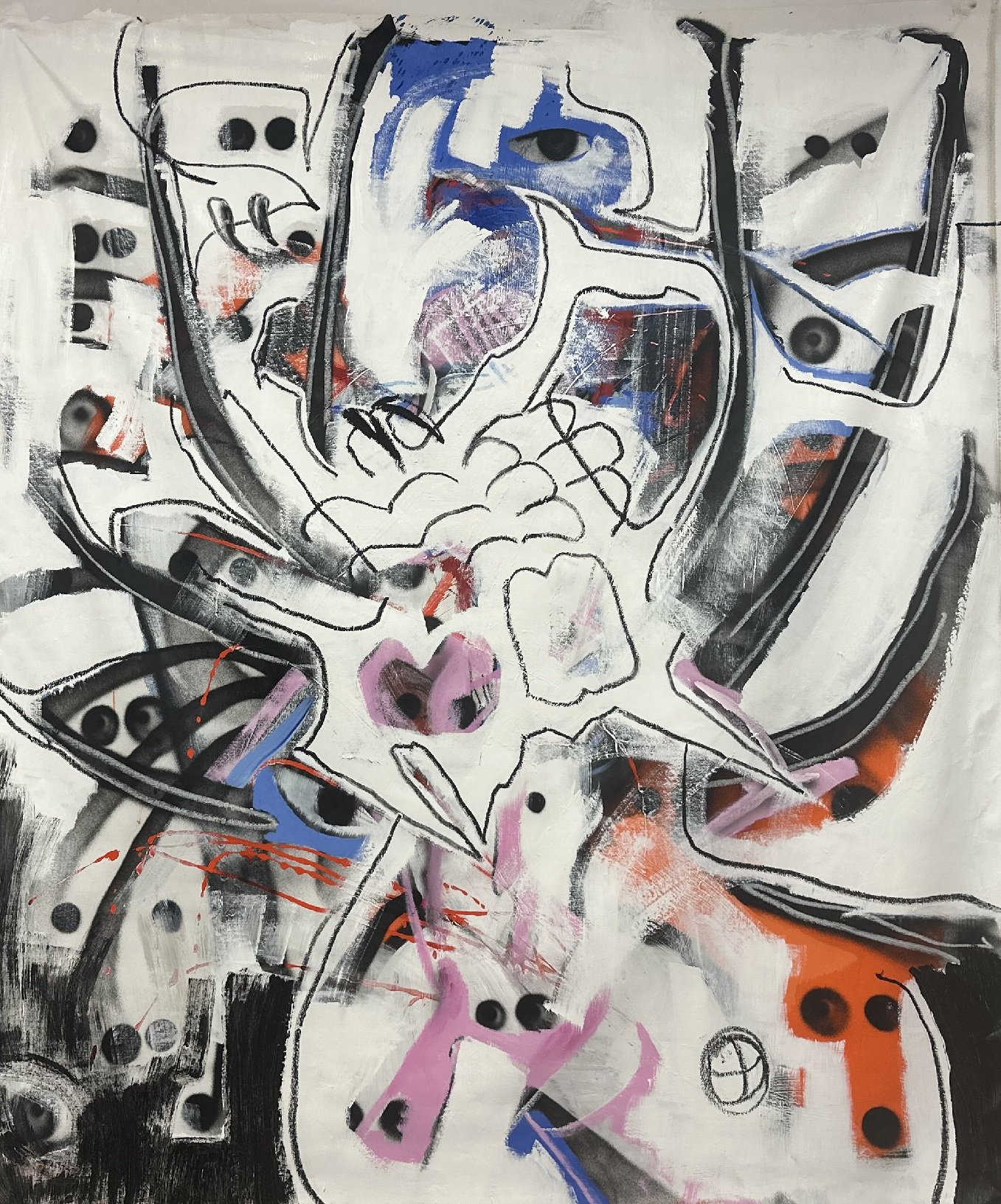



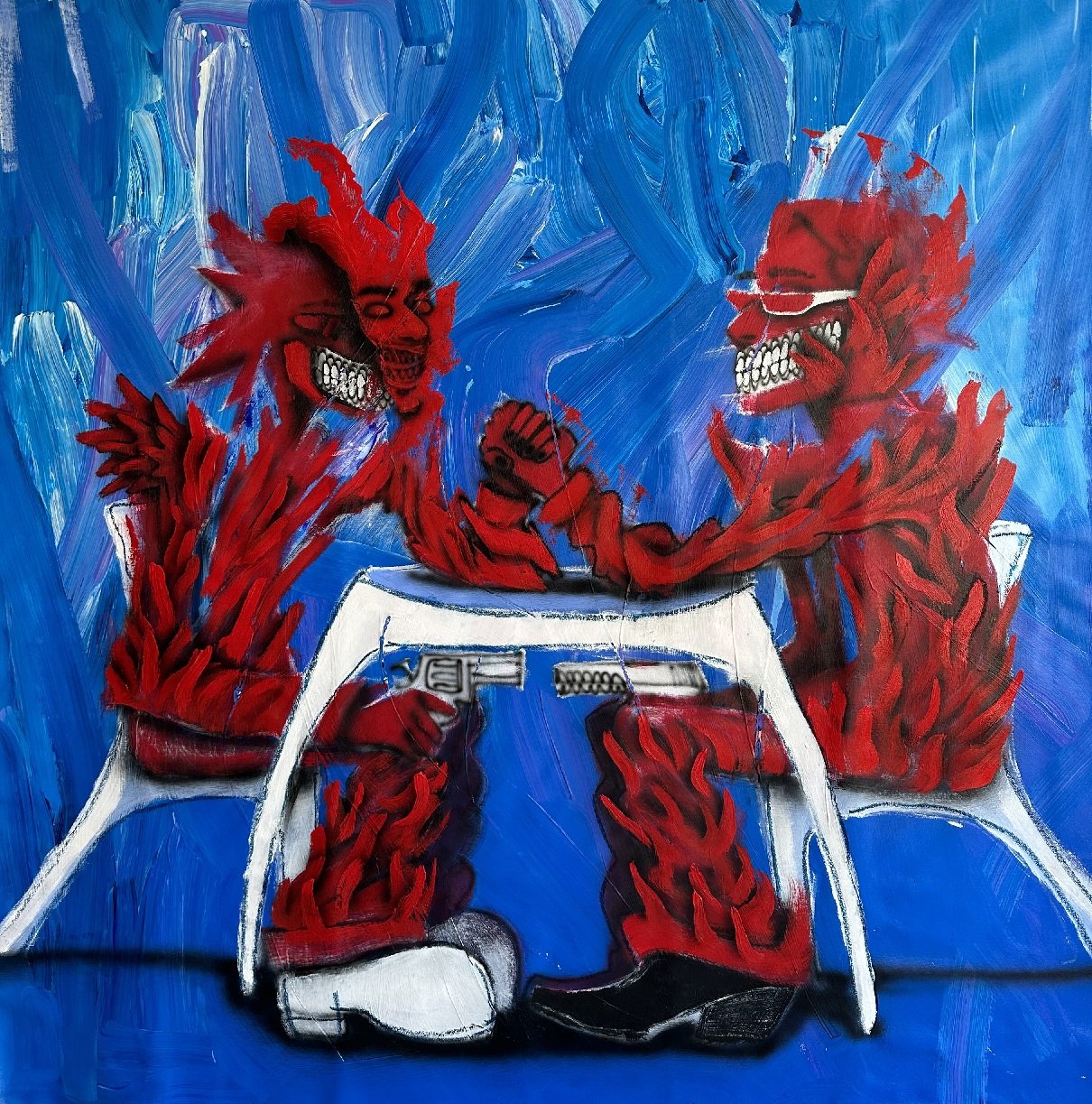

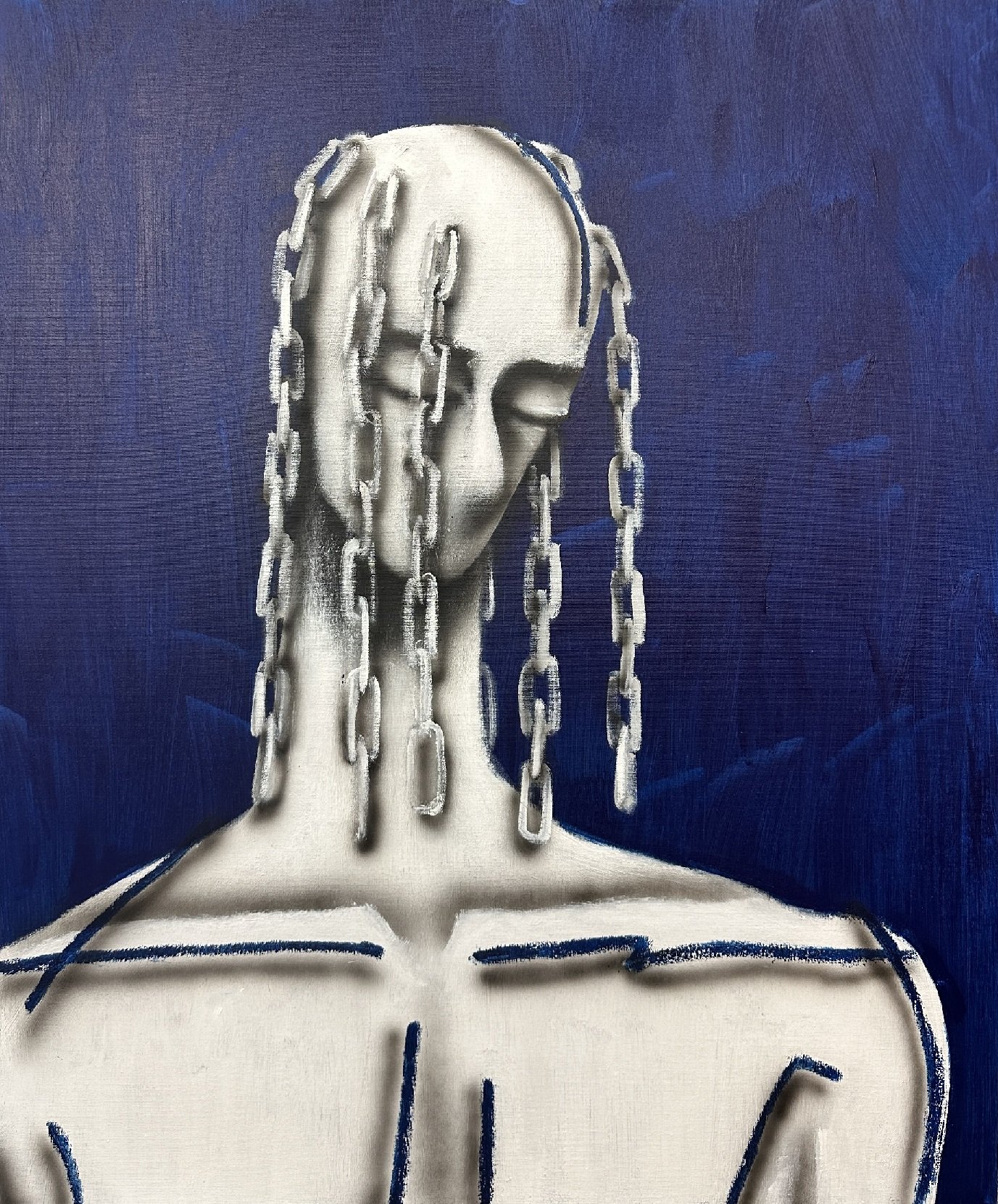
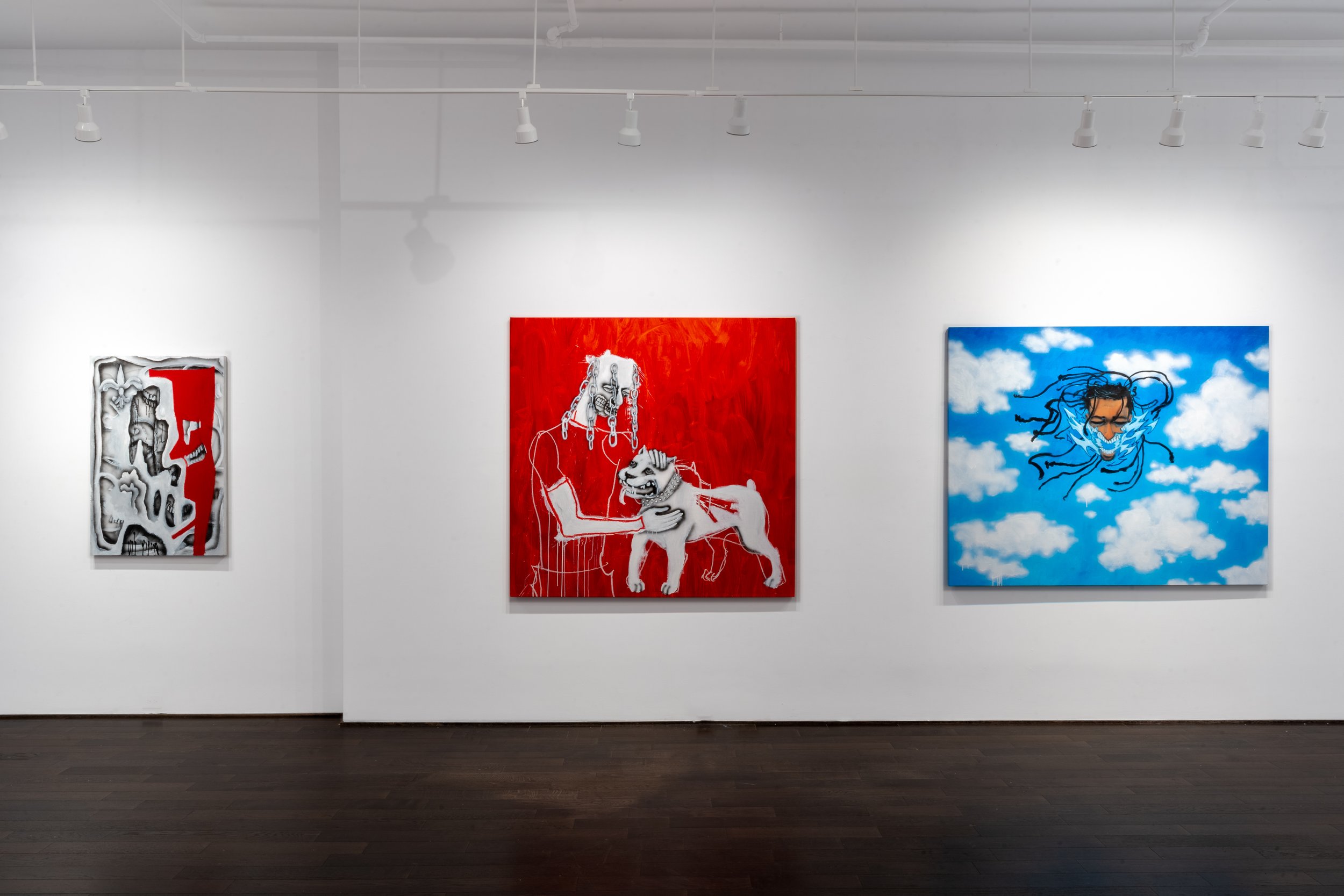
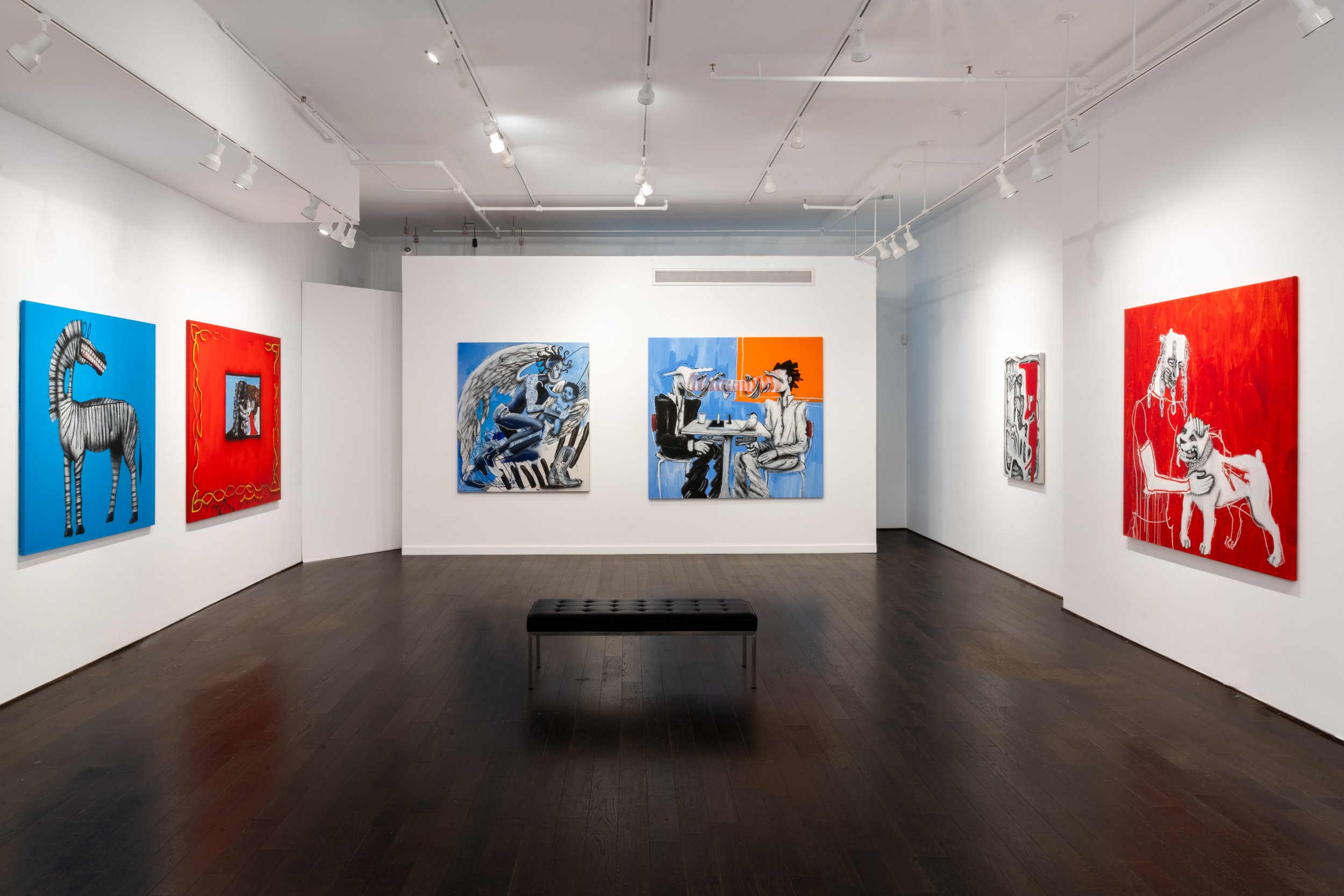
Courtesy of Chase Contemporary and Logan Syle.
Spider Talk will be on view until October 26th. For more information about Logan’s exhibit please visit Chase Contemptary’s site.
Louise Bourgeois. Once there was a mother
Installation view, ‘Louise Bourgeois. Once there was a mother’ Hauser & Wirth New York 18th Street 8 September–23 December 2023 © The Easton Foundation / Licensed by VAGA at Artists Rights Society (ARS), NYPhoto: Thomas Barratt.
New York…Hauser & Wirth is pleased to announce that the gallery will inaugurate its new dedicated space for Hauser & Wirth Editions with ‘Once there was a mother,’ a solo presentation of important and little-seen works by Louise Bourgeois (1911– 2010). Celebrated for large-scale sculpture and installation art, Bourgeois was also an inventive and prolific printmaker, especially during the last decade of her life. Centered around one of her most powerful themes––motherhood and maternity––the exhibition places Bourgeois’s printed works in relation to sculptures and drawings to highlight the essential role printmaking played within her multifaceted practice. It is the first show to focus on Bourgeois’s prints since the 2017-18 MoMA exhibition, ‘Louise Bourgeois: An Unfolding Portrait,’ curated by Deborah Wye, who is also the editor of the online catalogue raisonné of Bourgeois’s prints and books.
Hauser & Wirth’s new dedicated Editions space is located at 443 West 18th Street, a historic two-story former industrial building that has been transformed to complete the gallery’s West Chelsea expansion and complement its building at 542 West 22nd Street, which opened in 2020. In its new space, Hauser & Wirth Editions will explore the universe of contemporary and historical prints through curated exhibitions and public programs that showcase the multifaceted practices of the gallery’s international family of artists. Hauser & Wirth’s 18th Street location will also be home to new iterations of the popular Hauser & Wirth Publishers Bookstore and Roth New York Bar, both previously found in the gallery’s temporary location in the former historic Dia Center for the Arts building at 548 West 22nd Street. In addition to the Hauser & Wirth Editions space, the 18th Street location will house the Hauser & Wirth Learning hub for educational and community programs and projects; a small amphitheater for lectures, panels, performances and other special events; and extensive office and co-working spaces for the gallery’s New York team.


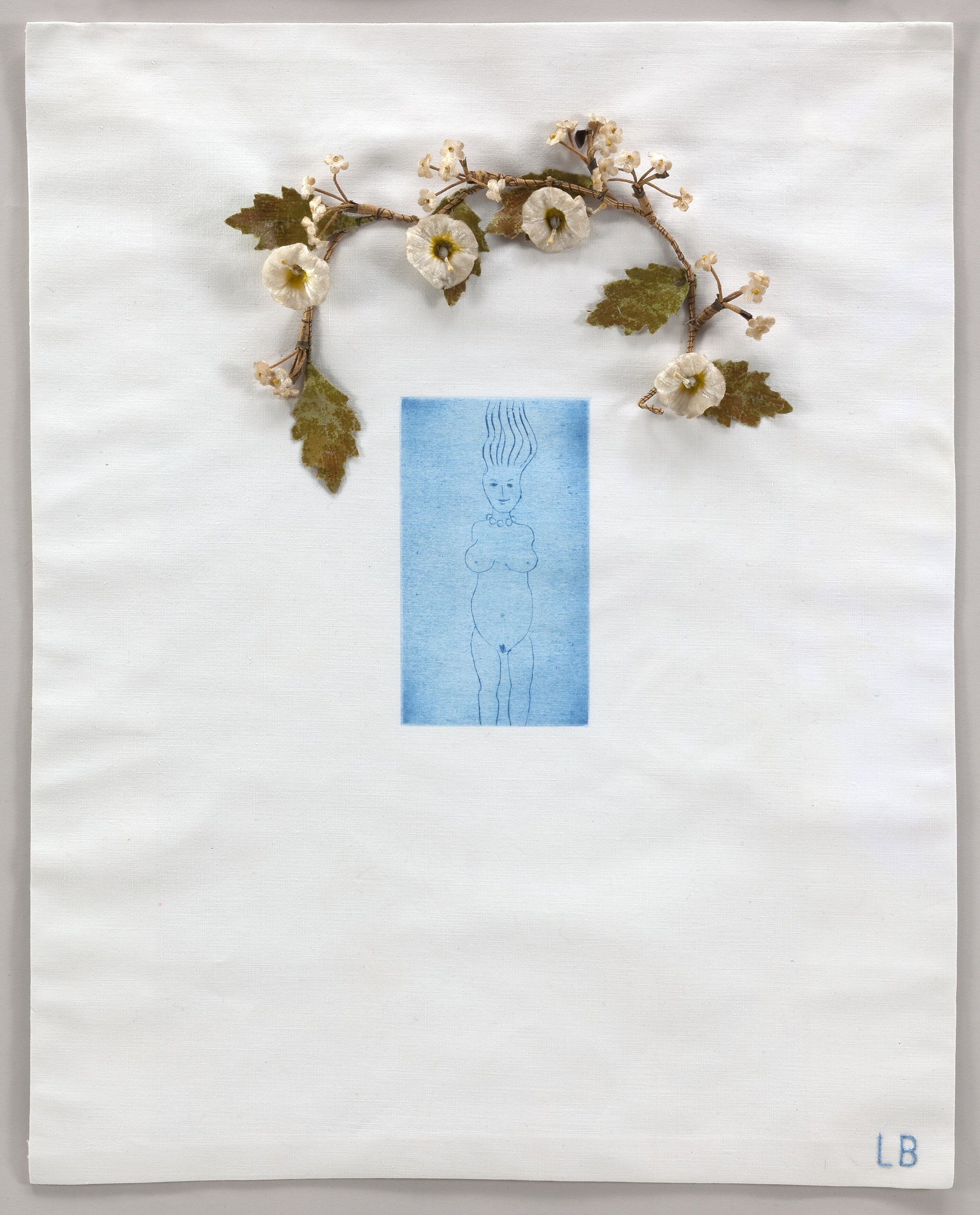
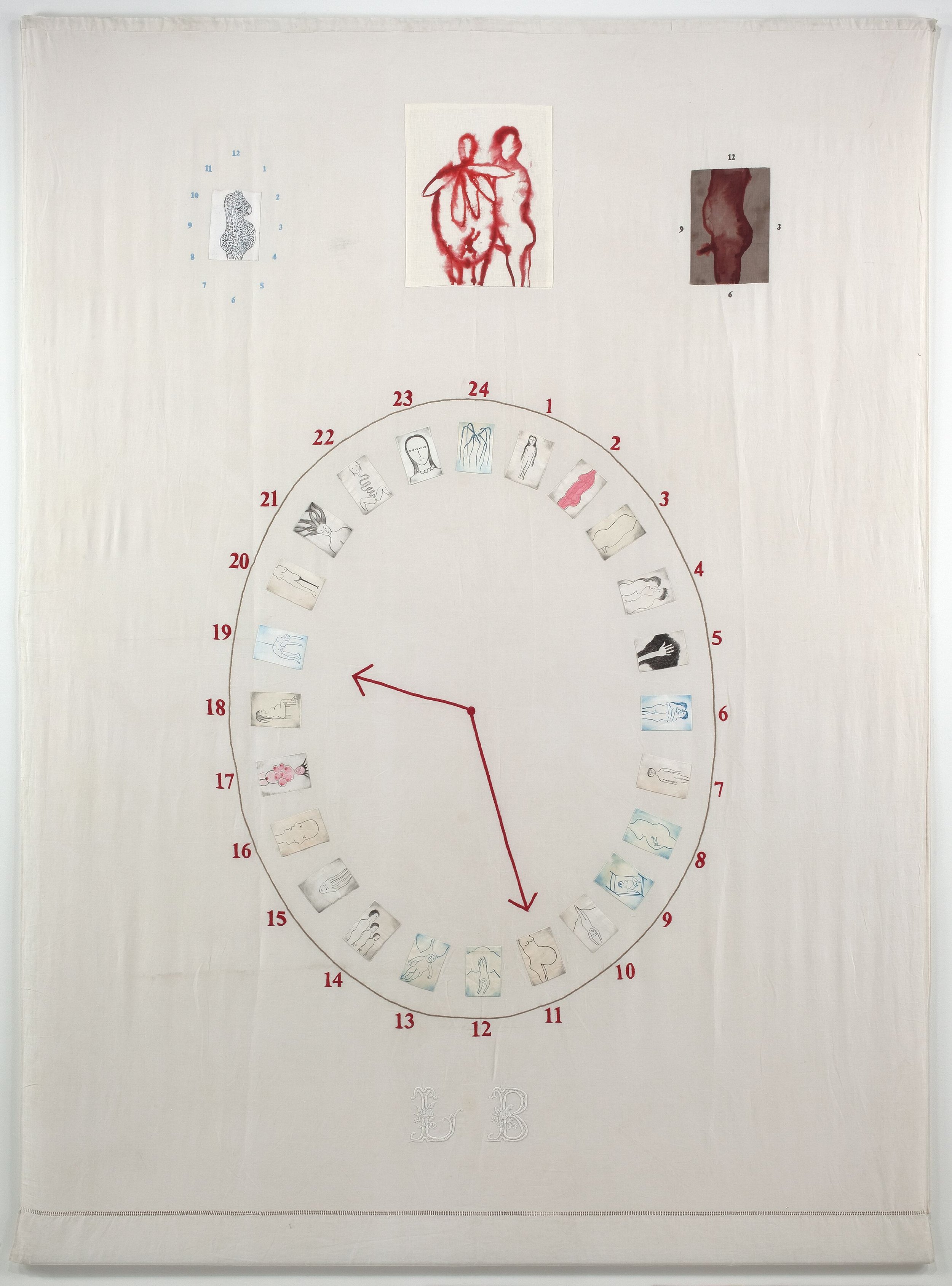


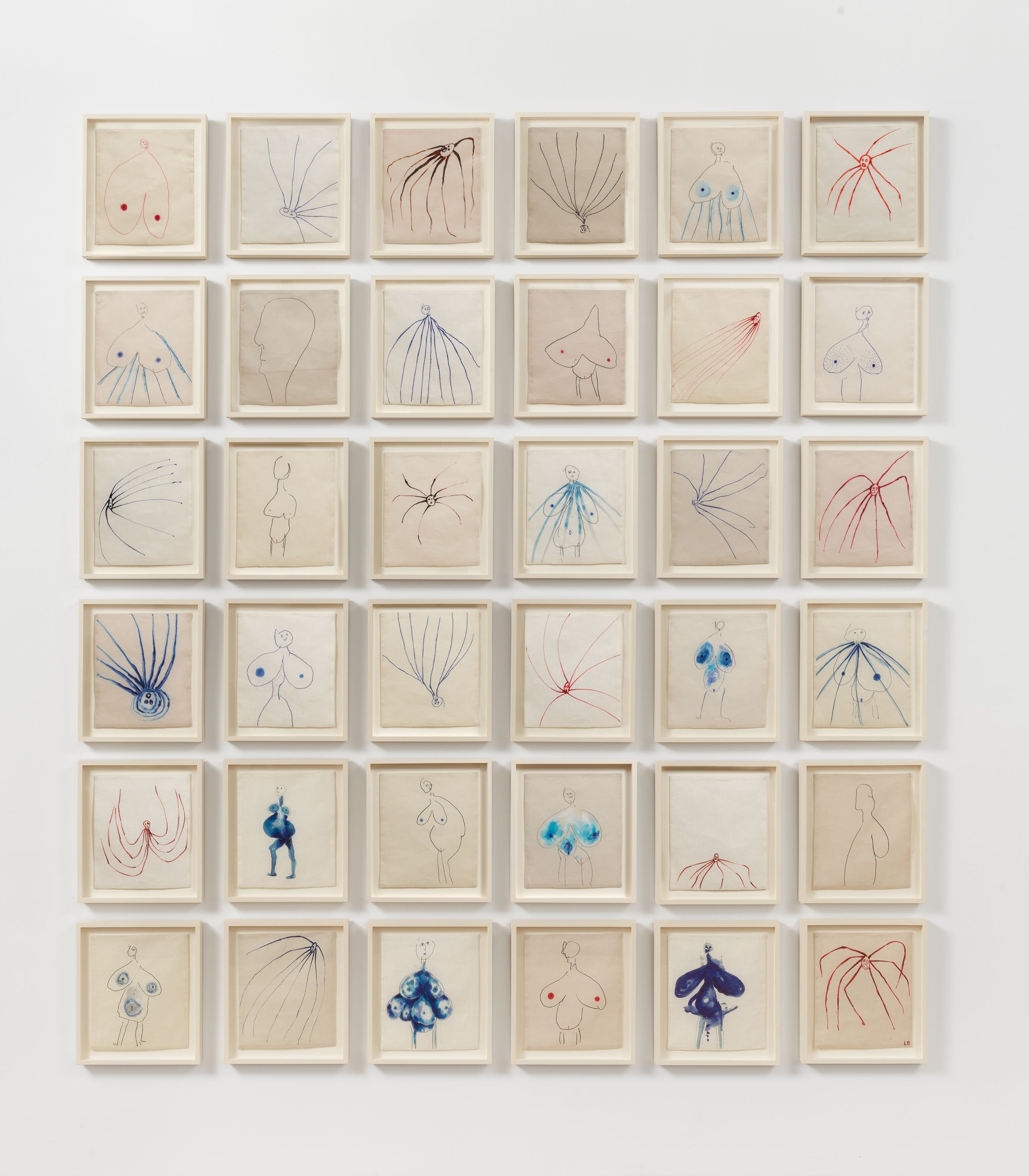
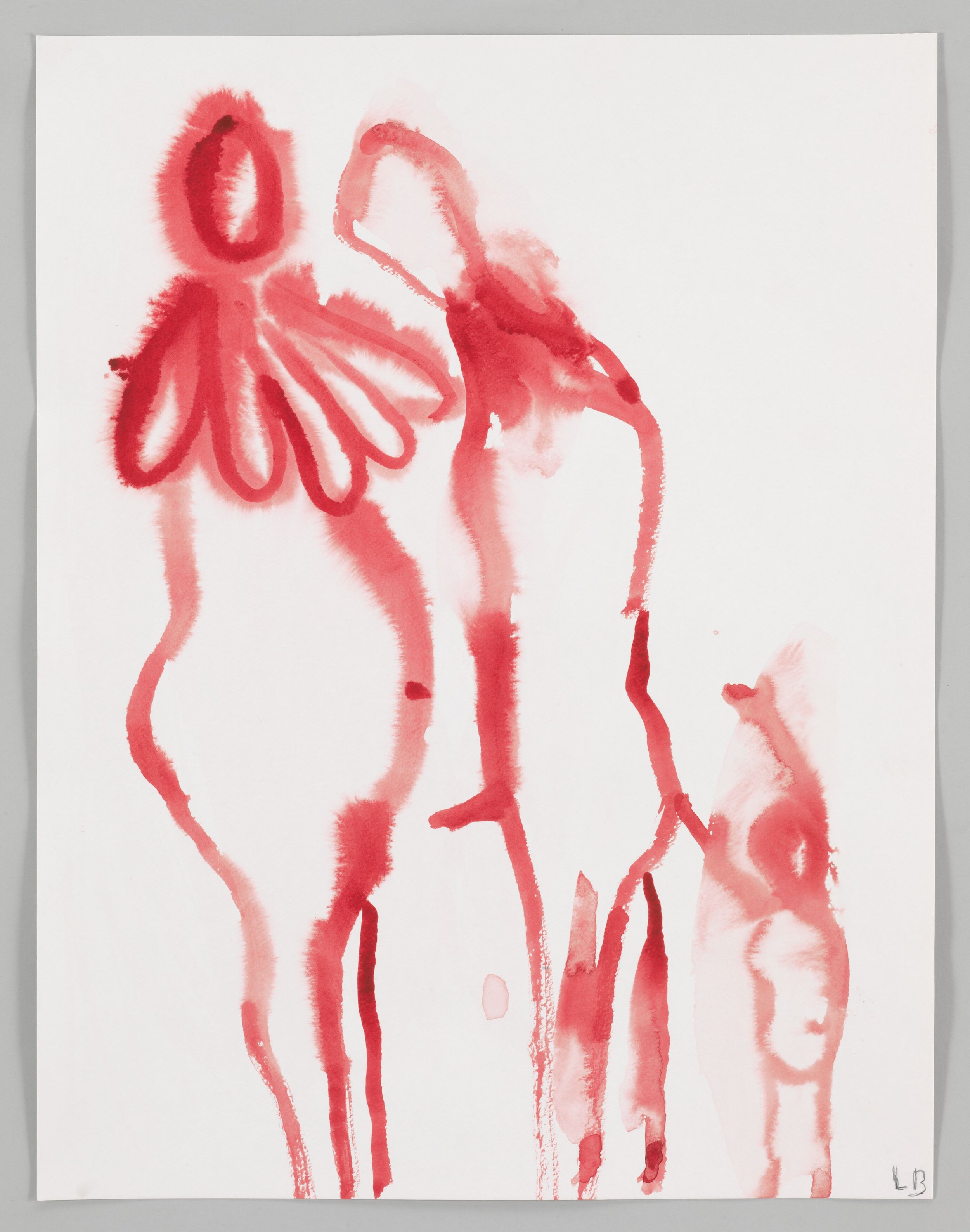
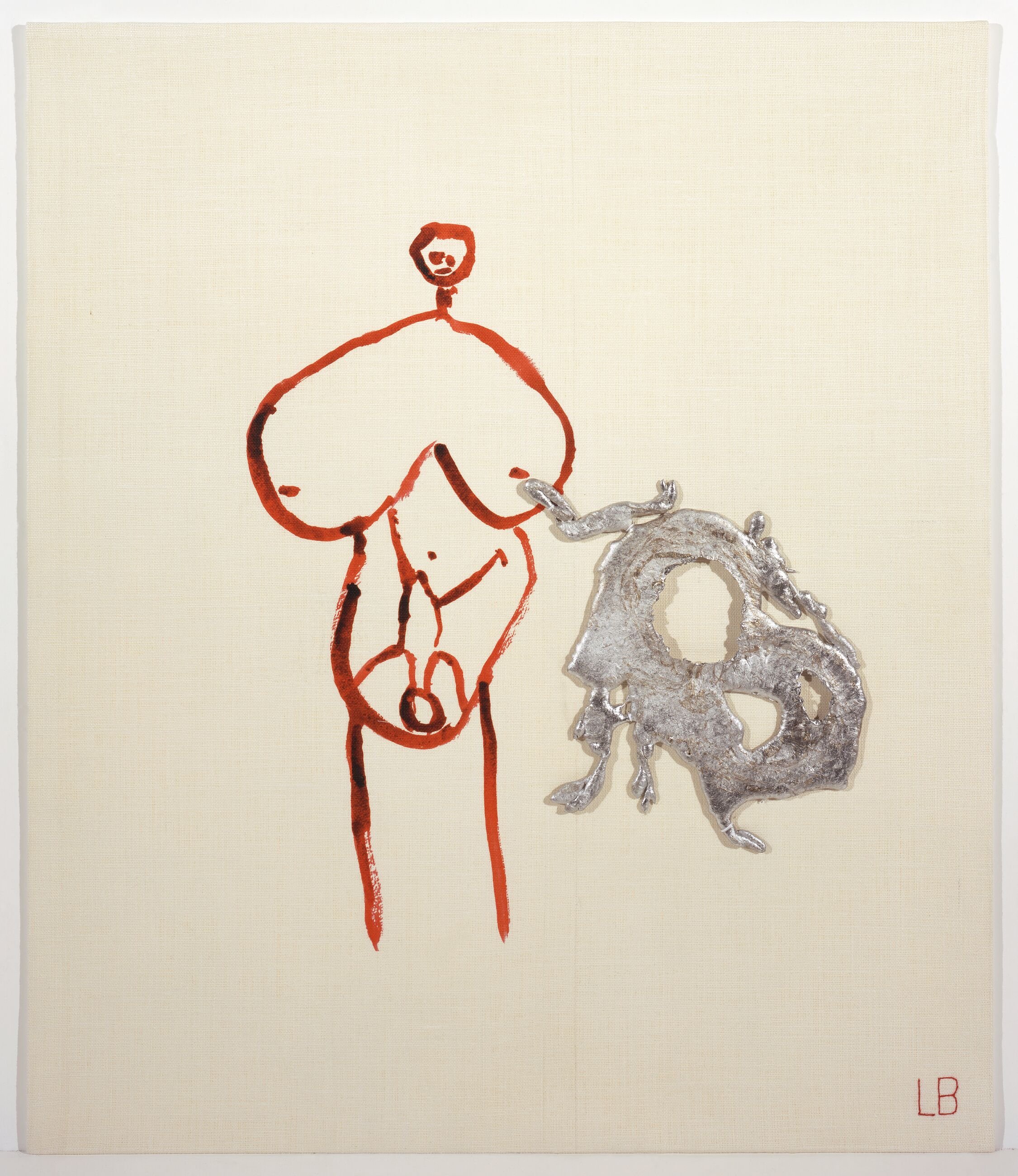
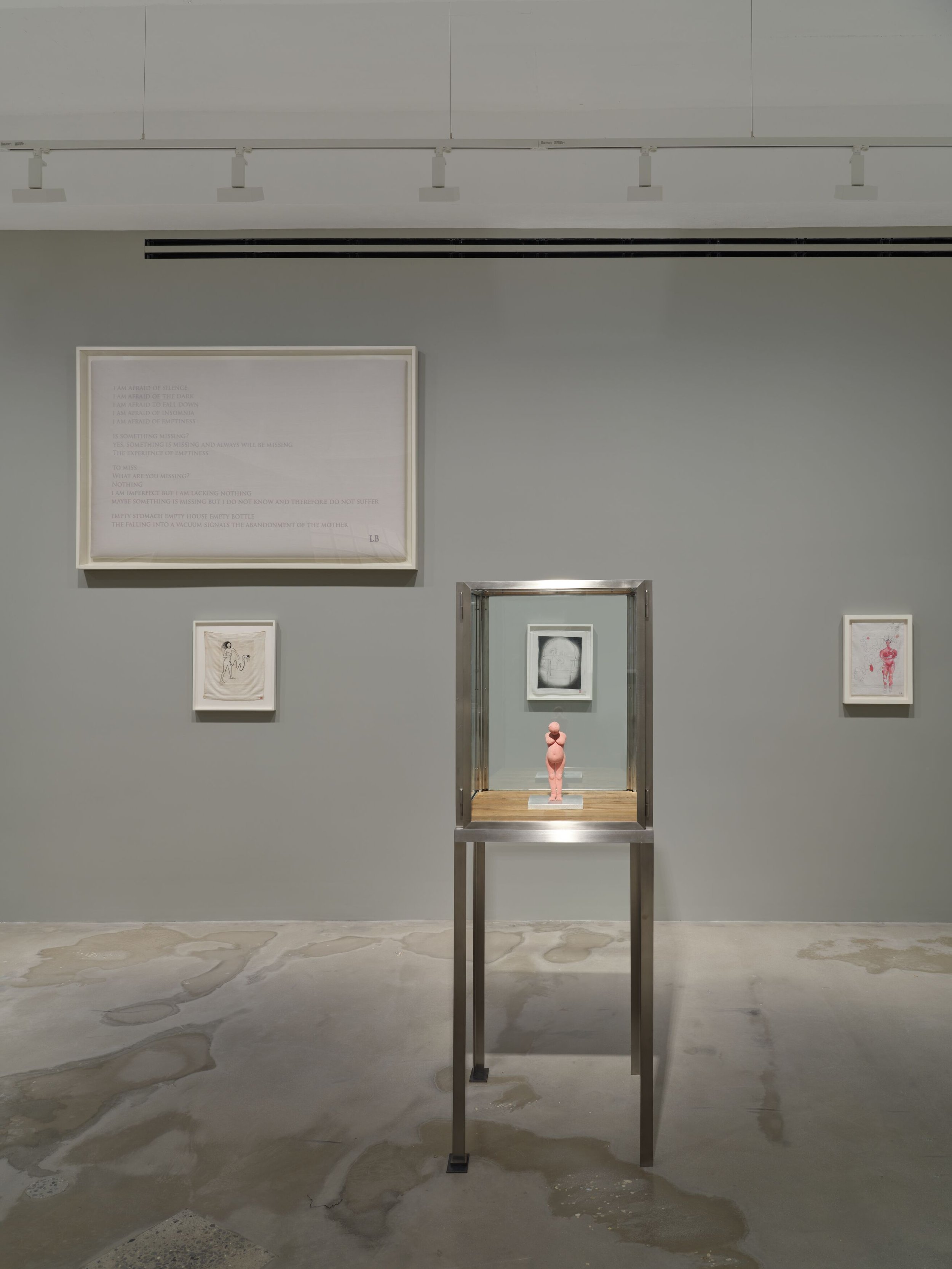
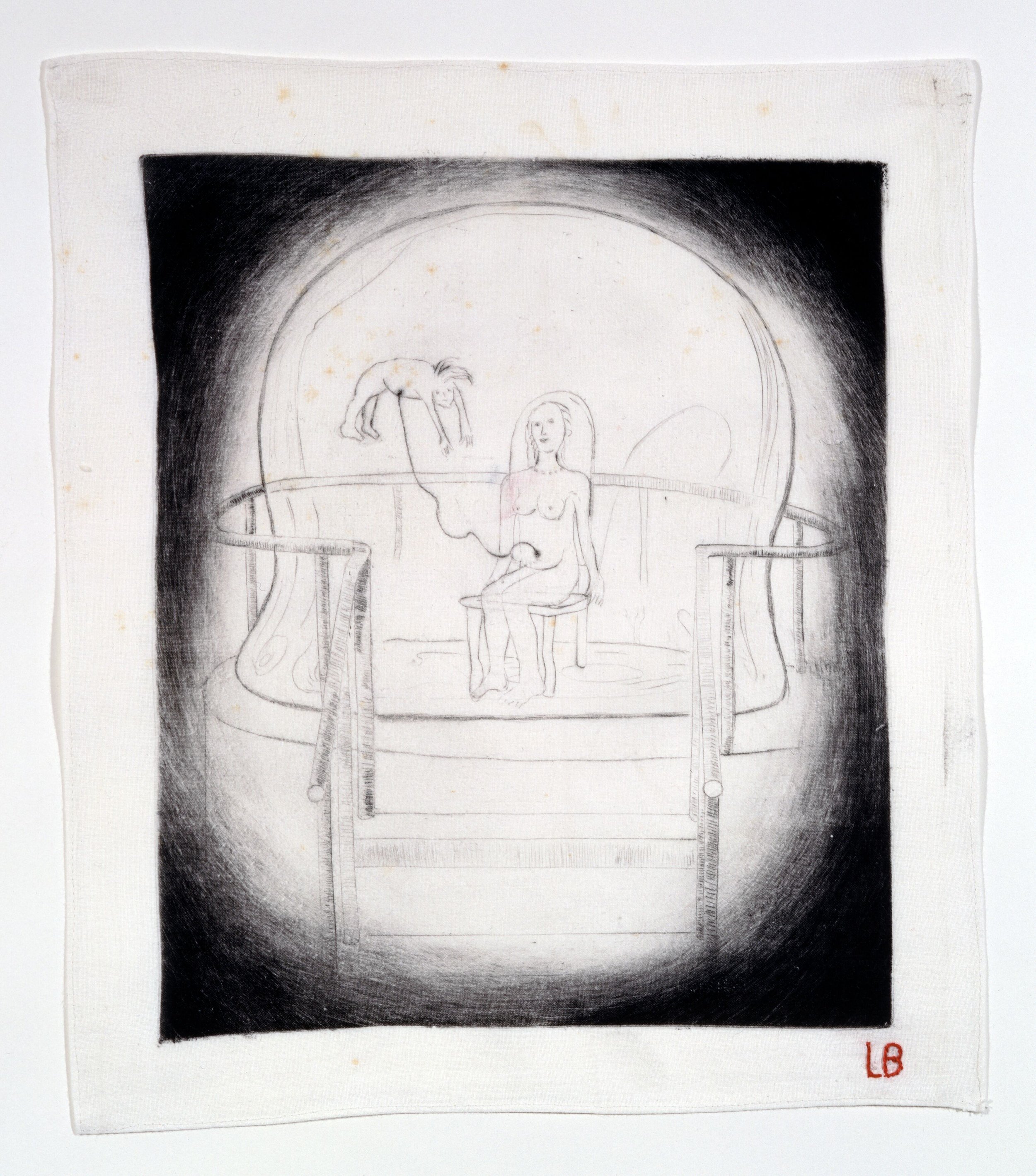

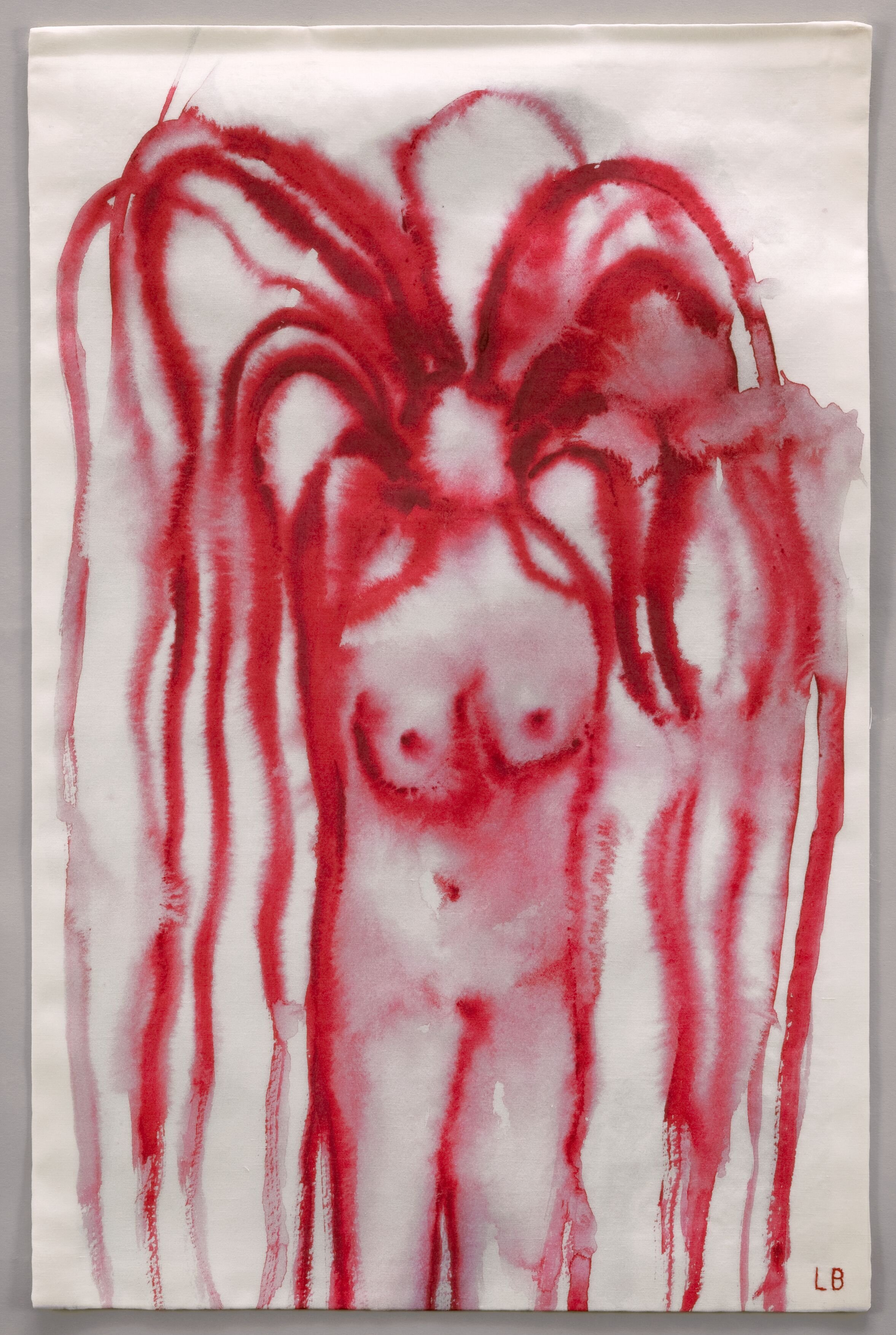
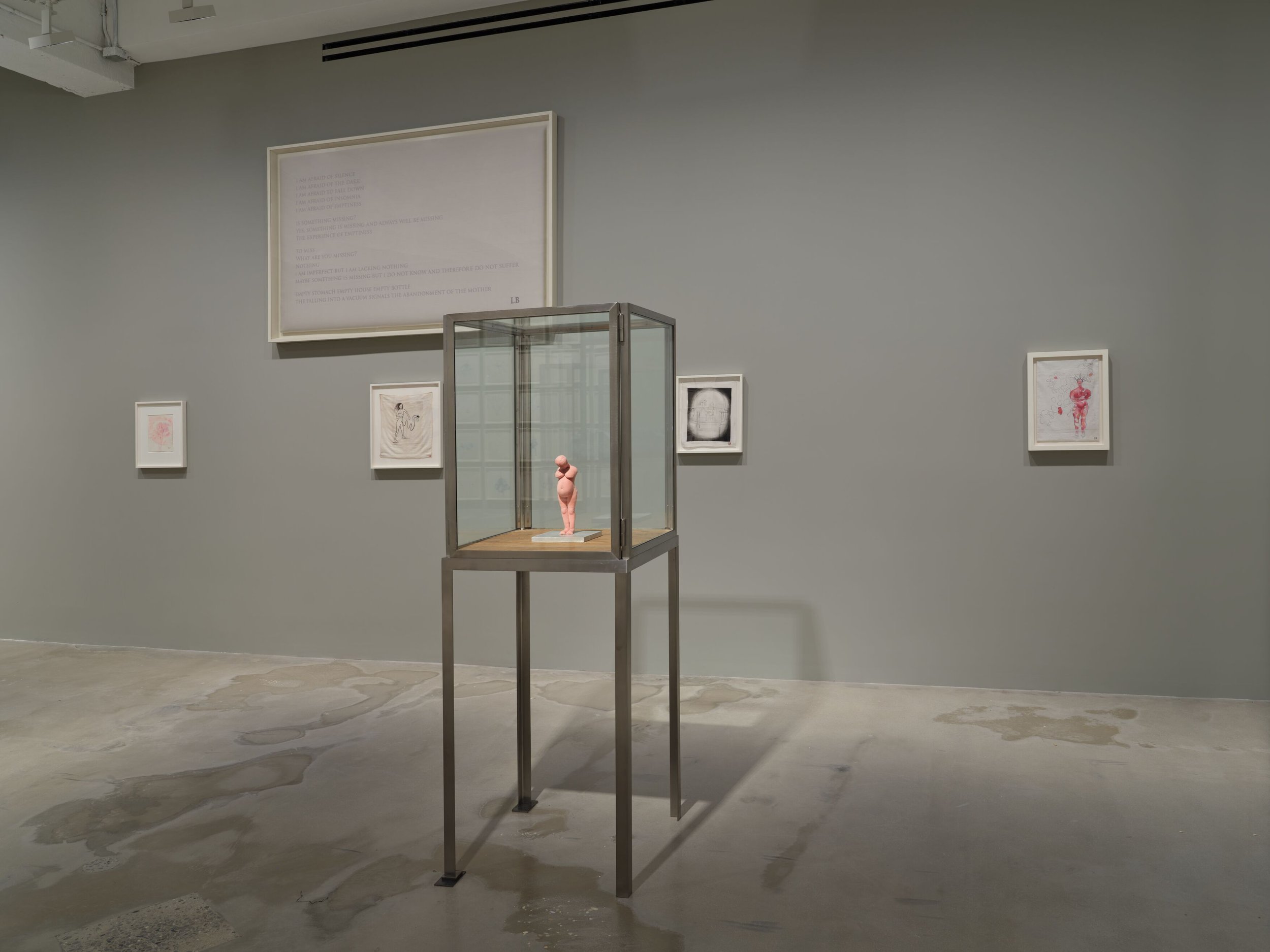
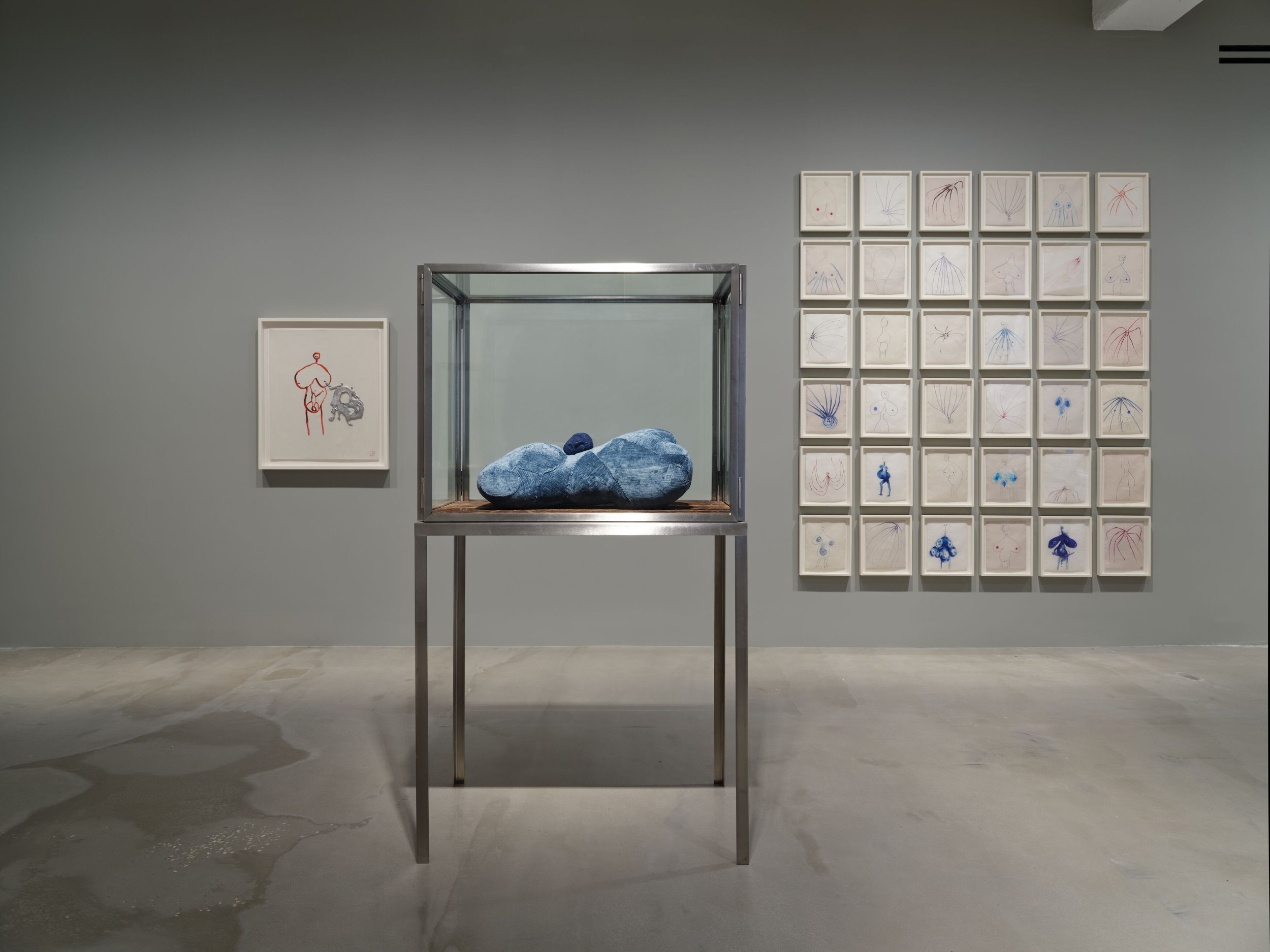
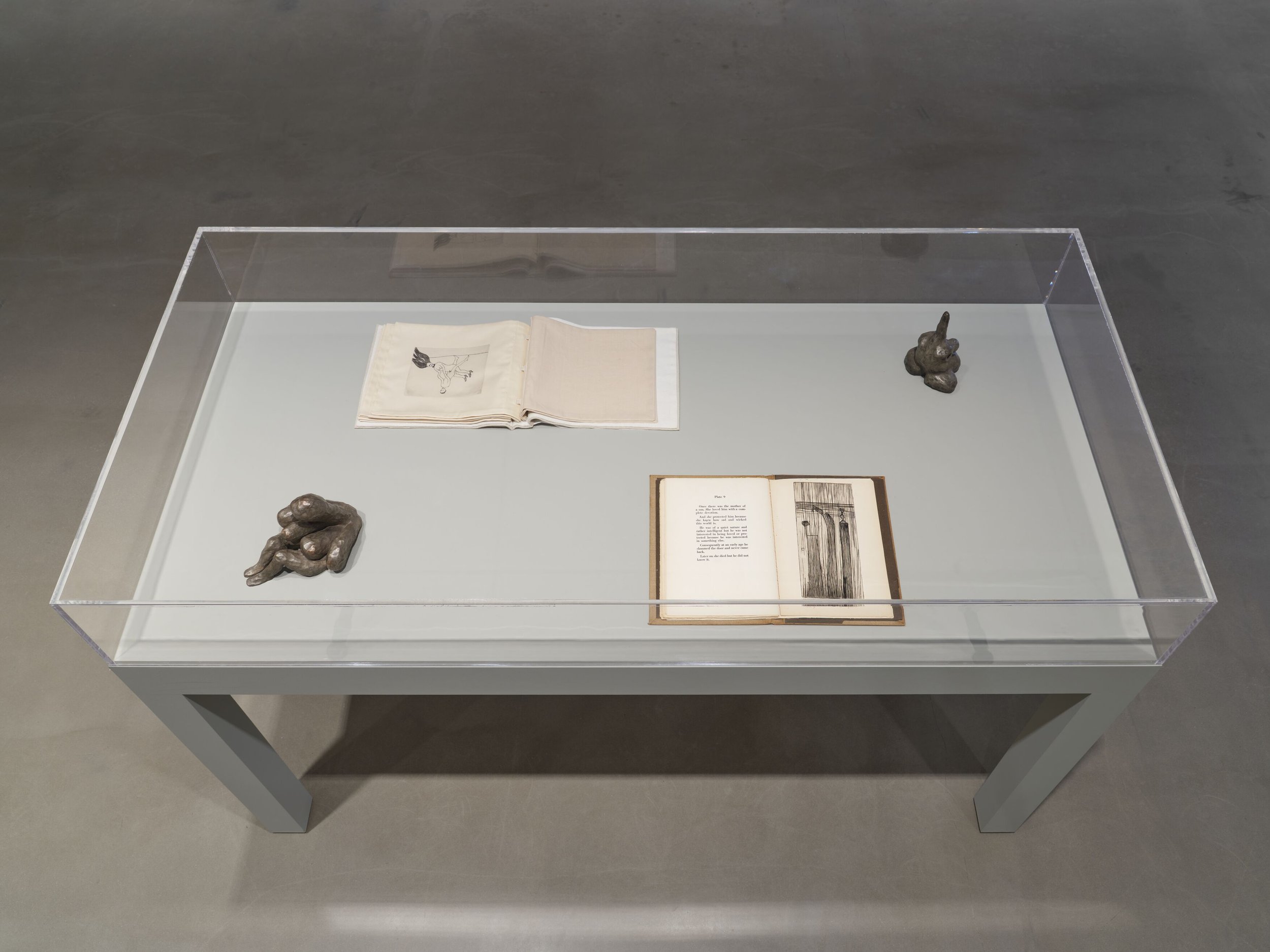
Installation view,‘Louise Bourgeois. Once there was a mother’ Hauser & Wirth New York 18th Street 8 September–23 December 2023 © The Easton Foundation / Licensed by VAGA at Artists Rights Society (ARS), NYPhoto: Thomas Barratt.
About the exhibition
‘Once there was a mother’ takes its title from Plate 9 of Bourgeois’s 1947 illustrated book ‘He Disappeared into Complete Silence,’ which pairs nine engravings with short texts she called parables. These stories and their accompanying images of isolated buildings convey a sense of loneliness, alienation and lack of communication. They also show Bourgeois’s fascination with the architecture of her adopted city, New York, where she lived and worked from 1938 until her death in 2010. In the parable which accompanies Plate 9, a son ultimately rejects his devoted mother despite her best efforts to protect him. Bourgeois wrote this in the mid-1940s, while raising three young sons.
Most of the printed works in the exhibition were made during the last decade of Bourgeois’s life, when images of maternity––pregnancy, childbirth and breastfeeding––came to the fore. Although already in her nineties at the time of their creation, the prints reveal Bourgeois to be exceptionally active and innovative, experimenting with a variety of techniques, adding hand-applied details, and printing on the old garments and household fabric she had saved throughout her long life. Like pages of a diary, this material evoked memories of people and events from Bourgeois’s past and was used extensively in her sculptural work as she increasingly identified with her mother, a tapestry weaver and restorer. Her longtime intaglio printer, Felix Harlan, established a printing process in which the various fabrics could take as rich an impression as paper. During this period, Bourgeois also began working closely with noted New York publisher and gallerist Carolina Nitsch. With the help of Raylene Marasco at Dyenamix, Nistch encouraged Bourgeois to edition digital prints that were made unique by the addition of hand-applied dyes and inks, as well as collage elements.
The Passage 2007 Digital print on fabric with fabric collage Unique variant 129.5 x 96.5 x 5.1 cm / 51 x 38 x 2 in
Printmaking afforded Bourgeois the possibility of taking an image or theme and experimenting with it across different variations and permutations. ‘The Fragile’ (2007) is an edition of seven individual sets of thirty-six prints on fabric, each with distinct elements and hand-applied archival dyes. The work is an expression of Bourgeois’s feelings of physical and psychological frailty in her old age and her ensuing identification with the infant child.
The following year, Bourgeois made another edition of nine unique prints on fabric titled ‘The Good Mother’ (2008). Each print in the edition depicts a pregnant woman outlined in red with silver milk dribbling and puddling in various shapes from her left breast. According to Jerry Gorovoy, Bourgeois’s longtime assistant and president of her foundation, The Easton Foundation, the metallic elements are leftover drips of aluminum found on the foundry floor after the casting of one of Bourgeois’s sculptures.
Self Portrait (Detail) 2009 Drypoint, some with watercolor and ink additions, digital print, and embroidery on fabric 314.3 x 231.8 cm / 123 3/4 x 91 1/4 in
One of the exhibition’s only completely unique printed works is ‘Self Portrait’ (2009). Composed on an old bedspread embroidered with the initials ‘L.B.,’ this work was made a year before the artist’s death and depicts a 24-hour clock with hands positioned at the hours 19 and 11––which together form the year of Bourgeois’s birth. Twenty-four individual drypoint prints are collaged and stitched at every hour, with each print illustrating an important event from the artist’s life. The image at hour 24 resembles ‘Maman,’ the monumental spider Bourgeois saw as a symbol for her mother and as an analog for her own artistic practice.
About Louise Bourgeois Born in France in 1911 and working in America from 1938 until her death in 2010, Louise Bourgeois is recognized as one of the most important and influential artists of the past Century. For over seven decades, Bourgeois’s creative process was fueled by an introspective reality, often rooted in cathartic re-visitations of early childhood trauma and frank examinations of female sexuality. Articulated by recurrent motifs (including body parts, houses and spiders), personal symbolism and psychological release, the conceptual and stylistic complexity of Bourgeois’s oeuvre––employing a variety of genres, media and materials––plays upon the powers of association memory, fantasy and fear.
‘Once there was a mother’ opened to the public on the 8th of September and will remain on view through the 23rd of December 2023. For more information about the exhibition, please visit Hauser & Wirth’s site.
All images: Louise Bourgeois © The Easton Foundation / Licensed by VAGA at Artists Rights Society (ARS), NY Courtesy The Easton Foundation and Hauser & Wirth Photo: Christopher Burke
For more information about the exhibit, please visit Hauser & Wirth site. Also, follow the gallery on Instagram, Facebook, X and YouTube for more updates on this exhibit.
Exemplary Modern. Sophie Taeuber-Arp with Contemporary Artists
Sophie Taeuber-Arp in the planning office for the Aubette,Straßburg, France, 1927© Stiftung Arp e.V., Berlin/Rolandswerth / Artists RightsSociety (ARS), New YorkCourtesy Stiftung Arp e.V., Berlin/Rolandswerth and Hauser& WirthPhotographer unknown
New York…Beginning 6 September, Hauser & Wirth New York will present a special exhibition juxtaposing key works by pioneering early 20th-century Swiss modernist Sophie Taeuber-Arp (1889-1943) with works by three contemporary artists—Leonor Antunes, Ellen Lesperance and Nicolas Party. ‘Exemplary Modern. Sophie Taeuber- Arp with Contemporary Artists’ highlights the versatility and enduring legacy of the Swiss avant-garde master. Through the sculptures, works on paper, and textiles on view, the practices of Antunes, Lesperance, and Party resonate with that of Taeuber-Arp, underscoring the diversity and enduring influence of her radical interdisciplinary oeuvre.
Now recognized as a modern master and an exemplary figure in avant-garde art and design, Taeuber-Arp stands out as an important precursor to generations of artists working today. A polymath whose interests spanned a variety of mediums and disciplines, she embraced and balanced in a single practice the roles of painter, sculptor, architect, designer, and teacher and worked in the fields of textiles, costume, fashion, furniture, theatre-staging, interior design, puppetry, performance, and dance. A pioneer of both figuration and abstraction, Taeuber-Arp was a member of the Dada movement and found common cause with the revolutionary interdisciplinarity of the Wiener Werkstätte, the influential Viennese workshop dedicated to modernist design. The exhibition at Hauser & Wirth features examples by Taeuber-Arp that foreground her varied interests and inventive use of materials. Different series of compositions on paper typify her meticulous attention to the interplay of geometry and color, a formal concern that informed much of her practice. Sketches of scenographies showcase the artist’s mastery in designing theatrical space, while a beadwork purse on view encapsulates her brilliance in dissolving the line between applied and fine art.
By situating such objects in conversation with new and recent works by Antunes, Lesperance and Party, the exhibition reveals ways in which Taeuber-Arp’s multifaceted career and exceptional versatility continue to generate ripples across art today.
Three contemporary artists
ANTUNES LEONOR Portrait of Leonor Antunes, 2018© Leonor AntunesCourtesy Hauser & Wirth, Marian Goodman and Kurimanzutto Photo: Nick Ash
Leonor Antunes (b.1972, Lisbon, Portugal, lives and works in Berlin and Lisbon) makes complex, architecturally scaled sculptural environments that are modular in their composition. These comprise sculpturally rendered furniture, frames or screens, lighting, hanging elements and reliefs, and often include abstract floors. In her work, Antunes has pursued an archival- and research-based practice, through which she seeks to investigate and ‘recuperate’ overlooked modernists and, especially, pioneering female artists, architects and designers. She highlights those who for many years have been depreciated by or simply left out of the traditional histories of modernism, including Annie Albers, Lina Bo Bardi, Lygia Clark, Eileen Grey, Gego, Eva Hesse, Mary Martin, Charlotte Perriand, Clara Porset and Mira Schendel, among others, constituting an alternative modernist pantheon into which Sophie Taeuber-Arp can be situated as a peer and leading light.
Antunes works in a way that is complementary to Taeuber-Arp by drawing on a wide range of disciplines and sometimes unconventional materials. That Antunes’s sensitivity and intelligence in her use of materials deliberately sets aside the traditional hierarchies placed upon media or disciplines, and consciously embraces techniques associated with craft, brings her work into vivid alignment with that of Taeuber-Arp.
The works Antunes has made for the exhibition at Hauser & Wirth are in close dialogue with Taeuber-Arp’s art, architecture and design, as well as their scale and materials, and will constitute a series of related sculptures composed into an overall ensemble. Antunes is particularly interested in Taeuber-Arp’s use of beadwork, furniture design and architectural work.
LESPERANCE ELLEN-Portrait of EllenLesperance, 2019© Ellen LesperanceCourtesy Hauser & Wirth and Derek Eller Gallery, New YorkPhoto: Rose Dickson
Artist and educator Ellen Lesperance (b.1971, Minneapolis MN, lives and works in Portland OR) makes work that revolves around feminist histories and textile aesthetics, celebrating feminist activism, peaceful protest and female creativity, and the links between them. Her archive- and research-driven practice explores imagery of women-led protest movements (particularly the 19-year-long Greenham Common Women’s Peace Camp) through the investigation of a range of source documents including photographs, videos and films and the recreation of the hand-crafted garments worn by female protestors depicted in them. These garments are translated by Lesperance into intricate, gridded works in gouache and pencil, executed on tea-dyed paper, evoking the matrices of textile patterns for knitting and weaving, specifically using a pattern-language called American Symbol Craft. Her reinterpretations of the original designs become schematic, two-dimensional renditions, with color reimagined from black and white or faded color photographs.
Lesperance’s sense of pattern and design also calls to mind the pattern and decoration movement (known also as the new decorativeness) of the mid-1970s to the early 1980s, to which art education was fundamental. Thus, the artist’s practice aligns with that of Taeuber-Arp with its dedication to balancing figurative and abstract design, and to teaching and writing (Taeuber-Arp taught at the Applied Arts Department of Zurich’s Trade School for 13 years and in 1922 published her text, ‘Remarks on Instruction in Ornamental Design’).Alongside her
Alongside her work on paper, Lesperance has made knitted garments and appliqué textile works, which she refers to as sculptures. A knitted sweater, with accompanying drawing, will be included as a unified, two-part work in the exhibition. These garment works have also been worn performatively or formed the core of socially oriented, collaborative pieces, which are shared by being passed along and worn by multiple participants. For ‘Exemplary Modern. Sophie Taeuber-Arp with Contemporary Artists,’ Lesperance has made a suite of seven new works on paper, including the two-part work.
PARTY NICOLAS Portrait of Nicolas Party© Nicolas PartyCourtesy the artist & Hauser & Wirth Photo: Richmond Lam
Nicolas Party (b.1980, Lausanne, Switzerland, lives and works in New York) is primarily a figurative painter who has attracted critical praise for his uncanny landscapes, portraits and still lifes, which simultaneously celebrate and challenge conventions of representation. Party works in soft pastel, an idiosyncratic choice of medium in the 21st Century and one that allows for exceptional degrees of intensity and fluidity in his images of the natural and the manmade. Transforming objects into abstracted, biomorphic shapes, he excavates deeper connections and meaning. Alongside his painting practice, he has also made sculptures and installations, engaging with ideas of theatrical space.
Underpinning Party’s work is a deep engagement with and knowledge of the history of art. As a Swiss-born artist, he has long admired the work of Sophie Taeuber-Arp, influenced by her immersive interior environments and a strong sense of color, design and form.
Nicolas Party Head 2018 Oil on coated polysterene 200 x 90 x 115 cm / 78 3/4 x 35 3/8 x 45 1/4 in © Nicolas Party Courtesy of the artist & Hauser & Wirth Photo: Thomas Barratt
For the exhibition at Hauser & Wirth, Party is presenting a group of ‘Head’ sculptures that have a direct relation to Taeuber-Arp’s own sculptures and puppets (‘poupées’). Party’s sculptural works can be linked to those of Taeuber-Arp through his use of simplified volumes, which are given greater detail via bright, polychromatic painted surfaces. Here, he shows a group of these sculptures in a range of scales—some as small as Taeuber-Arp’s puppets, some larger—installed upon similarly chromatic painted plinths. To render an immersive effect, Party’s ensemble will be set against a black and white photographic mural employing archival photographs of Taeuber-Arp’s stagings of her puppets—theater settings that have helped to inspire some of Party’s previous two-dimensional and mural works.
About Sophie Taeuber-Arp (1889 – 1943)
Born in Davos, Switzerland, in 1889, Sophie Taeuber-Arp was one of the most original artists of the 20th-century avant-garde and is considered a pioneer of both Dada and constructivist art. Reconciling extremes with confidence, and bridging Dada and geometric abstraction, fine art and utilitarian objects, Taeuber-Arp’s work boldly engaged the intellectual context of international modernism. Through an enthusiastically liberal approach to mediums, she challenged traditional hierarchies between fine and applied art, and asserted art’s urgent relevance to daily life. Taeuber-Arp defied categorization during her career through her work as a painter, sculptor, architect, performer, choreographer, teacher, writer and designer of textiles, stage sets and interiors. Sophie Taeuber-Arp began her studies at the School of Applied Arts in St. Gallen, Switzerland, between 1906 and 1910, studying textile design and embroidery. She later moved to the experimental workshops of Hermann Obrist and Wilhelm von Debschitz in Munich, Germany, where she learned a variety of techniques in fine and applied art and architecture, before spending a year studying weaving at the School of Arts and Crafts in Hamburg. The outbreak of World War I in 1914 forced Taeuber-Arp to return to Switzerland, where in 1915 she took lessons in Ausdruckstanz (expressive dance), with the choreographer Rudolf von Laban and the revolutionary dancer Mary Wigman. During a visit to the Galerie Tanner in Zurich in that same year, she met her future husband Hans Arp, whom she married in 1922.
Between 1916 and 1919, Taeuber-Arp was a key member of the Zurich Dada movement, performing in modern expressive dances at the Cabaret Voltaire and the Galerie Dada. From 1916–1929, Taeuber-Arp taught textile design at the Zurich School of Arts and Crafts. Her teaching methods in color theory and abstraction were informed by her own practice, which deliberately favored mediums and techniques that challenged accepted hierarchies, whether through her pioneering use of the grid, free-flowing geometric forms or abstracted figures. In these years, Taeuber-Arp produced collages, watercolors, textile works and stage sets, marionettes and tapestries, utilizing a unique interplay between color and form, which would later solidify her place as an early protagonist of constructivist art.
All images: Installation view, ‘Exemplary Modern. Sophie Taeuber-Arp with Contemporary Artists,’ Hauser & Wirth New York 69th Street September 6th to the 4th of November 2023 Courtesy Hauser & Wirth Photo: Thomas Barratt
The year 1926 was a turning point in Taeuber-Arp’s career: she was commissioned to design the interior of the Aubette Cultural Center in Strasbourg, a project upon which she invited Hans Arp and Theo van Doesburg to collaborate. Once completed in 1928, this groundbreaking design was the subject of an entire issue of van Doesburg’s journal, De Stijl.
The Aubette commission provided Taeuber-Arp and her husband economic freedom to move to Meudon, near Paris, where she designed their house and studio and some of its furniture. The move marked the beginning of the most productive period in Taeuber-Arp’s life. She joined various artistic collectives from Cercle et Carré to Abstraction-Création and the Swiss group Allianz, alongside fellow artists such as Georges Vantongerloo, Piet Mondrian and Max Bill, and founded and edited the radical art magazine Plastique. The house she shared with Arp in Meudon became a meeting place for artists, writers and other intellectuals, a circle of friends that included the artists Sonia and Robert Delaunay, Wassily Kandinsky, Joan Miró and Marcel Duchamp. Between 1929 and 1943, Taeuber-Arp exhibited in 40 exhibitions across the globe. Taeuber-Arp and her husband fled to Southern France when the Nazis invaded Paris in 1940, subsequently crossing over to Zurich in late 1942. The following year, she died tragically and prematurely from accidental carbon monoxide poisoning.
About the curator
The exhibition is organized by Tanya Barson. She was Chief Curator at the Museu d’Art Contemporani de Barcelona (MACBA), Barcelona (2016-21) and Curator of International Art, Tate Modern, London (2007-16), joining Tate originally in 1997. She has curated major exhibitions including Felix Gonzalez-Torres (2021), Gego (2019), Rosemarie Castoro (2017), Georgia O’Keeffe (2016), Mira Schendel (2013), Afro-Modern: Journeys Through the Black Atlantic (2010) and Frida Kahlo (2005), among many others. Since 2021, she has been a Senior Curatorial Director at Hauser & Wirth.
On view through 4 November, ‘Exemplary Modern. Sophie Taeuber-Arp with Contemporary Artists’ has been organized by Tanya Barson.For more information about the exhibit, please visit Hauser & Wirth site. Also, follow the gallery on Instagram, Facebook, X and YouTube for more updates on this exhibit.
Another Day’s Beautiful Chaos Features New York City as its Muse and Canvas
Photo Credit: Natalie Tirado
New York, NY - The artist duo known as Another Day turn garbage cans into gold, street signs into love letters, and park benches into beacons of light. This October, Another Day presents A Beautiful Chaos - their first solo exhibit, short film, and directorial debut.
Vicente Garcia Morillo and Eugene Serebrennikov, the artists behind Another Day studio have spent the last two years building a creative playground of self-expression inspired by their experiences navigating daily life in the city of juxtaposition. New York City is both the muse and the canvas. Another Day’s work incorporates street relics and objects often overlooked or discarded, transforming them into meaningful works of art. The art duo are creating a visual love letter to the city, flaws and all across a multiple mediums, including a series of paintings, three-dimensional sculptures, and experimental creations.
“Our work captures the chaotic yet harmonious forces of daily life in New York City. The heart of the city and soul of the world is overflowing with both trash and treasure. It’s a constant reminder that beauty is everywhere, if you open your mind to it.” - Eugene Serebrennikov and Vicente Garcia Morillo AD:BC, The Short-Film, their first directorial debut, intertwines live-action film-making, 3D clay animation, 2D illustration, and physical, artistic creations into experimental visual narratives.



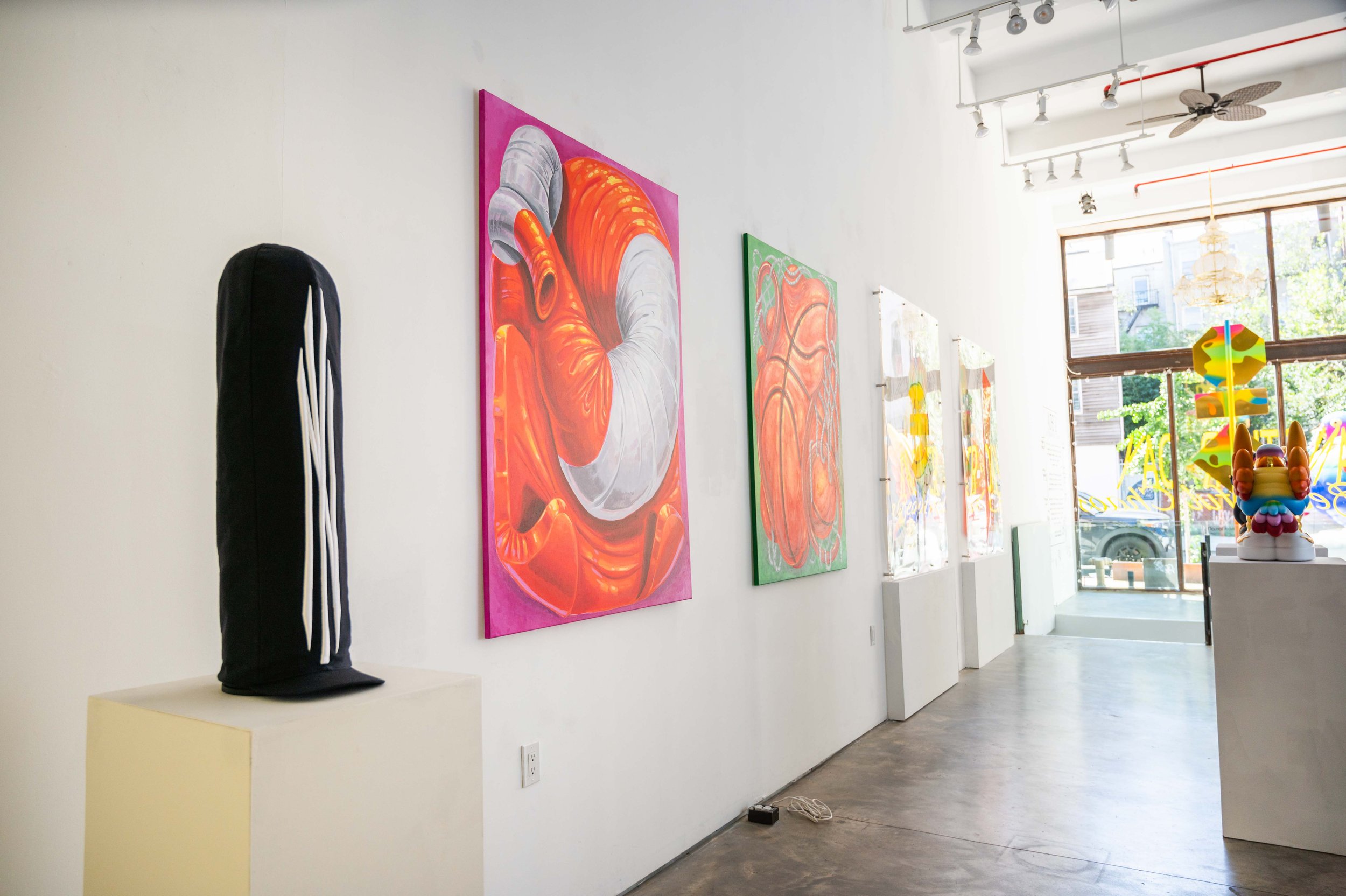
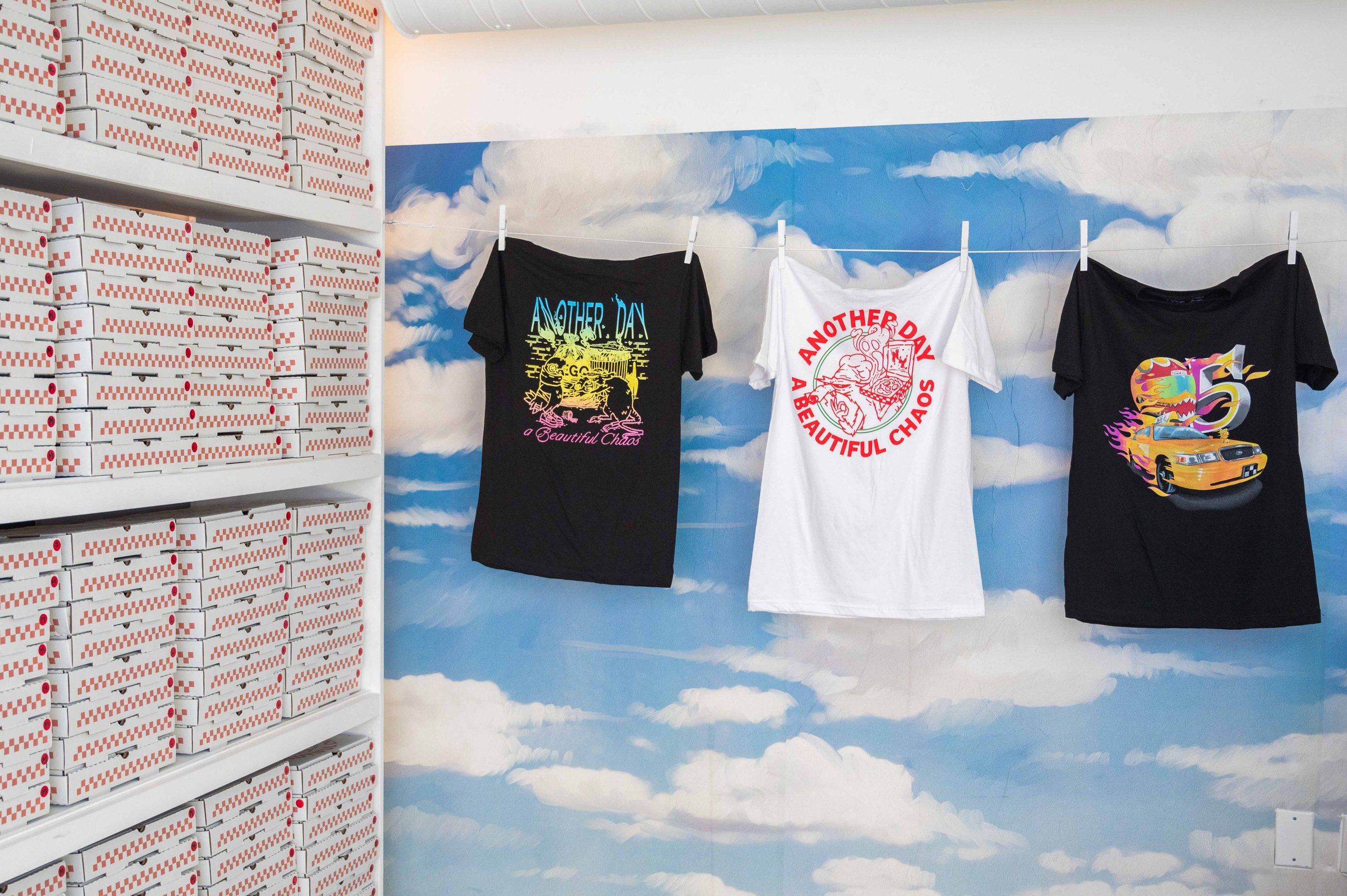
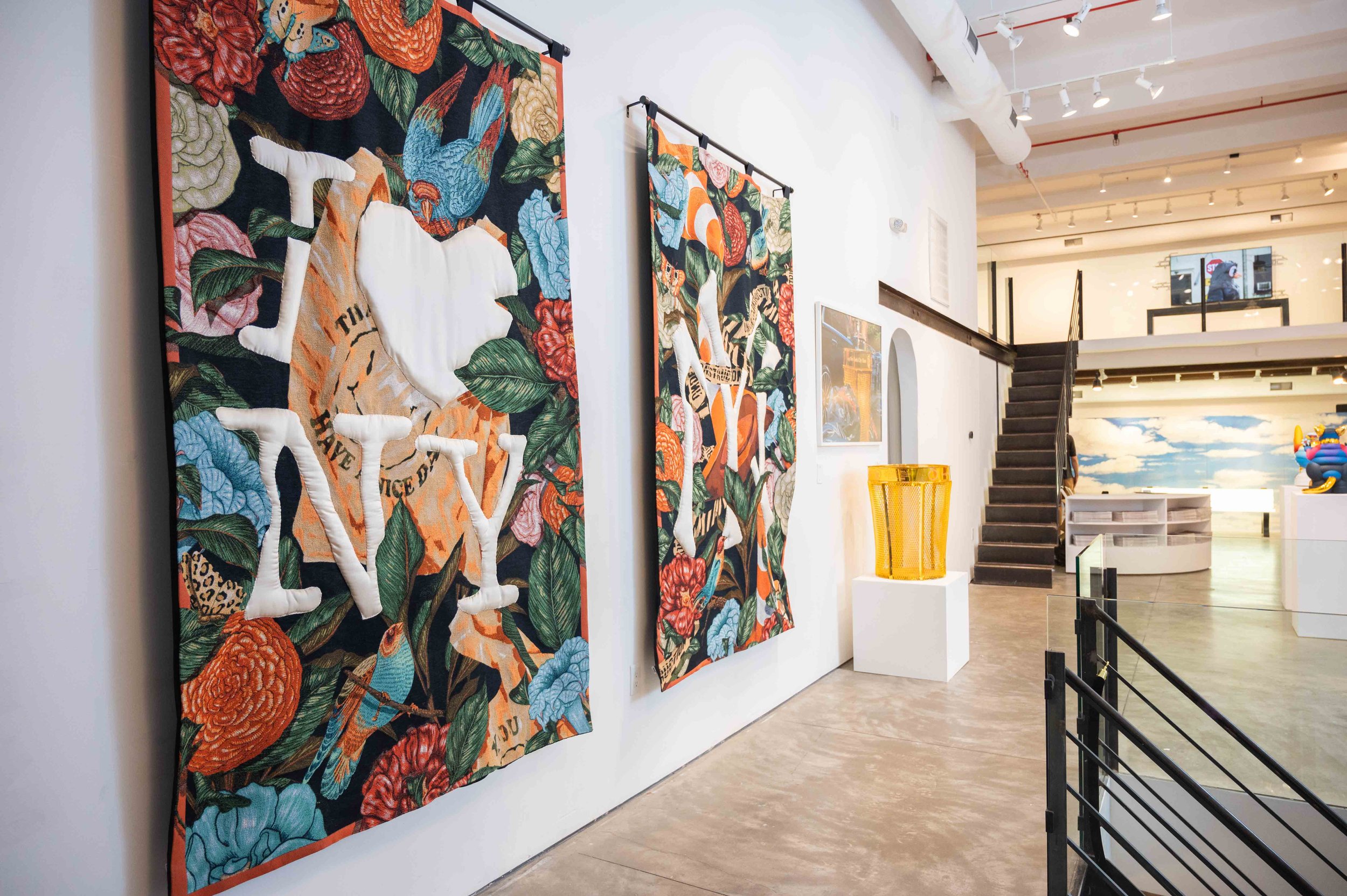


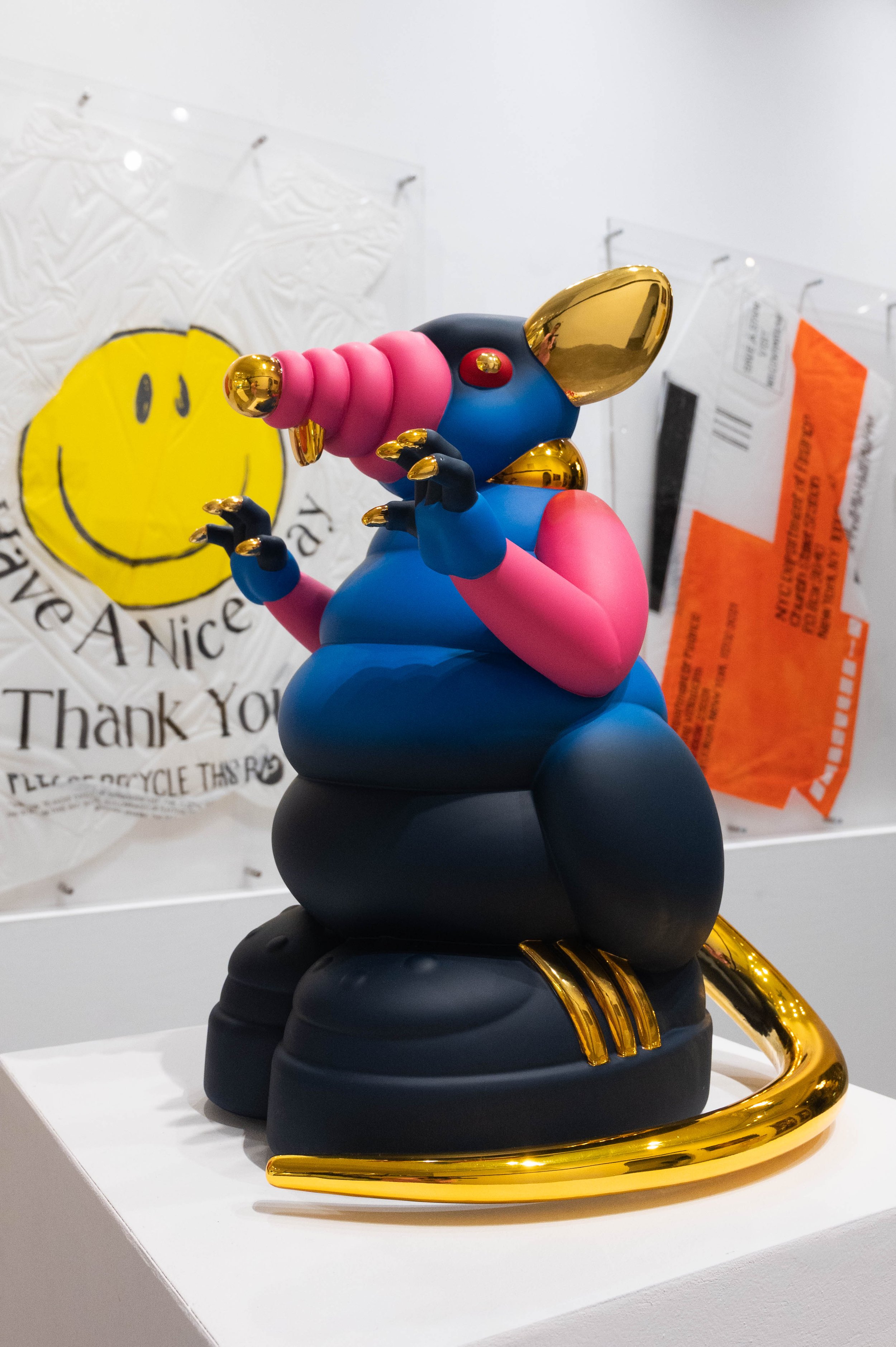
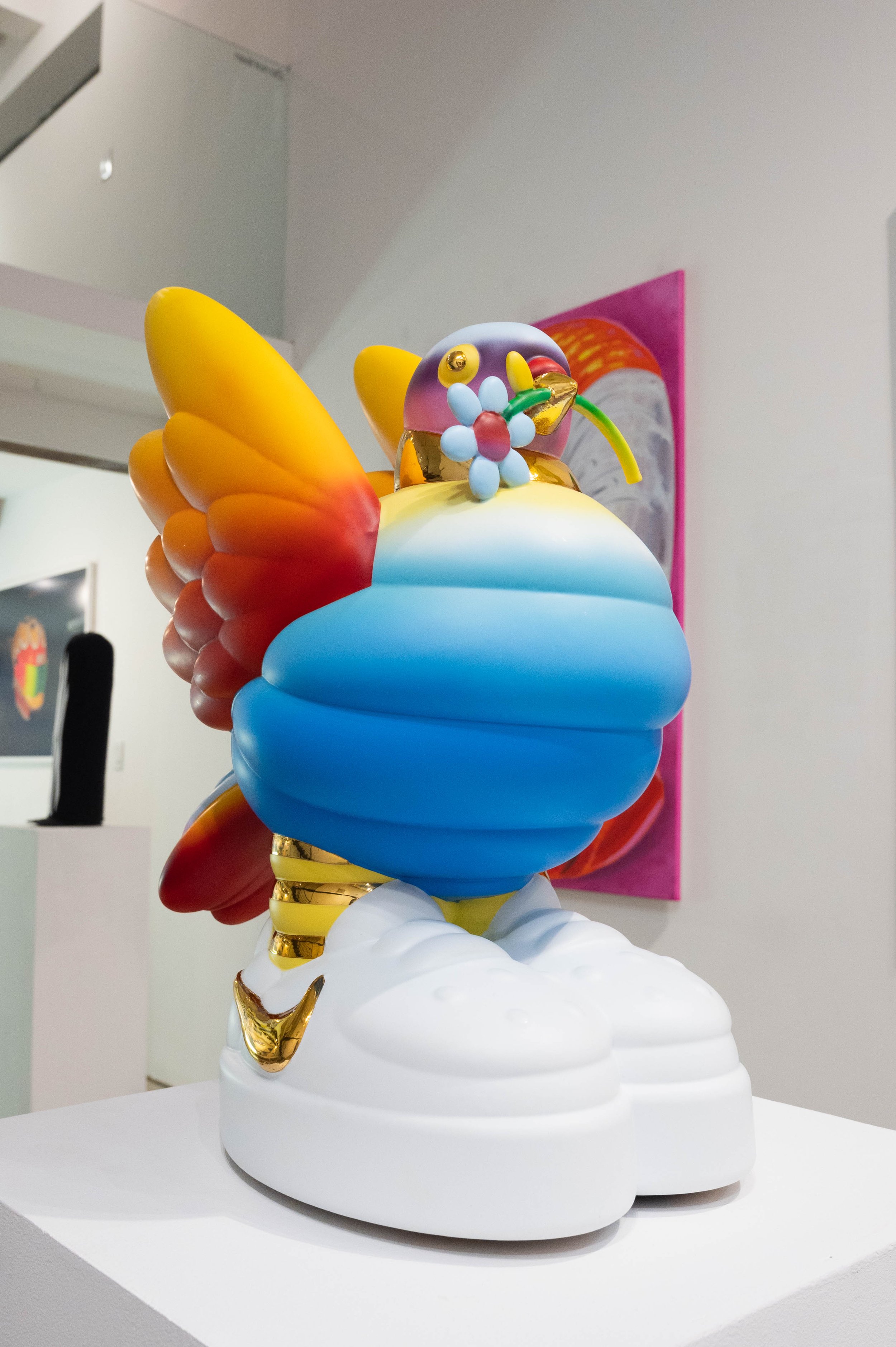
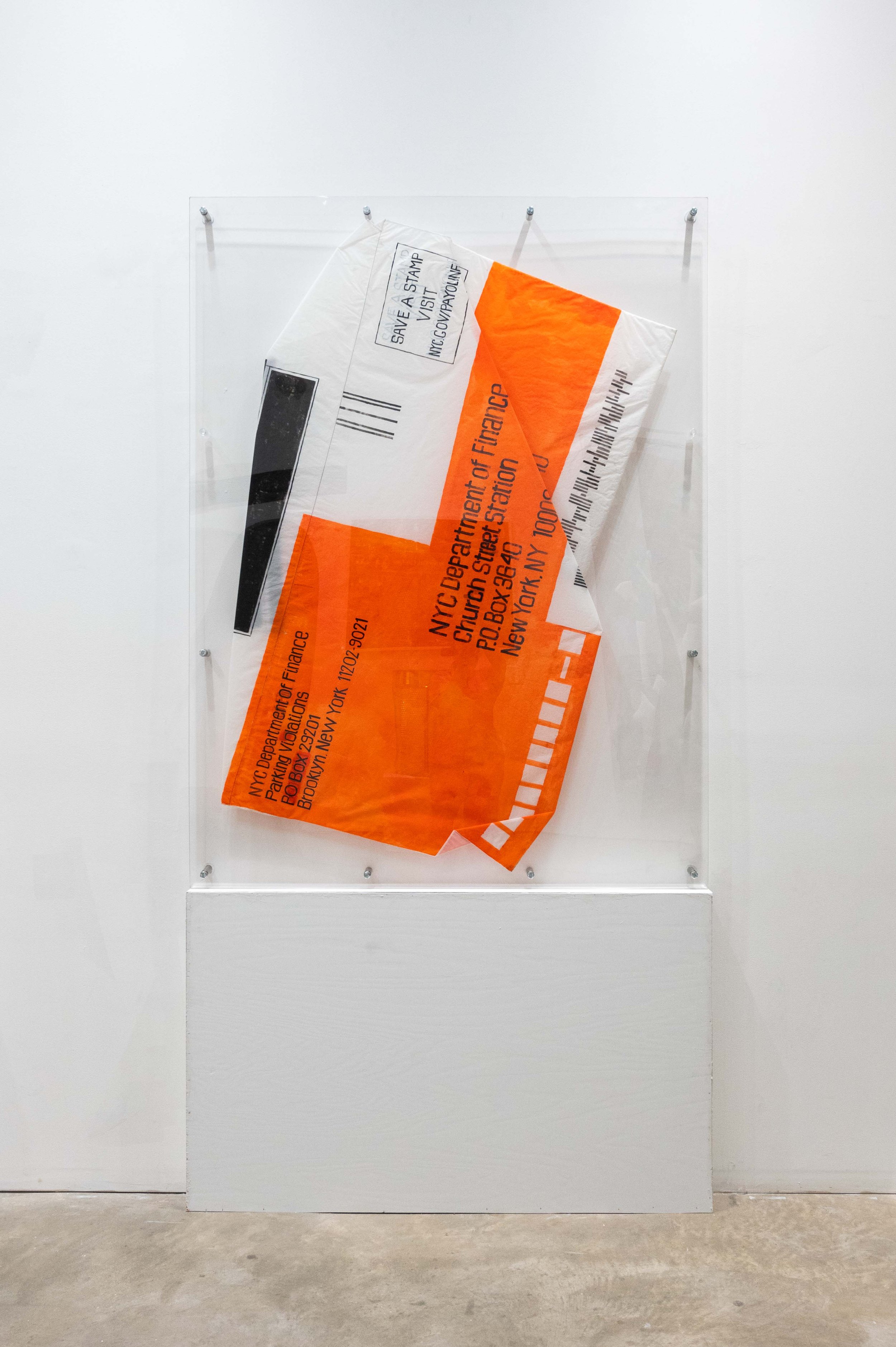
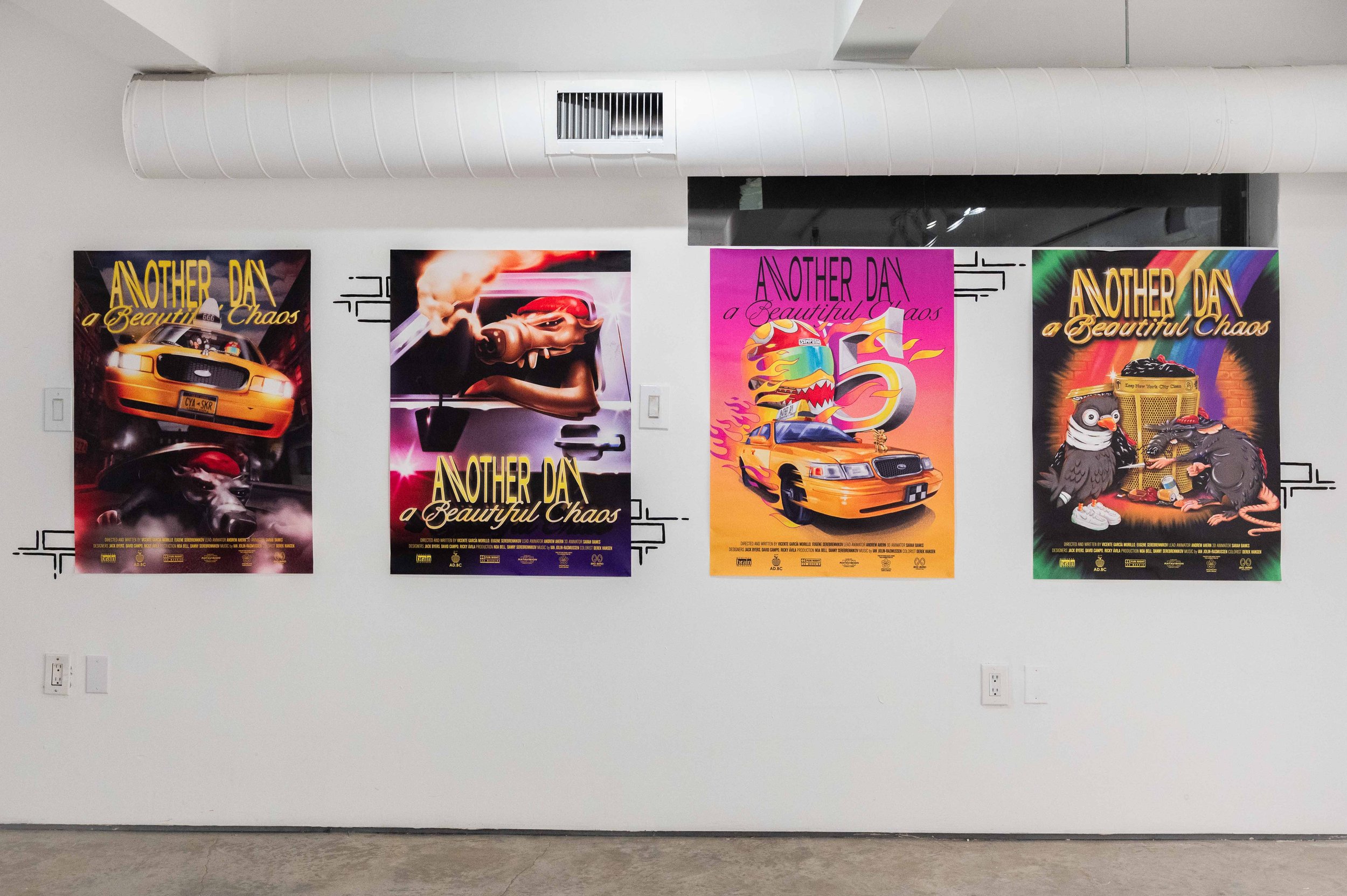

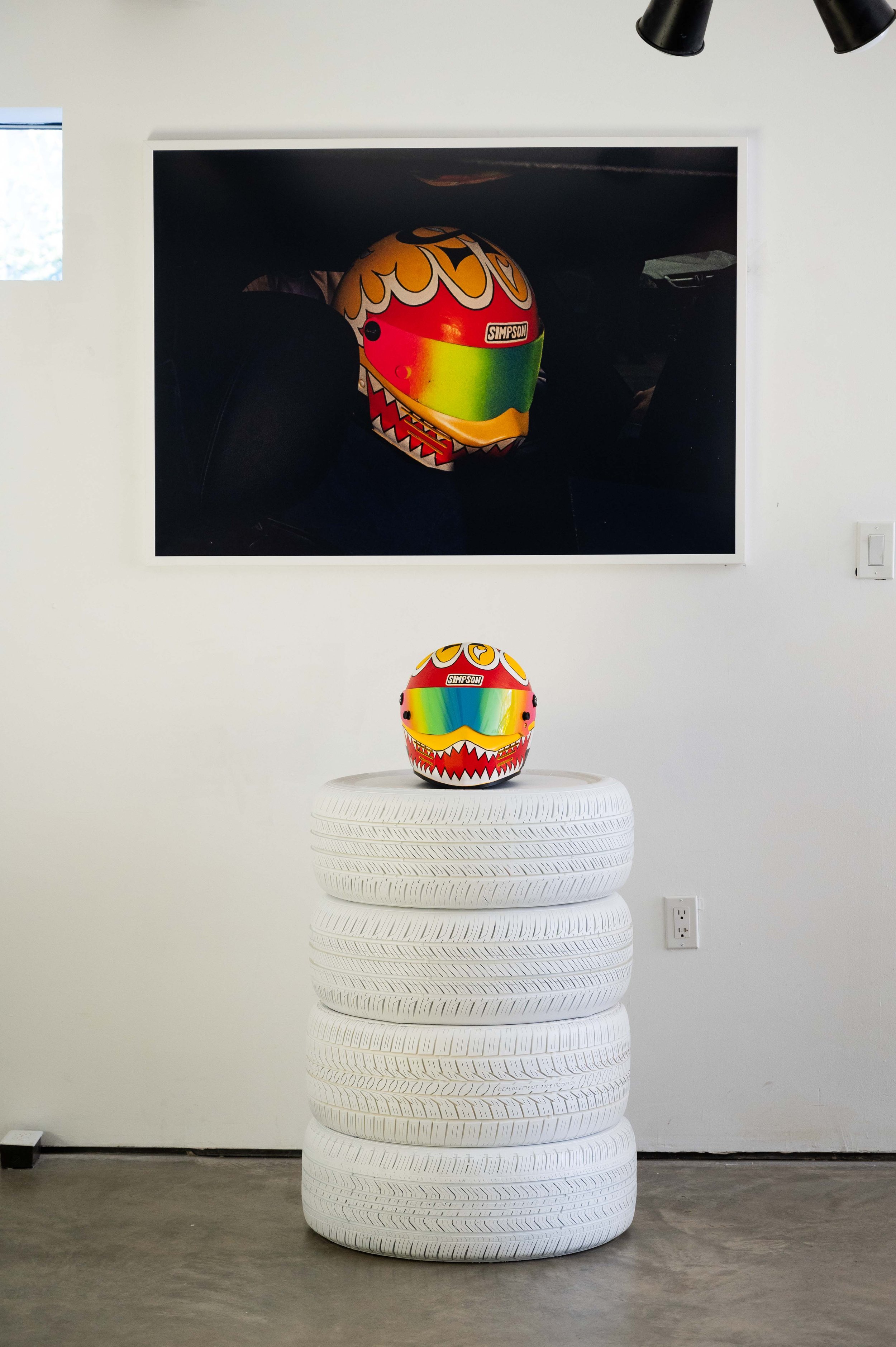

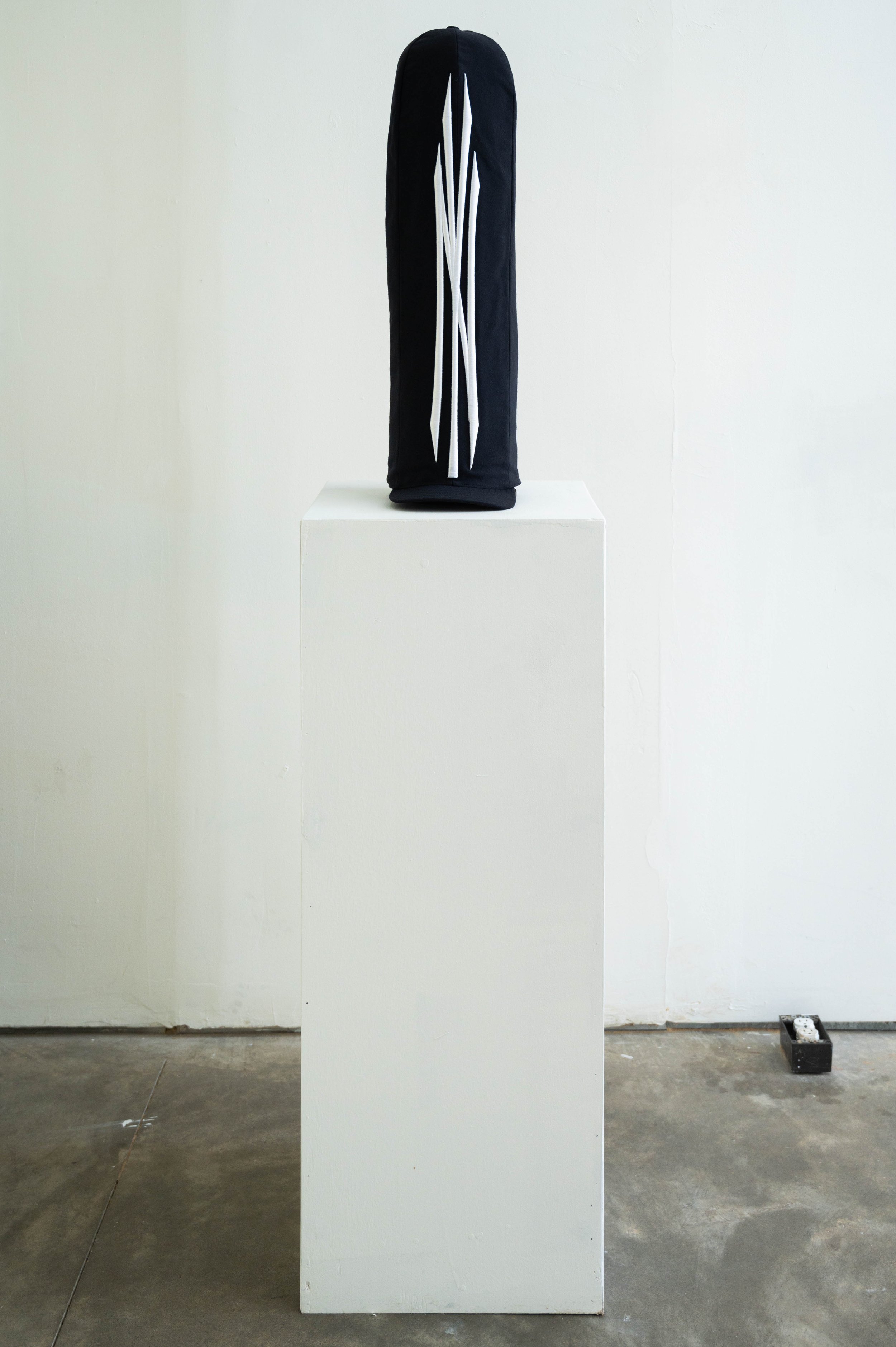
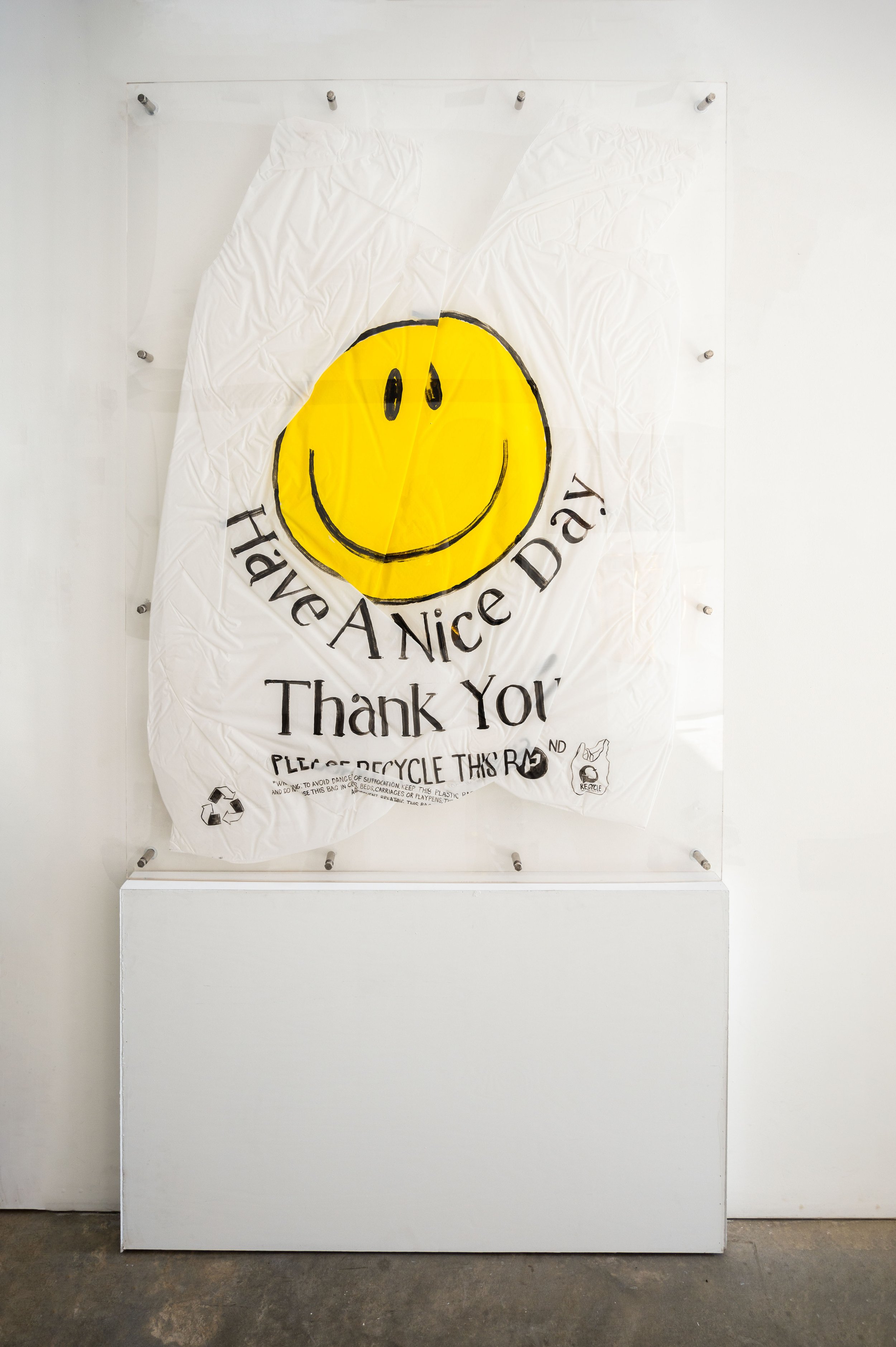

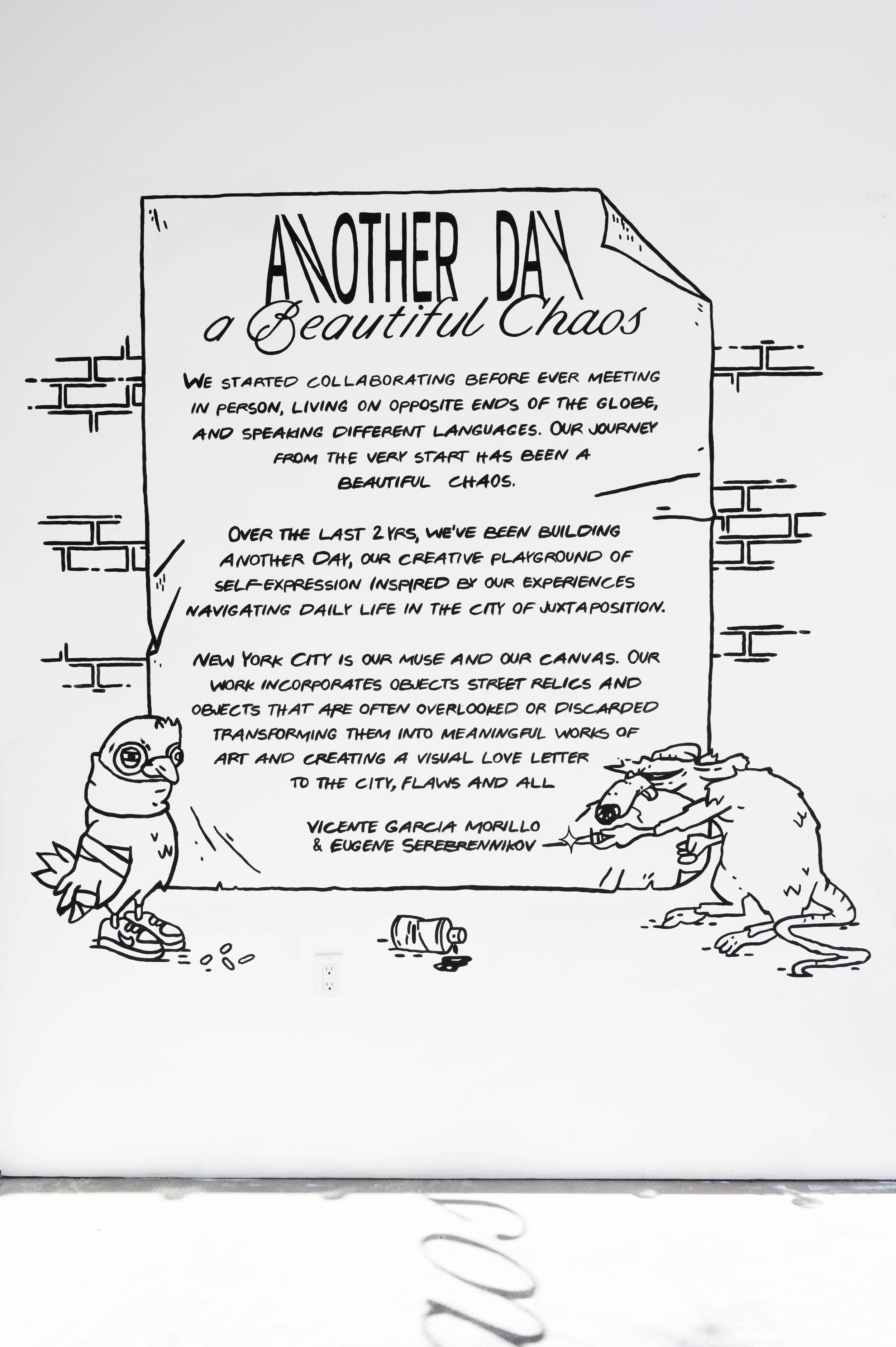
Photo Credit: Natalie Tirado
The multifaceted artistic approach blends the digital and the physical. The film delves into the misadventures of a pigeon, who unwittingly ingests a psychedelic substance from the ground and embarks on a strange magical journey through the streets of New York City. Along the way, he encounters a series of mishaps, including an irate local Rat. Amidst the chaos, the city’s beauty is revealed.
Exhibition Details:
designers collab
119 N 1st Street
Brooklyn, NY 11249
The exhibition will close on the 27th of October. The gallery hours are | MON-SAT 11-7 pm | SUN 12-7 pm.
Photo Credit: Jacob Consenstien
ABOUT ANOTHER DAY:
Another Day is a New York-based art studio founded by Vicente Garcia Morillo and Eugene Serebrennikov. The artists began their creative partnership a decade ago, despite living on opposite ends of the globe and speaking different languages. Morillo, an award-winning artist and valedictorian from the Fine Arts University of Seville, caught the eye of Serebrennikov, a former Nike Art Director, who found his work online. The duo quit the safety net of their corporate jobs to form Burn & Broad, a creative studio focused on creating impactful designs for clients, and Another Day, the creative playground, focused on the duo's artistic self-expression. Morillo and Serebrennikov's artistic works span various mediums, including sculptures, paintings, and experimental creations. Their first solo exhibition and short film, Another Day: A Beautiful Chaos - is a visual exploration of balance in the city of juxtaposition - New York, New York. While the city is their muse, Morillo and Serebrennikov's personal experiences equally influence their work.
ARTIST STATEMENT: We started collaborating before ever meeting in person, living on opposite ends of the globe, and speaking different languages. Our journey from the very start has been a beautiful chaos. Over the last two years, we’ve been building Another Day, our creative playground of self-expression inspired by our experiences navigating daily life in the city of juxtaposition. New York City is our muse and our canvas. Our work incorporates street relics and objects often overlooked or discarded, transforming them into meaningful works of art and creating a visual love letter to the city, flaws, and all. The art spans multiple mediums, including sculptures, paintings, film-making, and experimental creations.
For further information about Another Day, please get in touch with them here.
Richard T. Walker NEVER HERE / ALWAYS THERE
this, as it isn’t (mountain #2), 2022 two pigment prints in artist's frames, modified rock © Richard T. Walker, courtesy Fraenkel Gallery, San Francisco
Fraenkel Gallery is pleased to present NEVER HERE / ALWAYS THERE, an exhibition by artist Richard T. Walker. Incorporating photography, video, music, sculpture, and performance, the artist continues his exploration of the relationship between the individual and the changing natural world. In twelve new works, Walker reorders the elements of the environment, upending assumptions about humankind’s place in nature by embracing futile connections to the vast landscape. This will be the Bay Area-based British artist’s second solo show in the gallery’s 49 Geary space, following exhibitions at FraenkelLAB in 2016 and 2017. A public reception with the artist took place on Saturday, September 9, from 1:30–4 pm.
anywhere, somewhere (multiple), 2023 single channel video © Richard T. Walker, courtesy Fraenkel Gallery, San Francisco
what we were (as we are) comprises six photographs of trees made in California during the intense 2020 fire season, when smoke tinted the sky an eerie orange color. A speaker embedded in each photograph plays guitar recordings Walker made at the location, in an arrangement that draws inspiration from the towering banks of speakers in the sound systems of the UK’s Notting Hill carnival celebrations. Together, the music builds into a fractured chorus. The piece acknowledges the feelings of anxiety and loss that the landscape evokes in the era of climate change. Walker notes that when photographing the work, “I had an undeniable sense that the California I felt so connected to and quite frankly in love with—the California that had seduced me with its mythical and mystical appeal, with its drama and undeniable beauty and with its perfect balance of invitation and rejection—was being put into question. It felt like it perhaps no longer existed.”
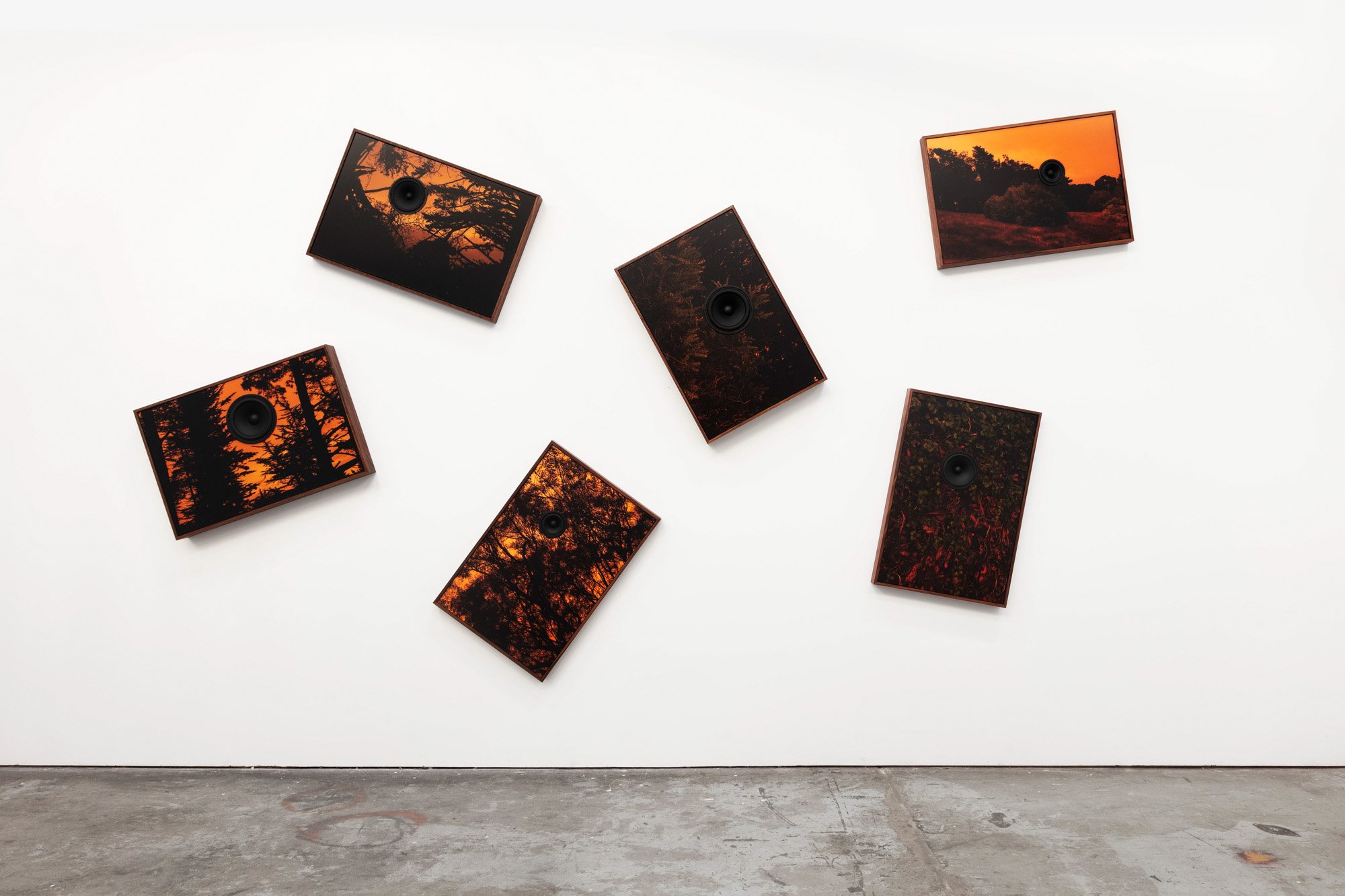

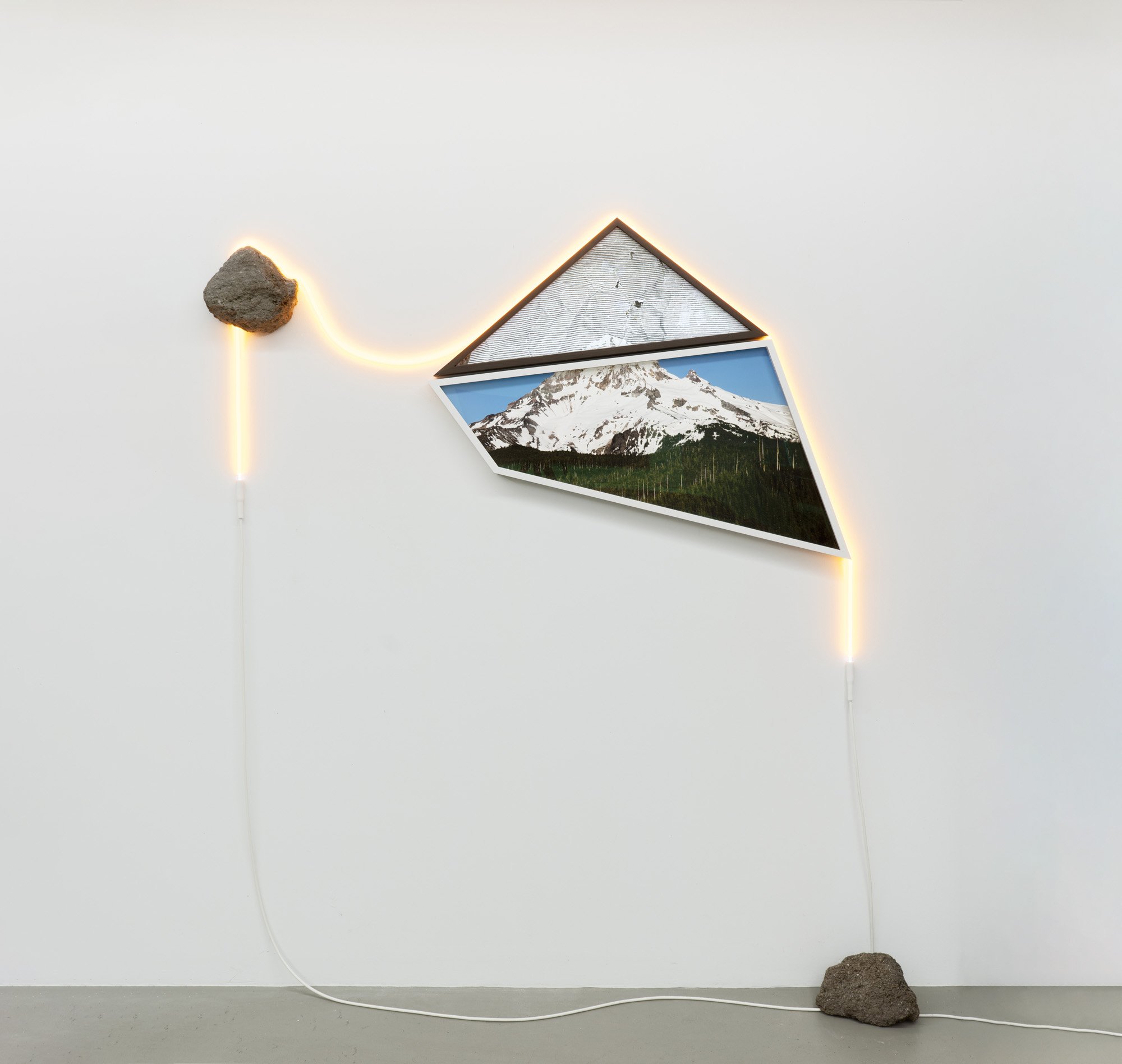

In many of the works on view, Walker combines his photographs of the Western American landscape with 19th-century etchings, found rocks, or guitar recordings, in playful or melancholic arrangements of nature and the human response to it. In the series eternally almost, Walker’s photographs of a lone tree at Crater Lake in Oregon are paired with images of drawings made by the artist’s father showing branches collected at Mount Shasta, a few hundred miles away. Framed separately, the branches and trees align, suggesting a continuity between the forms that plays with different interpretations of the meaning of distance and connection. this, as it isn’t (mountain #2), a photographic diptych, presents two versions of a nearly identical view of a distant, ancient volcano. One features a large rock in the foreground; in the other, the rock is missing from the photograph but has transformed, appearing now as a stone that sits outside of the frame, standing in for the mountain top and toying with notions of distance, scale, and cause and effect.
In other works, Walker employs light or sound in his interaction with the landscape. In a singlechannel video, anywhere, somewhere (multiple), driftwood thrown by an unseen hand hits or misses a drum kit set on a beach, creating human-made noises that mix with the sound of the waves. Elsewhere, Walker continues his long-running use of neon, draping it over a wall-mounted rock and frame in the infinity of an intimate distance, or curving it around a tree trunk in a nighttime lightbox triptych in still, missing you. Richard T. Walker’s artwork and performances have been included in solo and group exhibitions at the San Francisco Museum of Modern Art; Yerba Buena Center for the Arts, San Francisco; The Contemporary Austin; Times Museum, Guangzhou, China; Museum of Modern Art, Rio de Janeiro; Hiroshima City Museum of Contemporary Art; and Witte De With Center for Contemporary Art in Rotterdam, among other venues. His work is held in the collections of the San Francisco Museum of Modern Art; Kadist Foundation, San Francisco and Paris; and Kunstsammlung Nordrhein-Westfalen (K21), Dusseldorf, Ger(K21), Dusseldorf, Germany, among others. Walker has been an Irvine Fellow at the Montalvo Art Center, and a resident at The Headlands Center for the Arts and Skowhegan School of Painting and Sculpture. He received an Artadia Award in 2009.
The exhibit opened on September 7th of this year and will close on October 21st of this year. For more information about the exhibit please visit the Fraenkel Gallery’s site.
Nicolas Party. Swamp
Swamp 2023 Soft pastel on linen Left: 175.1 x 55 cm / 68 15/16 x 21 5/8 in Center: 175 x 110 cm / 68 7/8 x 43 5/16 in Right: 175.1 x 55 cm / 68 15/16 x 21 5/8 in
New York...For his first solo exhibition with Hauser & Wirth in New York City, Nicolas Party will transform the first floor of the gallery’s 22nd Street building. New oil-on-copper paintings, cabinet compositions, signature pastel paintings and two monumental site-specific murals will immerse visitors in Party’s practice, which simultaneously celebrates and challenges longstanding and cherished conventions of representational painting through his uniquely singular, subversive style.
Internationally admired for his uniquely adroit use of soft pastel, bold yet delicate, as a primary painting medium, Party created many of the works in this exhibition, including the striking site-specific murals, in pastel. He first began working in this medium over 10 years ago and has since become a master at exploiting the pigments’ versatility, immediacy and saturated color.
Upon entering the exhibition, visitors will encounter the first of two expansive pastel murals––a forest in flames. Party is known for conceiving his exhibitions as comprehensive environments, incorporating architectural interventions and extending the palette of his paintings across the gallery’s white walls. Heightening the powerful effects––formal and psychological––of his subject matter, Party has chosen to steep the surrounding walls in a rich maroon. Just beyond the pastel mural hangs a group of portraits featuring enigmatic figures paired with an animal that obscures their body. These creatures were inspired by the work of radical 19th-century French realist painter Rosa Bonheur, an icon of women’s independence who put the living world at the heart of both her life and work, placing animals at the center of her practice.
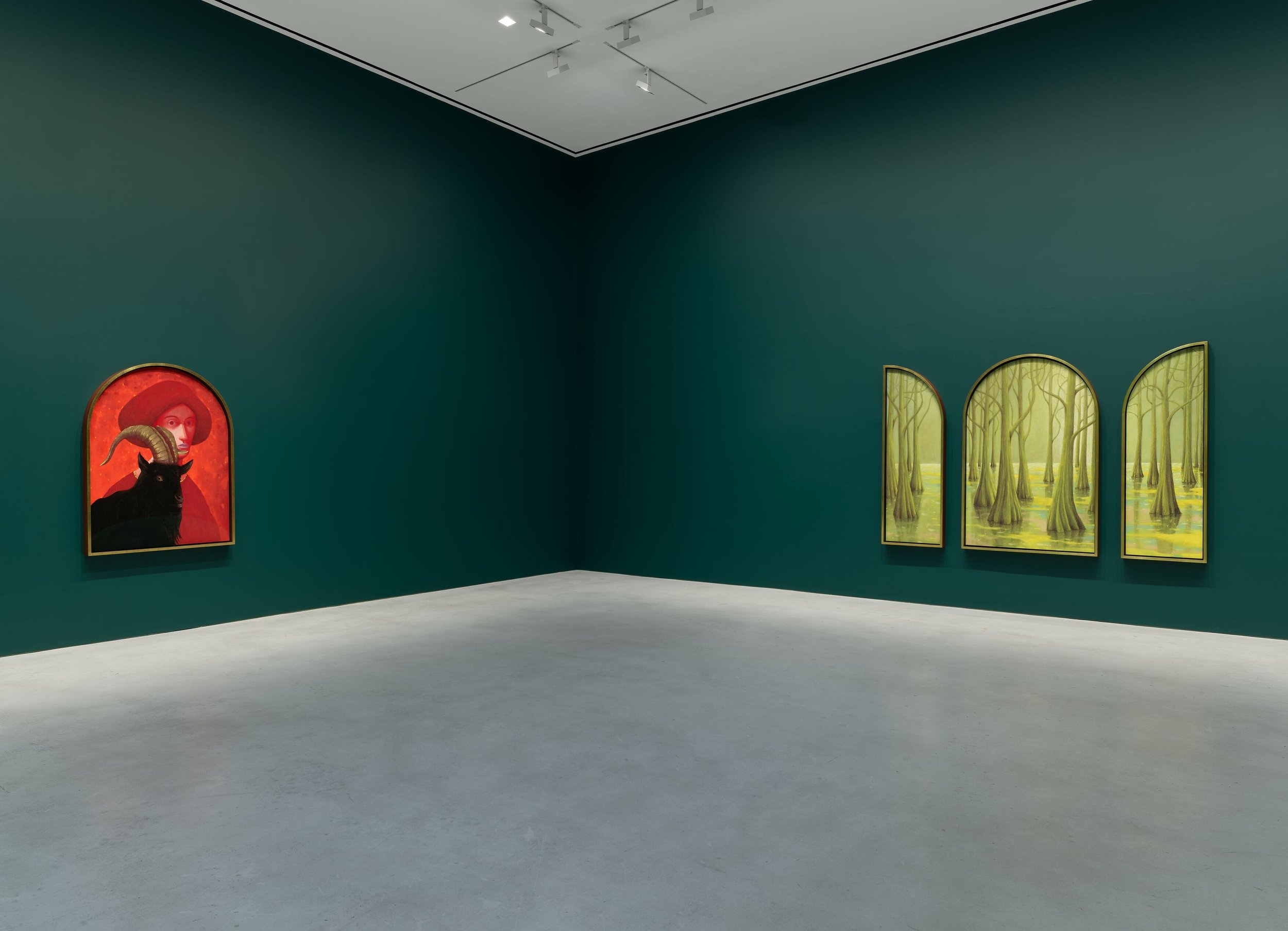
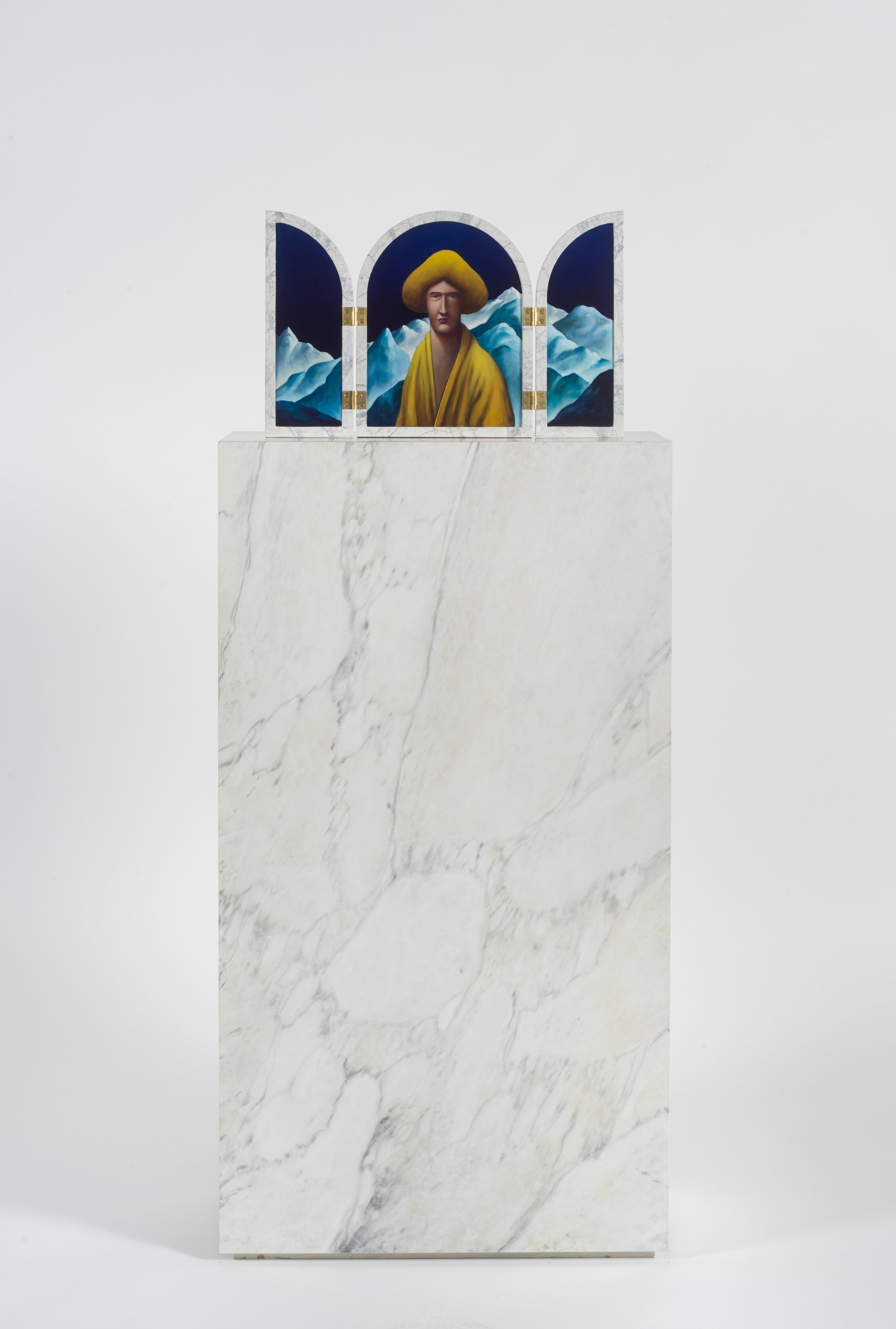
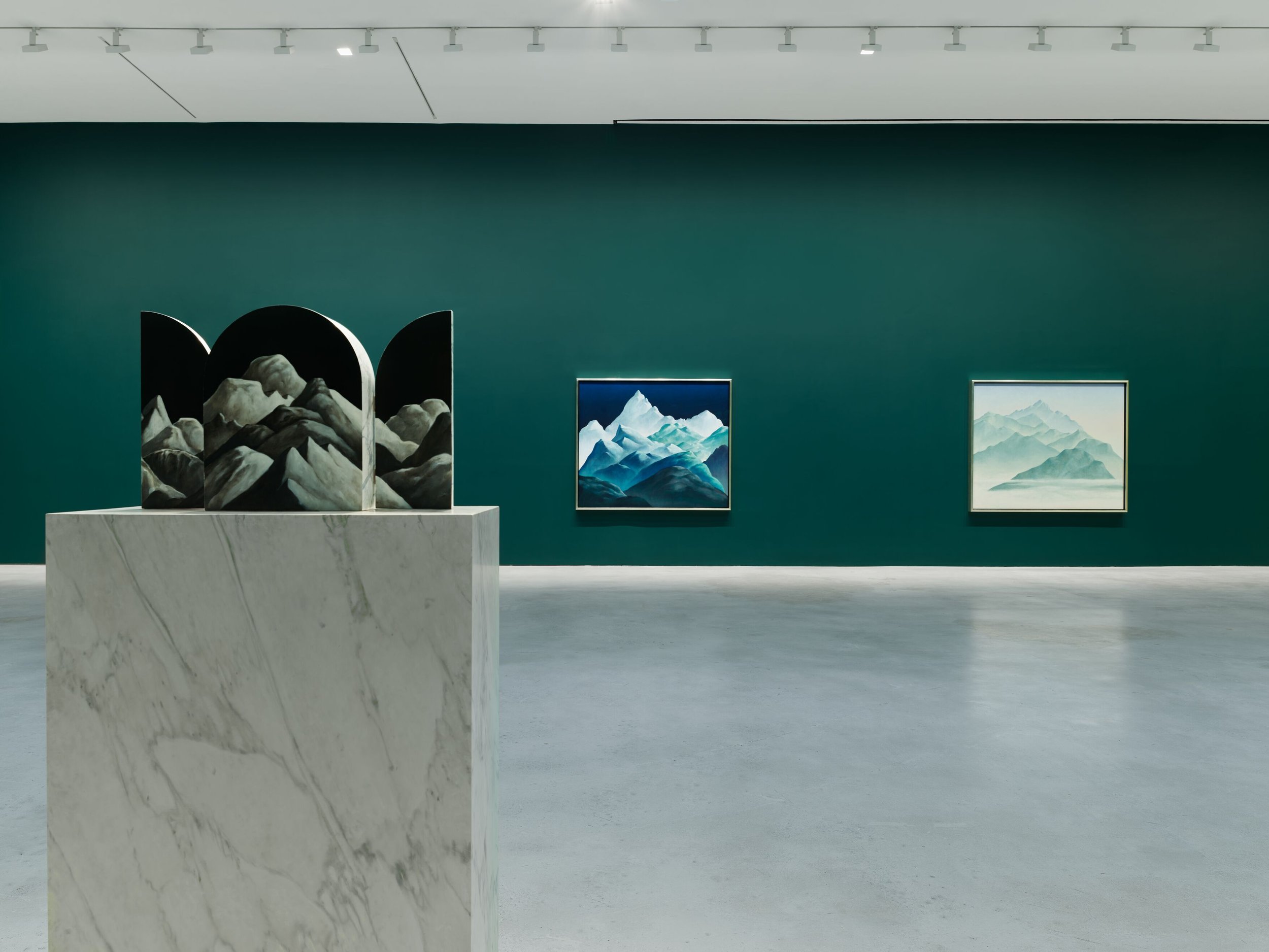
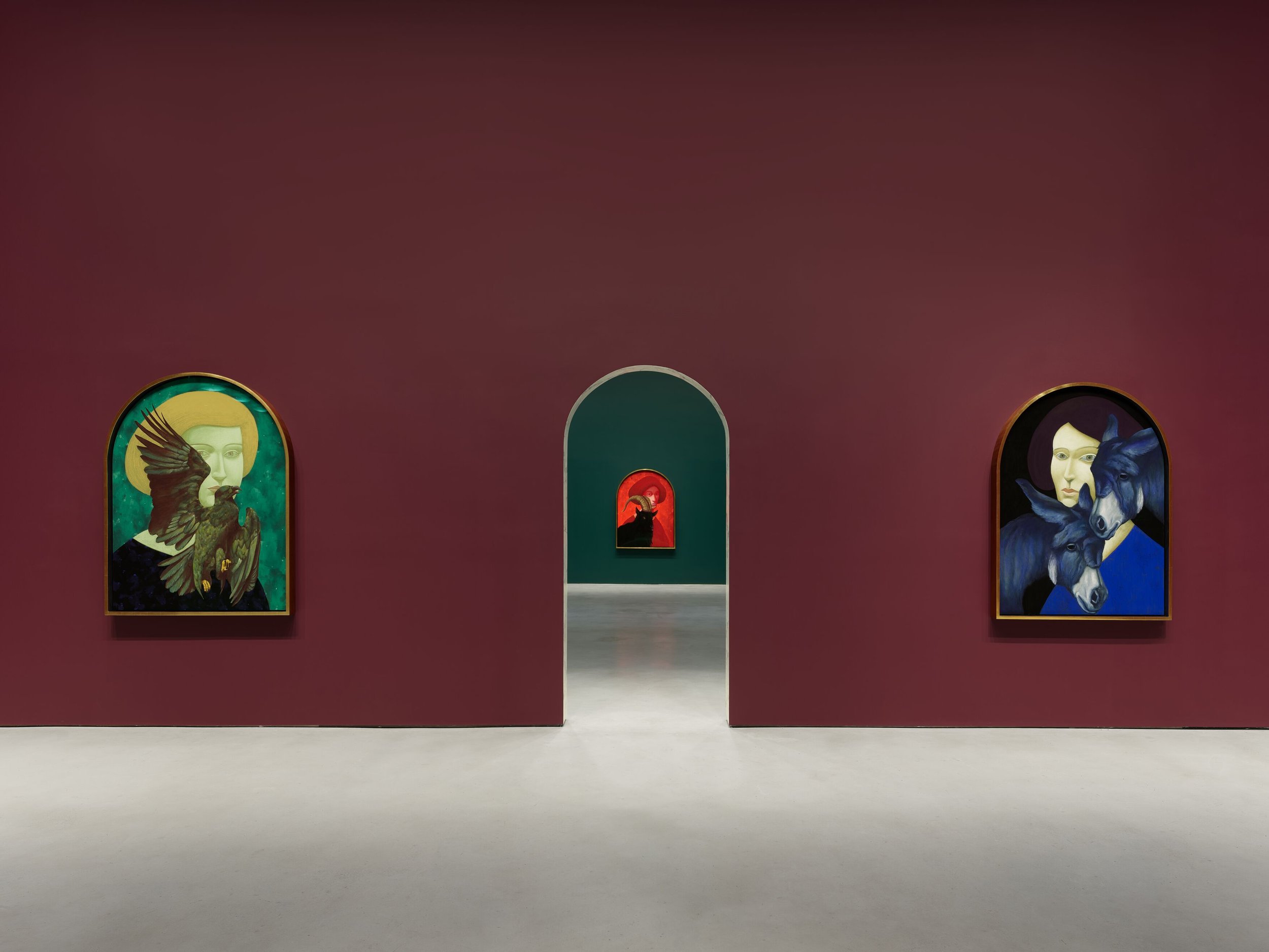
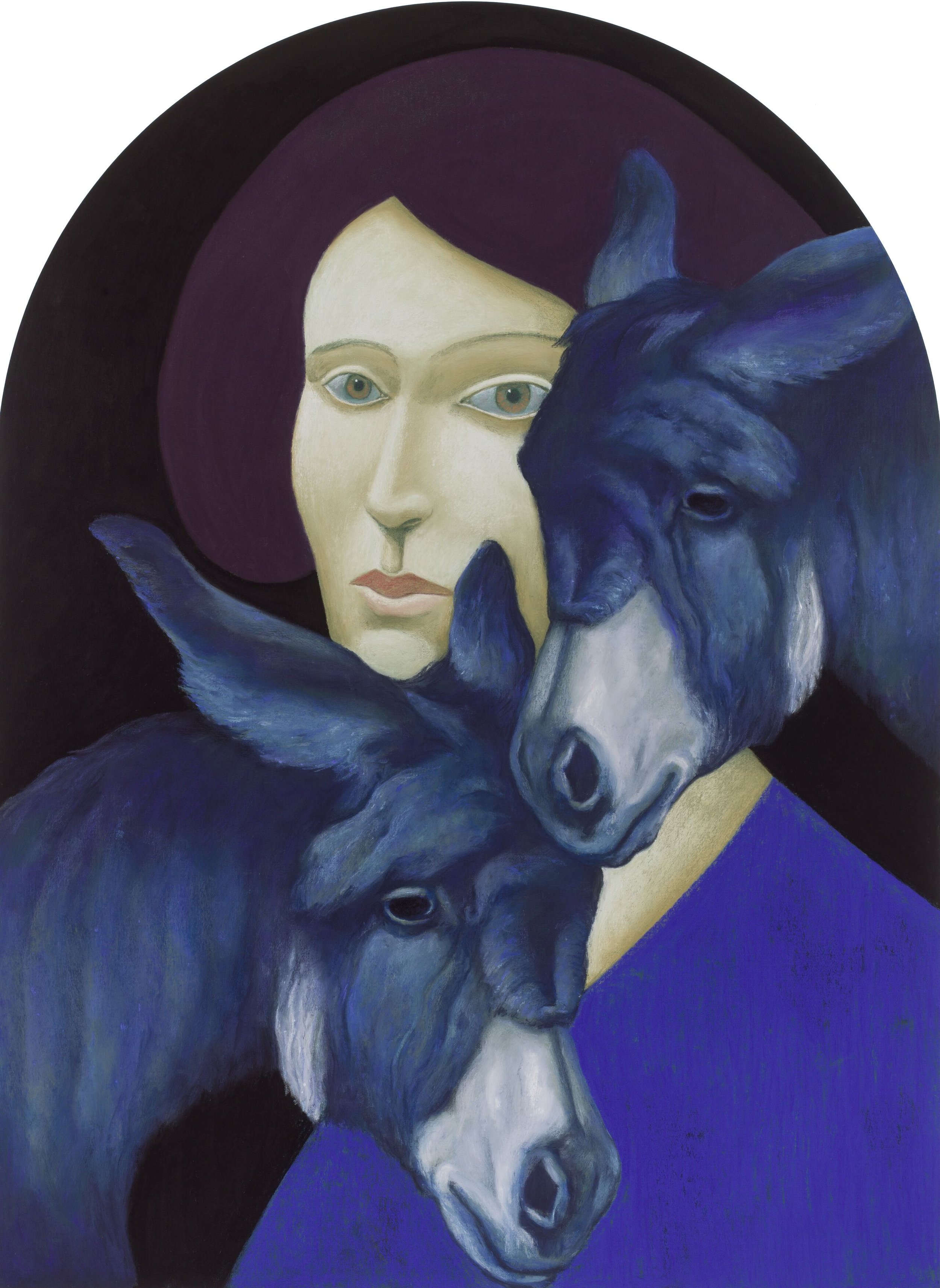
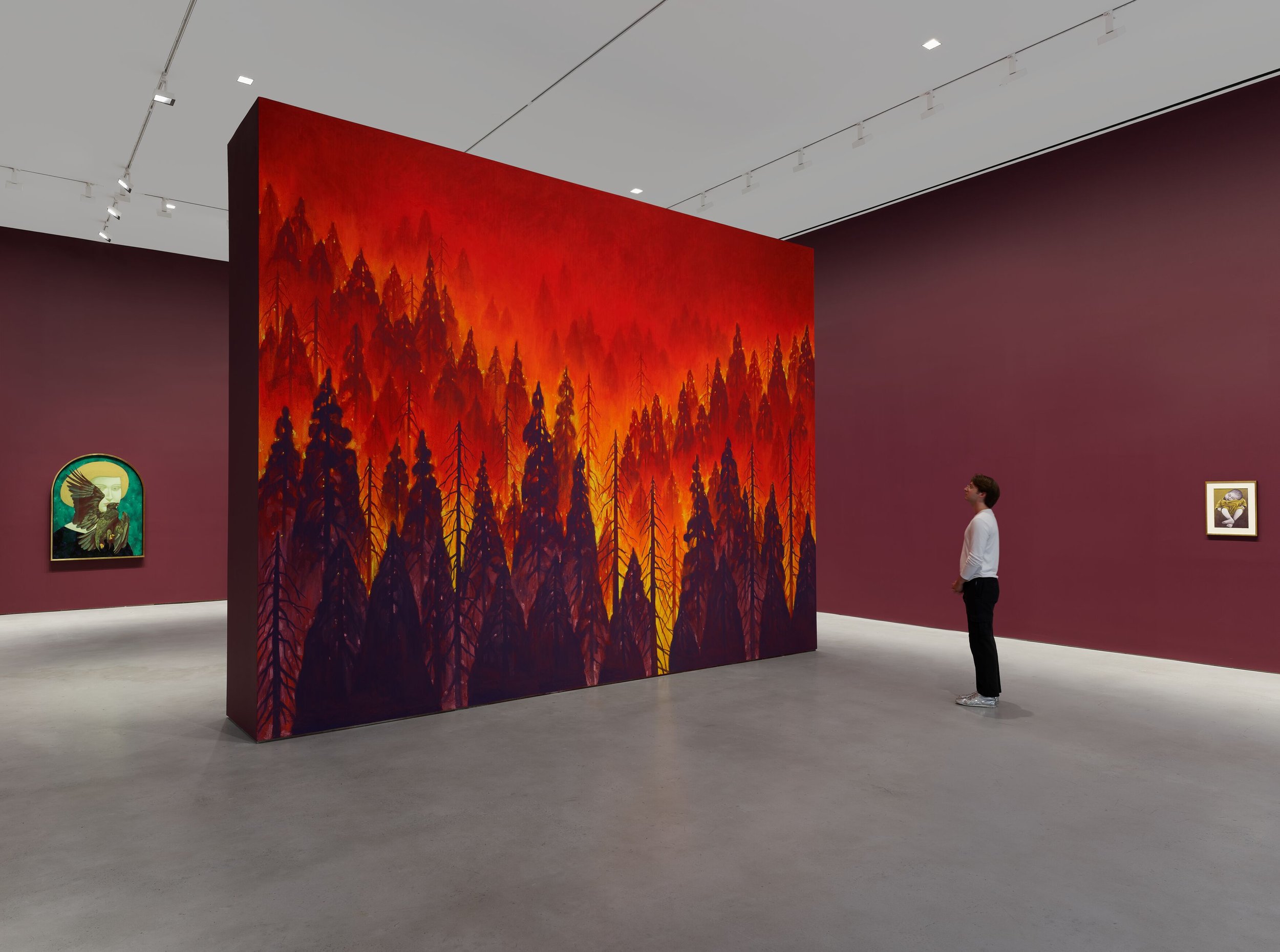
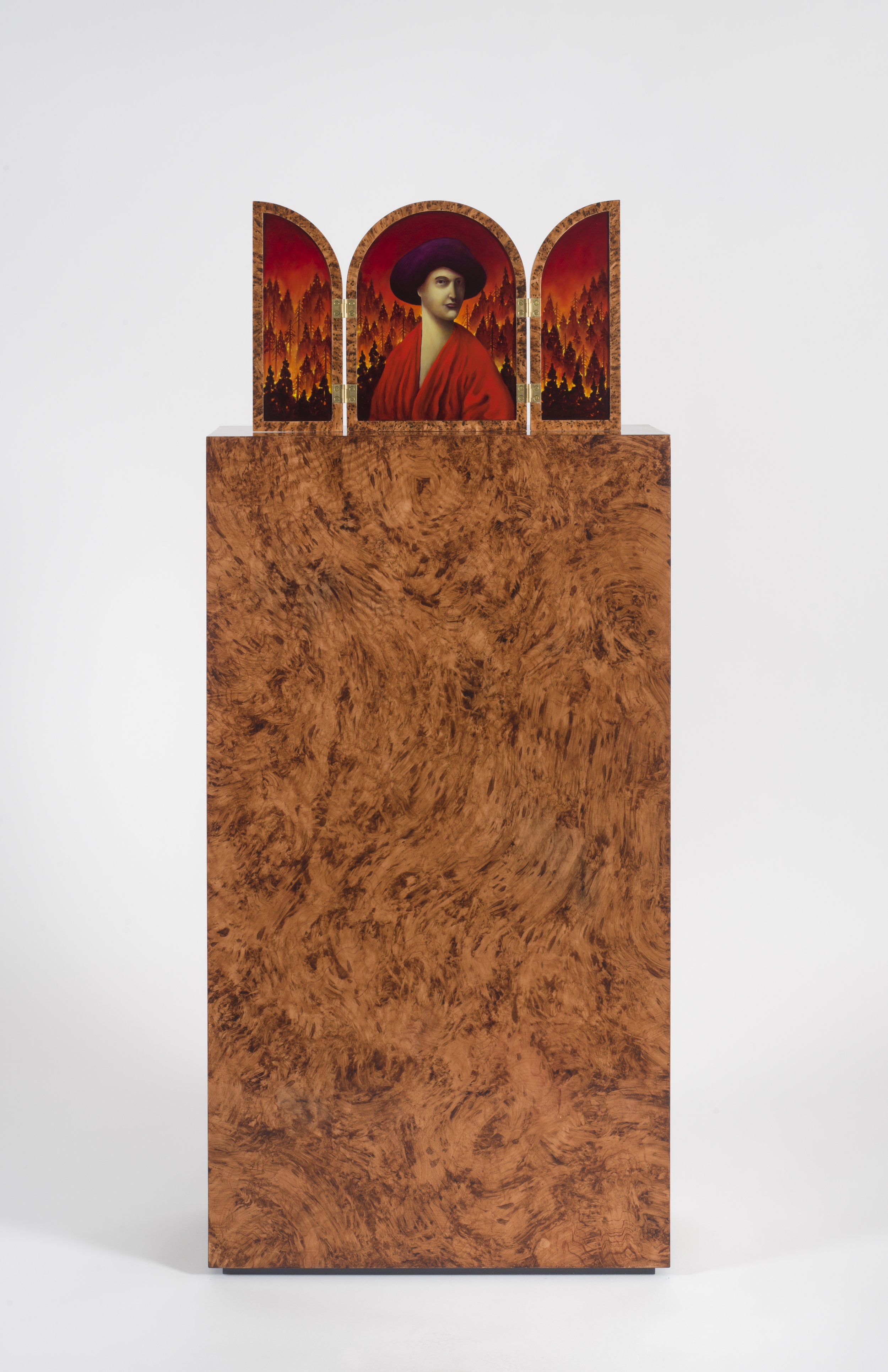
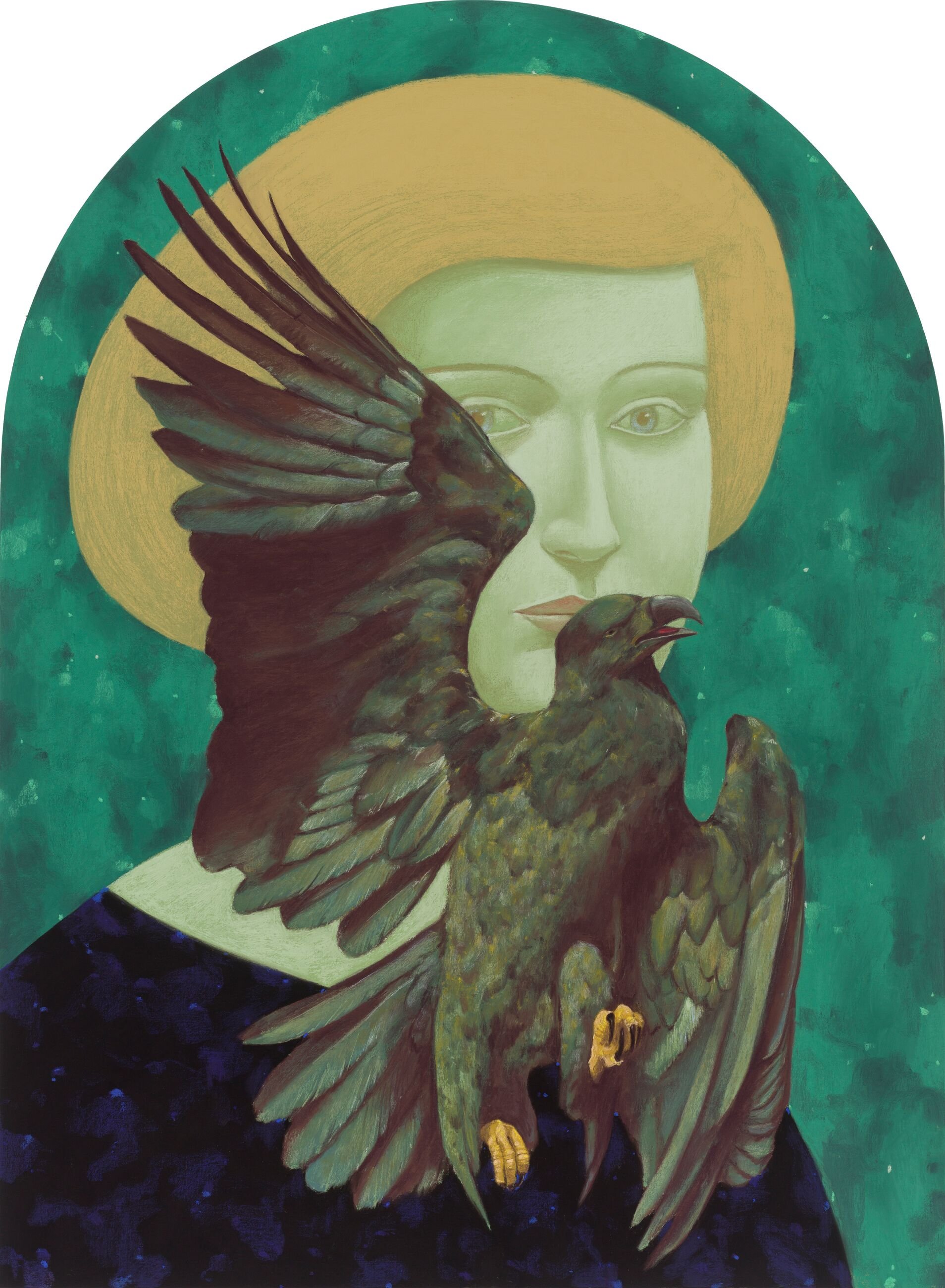
Installation view, ‘Nicolas Party. Swamp’ Hauser & Wirth New York 22nd Street 7 September – 21 October 2023 © Nicolas Party Courtesy the artist and Hauser & Wirth Photo: Sarah Muehlbauer
Created directly on the gallery’s 37 1/2 foot wide rear wall, Party painted an immense swamp mural, full of endless tree trunks submerged into a marsh. A pair of alpine vistas inspired by the artist’s Swiss homeland flank the scene, hung atop deep green walls. These landscapes echo those of Ferdinand Hodler, one of the most renowned and innovative Swiss painters of the 19th Century.
In contrast to the large-scale, enveloping pastel works on view, intimately scaled cabinet paintings sit upon marble trompe l’oeil pedestals and oil-on-copper paintings hang throughout both rooms of the exhibition. Here Party once again contemporizes all but forgotten classical mediums; just as his signature pastels achieved the height of popularity in the 18th Century, oil on copper was a fashionable and prevalent alternative to canvas during the mid-16th Century, while cabinets were most commonly made as altarpieces in medieval and Renaissance art. Party uses these mediums to express his recent fascination with pre-historic creatures of the Mesozoic Era, the second-to-last era of Earth’s geological history, in the oil-on-copper paintings and one cabinet. Drawn to the architectural, three-dimensional quality of the cabinet’s multi-panel format, the jewel-like works point to the latest developments in the artist’s formal experimentations, which continue to illuminate the timelessness of art historical figures, movements and techniques by reinventing their application in the present. ‘Swamp’ coincides with Party’s major site-specific installation ‘Nicolas Party and Rosalba Carriera,’ commissioned for The Frick Collection on Madison Avenue, on view through 3 March 2024, and his participation as one of three contemporary artists featured in the exhibition ‘Exemplary Modern. Sophie Taeuber-Arp with Contemporary Artists’ opening 6 September at Hauser & Wirth’s 69th Street location in New York City.
Mountains 2023 Soft pastel on linen 155.1 x 185.1 x 2.7 cm / 61 1/8 x 72 7/8 x 1 1/8 in 161.9 x 192.1 x 9 cm / 63 3/4 x 75 5/8 x 3 1/2 in (framed)
About the Artist
Born in Lausanne in 1980, Party is a figurative painter who has achieved critical admiration for his familiar yet unsettling landscapes, portraits, and still lifes that simultaneously celebrate and challenge conventions of representational painting. His works are primarily created in soft pastel, an idiosyncratic choice of medium in the 21st Century, and one that allows for exceptional degrees of intensity tand fluidity in his depictions of objects both natural and manmade. Transforming these objects into abstracted, biomorphic shapes, Party suggests deeper connections and meanings. His unique visual language has coalesced in a universe of fantastical characters and motifs where perspective is heightened and skewed to uncanny effect.
Nicolas’s exhibit has been on display since the 7th of September and will end on the 21st of October of this year.
For more information about the exhibit, please visit Hauser & Wirth site. Also, follow the gallery on Instagram, Facebook, X and YouTube for more updates on this exhibit.
Ed Clark. The Big Sweep
Ed Clark Locomotion 1963 Oil on canvas 192.4 x 371.2 cm / 75 3/4 x 146 1/8 inches Photo: Thomas Barratt
Beginning 7 September, two full floors of Hauser & Wirth’s 22nd Street building in New York will be devoted to ‘The Big Sweep,’ an exhibition covering the six-decade career of pioneering American abstractionist Ed Clark (1926 – 2019). Taking its title from Clark’s dedication to innovative techniques, particularly his revolutionary embrace of the common push broom as a paintbrush, this presentation documents the ways in which Clark pushed the boundaries of abstraction and its conventions beyond expressionism, from his breakthrough introduction of the shaped canvas to his distinctive approach to and impact upon questions of materiality, form and color. ‘The Big Sweep’ exhibition will be accompanied by the release of ‘Ed Clark: The Big Sweep; Chronicles of a Life, 1926–2019,’ the definitive new book on Clark, produced by Hauser & Wirth Publishers. Among the exceptional works on view, the earliest is ‘Untitled’ (1955). Completed while Clark was living in Paris, this canvas reflects the direction of the artist’s early practice under influences he encountered upon arriving in Europe in 1952, after studying at the Art Institute of Chicago. Here, he has created a work at once in dialogue with the art of his contemporaries, while expressing a velocity discernably his own. In Paris, Clark surrounded himself with such luminary American peers as Beauford Delaney, Sam Francis and Joan Mitchell, while likewise finding profound inspiration in the paintings of French artist Nicolas de Staël. Released from the bigotry and racialized assumptions that burdened Black artists in the United States, Clark felt liberated from the focus on realism that had dominated his practice back home. He began to experiment with abstraction, and to lean into the central role gesture and the tangibility of paint could play in practice. Of this period, he said, ‘I began to believe, from my conversations with other artists, that the real truth is in the stroke. For me, it is large, bold strokes that do not refer distinctly to seen nature. The paint is the subject. The motions of the strokes give the work life.
Clark returned to the United States in 1956 and quickly established himself in the New York School alongside Al Held, Franz Kline, Yayoi Kusama, and George Sugarman, among others. In 1957, he broke away from the limitations of the traditional rectangular canvas and created the first shaped painting in American modernism, now in the collection of the Art Institute of Chicago. By including protruding collage elements in his paintings, he immediately endowed his work with a bold, palpable physicality. In 1967, Clark spent a year living at Joan Mitchell’s home and studio in Vétheuil, France, where he painted his first oval canvas, mimicking the shape of the human eye, and using a push broom to create large sweeping brushstrokes. The monumental ovoid canvas of ‘Untitled’ (c. the 1970s)––on view in this exhibition––as well as the embedded oval shape of ‘Integrated Oval #1’ (1972)—exhibited in the Whitney Annual that same year—both suggest the pleasure and sense of freedom Clark achieved through the formal experimentation that in turn allowed him to intensify his gesture and the effects of materiality, form and color.
Untitled ca. 1970 Acrylic on shaped canvas 294 x 408.9 x 3.8 cm / 115 3/4 x 161 x 1 1/2 in
Clark would become renowned for his revolutionary use of a push broom as a paintbrush, a technique he first tried in Paris in 1956 and that, along with the shaped canvas, would come to define his practice. The push broom offered the artist a way to imbue his work with dramatic degrees of dynamism and energy that could not be realized by a conventional paintbrush. As demonstrated in such paintings as ‘Locomotion’ (1963) and ‘North Light (Paris)’ (1987), Clark’s method used the pressure of his entire body—he described the effect as being akin to ‘cutting through something really fast; that’s what the straight stroke with the push broom gives you, speed’— to evenly extend the momentum of his sweeping gesture across the whole surface of the canvas. Though Clark would occasionally vary the intensity of the line and color in a single motion, exploring nuances in its effects, the power of this revolutionary approach opened new vistas for abstraction with a big sweep.
Ed Clark Untitled 1955 Oil on canvas 129.5 x 129.5 cm / 51 x 51 in
By the 1980s, Clark had morphed the linearity of his earlier paintings into more tubular motifs that curved and splintered around the canvas. This ‘Broken Rainbow’ series is characterized by rounded brushstrokes that expand upon the curved lines of the 70s ovals with a new energy and confidence. Sometimes applying dry pigment to a wet broom, Clark injected his sweeping gestures with even greater motion and liveliness. In his late paintings, made in the first years of the 21st century, such as ‘Creation’ (2006), Clark’s forceful broom strokes gave way to softer, at times even aqueous, gestures that expressed a final burst of pure liberation.
Released in conjunction with the exhibition, ‘Ed Clark: The Big Sweep; Chronicles of a Life, 1926–2019’ (Hauser & Wirth Publishers), chronicles the story of the artist’s life and work through reprints of important historical texts by numerous authors, including Darby English, Anita Feldman, Geoffrey Jacques, Kellie Jones, April Kingsley, and Corinne Robins; interviews with Clark by Quincy Troupe, Jack Whitten and Judith Wilson; and photographs, letters and ephemera from the archive of Clark’s estate and his papers at the Archives of American Art, Smithsonian Institution, Washington, D.C.
Ed Clark in Paris with his painting ‘Patel Wheel,’ 1989
About the artist Born in New Orleans in 1926 and raised in Chicago, Clark emerged in the 1950s as a pioneer of the New York School. Over the course of seven decades, his experimentations with pure color, abstract form, and the seductive materiality of paint have yielded an oeuvre of remarkable originality, extending the language of American abstraction. Clark’s breakthroughs have an important place in the story of modern and contemporary art: in the late 1950s, he was the first American artist credited with exhibiting a shaped canvas, an innovation that continues to reverberate today. His search for a means to breach the limitations of the conventional paintbrush led him to use a push broom to apply pigment to the canvas laid out on the floor. Defying the discreet categories of gestural and hard-edged abstraction, Clark has masterfully interwoven these approaches into a unique form of expressionism.
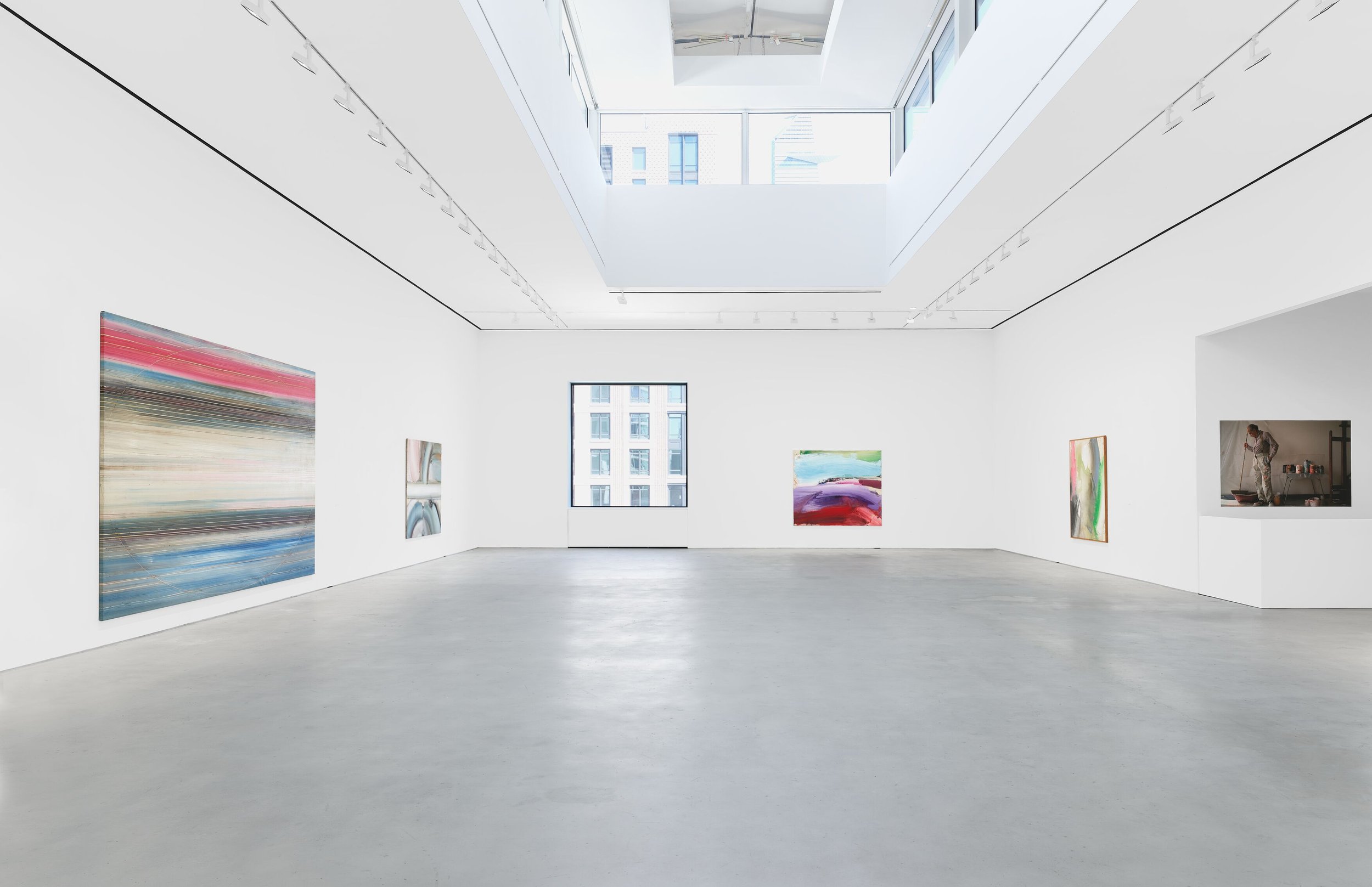
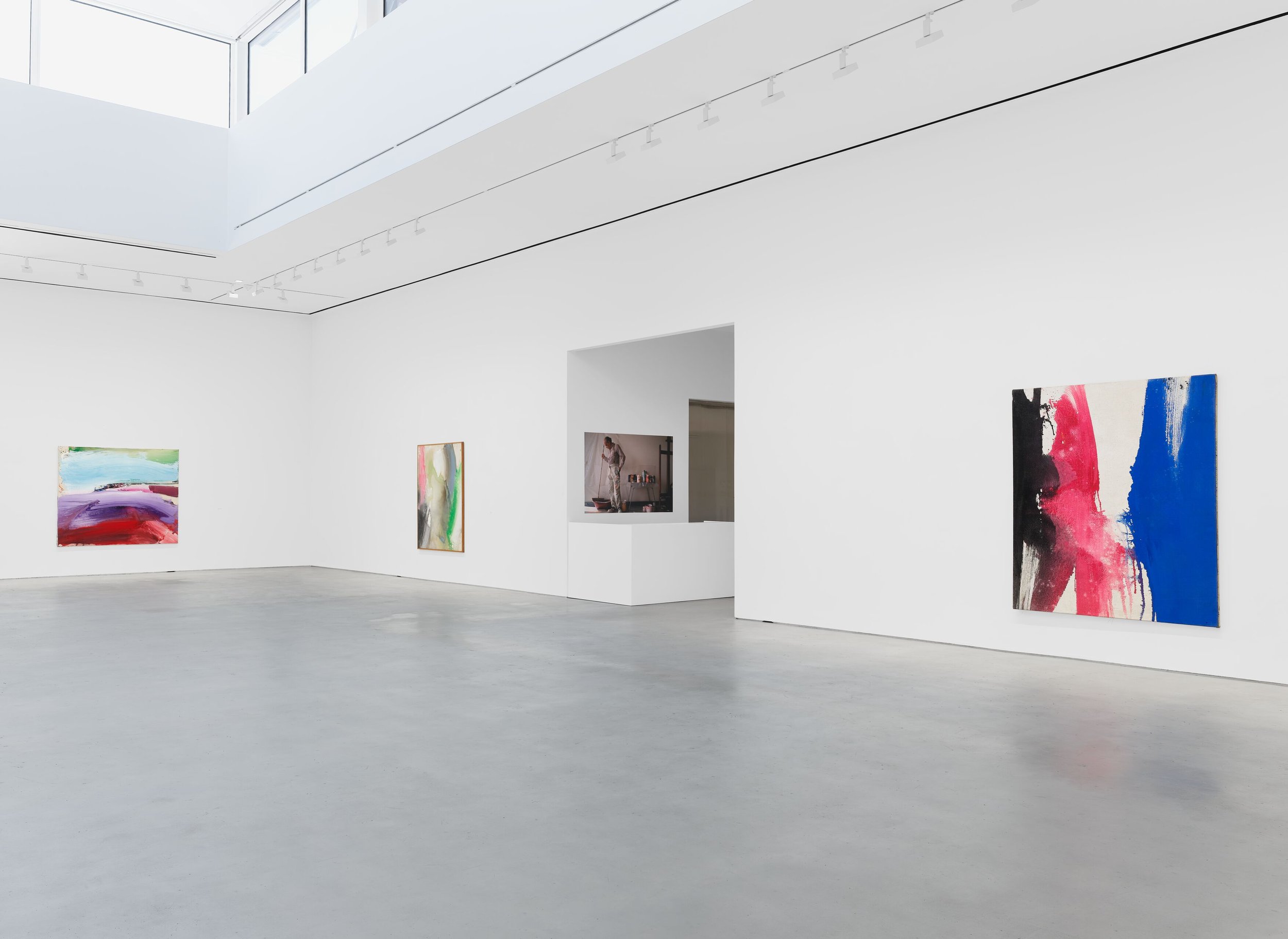
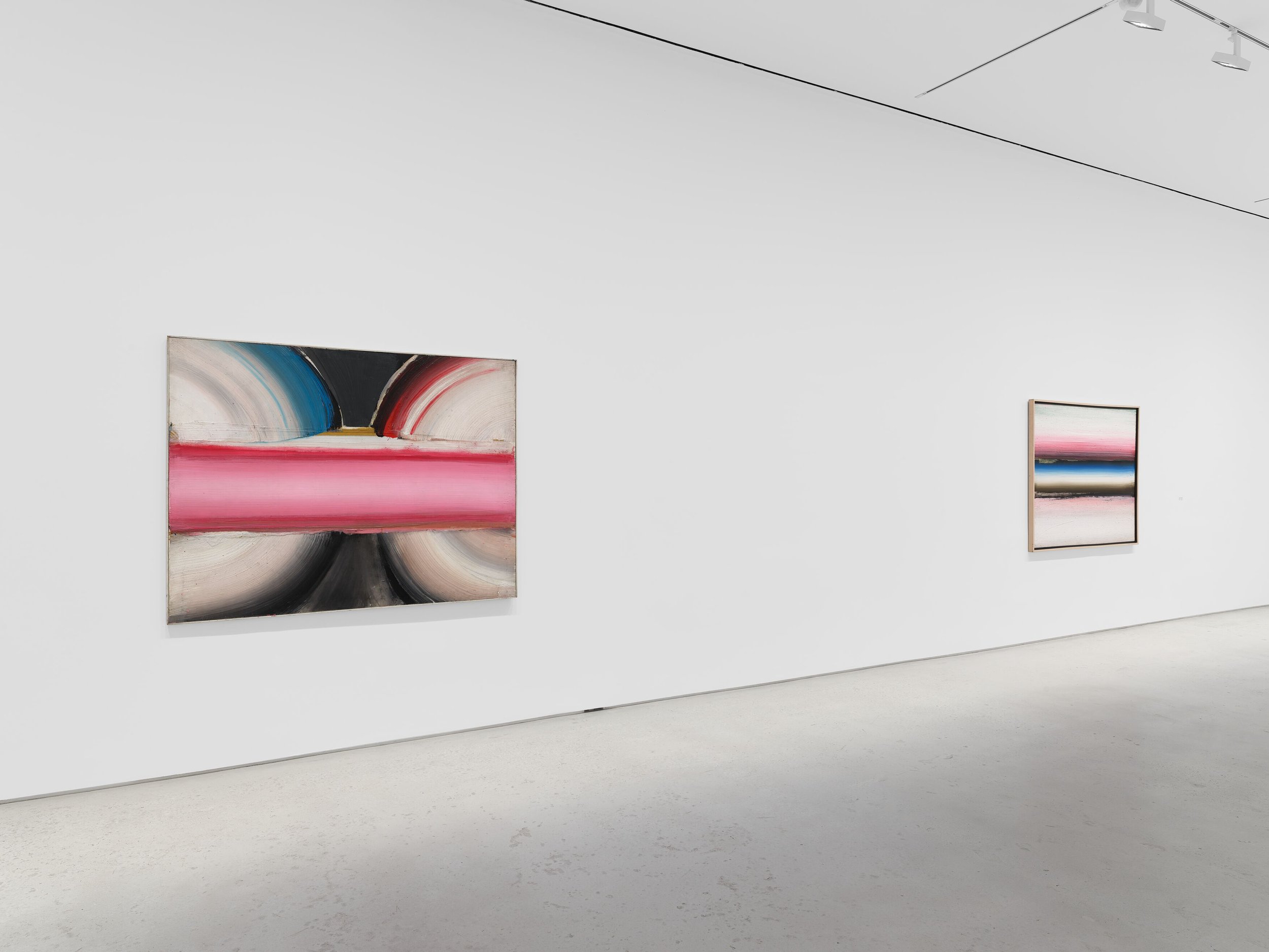
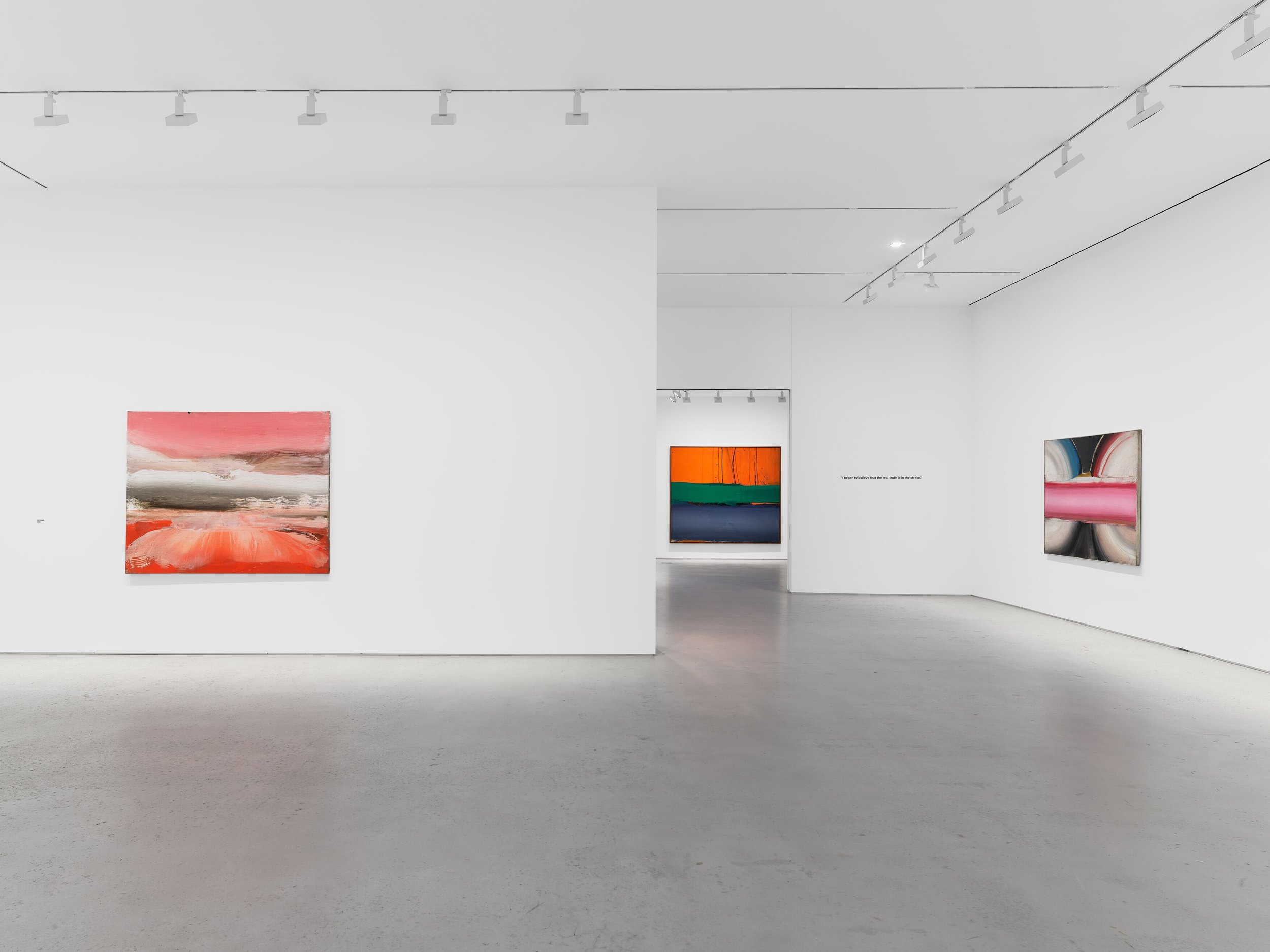

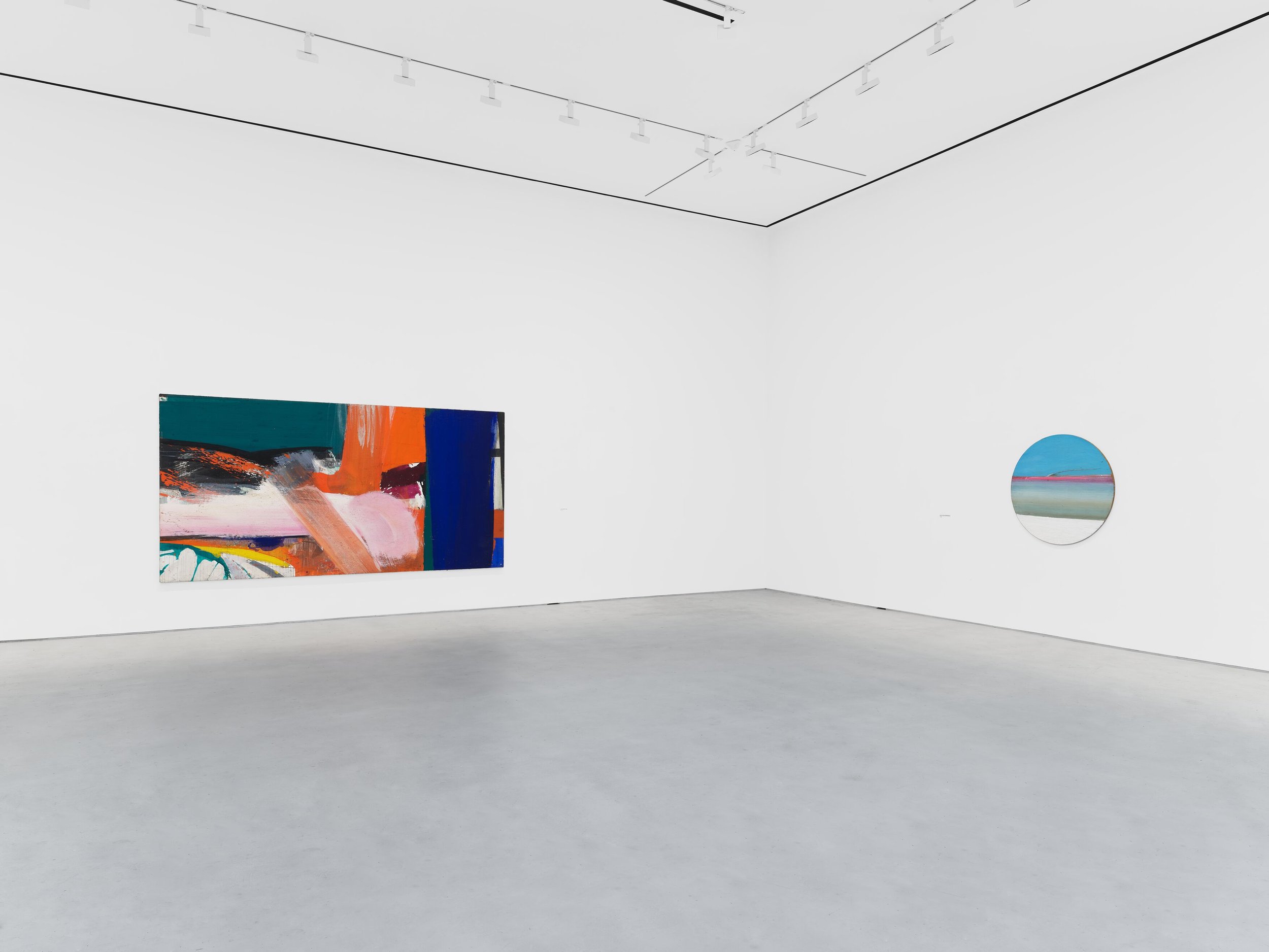


Installation view, ‘Ed Clark. The Big Sweep’ Hauser & Wirth New York 22nd Street 7 September – 21 October 2023 © The Estate of Ed Clark Photo: Sarah Muehlbauer
After studying at the Art Institute of Chicago and L’Academie de la Grande Chaumiere in Paris, Clark continued to live and work in France, absorbing the influence of such European modernists as Nicolas de Staël, Pierre Soulages, and Jean Riopelle. He became a member of a social and intellectual circle of American expatriate artists and writers, including fellow African-American creatives Beauford Delaney, Richard Wright, James Baldwin, and Barbara Chase-Riboud. Clark settled in New York in 1957, where, over the ensuing decade, he became part of the city’s dynamic downtown scene and a co-founder of the Brata Gallery, an artist-run cooperative among the Tenth Street galleries of the East Village. From the late 1960s until the last decade, Clark split his time between New York and Paris, traveling extensively to other locales from Mexico and Brazil to North Africa and Greece. In 2019, while living in Detroit, Clark passed away at the age of 93. ‘No matter what I do,’ the artist said, ‘there’s not a day that I’m not an artist.’
All images: © The Estate of Ed Clark Courtesy of the Estate and Hauser & Wirth
For more information about the exhibit, please visit Hauser & Wirth site. Also, follow the gallery on Instagram, Facebook, X and YouTube for more updates on this exhibit.
BAILEY:Photographs
Self Portrait, Singapore, 1957© David Bailey, courtesy of Fahey/Klein Gallery, Los Angeles
The Fahey/Klein Gallery is pleased to present selected photographs by David Bailey. This exhibition includes some of Bailey’s signature images of luminaries of fashion, music, and fine art. In portraits and little-known “torn” prints, he captures subjects including Jane Birkin, Michael Caine, David Hockney, Helmut Newton, Jean Shrimpton, and Mick Jagger.
Bailey’s bold and iconoclastic style has made him one of the world’s most renowned living portrait photographers and earned him as much fame as his subjects. Discarding the rigid rules of a previous generation of portrait and fashion photographers, he channeled and immortalized the energies of London in the 1960s and beyond. Self-taught, his distinctive style comprises stark white backgrounds, uncompromising crops, and striking, seemingly spontaneous poses. From the beginning of his career, which now spans more than six decades, his arresting yet spare portraits and fashion images have conveyed a radical sense of youth and sexuality, often typifying the look of the times.
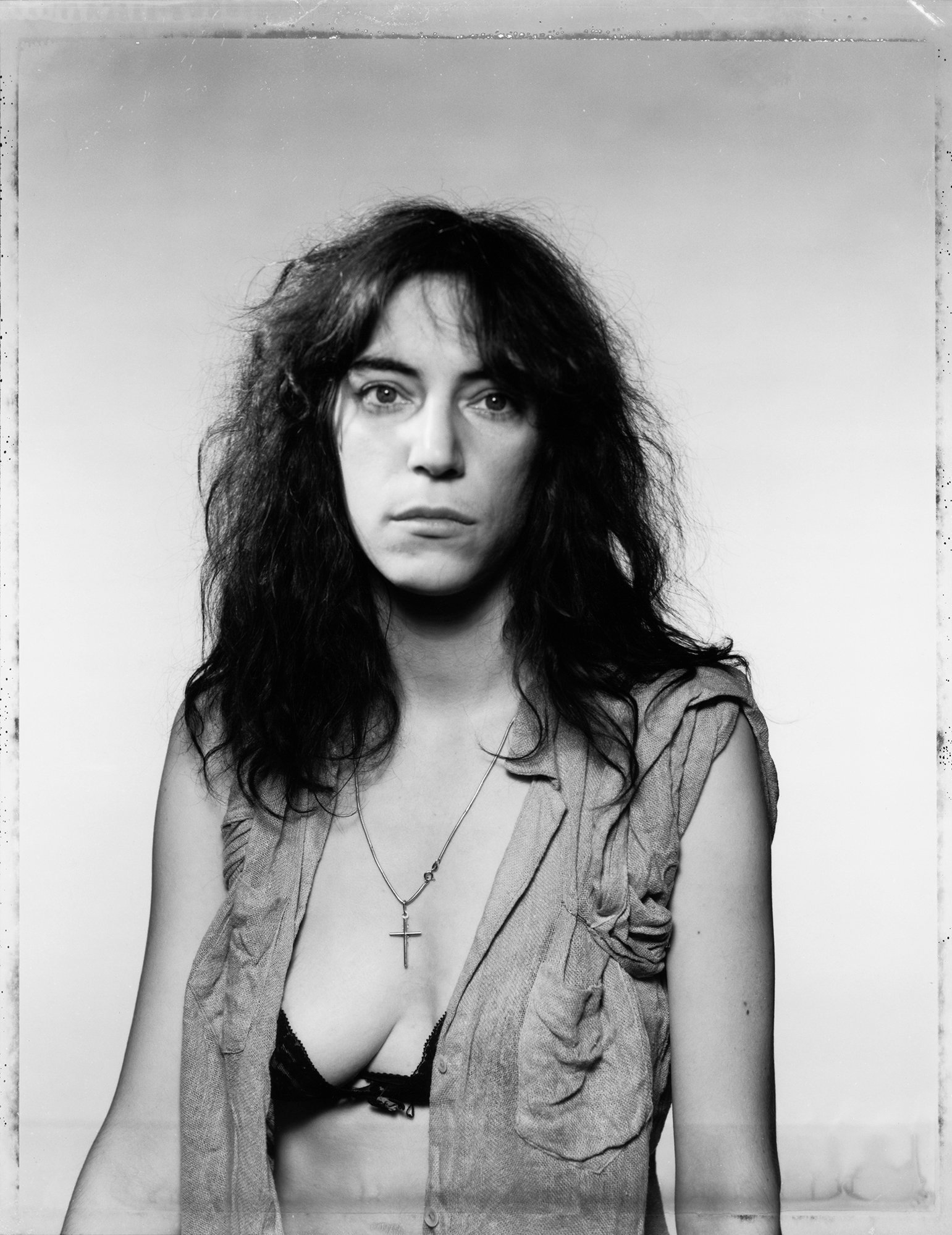
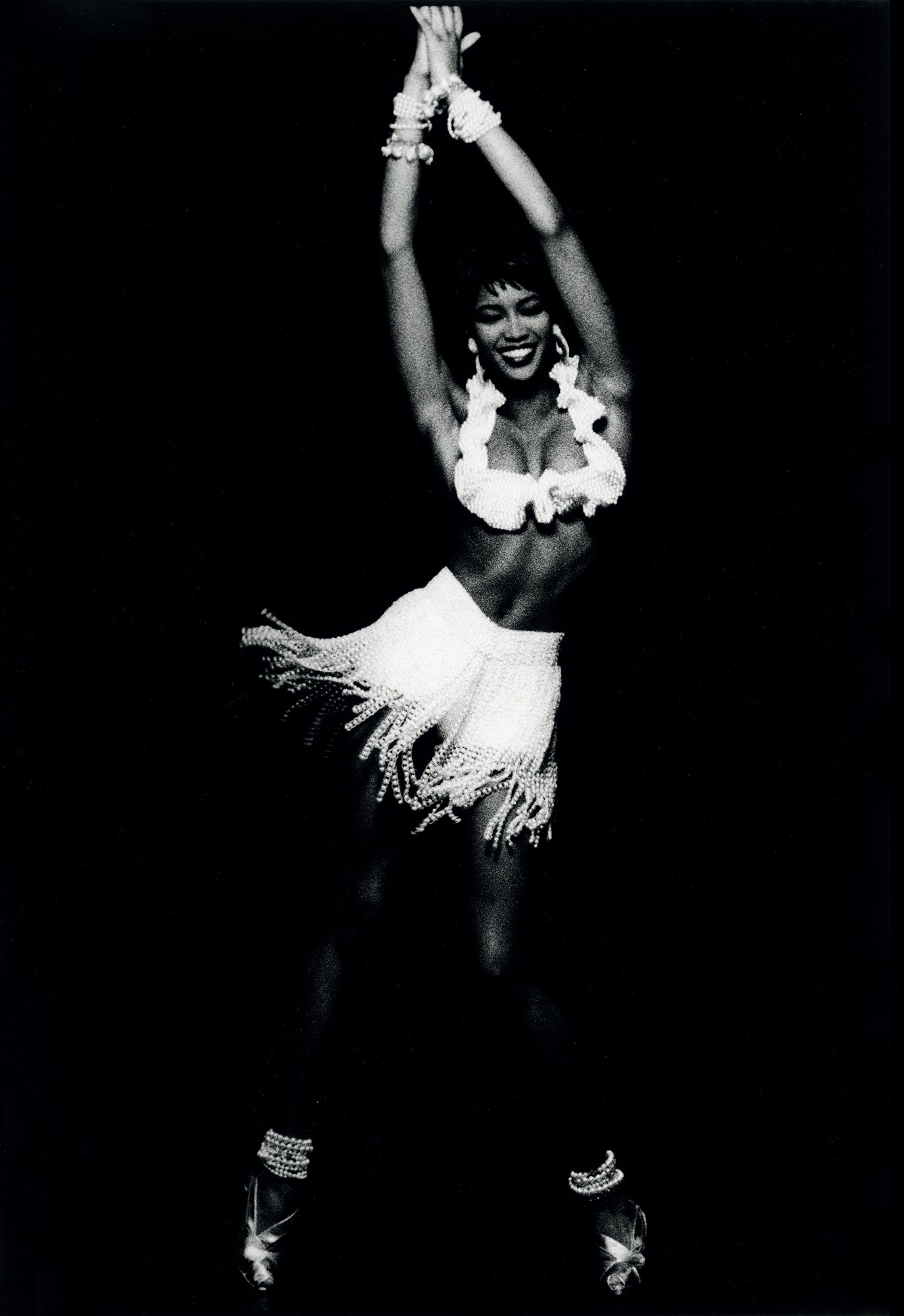
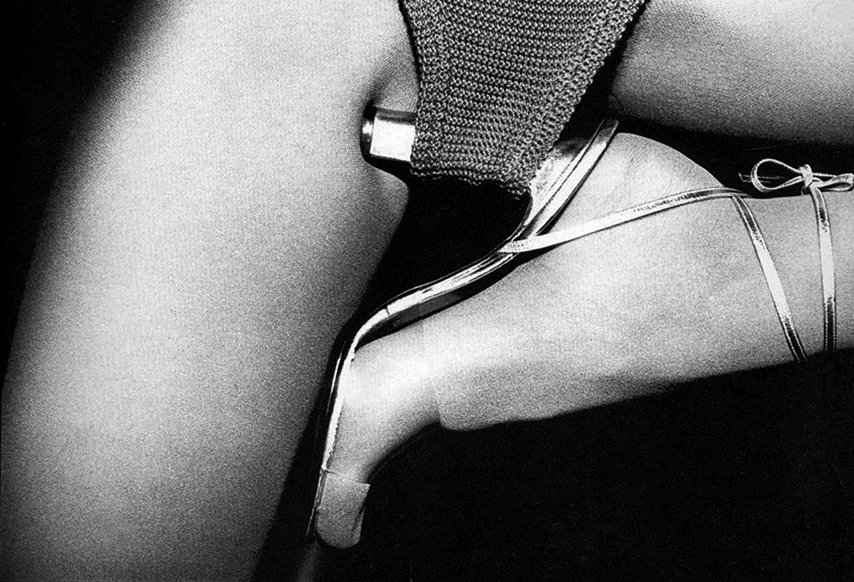
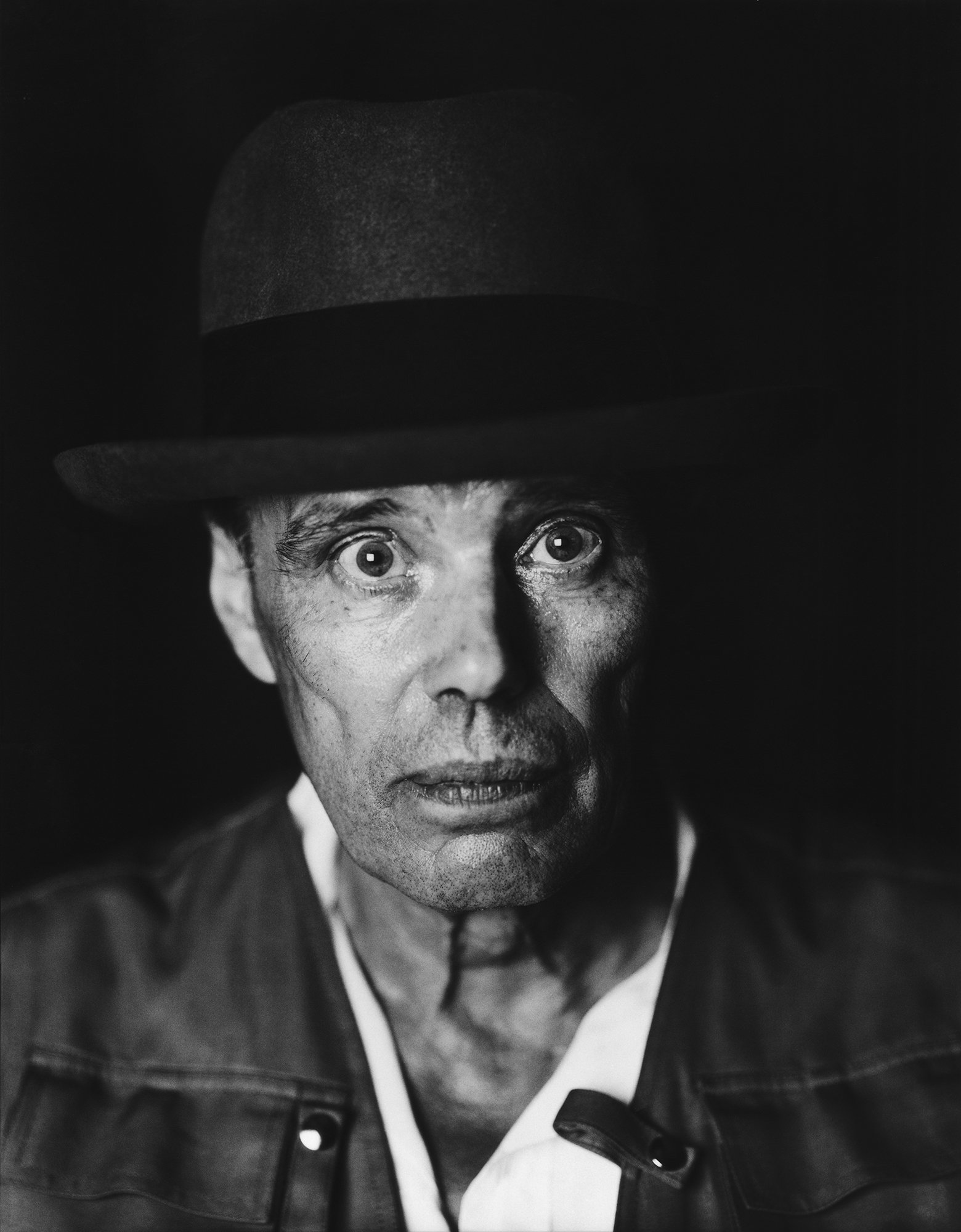

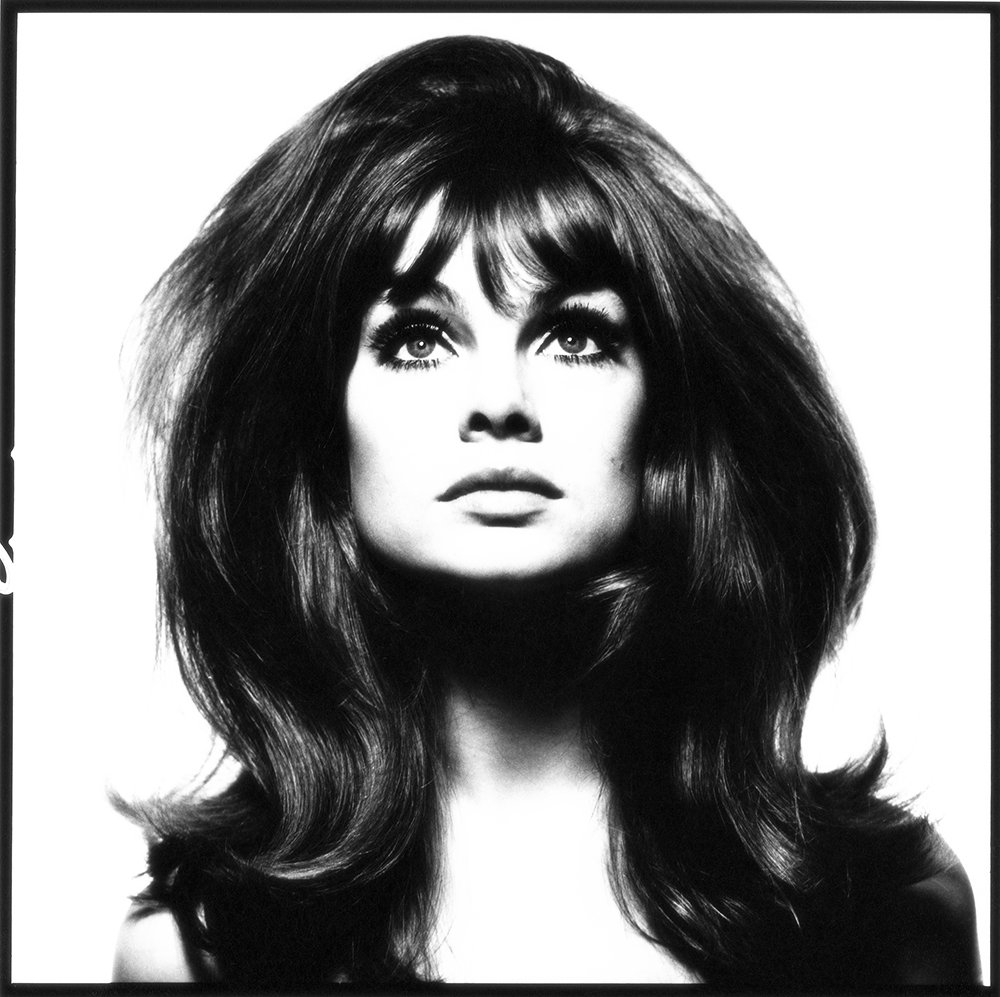
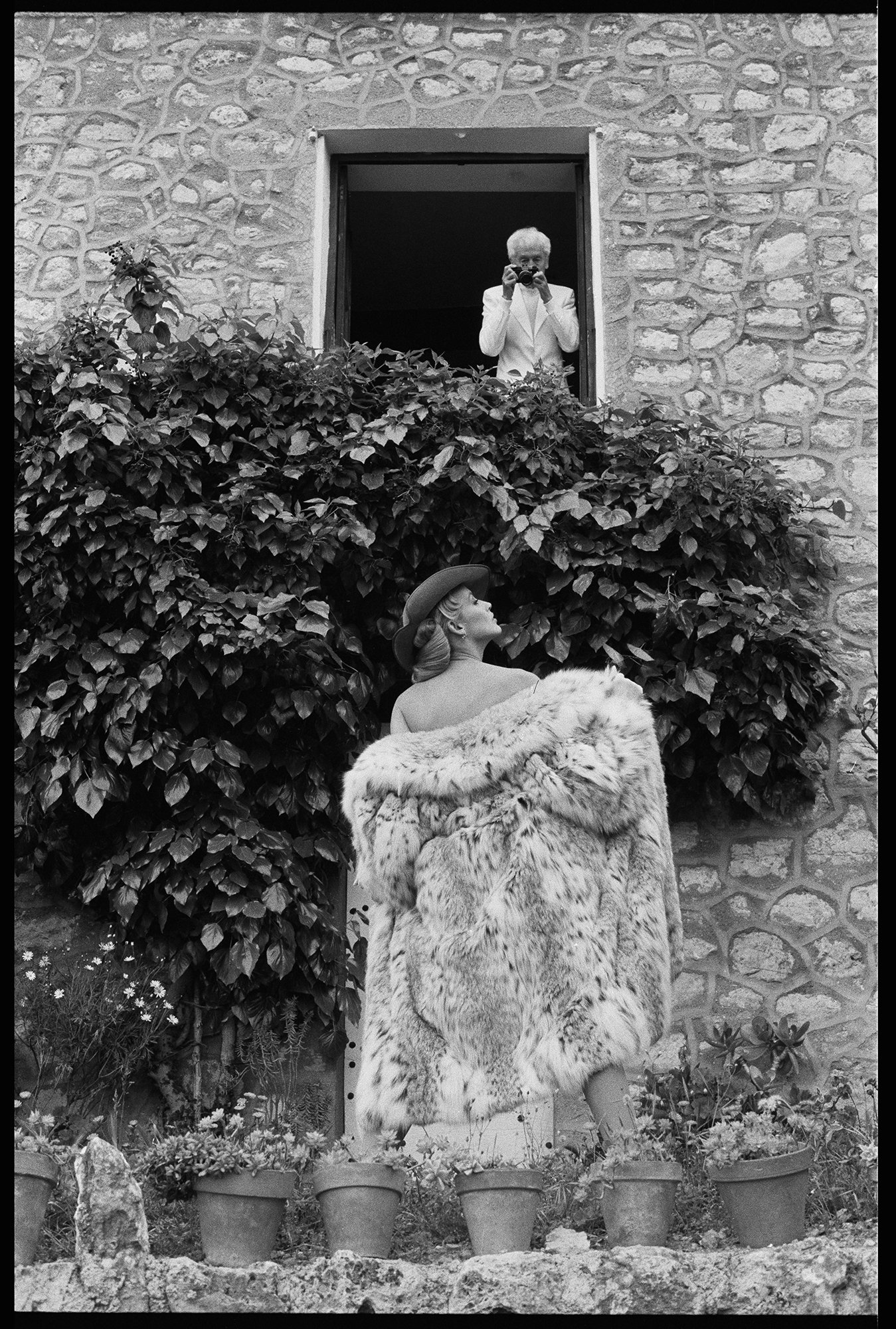
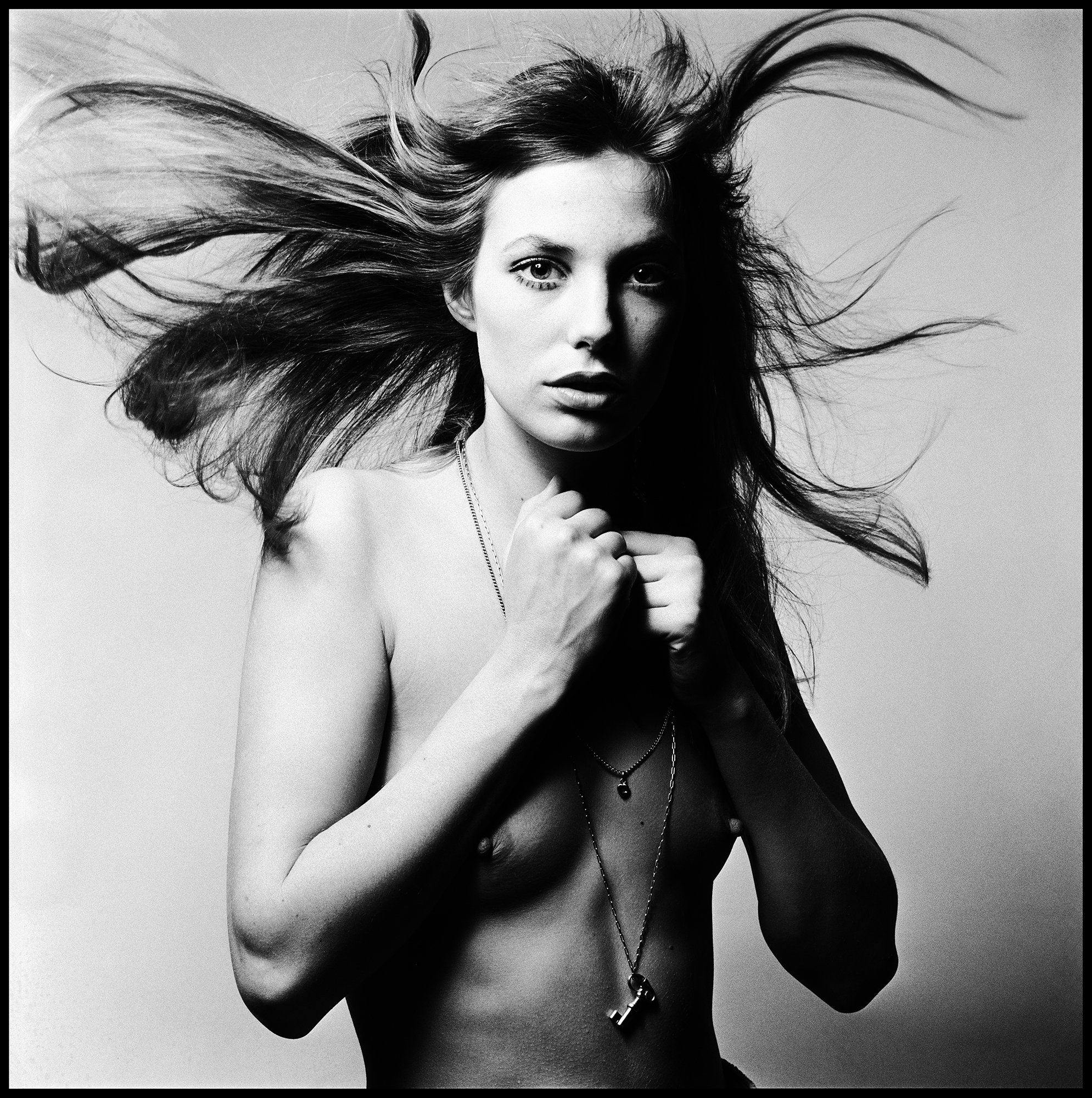
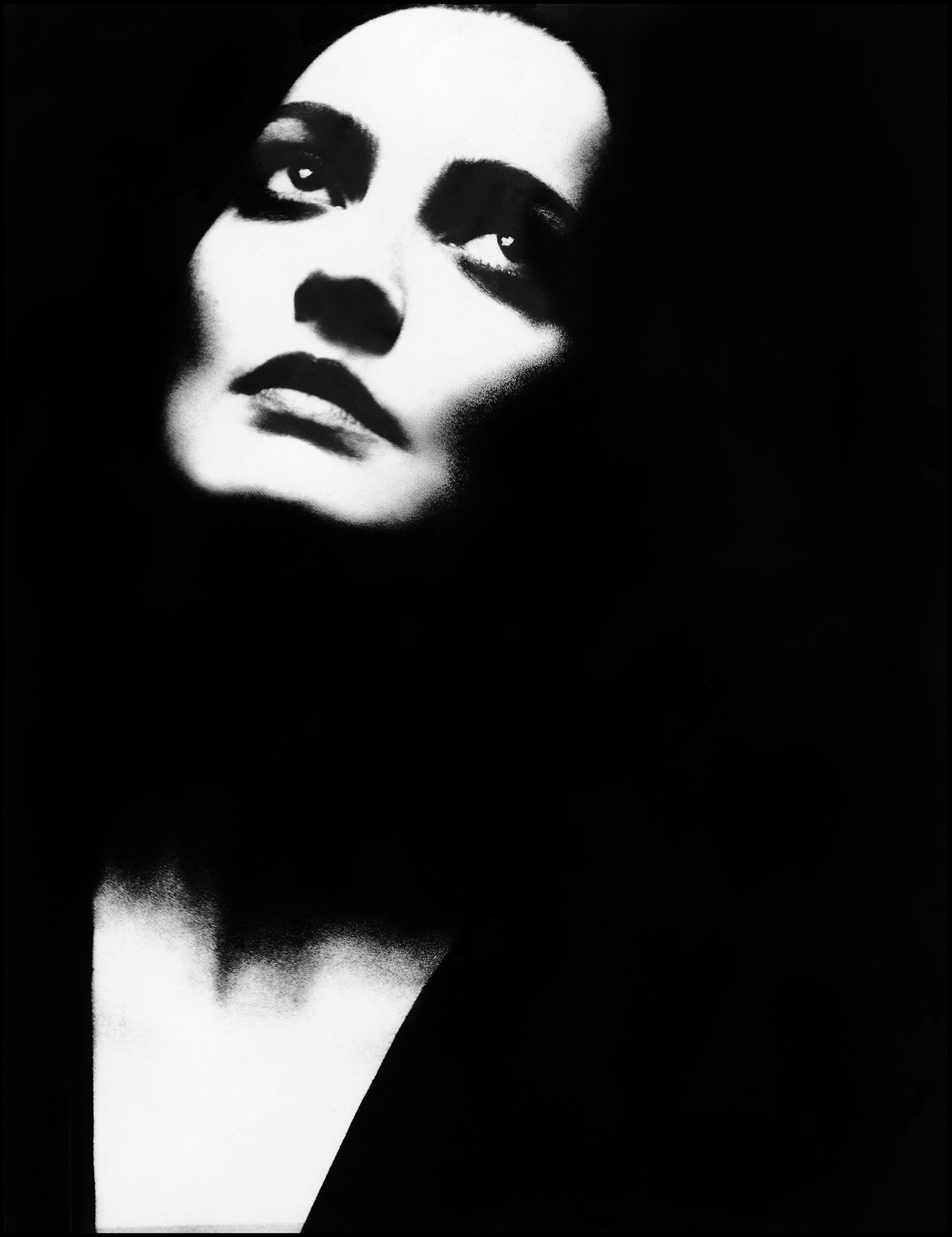
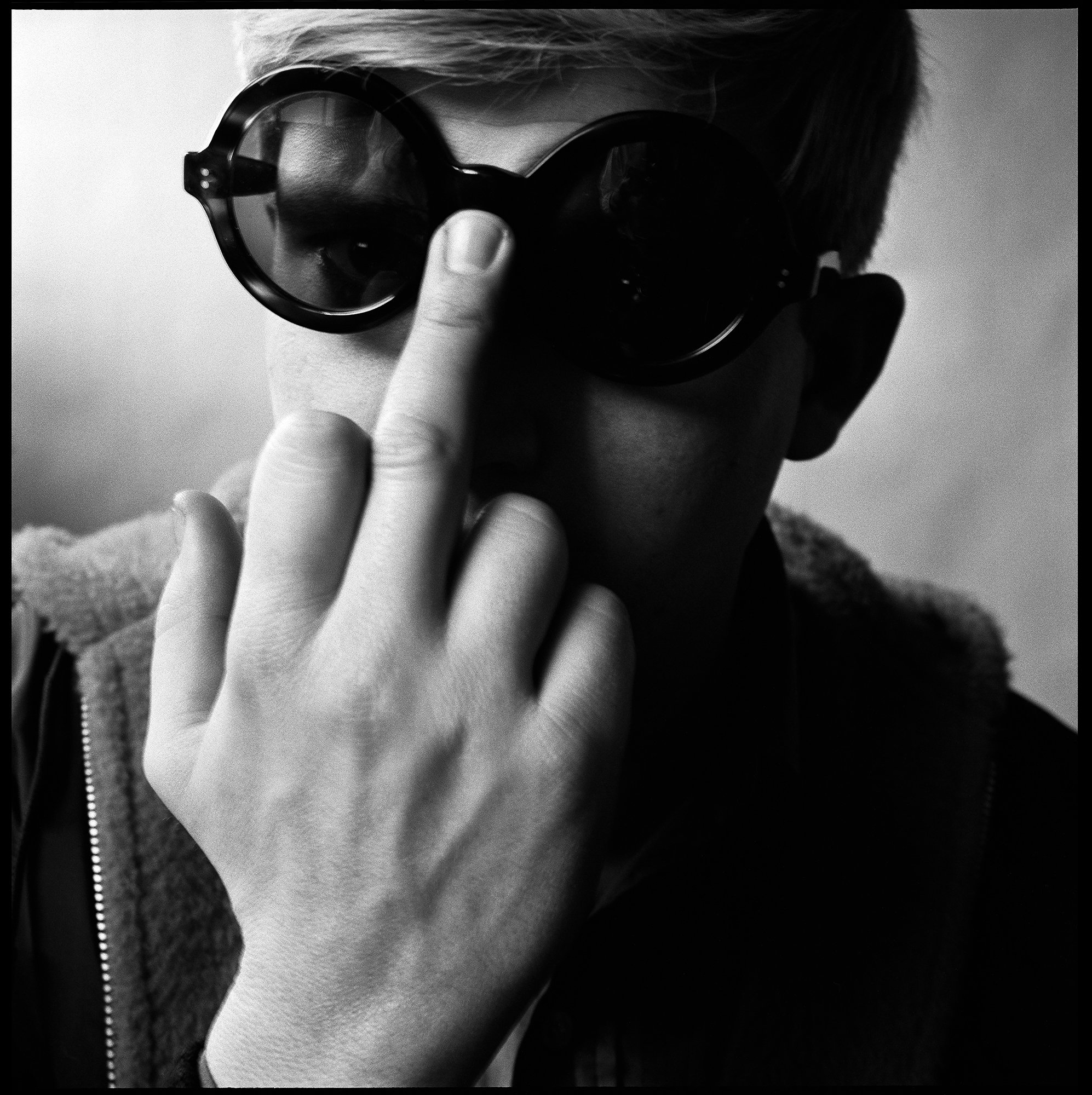

David Bailey was born in London in 1938. His childhood shaped his early experiences in the East End during the Blitz of WWII. Having left school at fifteen, he was conscripted into the Royal Air Force in 1956. Whilst posted in Singapore, he bought his first camera and was inspired to be a photographer after seeing Cartier Bresson's photograph, 'Kashmir'’. Bailey started working with fashion photographer John French as his assistant in 1959. He left soon after to strike out his career as a photographer and published his first portrait of Somerset Maugham for 'Today' magazine in 1960. Bailey’s meteoric rise at British Vogue in the early ’60s was followed by the publication, in 1965, of his first photography book, Box of Pin-Ups, which, as its title suggests, depicted media stars such as Mick Jagger, The Beatles, and Andy Warhol, among many others. His mercurial persona was the inspiration for the principal character—a fashion photographer—in Michelangelo Antonioni’s modern classic film Blow-Up (1966), and Bailey went on to create some of the most memorable and sensual portraits of the last century. Bailey has exhibited worldwide, with the first of his landmark exhibitions in 1971 at the National Portrait Gallery in London. Other exhibitions have been held at the Victoria and Albert Museum in London (1983), the International Center of Photography New York (1984), Birth of Cool, Moderna Museet, Stockholm (2000), and Bailey's Stardust, National Portrait Gallery, London (2014), which traveled through 2015 to Padiglione d'Arte Contemporanea, Milan, and Scottish National Gallery in Edinburgh. Bailey's work is held in private and public collections, including the National Portrait Gallery in London, the Victoria and Albert Museum, and the Los Angeles County Museum of Art.
The exhibition reception was held on Thursday, September 28th, and runs till November 11, 2023
For more information about the exhibit, please visit the gallery’s site.
JONATHAN MEESE DOCTOR-DOC-DR.-” HIGHNOON“IS BACK! (WONDERLAND DELARGE)
PhotoCredit: © Jana Edisonga
Four years on from the Meese Haute Couture series and the tribute it paid to Karl Lagerfeld, Jonathan Meese makes a spectacular return to Paris with DOCTOR-DOC-DR.- „HIGH NOON“ IS BACK! (WONDERLAND DE LARGE), an extravagant exhibition delving into the power of tales and legends.
Vidéo © Sylvie Boulloud
The names of a litany of heroes, from Alice in Wonderland, the Wizard of Oz, Little Red Riding Hood and the Three Little Pigs to the Smurfs, the Loch Ness monster, Fantômas and Parsifal jump out at us, becoming the standard bearers for a new vision of art. The paintings teem with material, now dripping off the canvas, now crushed to the point of no return, fusing visions of childhood with calls for revolution. Tales, myths and legends are the glue that binds collective culture. And for Jonathan Meese, they are the crucible where the Western imagination is forged as well as a vital source of inspiration in his practice: “Without fairy tales, we wouldn’t be able to build the future,” he says. “The whole world is a fairy tale, the future is in some way our wonderful world. We have a role to play in this all-powerful future. And art determines the future. Art is all-powerful.”
"DRACULA'S DRAGONBABY "MAGIC WOLF"!", 2023 huile et acrylique sur toile de coton non traitée | oil and acrylic on coarse untreated cogon cloth 120.5 x 100.3 x 3.3 cm Photo: Roman März
Over the last twenty or so years, Meese has developed an uncategorizable body of work, lying somewhere between expressionism and actionism, combining painting, sculpture, installations, and performance. His work questions the boundary between culture and nature, creativity and conformism, appearance and power, proposing a singular philosophy where art alone can serve as our guide to the evolving world.
"SCHNAPP' DEN TRAPPERZ, DER DICH ANTEUFELT", 2014 Huile, acrylique, pâte à modeler acrylique sur toile | Oil, acrylic, acrylic modelling paste on canvas 120.8 x 100.5 x 3.3 cm Photo: Jan Bauer
Jonathan Meese was born in Tokyo in 1970 and lives and works in Berlin and Ahrensburg. His work has been featured in numerous international exhibitions since he first exhibited in Berlin and at the Berlin Biennale in 1998. He has taken part in various major group shows such as Generation Z at PS1 in New York (1999), New Blood at the Saatchi Collection in London (2004), and Dionysiac at the Pompidou Centre in Paris (2005). The Deichtorhallen in Hamburg and Magasin de Grenoble organized a retrospective of his work in 2006: Mama Johnny. Other notable exhibitions of his work include those held at the Miami MOCA (2011), Akademie der Künste in Vienna (2012), Prague National Gallery (2015), Kunsthistoriches Museum in Vienna (2017), Carré Sainte-Anne in Montpellier ( 2017) and Pinakothek der Moderne in Munich (2018). In 2019, the artist took the Dr Zuhause: K.U.N.S.T (Erzliebe) project to Lübeck, where it occupied all the city's exhibition spaces. In 2022, in collaboration with young artist Conny Maier, he put together a large-scale exhibition entitled Hansel and Gretel (Let me in Ruh’) in Aurich, Germany.










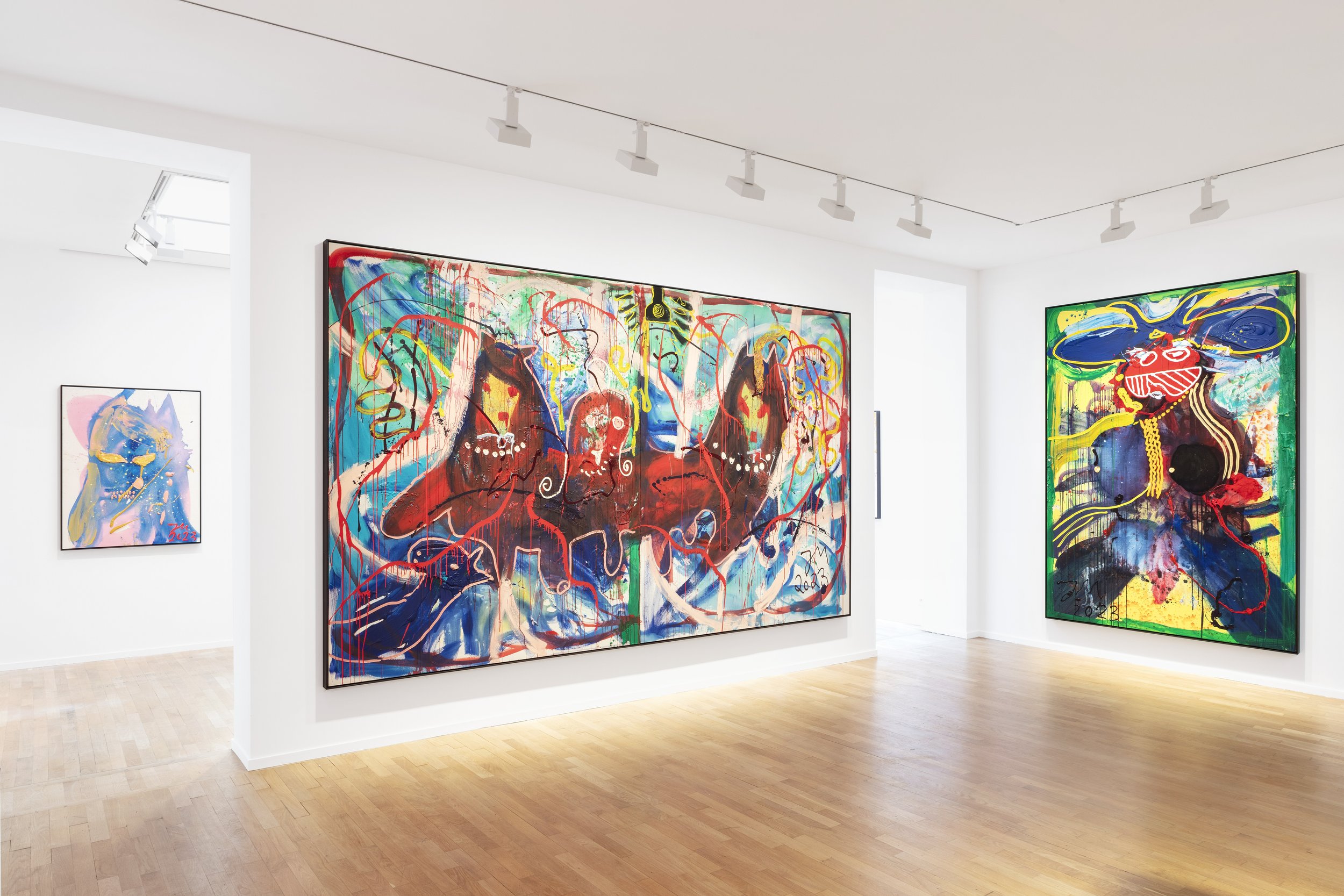







Toutes les images / All images: © Courtesy of the artist and TEMPLON, Paris —Brussels — New York
Jonathan Meese has also created sets and scenery for the theatre and opera, including Dionysos by Wolfgang Rihm, presented at the Salzburg Festival in 2010 and the Staatsoper in Berlin in 2012. He designed the scenery for Charpentier's Médée directed by Pierre Audi at the Théâtre des Champs Elysées in 2012. His improvisation on Wagner's Parsifal at the Berlin Staatsoper in 2005 and Homage to Noël Coward at Tate Modern in 2006 were both unforgettable events. In 2007, he wrote and performed De Frau: Dr. Poundaddylein – Dr. Ezodysseusszeusuzur at the Volksbühne in Berlin, and in 2020, he presented a new show, Lolita (R)evolution (Rufschädigendst)-Ihr Alle seid die Lolita Eurer Selbst! at Theater Dortmund. In 2021, during the global pandemic, Jonathan Meese released an acclaimed record in collaboration with renowned electronic music producer DJ Hell, Hab keine Angst, hab keine Angst, ich bin deine Angst [Don't be afraid, don't be afraid, I'm your fear].
The exhibit has been on display since the 2nd of September at the Paris-Beaubourg location and will close on October 28th of this year. For more information about this exhibit, please visit the Templon Gallery website.
CLAUDE VIALLAT : A Couple of Sidesteps
87-year-old French artist Claude Viallat is taking “a couple of sidesteps” to reveal a series of new paintings created between 2022 and 2023 at the Galerie Templon Brussels space. A founder and leading member of the Supports/Surfaces group in the 1970s, Claude Viallat, has spent the last 50 years exploring the limits of abstract painting through variations around his signature “shape” – a small bone form – reproduced on a wide variety of fabrics and tarpaulins, hung unmounted and unimpeded in space. With this new exhibition, carefully installed by Claude Viallat himself, the artist unveils a handful of his latest experiments. In a number of works, the shape, rather than being repeated as an endless sequence, is diluted to the point where it forms large spots of watery colors. In other pieces, it is outlined with dripped paint, suggesting a contrasting image of calligraphy.
Vidéo © José Huedo
The use of multi-colored fabrics offers him the opportunity to introduce new hues: a deep ruby canvas rubs shoulders with a soft mauve or platinum grey piece. In Viallat’s work, the palette always chooses itself: “I am an instrument,” he explains. “The work has a life of its own. I only have to concern myself with the result.” Another constant feature of the artist’s approach is that the exhibition layout is almost a work of art in itself.
The artist delights in juxtaposing canvases, mixing up surprising textures and patterns. He uses this ever-innovative game of contrasts to reveal an audacious and intuitive dialogue between volume and surface, accumulation and void. Claude Viallat was born in 1936 in Nimes, France, where he continues to live and work.







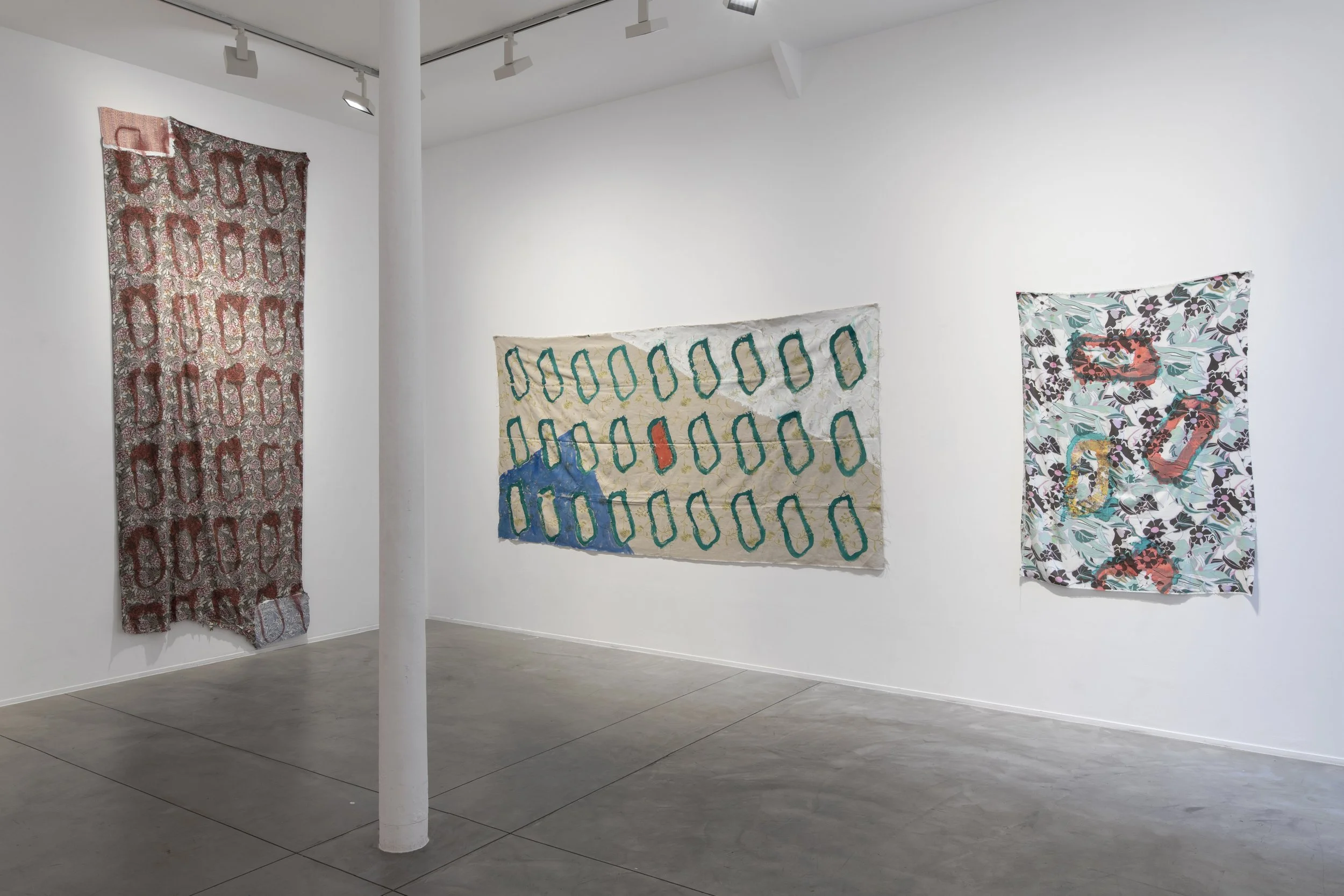

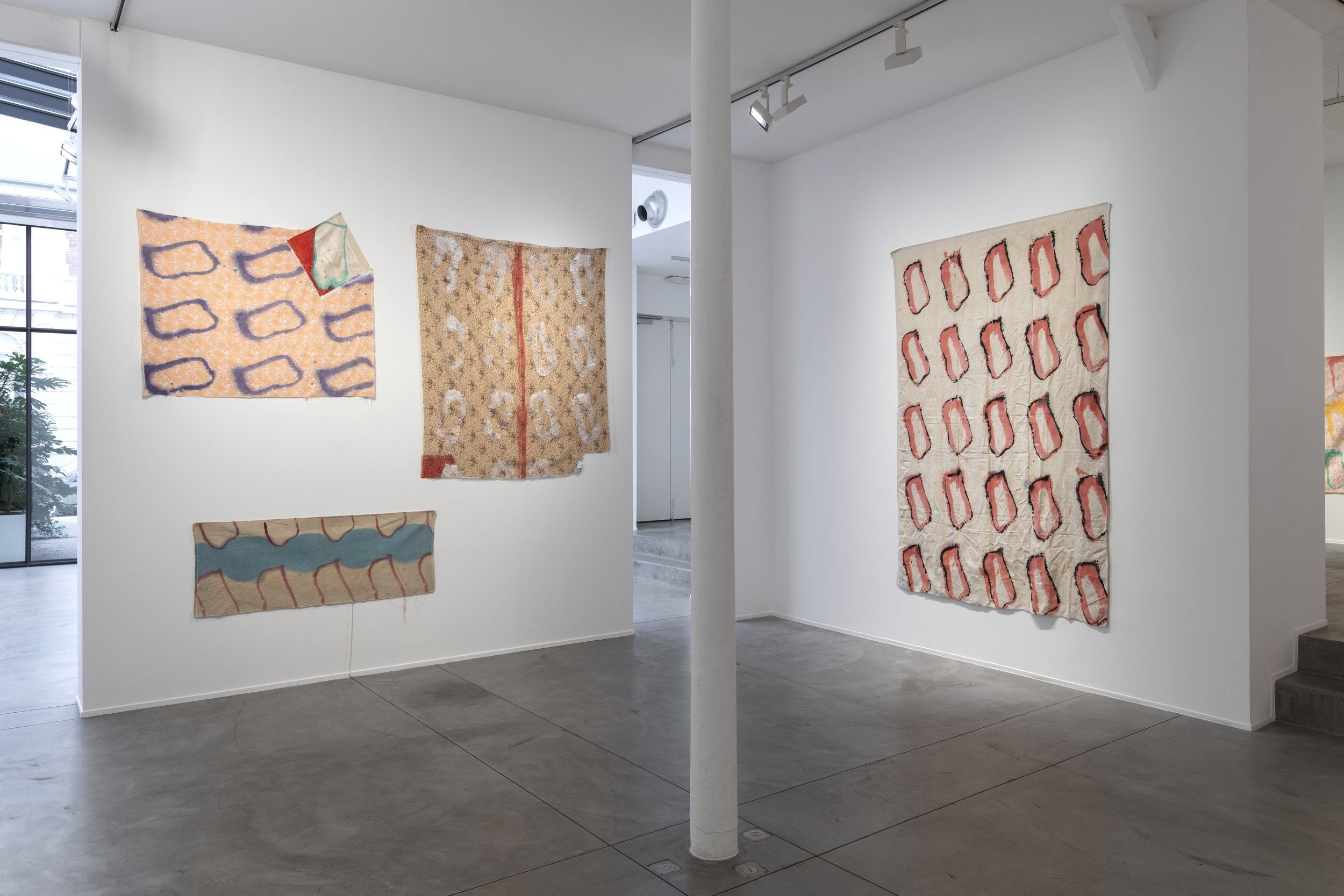
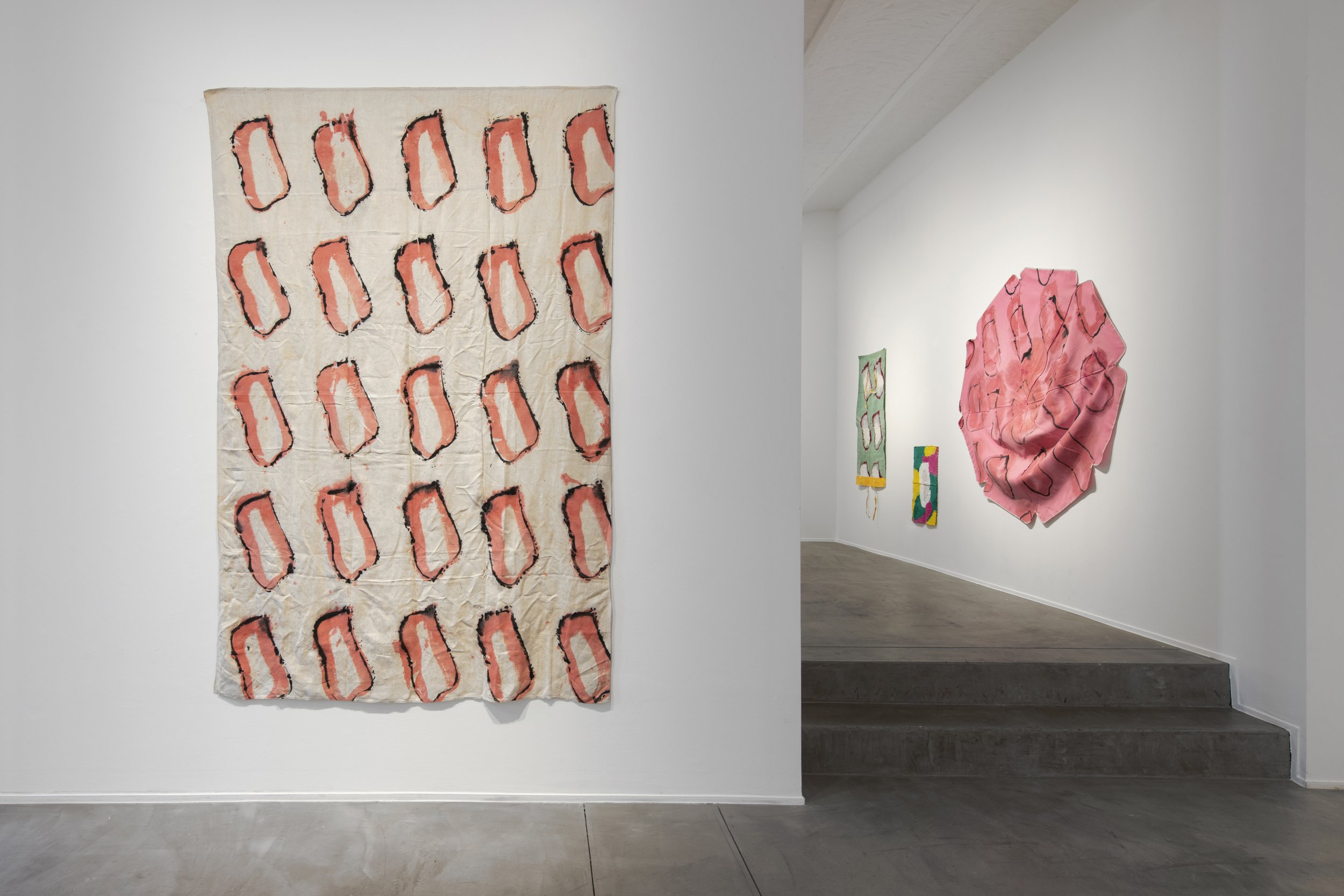



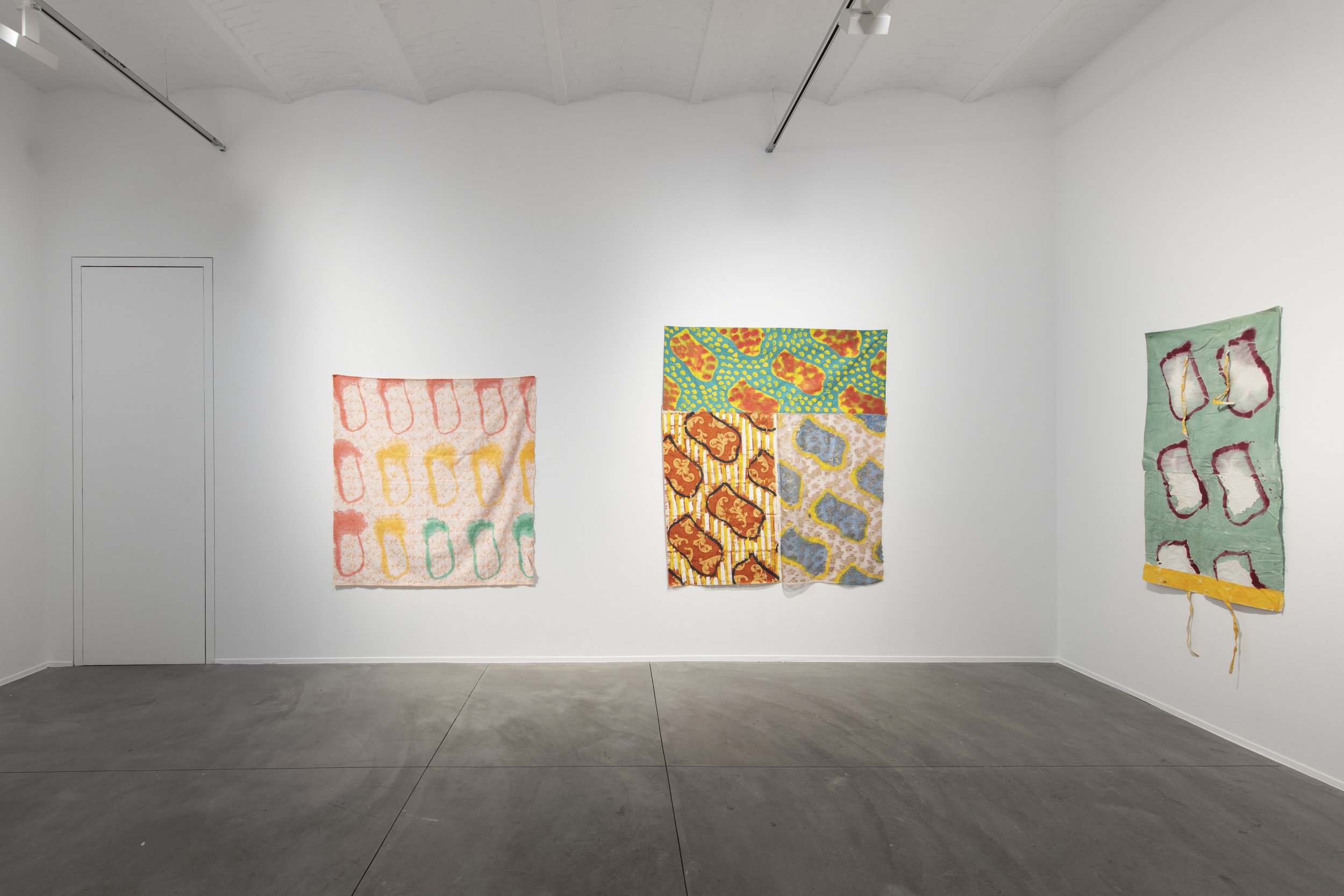
Vues d'exposition © Isabelle Arthuis
The many solo exhibitions of his work include shows at the MACBA in Buenos Aires (2022), Venet Foundation in southeastern France (2019), Musée Fabre in Montpellier (2014), Ludwig Museum in Germany (2014), Museo Universitario del Chopo in Mexico (2004), MuBe in Brazil (2001), Kunsthalle Düsseldorf in Germany (1983) and Musée National d’Art Moderne – Centre Pompidou in Paris (1982). He represented France at the 43rd Venice Biennale in Italy in 1988. His works are featured in over fifty public collections in France and internationally, including at the Musée National d’Art Moderne - Centre Pompidou in Paris and MoMA in New York. His native city is holding a major retrospective of his work for the first time. It will take place at the Carré d’Art – Musée d’Art Contemporain starting on 27 October 2023. The city of Nîmes has also announced the opening of a Claude Viallat foundation in the former Saint Joseph Chapel. Architect Jean-Michel Willmotte has been commissioned with the design of the foundation, which is scheduled to open in late 2025.
Since his first collaboration with Daniel Templon in 1972, this will be the artist’s eleventh exhibition at the gallery that has represented him since 1999.
This exhibit has been on view since the 2nd of September at the Brussels location and will close on the 4th of November of this year. Please visit the Templon Gallery's site for more information about Claude’s exhibit.
ROBIN KID : KINGDOM OF ENDS
For his second solo show in Paris with Templon, Robin Kid is coming back to the Grenier-Saint-Lazare space with his new series « Kingdom of Ends,» taking over the entire gallery to create an immersive experience consisting of painting, sculpture, and installation, all centering around a two-story high mobile.
Kingdom of Ends - XIII, 2023 Résine uréthane, fibre de verre, fonte d'aluminium, acier inoxydable, peinture polyuréthane | Urethan resin, fiberglass, cast aluminum, stainless steel, polyurethane paint H250 x W190 x D90 cm Photo: ROBIN KID
Through the evocative poignancy of mass-produced foundational imagery depicting our commonly shared childhood, Robin Kid is delving into the notion of personal and cultural memories, conjuring up feelings of uncertainty but also of the most naive hopes and dreams gathered during childhood and teenage years.
By combining stainless steel panels and aluminum sculpture with oil painting in a toylike way, the artist is manufacturing an idealized billboard to our shared desire while operating in the context of power and control; Borrowing its title « Kingdom of Ends » from Kant’s ethical principle, the work explores our collective need and hope for a secure existence -and the fear that in Today’s world many might never attain it.












































Toutes les images / All images: © Courtesy the artist and TEMPLON, Paris —Brussels — New York
Influenced by Robert Rauschenberg’s “Combines” and Jim Dine’s early works like “Lawnmower” and “Child’s Blue Wall,” - the Kingdom of Ends series are hybrid works, neither painting nor sculpture, but both at once. They invade the viewer’s space, demanding its attention and instigate a dialogue by simultaneously becoming eye-popping and menacing yet perfectly balanced advertisements, invoking a nostalgia so strong it amounts to an ache, for they show us a time and place of which we are and always have been exiled from.
Robin Kid (b. 1991) is an autodidact multidisciplinary artist from Dutch descent. His works hijack a variety of social, political and traditional imagery of the past and present, with rebellious, religious, fantastical and in some ways offensive undertones. He pulls intuitively from the world of advertising, the Internet, the entertainment industry and his childhood memories, to produce ambitious, enigmatic and thought provoking narratives, which question the polarized world of the 21st century.
This exhibit has been on view since the 2nd of September at the Paris- Grenier Saint Lazare location and will close on the 21st of October of this year. Please visit the Templon Gallery's website for more information about Robin’s exhibit.











